ZyXEL Communications USG20W-VPN VPN Firewall User Manual Book
ZyXEL Communications Corporation VPN Firewall Book
Contents
- 1. Users Manual Part 1
- 2. Users Manual Part 2
- 3. Users Manual Part 3
- 4. Users Manual Part 4
- 5. Users Manual Part 5
Users Manual Part 4
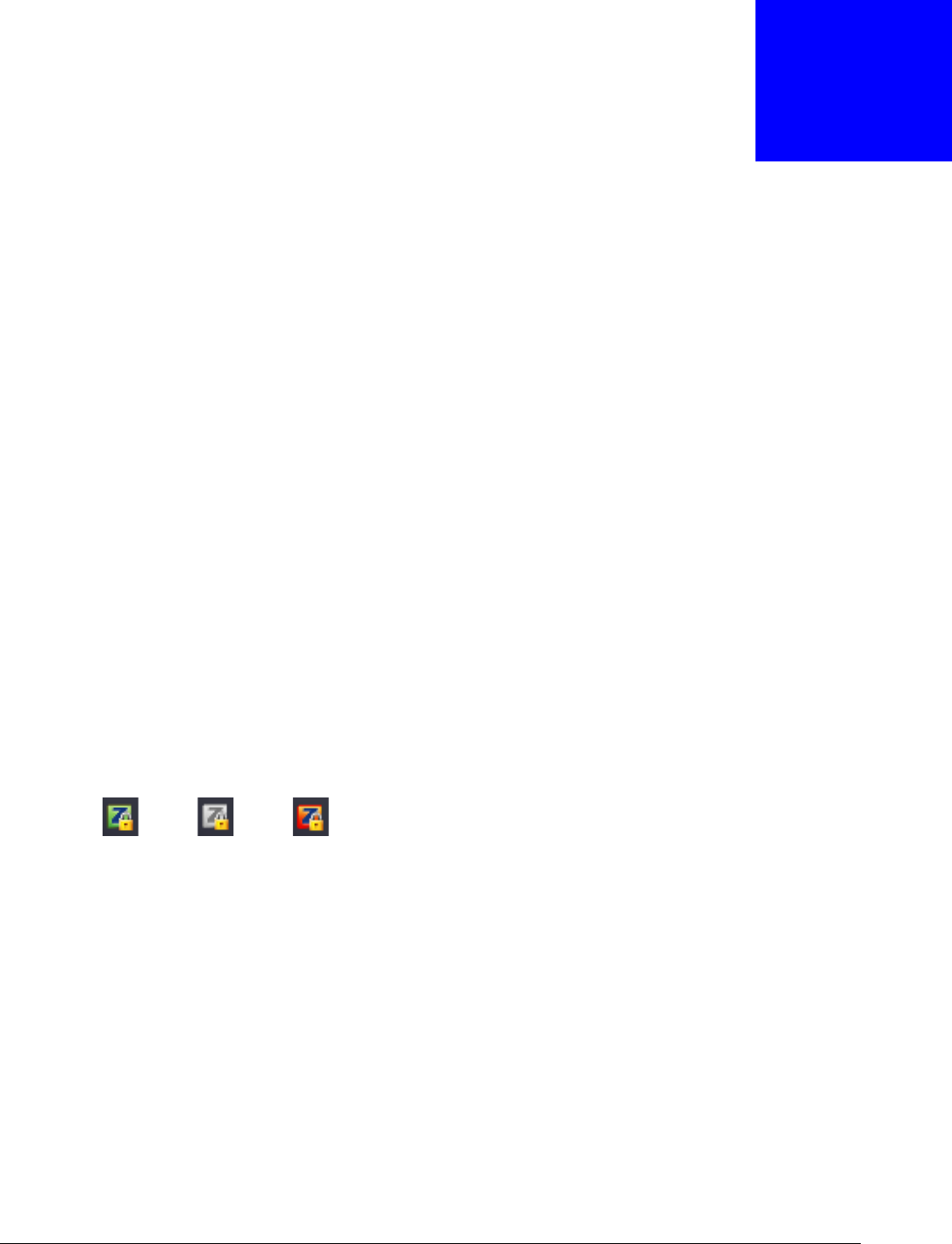
USG20(W)-VPN Series User’s Guide
391
CHAPTER 24
USG SecuExtender (Windows)
The USG automatically loads the USG SecuExtender for Windows client program to your computer
after a successful login to an SSL VPN tunnel with network extension support enabled.
Note: For information on using the USG SecuExtender for Mac client program, please see
its User’s Guide at the download library on the ZyXEL website.
The USG SecuExtender (Windows) lets you:
• Access servers, remote desktops and manage files as if you were on the local network.
• Use applications like e-mail, file transfer, and remote desktop programs directly without using a
browser. For example, you can use Outlook for e-mail instead of the USG’s web-based e-mail.
• Use applications, even proprietary applications, for which the USG does not offer SSL application
objects.
The applications must be installed on your computer. For example, to use the VNC remote desktop
program, you must have the VNC client installed on your computer.
24.1 The USG SecuExtender Icon
The USG SecuExtender icon color indicates the SSL VPN tunnel’s connection status.
Figure 271 USG SecuExtender Icon
• Green: the SSL VPN tunnel is connected. You can connect to the SSL application and network
resources. You can also use another application to access resources behind the USG.
• Gray: the SSL VPN tunnel’s connection is suspended. This means the SSL VPN tunnel is
connected, but the USG SecuExtender will not send any traffic through it until you right-click the
icon and resume the connection.
• Red: the SSL VPN tunnel is not connected. You cannot connect to the SSL application and
network resources.
24.2 Status
Right-click the USG SecuExtender icon in the system tray and select Status to open the Status
screen. Use this screen to view the USG SecuExtender’s connection status and activity statistics.
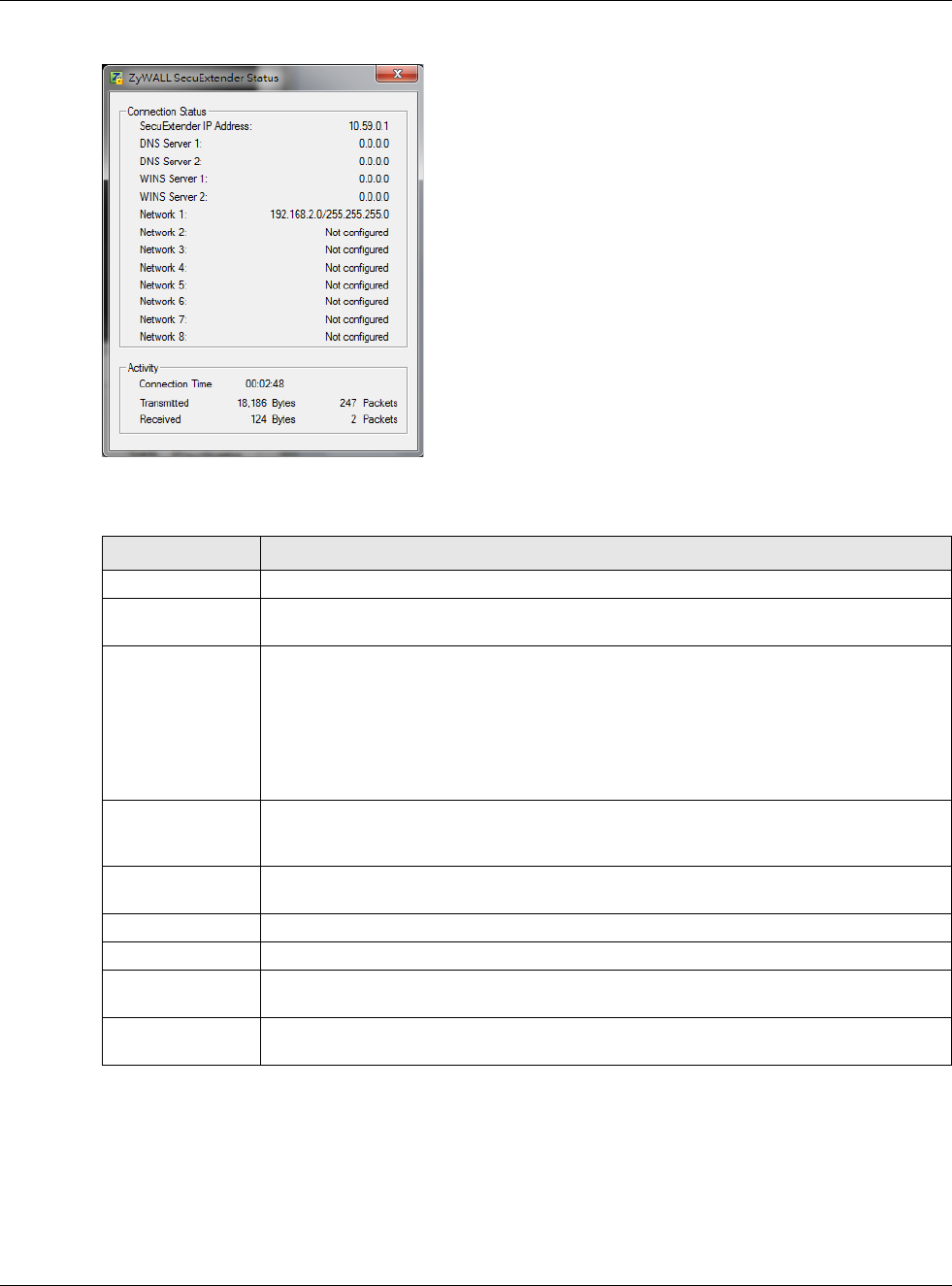
Chapter 24 USG SecuExtender (Windows)
USG20(W)-VPN Series User’s Guide
392
Figure 272 USG SecuExtender Status
The following table describes the labels in this screen.
24.3 View Log
If you have problems with the USG SecuExtender, customer support may request you to provide
information from the log. Right-click the USG SecuExtender icon in the system tray and select Log
to open a notepad file of the USG SecuExtender’s log.
Table 149 USG SecuExtender Status
LABEL DESCRIPTION
Connection Status
SecuExtender IP
Address
This is the IP address the USG assigned to this remote user computer for an SSL VPN
connection.
DNS Server 1/2 These are the IP addresses of the DNS server and backup DNS server for the SSL VPN
connection.
DNS (Domain Name System) maps a domain name to its corresponding IP address and
vice versa. The DNS server is extremely important because without it, you must know
the IP address of a computer before you can access it. Your computer uses the DNS
server specified here to resolve domain names for resources you access through the SSL
VPN connection.
WINS Server 1/2 These are the IP addresses of the WINS (Windows Internet Naming Service) and backup
WINS servers for the SSL VPN connection. The WINS server keeps a mapping table of
the computer names on your network and the IP addresses that they are currently using.
Network 1~8 These are the networks (including netmask) that you can access through the SSL VPN
connection.
Activity
Connected Time This is how long the computer has been connected to the SSL VPN tunnel.
Transmitted This is how many bytes and packets the computer has sent through the SSL VPN
connection.
Received This is how many bytes and packets the computer has received through the SSL VPN
connection.

Chapter 24 USG SecuExtender (Windows)
USG20(W)-VPN Series User’s Guide
393
Figure 273 USG SecuExtender Log Example
24.4 Suspend and Resume the Connection
When the USG SecuExtender icon in the system tray is green, you can right-click the icon and
select Suspend Connection to keep the SSL VPN tunnel connected but not send any traffic
through it until you right-click the icon and resume the connection.
24.5 Stop the Connection
Right-click the icon and select Stop Connection to disconnect the SSL VPN tunnel.
24.6 Uninstalling the USG SecuExtender
Do the following if you need to remove the USG SecuExtender.
1Click start > All Programs > ZyXEL > USG SecuExtender > Uninstall ZyWALL
SecuExtender.
2In the confirmation screen, click Yes.
##################################################################################
##############
[ 2009/03/12 13:35:50 ][SecuExtender Agent][DETAIL] Build Datetime: Feb 24 2009/
10:25:07
[ 2009/03/12 13:35:50 ][SecuExtender Agent][DEBUG] rasphone.pbk: C:\Documents and
Settings\11746\rasphone.pbk
[ 2009/03/12 13:35:50 ][SecuExtender Agent][DEBUG] SecuExtender.log:
C:\Documents and Settings\11746\SecuExtender.log
[ 2009/03/12 13:35:50 ][SecuExtender Agent][DETAIL] Check Parameters
[ 2009/03/12 13:35:50 ][SecuExtender Agent][DETAIL] Connect to 172.23.31.19:443/
10444
[ 2009/03/12 13:35:50 ][SecuExtender Agent][DETAIL] Parameter is OK
[ 2009/03/12 13:35:50 ][SecuExtender Agent][DETAIL] Checking System status...
[ 2009/03/12 13:35:50 ][SecuExtender Agent][DETAIL] Checking service (first) ...
[ 2009/03/12 13:35:50 ][SecuExtender Agent][DETAIL] SecuExtender Helper is running
[ 2009/03/12 13:35:50 ][SecuExtender Agent][DETAIL] System is OK
[ 2009/03/12 13:35:50 ][SecuExtender Agent][DEBUG] Connect to 2887196435/443
[ 2009/03/12 13:35:50 ][SecuExtender Agent][DETAIL] Handshake LoopCounter: 0
[ 2009/03/12 13:35:50 ][SecuExtender Agent][DETAIL] 611 bytes of handshake data
received
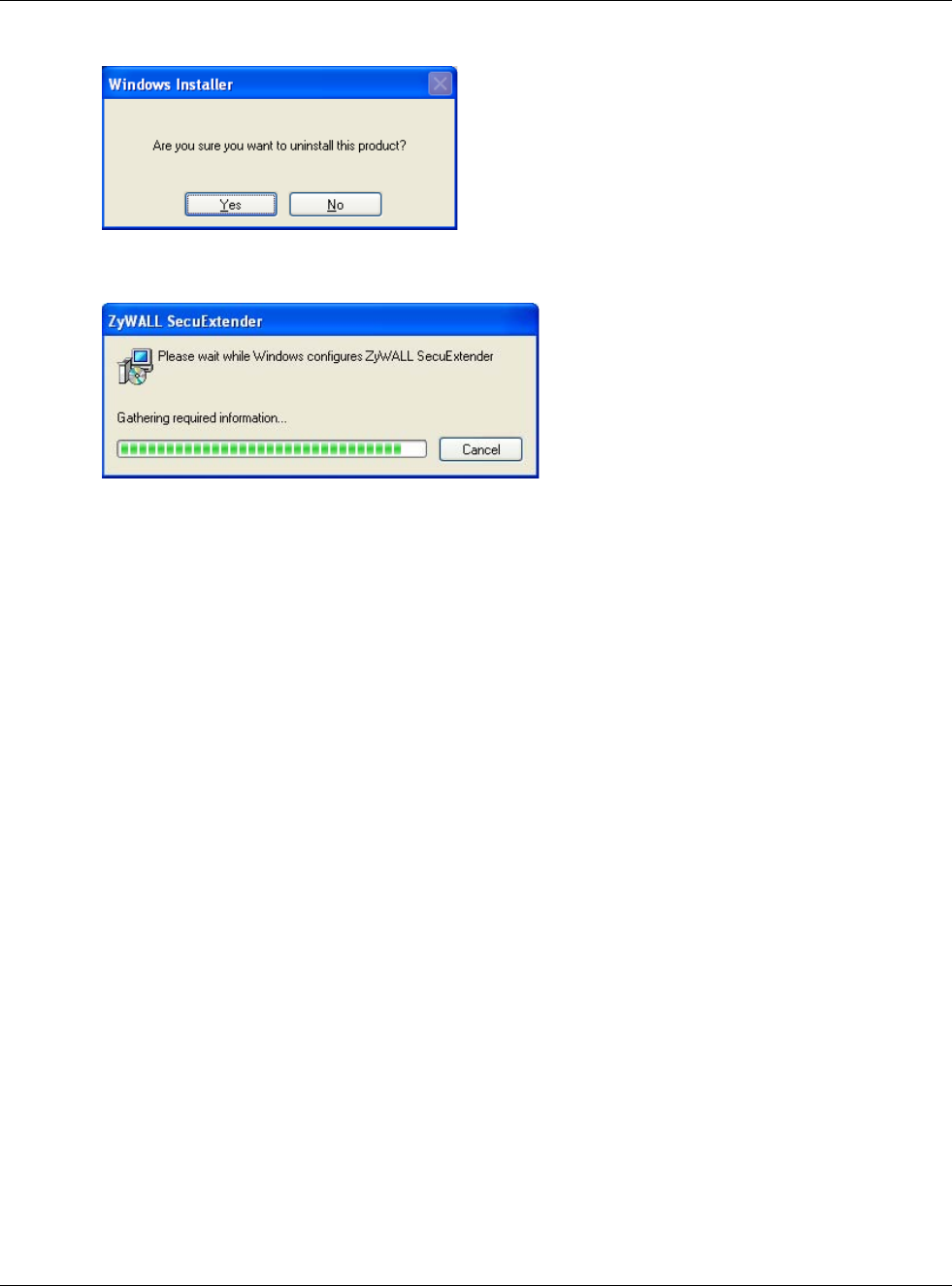
Chapter 24 USG SecuExtender (Windows)
USG20(W)-VPN Series User’s Guide
394
Figure 274 Uninstalling the USG SecuExtender Confirmation
3Windows uninstalls the USG SecuExtender.
Figure 275 USG SecuExtender Uninstallation
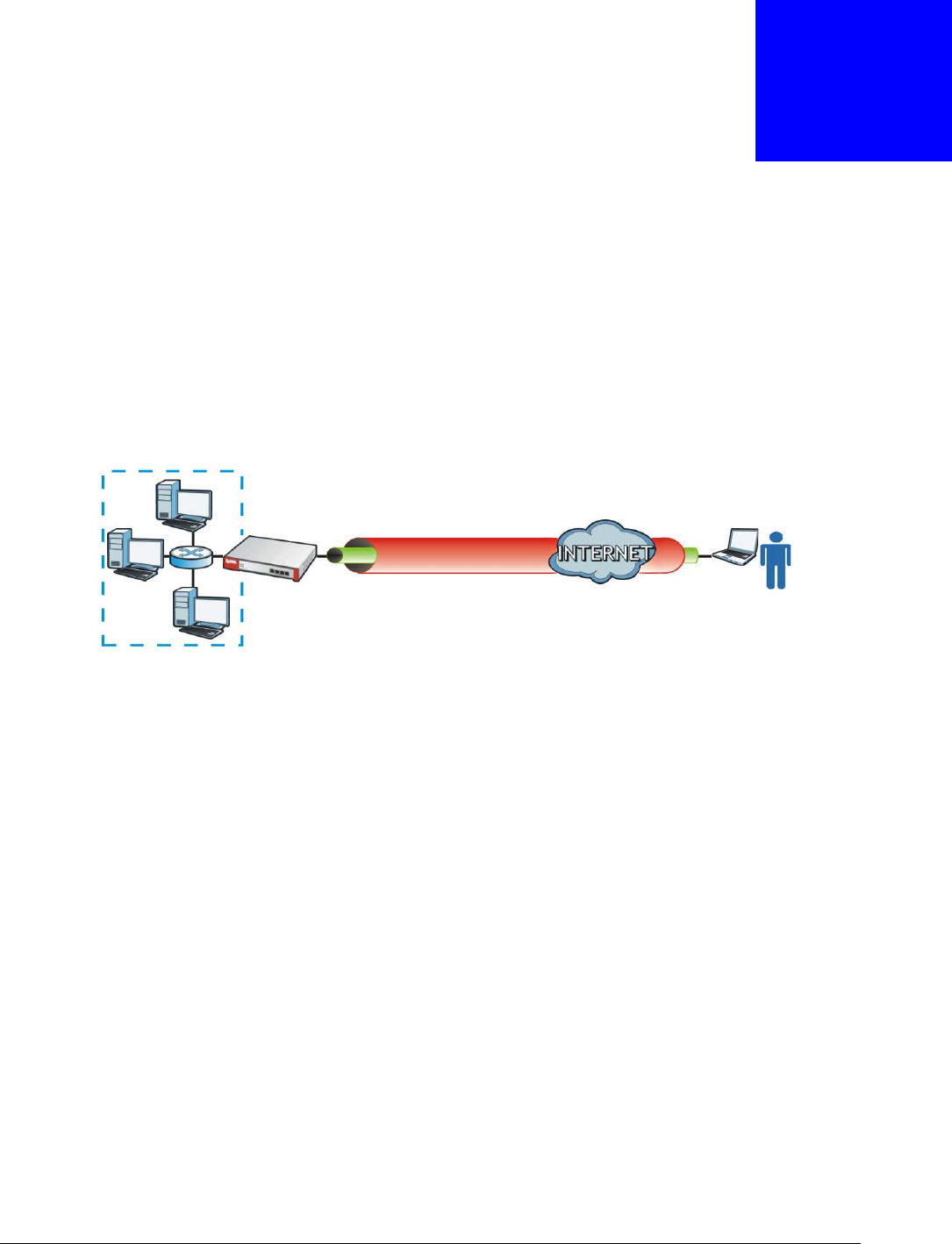
USG20(W)-VPN Series User’s Guide
395
CHAPTER 25
L2TP VPN
25.1 Overview
L2TP VPN uses the L2TP and IPSec client software included in remote users’ Android, iOS, Windows
or Mac OS X operating systems for secure connections to the network behind the USG. The remote
users do not need their own IPSec gateways or third-party VPN client software.
Figure 276 L2TP VPN Overview
25.1.1 What You Can Do in this Chapter
•Use the L2TP VPN screen (see Section 25.2 on page 396) to configure the USG’s L2TP VPN
settings.
•Use the VPN Setup Wizard screen in Quick Setup (Chapter 4 on page 49) to configure the
USG’s L2TP VPN settings.
25.1.2 What You Need to Know
The Layer 2 Tunneling Protocol (L2TP) works at layer 2 (the data link layer) to tunnel network traffic
between two peers over another network (like the Internet). In L2TP VPN, an IPSec VPN tunnel is
established first and then an L2TP tunnel is built inside it. See Chapter 21 on page 332 for
information on IPSec VPN.
IPSec Configuration Required for L2TP VPN
You must configure an IPSec VPN connection prior to proper L2TP VPN usage (see Chapter 25 on
page 395 for details). The IPSec VPN connection must:
• Be enabled.
• Use transport mode.
•Use Pre-Shared Key authentication.
• Use a VPN gateway with the Secure Gateway set to 0.0.0.0 if you need to allow L2TP VPN
clients to connect from more than one IP address.
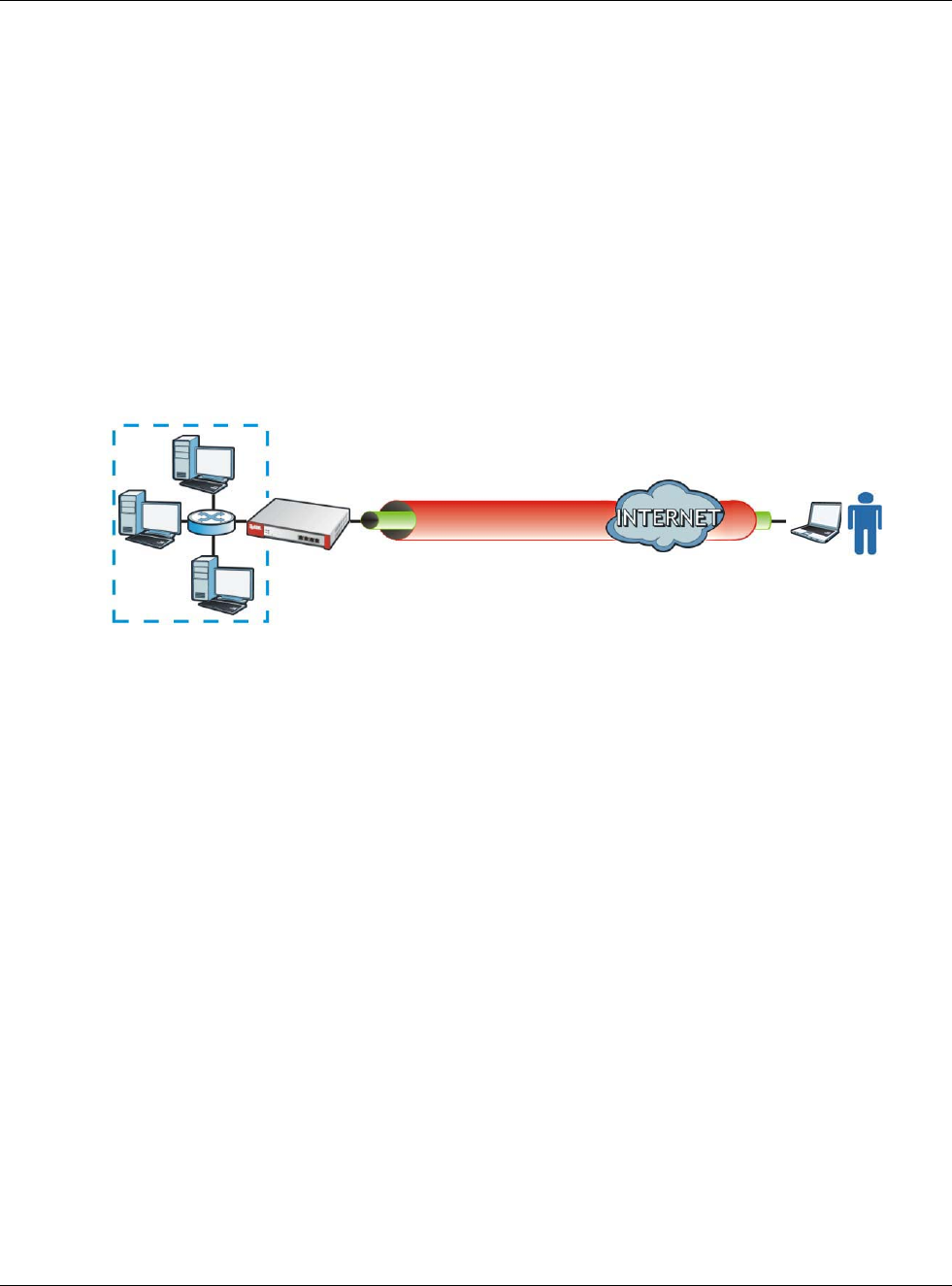
Chapter 25 L2TP VPN
USG20(W)-VPN Series User’s Guide
396
Using the Quick Setup VPN Setup Wizard
The VPN Setup Wizard is an easy and convenient way to configure the L2TP VPN settings. Click
Configuration > Quick Setup > VPN Setup > VPN Settings for L2TP VPN Settings to get
started.
Policy Route
The Policy Route for return traffic (from LAN to L2TP clients) is automatically created when USG
adds a new L2TP connection, allowing users access the resources on a network without additional
configuration. However, if some of the traffic from the L2TP clients needs to go to the Internet, you
will need to create a policy route to send that traffic from the L2TP tunnels out through a WAN
trunk. This task can be easily performed by clicking the Allow L2TP traffic through WAN checkbox at
Quick Setup > VPN Setup > Allow L2TP traffic through WAN.
Figure 277 Policy Route for L2TP VPN
25.2 L2TP VPN Screen
Click Configuration > VPN > L2TP VPN to open the following screen. Use this screen to configure
the USG’s L2TP VPN settings.
Note: Disconnect any existing L2TP VPN sessions before modifying L2TP VPN settings.
The remote users must make any needed matching configuration changes and re-
establish the sessions using the new settings.
Click on the icons to go to the OneSecurity.com website where there is guidance on configuration
walkthroughs, troubleshooting, and other information.
LAN_SUBNET
L2TP_POOL
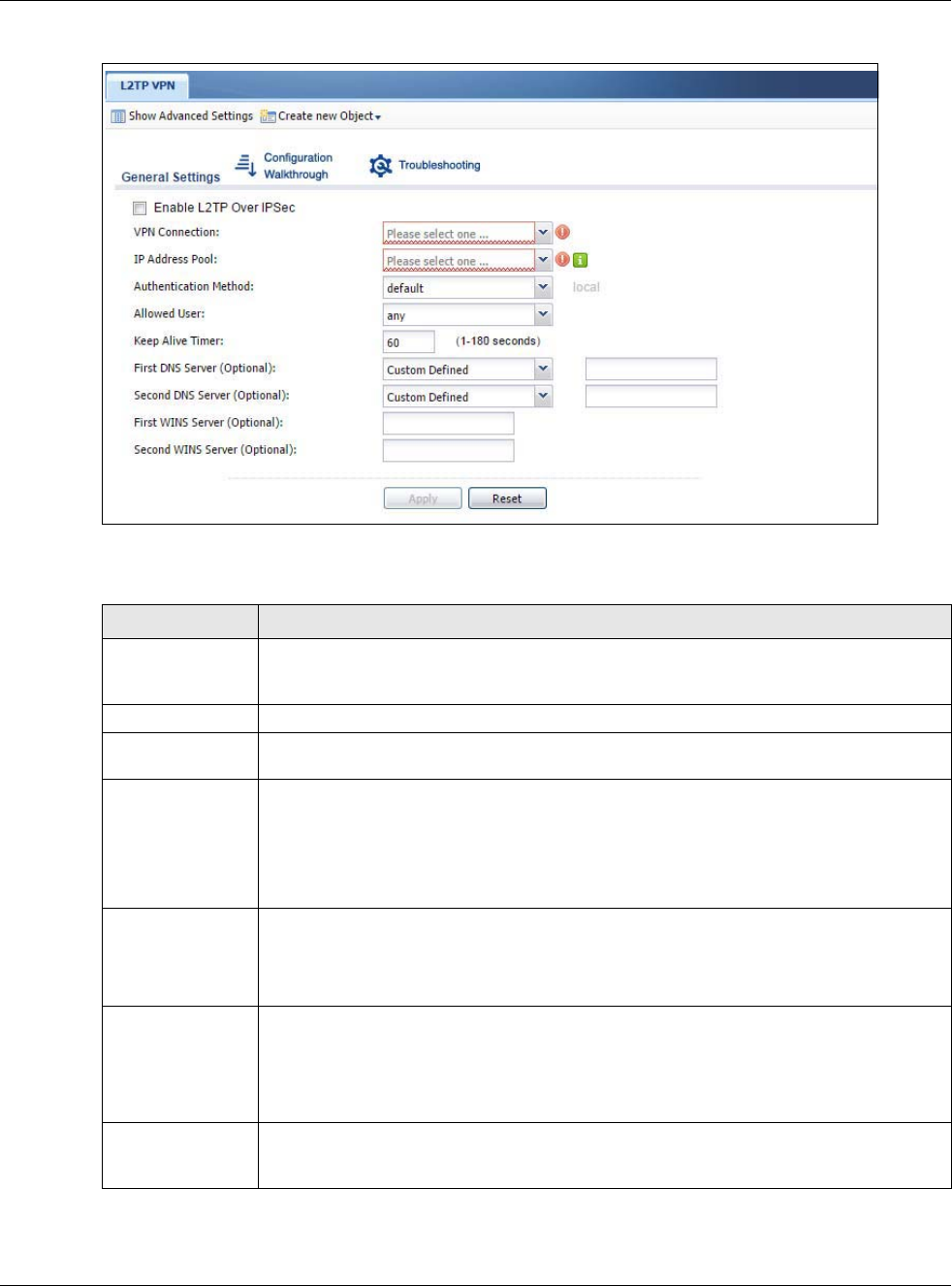
Chapter 25 L2TP VPN
USG20(W)-VPN Series User’s Guide
397
Figure 278 Configuration > VPN > L2TP VPN
The following table describes the fields in this screen.
Table 150 Configuration > VPN > L2TP VPN
LABEL DESCRIPTION
Show Advanced
Settings / Hide
Advanced Settings
Click this button to display a greater or lesser number of configuration fields.
Create new Object Use to configure any new settings objects that you need to use in this screen.
Enable L2TP Over
IPSec
Use this field to turn the USG’s L2TP VPN function on or off.
VPN Connection Select the IPSec VPN connection the USG uses for L2TP VPN. All of the configured VPN
connections display here, but the one you use must meet the requirements listed in IPSec
Configuration Required for L2TP VPN on page 395.
Note: Modifying this VPN connection (or the VPN gateway that it uses) disconnects any
existing L2TP VPN sessions.
IP Address Pool Select the pool of IP addresses that the USG uses to assign to the L2TP VPN clients. Use
Create new Object if you need to configure a new pool of IP addresses.
This should not conflict with any WAN, LAN, DMZ or WLAN subnet even if they are not in
use.
Authentication
Method
Select how the USG authenticates a remote user before allowing access to the L2TP VPN
tunnel.
The authentication method has the USG check a user’s user name and password against
the USG’s local database, a remote LDAP, RADIUS, a Active Directory server, or more
than one of these.
Authentication
Server Certificate
Select the certificate to use to identify the USG for L2TP VPN connections. You must have
certificates already configured in the My Certificates screen. The certificate is used with
the EAP, PEAP, and MSCHAPv2 authentication protocols.
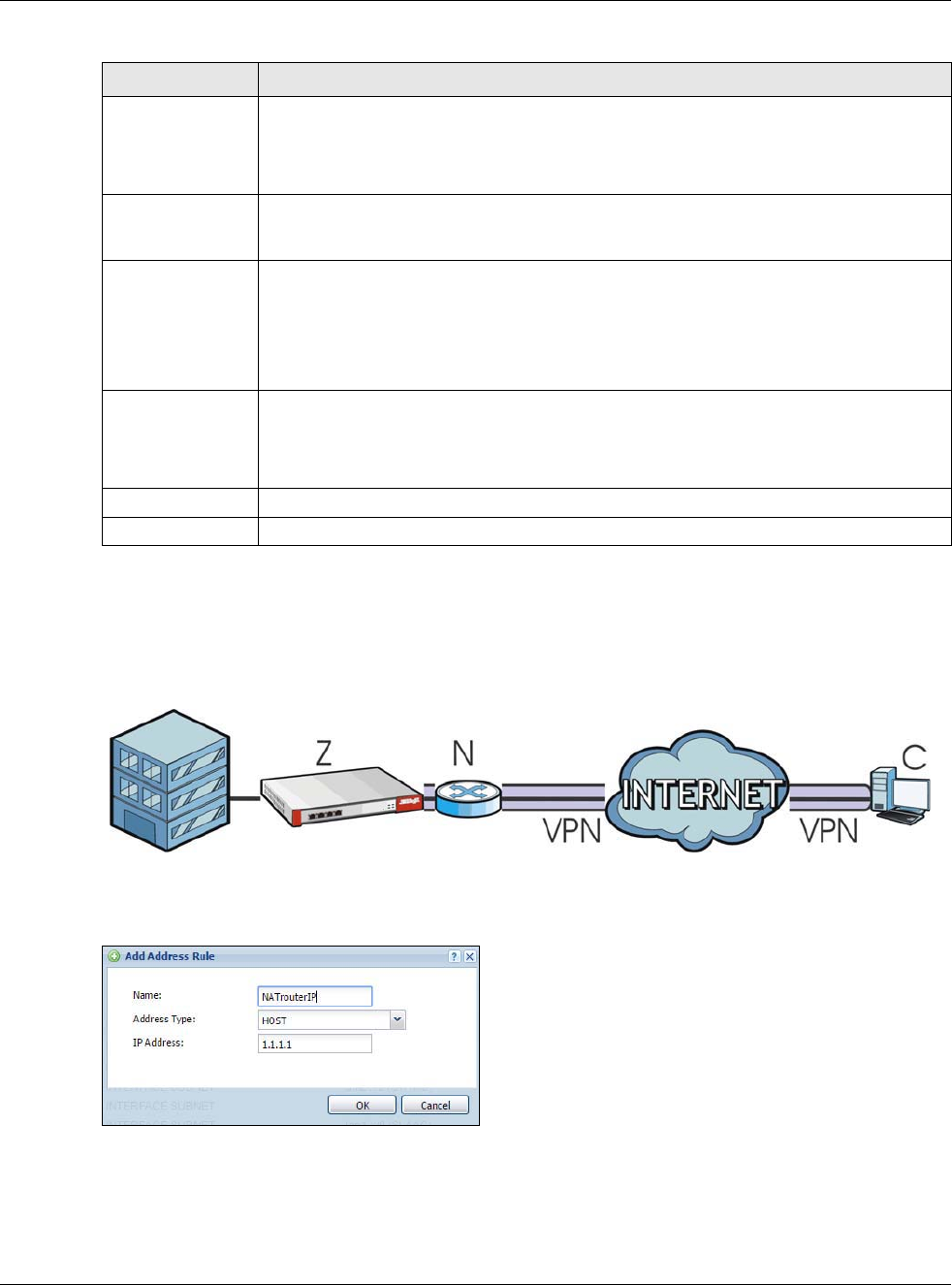
Chapter 25 L2TP VPN
USG20(W)-VPN Series User’s Guide
398
25.2.1 Example: L2TP and USG Behind a NAT Router
If the USG (Z) is behind a NAT router (N), then do the following for remote clients (C) to access the
network behind the USG (Z) using L2TP over IPv4.
1Create an address object in Configuration > Object > Address for the WAN IP address of the
NAT router.
2Go to Configuration > VPN > IPSec VPN > VPN Connection and click Add for IPv4
Configuration to create a new VPN connection.
3Select Remote Access (Server Role) as the VPN scenario for the remote client.
Allowed User The remote user must log into the USG to use the L2TP VPN tunnel.
Select a user or user group that can use the L2TP VPN tunnel. Use Create new Object if
you need to configure a new user account. Otherwise, select any to allow any user with a
valid account and password on the USG to log in.
Keep Alive Timer The USG sends a Hello message after waiting this long without receiving any traffic from
the remote user. The USG disconnects the VPN tunnel if the remote user does not
respond.
First DNS Server,
Second DNS
Server
Specify the IP addresses of DNS servers to assign to the remote users. You can specify
these IP addresses two ways.
Custom Defined - enter a static IP address.
From ISP - use the IP address of a DNS server that another interface received from its
DHCP server.
First WINS Server,
Second WINS
Server
The WINS (Windows Internet Naming Service) server keeps a mapping table of the
computer names on your network and the IP addresses that they are currently using.
Type the IP addresses of up to two WINS servers to assign to the remote users. You can
specify these IP addresses two ways.
Apply Click Apply to save your changes in the USG.
Reset Click Reset to return the screen to its last-saved settings.
Table 150 Configuration > VPN > L2TP VPN (continued)
LABEL DESCRIPTION
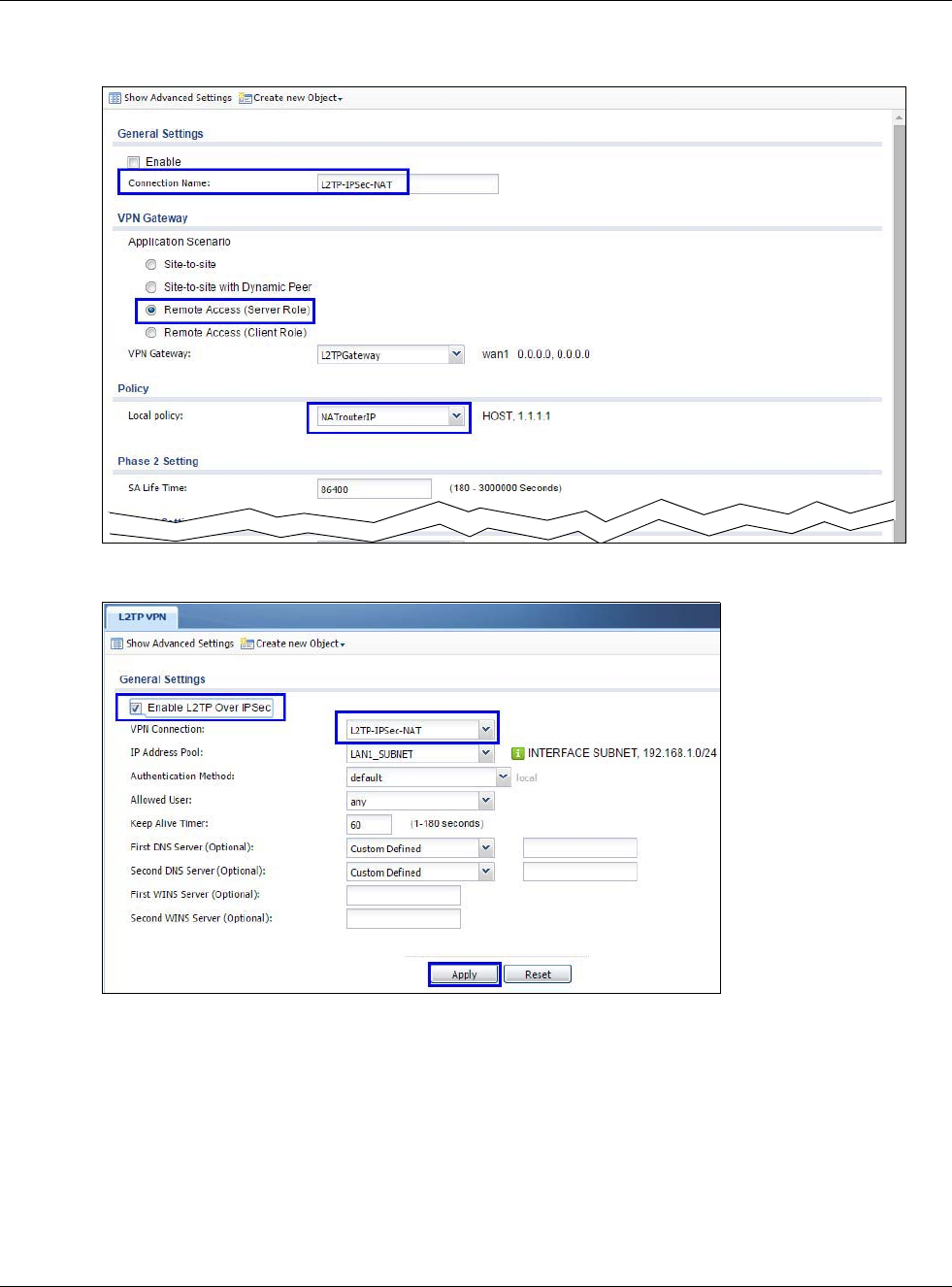
Chapter 25 L2TP VPN
USG20(W)-VPN Series User’s Guide
399
4Select the NAT router WAN IP address object as the Local Policy.
5Go to Configuration > VPN > L2TP VPN and select the VPN Connection just configured.

USG20(W)-VPN Series User’s Guide
400
CHAPTER 26
BWM (Bandwidth Management)
26.1 Overview
Bandwidth management provides a convenient way to manage the use of various services on the
network. It manages general protocols (for example, HTTP and FTP) and applies traffic prioritization
to enhance the performance of delay-sensitive applications like voice and video.
26.1.1 What You Can Do in this Chapter
Use the BWM screens (see Section 26.2 on page 404) to control bandwidth for services passing
through the USG, and to identify the conditions that define the bandwidth control.
26.1.2 What You Need to Know
When you allow a service, you can restrict the bandwidth it uses. It controls TCP and UDP traffic.
Use policy routes to manage other types of traffic (like ICMP).
Note: Bandwidth management in policy routes has priority over TCP and UDP traffic
policies.
If you want to use a service, make sure both the security policy allow the service’s packets to go
through the USG.
Note: The USG checks security policies before it checks bandwidth management rules for
traffic going through the USG.
Bandwidth management examines every TCP and UDP connection passing through the USG. Then,
you can specify, by port, whether or not the USG continues to route the connection.
BWM Type
The USG supports three types of bandwidth management: Shared, Per user and Per-Source-IP.
The Shared BWM type is selected by default in a bandwidth management rule. All matched taffic
shares the bandwidth configured in the rule.
If the BWM type is set to Per user in a rule, each user that matches the rule can use up to the
configured bandwidth by his/her own.
Select the Per-Source-IP type when you want to set the maximum bandwidth for traffic from an
individual source IP address.
In the following example, you configure a Per user bandwidth management rule for radius-users to
limit outgoing traffic to 300 kbs. Then all radius-users (A, B and C) can send 300 kbps of traffic.
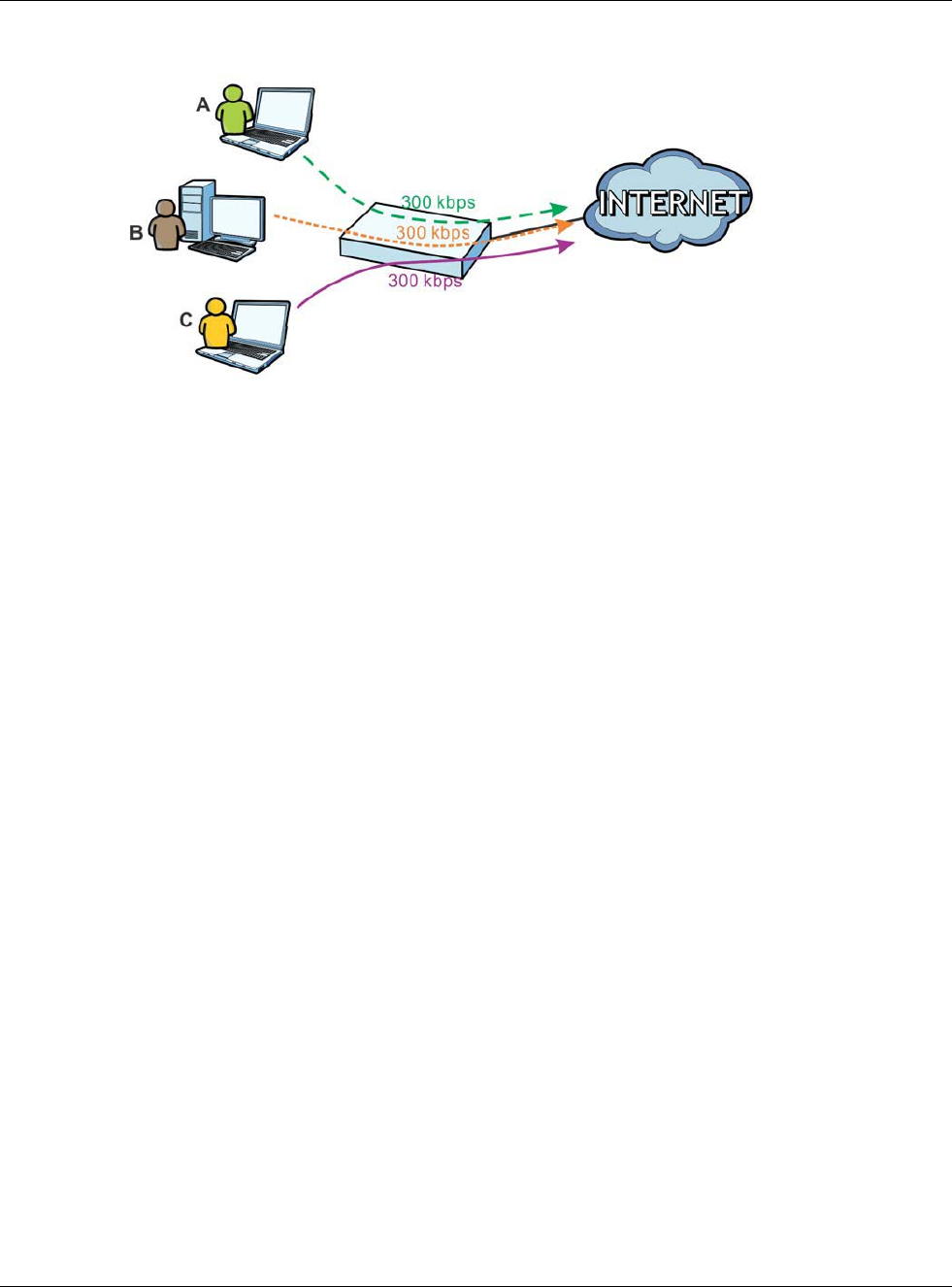
Chapter 26 BWM (Bandwidth Management)
USG20(W)-VPN Series User’s Guide
401
DiffServ and DSCP Marking
QoS is used to prioritize source-to-destination traffic flows. All packets in the same flow are given
the same priority. CoS (class of service) is a way of managing traffic in a network by grouping
similar types of traffic together and treating each type as a class. You can use CoS to give different
priorities to different packet types.
DiffServ (Differentiated Services) is a class of service (CoS) model that marks packets so that they
receive specific per-hop treatment at DiffServ-compliant network devices along the route based on
the application types and traffic flow. Packets are marked with DiffServ Code Points (DSCPs)
indicating the level of service desired. This allows the intermediary DiffServ-compliant network
devices to handle the packets differently depending on the code points without the need to
negotiate paths or remember state information for every flow. In addition, applications do not have
to request a particular service or give advanced notice of where the traffic is going.
Connection and Packet Directions
Bandwidth management looks at the connection direction, that is, from which interface the
connection was initiated and to which interface the connection is going.
A connection has outbound and inbound packet flows. The USG controls the bandwidth of traffic of
each flow as it is going out through an interface or VPN tunnel.
• The outbound traffic flows from the connection initiator to the connection responder.
• The inbound traffic flows from the connection responder to the connection initiator.
For example, a LAN1 to WAN connection is initiated from LAN1 and goes to the WAN.
• Outbound traffic goes from a LAN1 device to a WAN device. Bandwidth management is applied
before sending the packets out a WAN interface on the USG.
• Inbound traffic comes back from the WAN device to the LAN1 device. Bandwidth management is
applied before sending the traffic out a LAN1 interface.
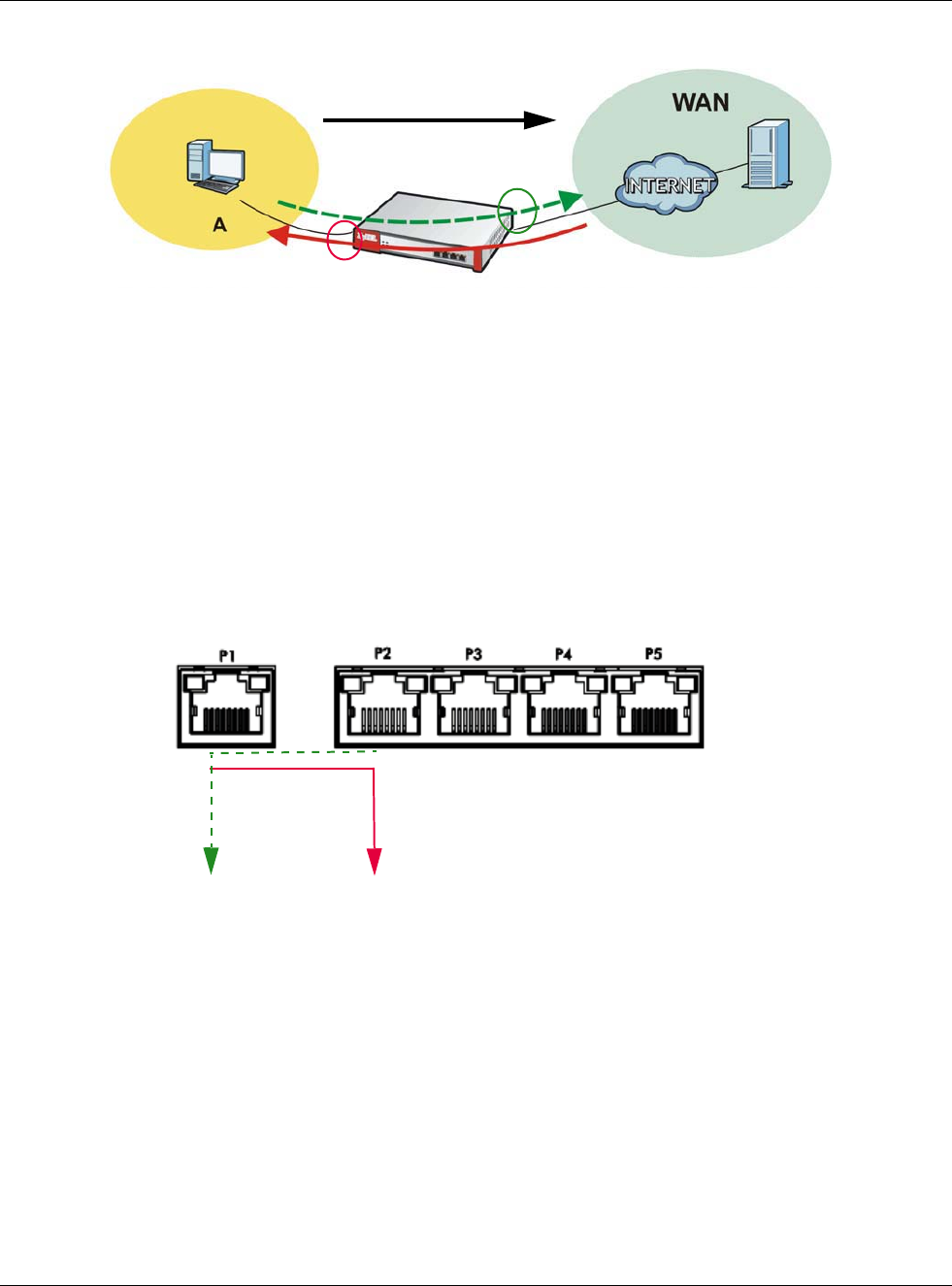
Chapter 26 BWM (Bandwidth Management)
USG20(W)-VPN Series User’s Guide
402
Figure 279 LAN1 to WAN Connection and Packet Directions
Outbound and Inbound Bandwidth Limits
You can limit an application’s outbound or inbound bandwidth. This limit keeps the traffic from using
up too much of the out-going interface’s bandwidth. This way you can make sure there is bandwidth
for other applications. When you apply a bandwidth limit to outbound or inbound traffic, each
member of the out-going zone can send up to the limit. Take a LAN1 to WAN policy for example.
• Outbound traffic is limited to 200 kbps. The connection initiator is on the LAN1 so outbound
means the traffic traveling from the LAN1 to the WAN. Each of the WAN zone’s two interfaces can
send the limit of 200 kbps of traffic.
• Inbound traffic is limited to 500 kbs. The connection initiator is on the LAN1 so inbound means
the traffic traveling from the WAN to the LAN1.
Figure 280 LAN1 to WAN, Outbound 200 kbps, Inbound 500 kbps
Bandwidth Management Priority
• The USG gives bandwidth to higher-priority traffic first, until it reaches its configured bandwidth
rate.
• Then lower-priority traffic gets bandwidth.
• The USG uses a fairness-based (round-robin) scheduler to divide bandwidth among traffic flows
with the same priority.
• The USG automatically treats traffic with bandwidth management disabled as priority 7 (the
lowest priority).
Connection
BWM
BWM
Outbound
Inbound
LAN1
Inbound
Outbound
500 kbps
200 kbps
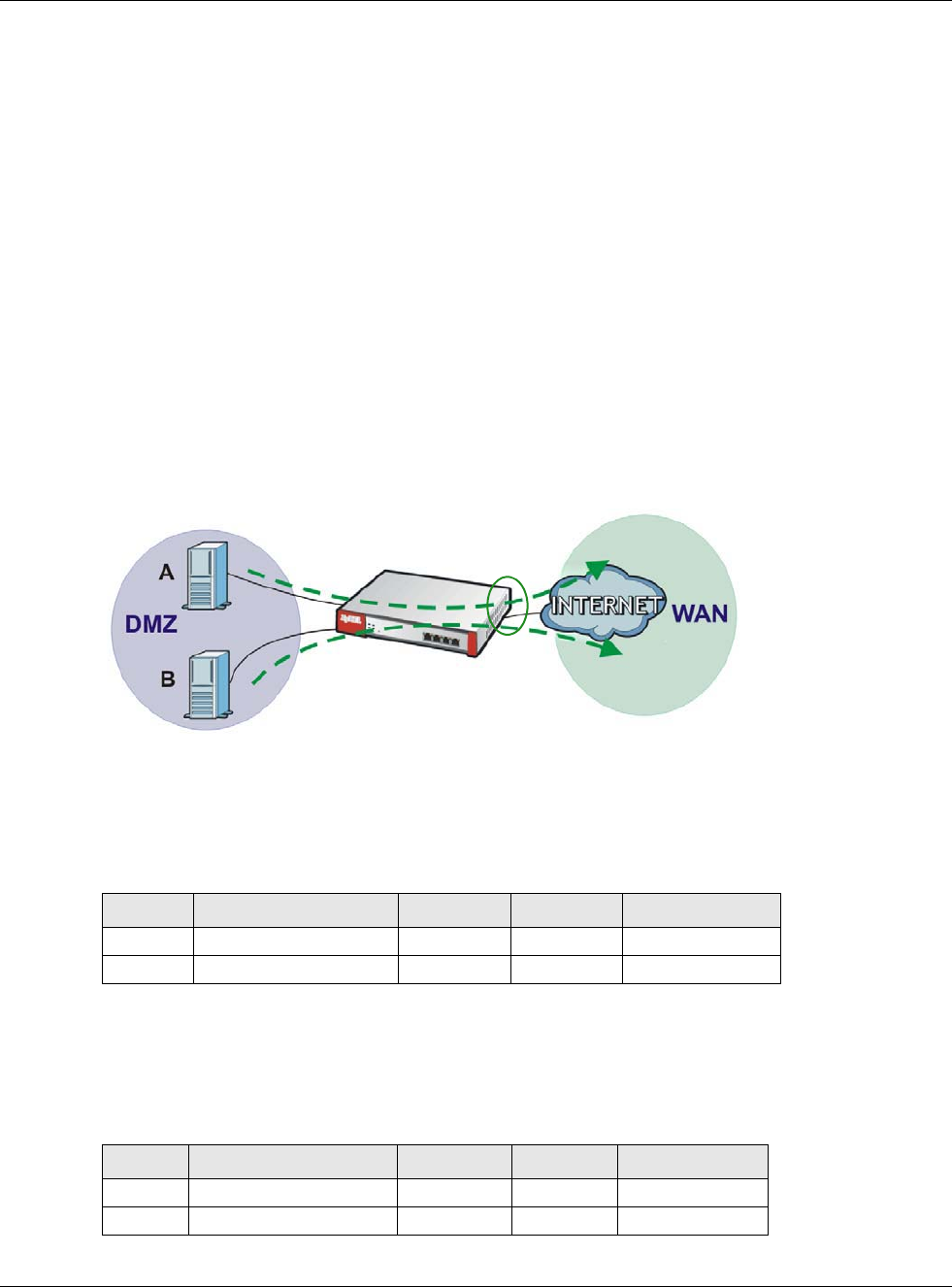
Chapter 26 BWM (Bandwidth Management)
USG20(W)-VPN Series User’s Guide
403
Maximize Bandwidth Usage
Maximize bandwidth usage allows applications with maximize bandwidth usage enabled to “borrow”
any unused bandwidth on the out-going interface.
After each application gets its configured bandwidth rate, the USG uses the fairness- based
scheduler to divide any unused bandwidth on the out-going interface amongst applications that
need more bandwidth and have maximize bandwidth usage enabled.
Unused bandwidth is divided equally. Higher priority traffic does not get a larger portion of the
unused bandwidth.
Bandwidth Management Behavior
The following sections show how bandwidth management behaves with various settings. For
example, you configure DMZ to WAN policies for FTP servers A and B. Each server tries to send
1000 kbps, but the WAN is set to a maximum outgoing speed of 1000 kbps. You configure policy A
for server A’s traffic and policy B for server B’s traffic.
Figure 281 Bandwidth Management Behavior
Configured Rate Effect
In the following table the configured rates total less than the available bandwidth and maximize
bandwidth usage is disabled, both servers get their configured rate.
Priority Effect
Here the configured rates total more than the available bandwidth. Because server A has higher
priority, it gets up to it’s configured rate (800 kbps), leaving only 200 kbps for server B.
Table 151 Configured Rate Effect
POLICY CONFIGURED RATE MAX. B. U. PRIORITY ACTUAL RATE
A 300 kbps No 1 300 kbps
B 200 kbps No 1 200 kbps
Table 152 Priority Effect
POLICY CONFIGURED RATE MAX. B. U. PRIORITY ACTUAL RATE
A 800 kbps Yes 1 800 kbps
B 1000 kbps Yes 2 200 kbps
1000 kbps
1000 kbps
BWM
1000 kbps

Chapter 26 BWM (Bandwidth Management)
USG20(W)-VPN Series User’s Guide
404
Maximize Bandwidth Usage Effect
With maximize bandwidth usage enabled, after each server gets its configured rate, the rest of the
available bandwidth is divided equally between the two. So server A gets its configured rate of 300
kbps and server B gets its configured rate of 200 kbps. Then the USG divides the remaining
bandwidth (1000 - 500 = 500) equally between the two (500 / 2 = 250 kbps for each). The priority
has no effect on how much of the unused bandwidth each server gets.
So server A gets its configured rate of 300 kbps plus 250 kbps for a total of 550 kbps. Server B
gets its configured rate of 200 kbps plus 250 kbps for a total of 450 kbps.
Priority and Over Allotment of Bandwidth Effect
Server A has a configured rate that equals the total amount of available bandwidth and a higher
priority. You should regard extreme over allotment of traffic with different priorities (as shown here)
as a configuration error. Even though the USG still attempts to let all traffic get through and not be
lost, regardless of its priority, server B gets almost no bandwidth with this configuration.
26.2 The Bandwidth Management Screen
The Bandwidth management screens control the bandwidth allocation for TCP and UDP traffic. You
can use source interface, destination interface, destination port, schedule, user, source, destination
information, DSCP code and service type as criteria to create a sequence of specific conditions,
similar to the sequence of rules used by firewalls, to specify how the USG handles the DSCP value
and allocate bandwidth for the matching packets.
Click Configuration > BWM to open the following screen. This screen allows you to enable/disable
bandwidth management and add, edit, and remove user-defined bandwidth management policies.
The default bandwidth management policy is the one with the priority of “default”. It is the last
policy the USG checks if traffic does not match any other bandwidth management policies you have
configured. You cannot remove, activate, deactivate or move the default bandwidth management
policy.
Table 153 Maximize Bandwidth Usage Effect
POLICY CONFIGURED RATE MAX. B. U. PRIORITY ACTUAL RATE
A 300 kbps Yes 1 550 kbps
B 200 kbps Yes 2 450 kbps
Table 154 Priority and Over Allotment of Bandwidth Effect
POLICY CONFIGURED RATE MAX. B. U. PRIORITY ACTUAL RATE
A 1000 kbps Yes 1 999 kbps
B 1000 kbps Yes 2 1 kbps
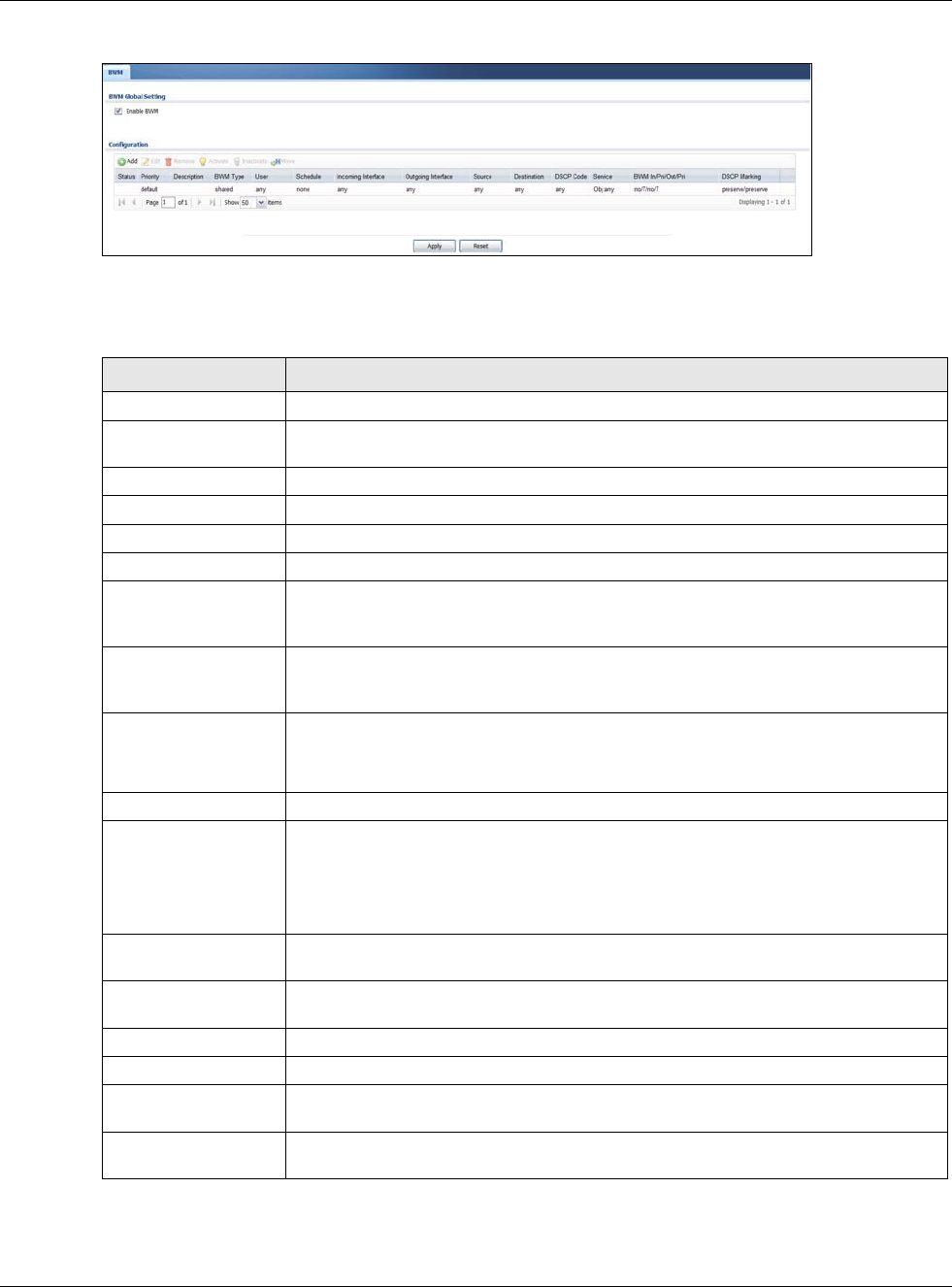
Chapter 26 BWM (Bandwidth Management)
USG20(W)-VPN Series User’s Guide
405
Figure 282 Configuration > Bandwidth Management
The following table describes the labels in this screen. See Section 26.2.1 on page 406 for more
information as well.
Table 155 Configuration > Bandwidth Management
LABEL DESCRIPTION
Enable BWM Select this check box to activate management bandwidth.
Add Click this to create a new entry. Select an entry and click Add to create a new entry
after the selected entry.
Edit Select an entry and click this to be able to modify it.
Remove Select an entry and click this to delete it.
Activate To turn on an entry, select it and click Activate.
Inactivate To turn off an entry, select it and click Inactivate.
Move To change an entry’s position in the numbered list, select it and click Move to display
a field to type a number for where you want to put that entry and press [ENTER] to
move the entry to the number that you typed.
Status The activate (light bulb) icon is lit when the entry is active and dimmed when the
entry is inactive. The status icon is not available for the default bandwidth
management policy.
Priority This field displays a sequential value for each bandwidth management policy and it is
not associated with a specific setting.
This field displays default for the default bandwidth management policy.
Description This field displays additional information about this policy.
BWM Type This field displays the below types of BWM:
•Shared, when the policy is set for all matched traffic
•Per User, when the policy is set for an individual user or a user group
•Per-Source-IP, when the policy is set for a source IP
User This is the type of user account to which the policy applies. If any displays, the policy
applies to all user accounts.
Schedule This is the schedule that defines when the policy applies. none means the policy
always applies.
Incoming Interface This is the source interface of the traffic to which this policy applies.
Outgoing Interface This is the destination interface of the traffic to which this policy applies.
Source This is the source address or address group for whom this policy applies. If any
displays, the policy is effective for every source.
Destination This is the destination address or address group for whom this policy applies. If any
displays, the policy is effective for every destination.

Chapter 26 BWM (Bandwidth Management)
USG20(W)-VPN Series User’s Guide
406
26.2.1 The Bandwidth Management Add/Edit Screen
The Configuration > Bandwidth Management Add/Edit screen allows you to create a new
condition or edit an existing one.
DSCP Code These are the DSCP code point values of incoming and outgoing packets to which this
policy applies. The lower the number the higher the priority with the exception of 0
which is usually given only best-effort treatment.
any means all DSCP value or no DSCP marker.
default means traffic with a DSCP value of 0. This is usually best effort traffic
The “af” options stand for Assured Forwarding. The number following the “af”
identifies one of four classes and one of three drop preferences.
Service Type App and the service name displays if you selected Application Object for the
service type. An Application Object is a pre-defined service.
Obj and the service name displays if you selected Service Object for the service
type. A Service Object is a customized pre-defined service or another service.
Mouse over the service object name to view the corresponding IP protocol number.
BWM In/Pri/Out/Pri This field shows the amount of bandwidth the traffic can use.
In - This is how much inbound bandwidth, in kilobits per second, this policy allows
the matching traffic to use. Inbound refers to the traffic the USG sends to a
connection’s initiator. If no displays here, this policy does not apply bandwidth
management for the inbound traffic.
Out - This is how much outgoing bandwidth, in kilobits per second, this policy allows
the matching traffic to use. Outbound refers to the traffic the USG sends out from a
connection’s initiator. If no displays here, this policy does not apply bandwidth
management for the outbound traffic.
Pri - This is the priority for the incoming (the first Pri value) or outgoing (the second
Pri value) traffic that matches this policy. The smaller the number, the higher the
priority. Traffic with a higher priority is given bandwidth before traffic with a lower
priority. The USG ignores this number if the incoming and outgoing limits are both
set to 0. In this case the traffic is automatically treated as being set to the lowest
priority (7) regardless of this field’s configuration.
DSCP Marking This is how the USG handles the DSCP value of the incoming and outgoing packets
that match this policy.
In - Inbound, the traffic the USG sends to a connection’s initiator.
Out - Outbound, the traffic the USG sends out from a connection’s initiator.
If this field displays a DSCP value, the USG applies that DSCP value to the route’s
outgoing packets.
preserve means the USG does not modify the DSCP value of the route’s outgoing
packets.
default means the USG sets the DSCP value of the route’s outgoing packets to 0.
The “af” choices stand for Assured Forwarding. The number following the “af”
identifies one of four classes and one of three drop preferences.
Apply Click Apply to save your changes back to the USG.
Reset Click Reset to return the screen to its last-saved settings.
Table 155 Configuration > Bandwidth Management
LABEL DESCRIPTION
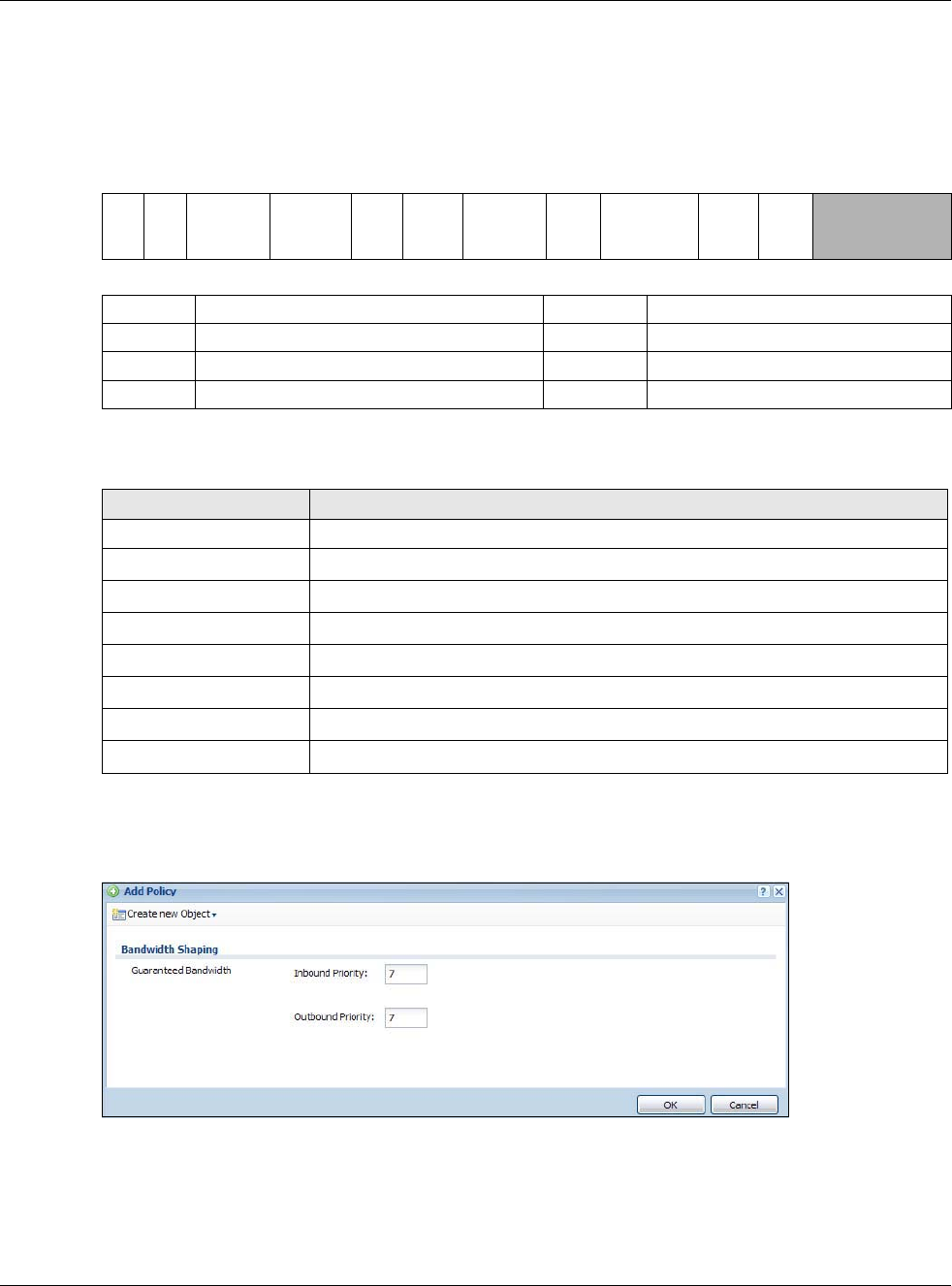
Chapter 26 BWM (Bandwidth Management)
USG20(W)-VPN Series User’s Guide
407
802.1P Marking
Use 802.1P to prioritize outgoing traffic from a VLAN interface. The Priority Code is a 3-bit field
within a 802.1Q VLAN tag that’s used to prioritize associated outgoing VLAN traffic. "0" is the lowest
priority level and "7" is the highest.
The following table is a guide to types of traffic for the priority code.
To access this screen, go to the Configuration > Bandwidth Management screen (see Section
26.2 on page 404), and click either the Add icon or an Edit icon.
Figure 283 Configuration > Bandwidth Management > Edit (For the Default Policy)
Table 156 Single Tagged 802.1Q Frame Format
DA SA TPID Priority VID Len/Etype Data FCS IEEE 802.1Q
customer
tagged frame
Table 157 802.1Q Frame
DA Destination Address Priority 802.1p Priority
SA Source Address Len/Etype Length and type of Ethernet frame
TPID Tag Protocol IDentifier Data Frame data
VID VLAN ID FCS Frame Check Sequence
Table 158 Priority Code and Types of Traffic
PRIORITY TRAFFIC TYPES
0 (lowest) Background
1 Best Effort
2 Excellent Effort
3 Critical Applications
4 Video, less than 100 ms latency and jitter
5 Voice, less than 10 ms latency and jitter
6 Internetwork Control
7 (highest) Network Control
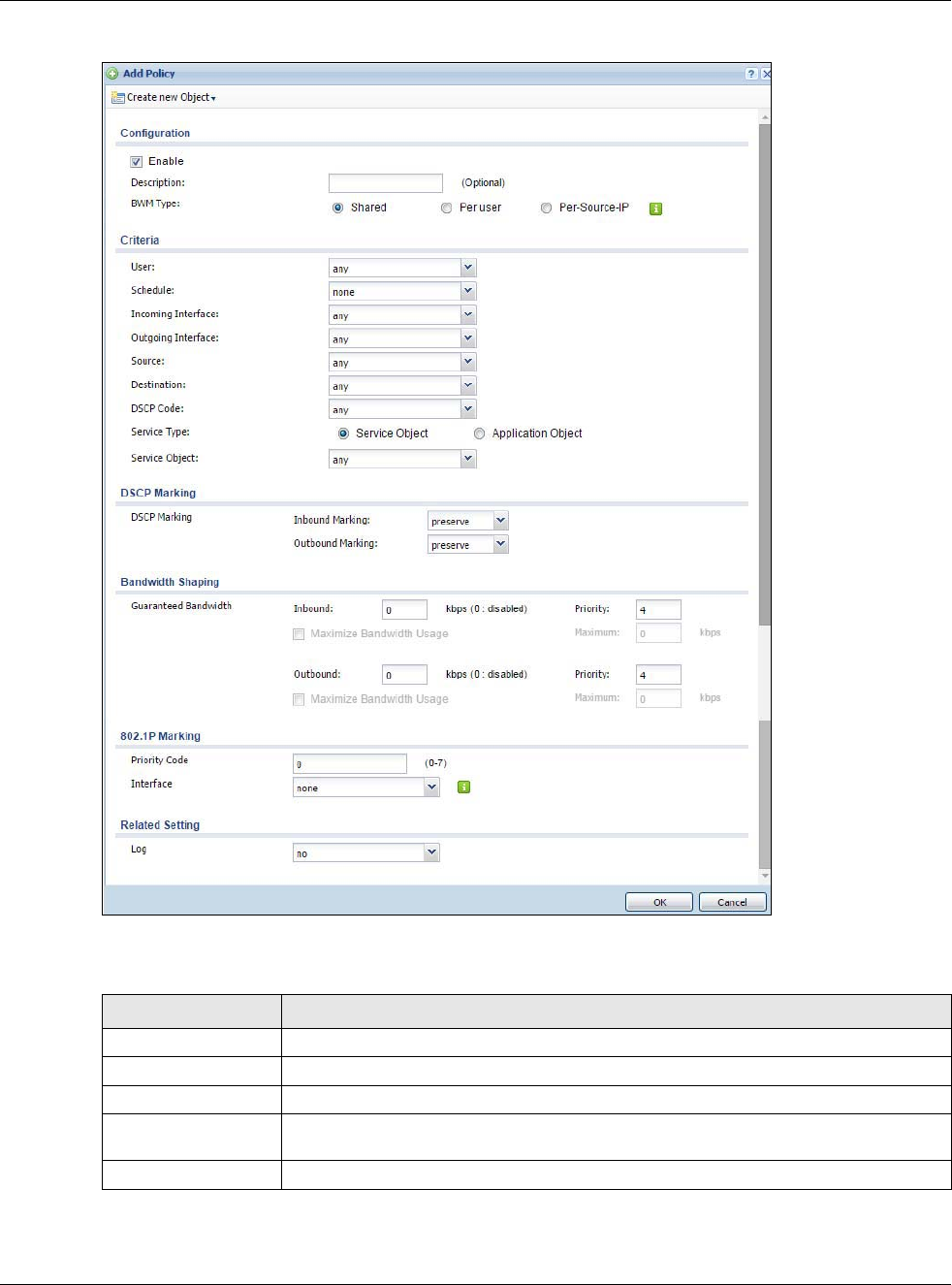
Chapter 26 BWM (Bandwidth Management)
USG20(W)-VPN Series User’s Guide
408
Figure 284 Configuration > Bandwidth Management > Add/Edit
The following table describes the labels in this screen.
Table 159 Configuration > Bandwidth Management > Add/Edit
LABEL DESCRIPTION
Create new Object Use to configure any new settings objects that you need to use in this screen.
Configuration
Enable Select this check box to turn on this policy.
Description Enter a description of this policy. It is not used elsewhere. You can use alphanumeric
and ()+/:=?!*#@$_%- characters, and it can be up to 60 characters long.
Criteria Use this section to configure the conditions of traffic to which this policy applies.

Chapter 26 BWM (Bandwidth Management)
USG20(W)-VPN Series User’s Guide
409
BWM Type This field displays the below types of BWM rule:
• Shared, when the policy is set for all users
• Per User, when the policy is set for an individual user or a user group
• Per Source IP, when the policy is set for a source IP
User Select a user name or user group to which to apply the policy. Use Create new
Object if you need to configure a new user account. Select any to apply the policy for
every user.
Schedule Select a schedule that defines when the policy applies or select Create Object to
configure a new one. Otherwise, select none to make the policy always effective.
Incoming Interface Select the source interface of the traffic to which this policy applies.
Outgoing Interface Select the destination interface of the traffic to which this policy applies.
Source Select a source address or address group for whom this policy applies. Use Create
new Object if you need to configure a new one. Select any if the policy is effective for
every source.
Destination Select a destination address or address group for whom this policy applies. Use
Create new Object if you need to configure a new one. Select any if the policy is
effective for every destination.
DSCP Code Select a DSCP code point value of incoming packets to which this policy
route applies or select User Defined to specify another DSCP code point. The lower
the number the higher the priority with the exception of 0 which is usually given only
best-effort treatment.
any means all DSCP value or no DSCP marker.
default means traffic with a DSCP value of 0. This is usually best effort traffic
The “af” choices stand for Assured Forwarding. The number following the “af”
identifies one of four classes and one of three drop preferences.
User-Defined
DSCP Code Use this field to specify a custom DSCP code point.
Service Type Select Service Object if you want a specific service (defined in a service object) to
which the policy applies.
Service Object This field is available if you selected Service Object as the service type.
Select a service or service group to identify the type of traffic to which this policy
applies. any means all services.
DSCP Marking Set how the USG handles the DSCP value of the incoming and outgoing packets that
match this policy. Inbound refers to the traffic the USG sends to a connection’s
initiator. Outbound refers to the traffic the USG sends out from a connection’s initiator.
Select one of the pre-defined DSCP values to apply or select User Defined to specify
another DSCP value. The “af” choices stand for Assured Forwarding. The number
following the “af” identifies one of four classes and one of three drop preferences.
Select preserve to have the USG keep the packets’ original DSCP value.
Select default to have the USG set the DSCP value of the packets to 0.
Bandwidth Shaping Configure these fields to set the amount of bandwidth the matching traffic can use.
Table 159 Configuration > Bandwidth Management > Add/Edit
LABEL DESCRIPTION

Chapter 26 BWM (Bandwidth Management)
USG20(W)-VPN Series User’s Guide
410
Inbound kbps Type how much inbound bandwidth, in kilobits per second, this policy allows the traffic
to use. Inbound refers to the traffic the USG sends to a connection’s initiator.
If you enter 0 here, this policy does not apply bandwidth management for the
matching traffic that the USG sends to the initiator. Traffic with bandwidth
management disabled (inbound and outbound are both set to 0) is automatically
treated as the lowest priority (7).
If the sum of the bandwidths for routes using the same next hop is higher than the
actual transmission speed, lower priority traffic may not be sent if higher priority
traffic uses all of the actual bandwidth.
Outbound kbps Type how much outbound bandwidth, in kilobits per second, this policy allows the
traffic to use. Outbound refers to the traffic the USG sends out from a connection’s
initiator.
If you enter 0 here, this policy does not apply bandwidth management for the
matching traffic that the USG sends out from the initiator. Traffic with bandwidth
management disabled (inbound and outbound are both set to 0) is automatically
treated as the lowest priority (7).
If the sum of the bandwidths for routes using the same next hop is higher than the
actual transmission speed, lower priority traffic may not be sent if higher priority
traffic uses all of the actual bandwidth.
Priority This field displays when the inbound or outbound bandwidth management is not set to
0. Enter a number between 1 and 7 to set the priority for traffic that matches this
policy. The smaller the number, the higher the priority.
Traffic with a higher priority is given bandwidth before traffic with a lower priority.
The USG uses a fairness-based (round-robin) scheduler to divide bandwidth between
traffic flows with the same priority.
The number in this field is ignored if the incoming and outgoing limits are both set to
0. In this case the traffic is automatically treated as being set to the lowest priority (7)
regardless of this field’s configuration.
Maximize
Bandwidth Usage This field displays when the inbound or outbound bandwidth management is not set to
0 and the BWM Type is set to Shared. Enable maximize bandwidth usage to let the
traffic matching this policy “borrow” all unused bandwidth on the out-going interface.
After each application or type of traffic gets its configured bandwidth rate, the USG
uses the fairness-based scheduler to divide any unused bandwidth on the out-going
interface among applications and traffic types that need more bandwidth and have
maximize bandwidth usage enabled.
Maximum If you did not enable Maximize Bandwidth Usage, then type the maximium unused
bandwidth that traffic matching this policy is allowed to “borrow” on the out-going
interface (in Kbps), here.
802.1P Marking Use 802.1P to prioritize outgoing traffic from a VLAN interface.
Priority Code This is a 3-bit field within a 802.1Q VLAN tag that’s used to prioritize associated
outgoing VLAN traffic. "0" is the lowest priority level and "7" is the highest. See Table
158 on page 407. The setting configured here overwrites existing priority settings.
Interface Choose a VLAN interface to which to apply the priority level for matching frames.
Related Setting
Log Select whether to have the USG generate a log (log), log and alert (log alert) or
neither (no) when any traffic matches this policy.
OK Click OK to save your changes back to the USG.
Cancel Click Cancel to exit this screen without saving your changes.
Table 159 Configuration > Bandwidth Management > Add/Edit
LABEL DESCRIPTION
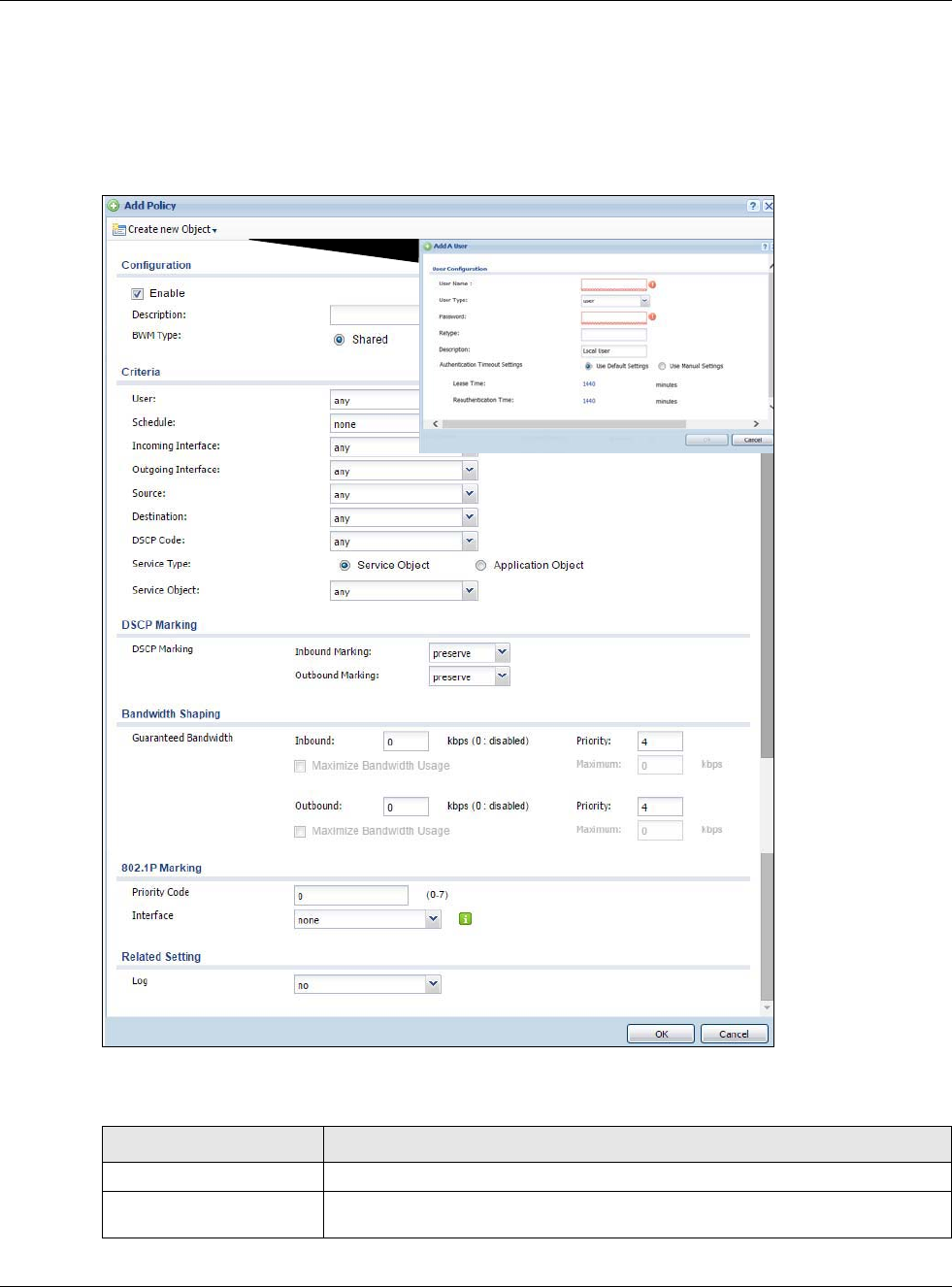
Chapter 26 BWM (Bandwidth Management)
USG20(W)-VPN Series User’s Guide
411
26.2.1.1 Adding Objects for the BWM Policy
Objects are parameters to which the Policy rules are built upon. There are three kinds of objects
you can add/edit for the BWM policy, they are User, Schedule and Address objects. Click
Configuration > BWM > Add > Create New Object > Add User to see the following screen.
Figure 285 Configuration >BWM > Create New Object > Add User
The following table describes the fields in the above screen.
Table 160 Configuration > BWM > Create New Object > Add User
LABEL DESCRIPTION
User Name Type a user or user group object name of the rule.
User Type Select a user type from the drop down menu. The user types are Admin, Limited
admin, User, Guest, Ext-user, Ext-group-user.
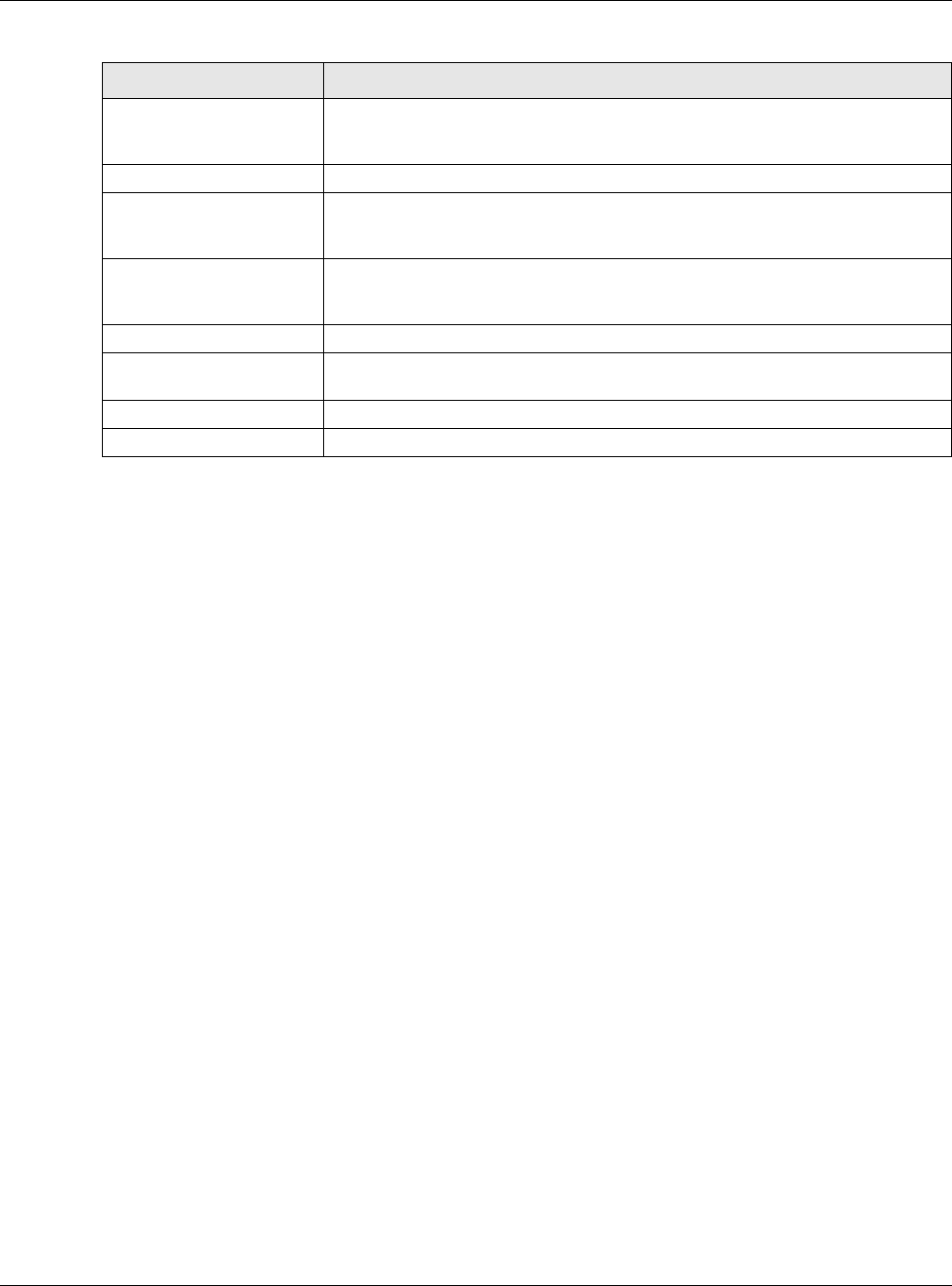
Chapter 26 BWM (Bandwidth Management)
USG20(W)-VPN Series User’s Guide
412
Password Type a password for the user object. The password can consist of alphanumeric
characters, the underscore, and some punctuation marks (+-/*= :; .! @$&%#~
‘ \ () ), and it can be up to eight characters long.
Retype Retype the password to confirm.
Description Enter a description for this user object. It is not used elsewhere. You can use
alphanumeric and ()+/:=?!*#@$_%- characters, and it can be up to 60
characters long.
Authentication Timeout
Settings
Choose either Use Default setting option, which shows the default Lease Time
of 1,440 minutes and Reauthentication Time of 1,440 minutes or you can enter
them manually by choosing Use Manual Settings option.
Lease Time This shows the Lease Time setting for the user, by default it is 1,440 minutes.
Reauthentication Time This shows the Reauthentication Time for the user, by default it is 1,440
minutes.
OK Click OK to save the setting.
Cancel Click Cancel to abandon this screen.
Table 160 Configuration > BWM > Create New Object > Add User
LABEL DESCRIPTION
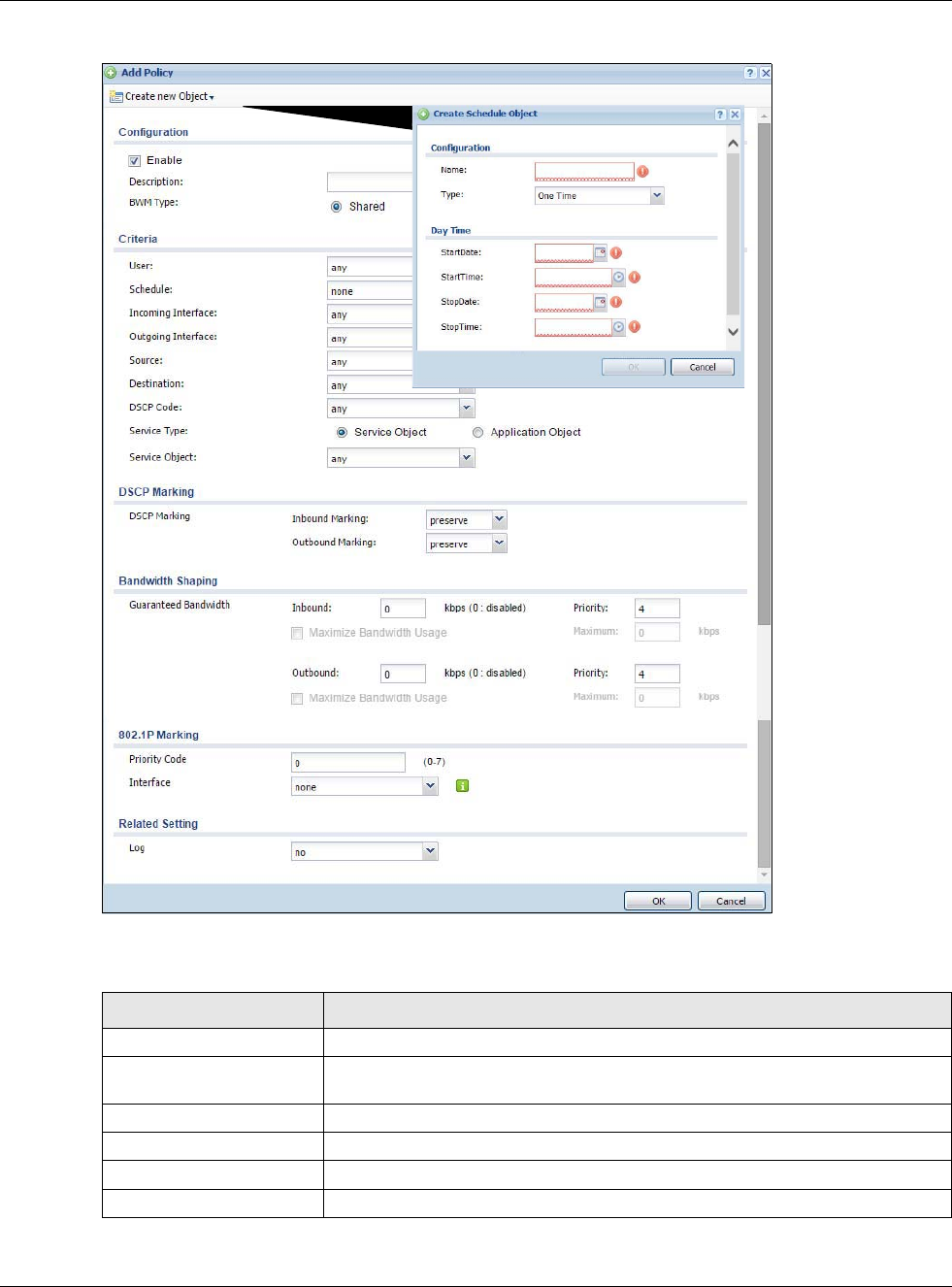
Chapter 26 BWM (Bandwidth Management)
USG20(W)-VPN Series User’s Guide
413
Figure 286 Configuration > BWM > Create New Object > Add Schedule
The following table describes the fields in the above screen.
Table 161 Configuration > BWM > Create New Object > Add Schedule
LABEL DESCRIPTION
Name Enter a name for the schedule object of the rule.
Type Select an option from the drop down menu for the schedule object. It will show
One Time or Recurring.
Start Date Click the icon menu on the right to choose a Start Date for the schedule object.
Start Time Click the icon menu on the right to choose a Start Time for the schedule object.
Stop Date Click the icon menu on the right to choose a Stop Date for schedule object.
Stop Time Click the icon menu on the right to choose a Stop Time for the schedule object.
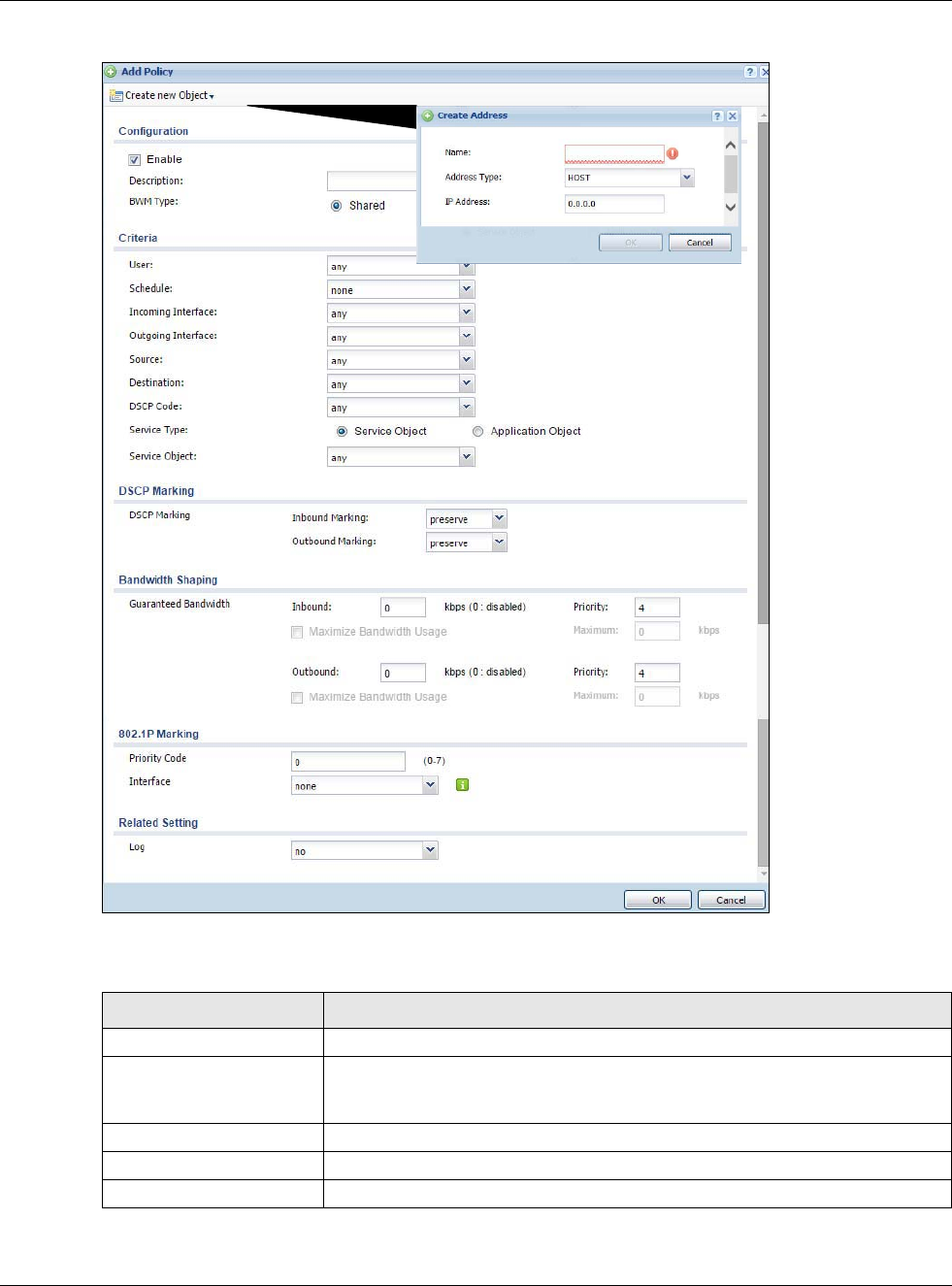
Chapter 26 BWM (Bandwidth Management)
USG20(W)-VPN Series User’s Guide
414
Figure 287 Configuration > BWM > Create New Object > Add Address
The following table describes the fields in the above screen.
Table 162 Configuration > BWM > Create New Object > Add Address
LABEL DESCRIPTION
Name Enter a name for the Address object of the rule.
Address Type Select an Address Type from the drop down menu on the right. The Address
Types are Host, Range, Subnet, Interface IP, Interface Subnet, and Interface
Gateway.
IP Address Enter an IP address for the Address object.
OK Click OK to save the setting.
Cancel Click Cancel to abandon the setting.

USG20(W)-VPN Series User’s Guide
415
CHAPTER 27
Content Filtering
27.1 Overview
Use the content filtering feature to control access to specific web sites or web content.
27.1.1 What You Can Do in this Chapter
•Use the Filter Profile screens (Section Figure 289 on page 420) to set up content filtering
profiles.
•Use the Trusted Web Sites screens (Section 27.4 on page 430) to create a common list of good
(allowed) web site addresses.
•Use the Forbidden Web Sites screens (Section 27.5 on page 431) to create a common list of
bad (blocked) web site addresses.
27.1.2 What You Need to Know
Content Filtering
Content filtering allows you to block certain web features, such as cookies, and/or block access to
specific web sites. It can also block access to specific categories of web site content. You can create
different content filter policies for different addresses, schedules, users or groups and content filter
profiles. For example, you can configure one policy that blocks John Doe’s access to arts and
entertainment web pages during the workday and another policy that lets him access them after
work.
Content Filtering Policies
A content filtering policy allows you to do the following.
• Use schedule objects to define when to apply a content filter profile.
• Use address and/or user/group objects to define to whose web access to apply the content filter
profile.
• Apply a content filter profile that you have custom-tailored.
Content Filtering Profiles
A content filtering profile conveniently stores your custom settings for the following features.
• Category-based Blocking
The USG can block access to particular categories of web site content, such as pornography or
racial intolerance.

Chapter 27 Content Filtering
USG20(W)-VPN Series User’s Guide
416
• Restrict Web Features
The USG can disable web proxies and block web features such as ActiveX controls, Java applets
and cookies.
• Customize Web Site Access
You can specify URLs to which the USG blocks access. You can alternatively block access to all
URLs except ones that you specify. You can also have the USG block access to URLs that contain
particular keywords.
Content Filtering Configuration Guidelines
When the USG receives an HTTP request, the content filter searches for a policy that matches the
source address and time (schedule). The content filter checks the policies in order (based on the
policy numbers). When a matching policy is found, the content filter allows or blocks the request
depending on the settings of the filtering profile specified by the policy. Some requests may not
match any policy. The USG allows the request if the default policy is not set to block. The USG
blocks the request if the default policy is set to block.
External Web Filtering Service
When you register for and enable the external web filtering service, your USG accesses an external
database that has millions of web sites categorized based on content. You can have the USG block,
block and/or log access to web sites based on these categories.
Keyword Blocking URL Checking
The USG checks the URL’s domain name (or IP address) and file path separately when performing
keyword blocking.
The URL’s domain name or IP address is the characters that come before the first slash in the URL.
For example, with the URL www.zyxel.com.tw/news/pressroom.php, the domain name is
www.zyxel.com.tw.
The file path is the characters that come after the first slash in the URL. For example, with the URL
www.zyxel.com.tw/news/pressroom.php, the file path is news/pressroom.php.
Since the USG checks the URL’s domain name (or IP address) and file path separately, it will not
find items that go across the two. For example, with the URL www.zyxel.com.tw/news/
pressroom.php, the USG would find “tw” in the domain name (www.zyxel.com.tw). It would also
find “news” in the file path (news/pressroom.php) but it would not find “tw/news”.
Finding Out More
•See Section 27.6 on page 432 for content filtering background/technical information.
27.1.3 Before You Begin
• You must configure an address object, a schedule object and a filtering profile before you can set
up a content security policy.
• You must have Content Filtering license in order to use the function.subscribe to use the external
database content filtering (see the Licensing > Registration screens).
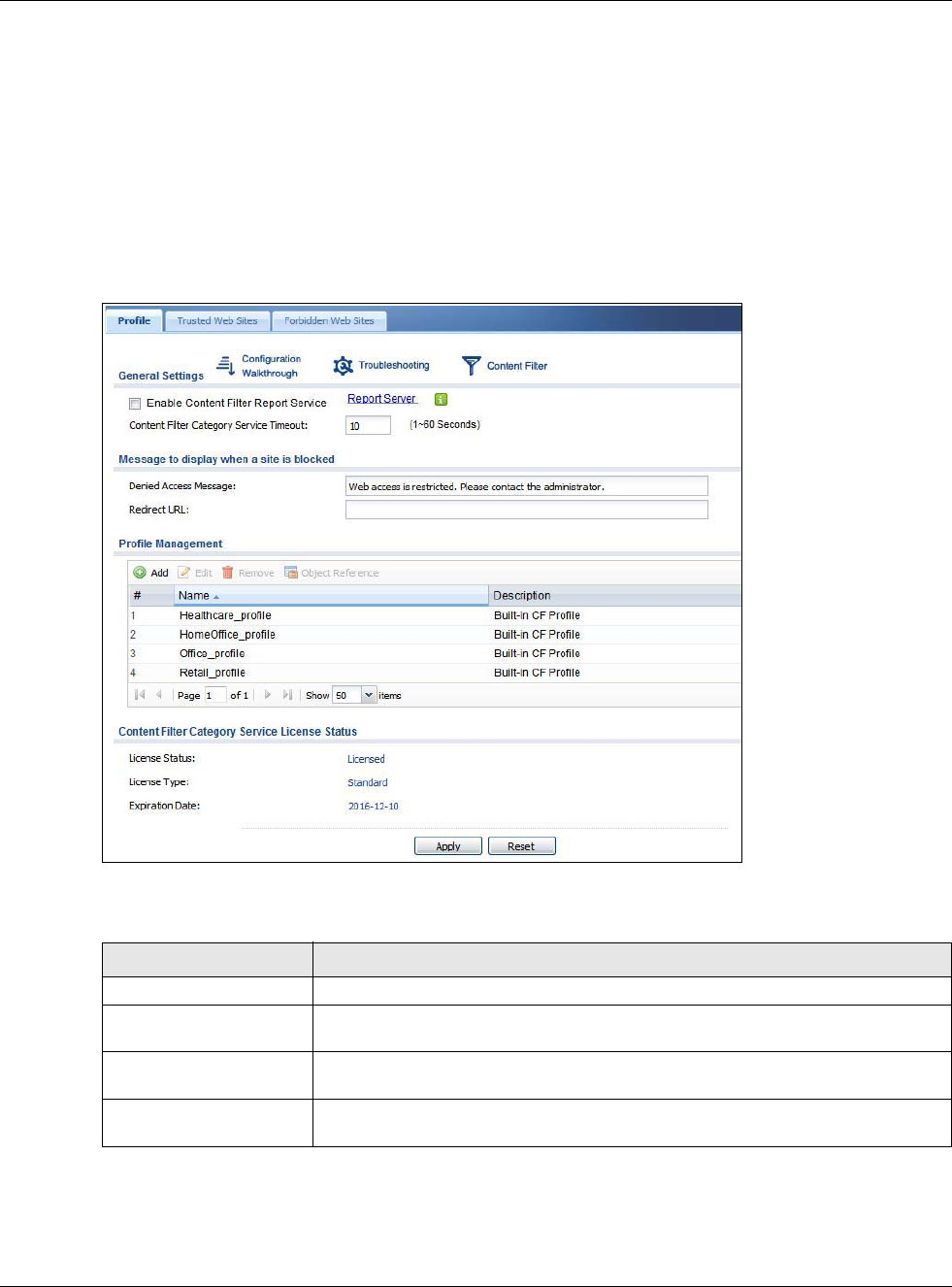
Chapter 27 Content Filtering
USG20(W)-VPN Series User’s Guide
417
27.2 Content Filter Profile Screen
Click Configuration > UTM Profile> Content Filter > Profile to open the Content Filter
Profile screen. Use this screen to enable content filtering, view and order your list of content filter
policies, create a denial of access message or specify a redirect URL and check your external web
filtering service registration status.
Click on the icons to go to the OneSecurity.com website where there is guidance on configuration
walkthroughs, troubleshooting and other information.
Figure 288 Configuration > UTM Profile > Content Filter > Profile
The following table describes the labels in this screen.
Table 163 Configuration > UTM Profile > Content Filter > Profile
LABEL DESCRIPTION
General Settings
Enable Content Filter
Report Service
Select this check box to have the USG collect category-based content filtering
statistics.
Report Server Click this link to choose where your USG is registered: myZyXEL.com or
myZyXEL.com 2.0. Choose myZyXEL.com 2.0 for a model in this series.
Content Filter Category
Service Timeout
Specify the allowable time period in seconds for accessing the external web
filtering service’s server.

Chapter 27 Content Filtering
USG20(W)-VPN Series User’s Guide
418
Denied Access Message Enter a message to be displayed when content filter blocks access to a web page.
Use up to 127 characters (0-9a-zA-Z;/?:@&=+$\.-_!~*'()%,”). For example,
“Access to this web page is not allowed. Please contact the network
administrator”.
It is also possible to leave this field blank if you have a URL specified in the
Redirect URL field. In this case if the content filter blocks access to a web page,
the USG just opens the web page you specified without showing a denied access
message.
Redirect URL Enter the URL of the web page to which you want to send users when their web
access is blocked by content filter. The web page you specify here opens in a new
frame below the denied access message.
Use “http://” or “https://” followed by up to 262 characters (0-9a-zA-Z;/
?:@&=+$\.-_!~*'()%). For example, http://192.168.1.17/blocked access.
Profile Management
Add Click Add to create a new content filter rule.
Edit Click Edit to make changes to a content filter rule.
Remove Click Remove the delete a content filter rule.
Object Reference Select an entry and click Object References to open a screen that shows which
settings use the entry. Click Refresh to update information on this screen.
# This column lists the index numbers of the content filter profile.
Name This column lists the names of the content filter profile rule.
Description This column lists the description of the content filter profile rule.
Reference This displays the number of times an Object Reference is used in a rule.
License Status This read-only field displays the status of your content-filtering database service
registration.
Not Licensed displays if you have not successfully registered and activated the
service.
Expired displays if your subscription to the service has expired.
Licensed displays if you have successfully registered the USG and activated the
service.
You can view content filter reports after you register the USG and activate the
subscription service in the Registration screen.
License Type This read-only field displays what kind of service registration you have for the
content-filtering database.
None displays if you have not successfully registered and activated the service.
Standard displays if you have successfully registered the USG and activated the
service.
Trial displays if you have successfully registered the USG and activated the trial
service subscription.
Expiration Date This field displays the date your service license expires.
Register Now This link appears if you have not registered for the service or the service has
expired. Click this link to go to the screen where you can register for the service.
Apply Click Apply to save your changes back to the USG.
Reset Click Reset to return the screen to its last-saved settings.
Table 163 Configuration > UTM Profile > Content Filter > Profile (continued)
LABEL DESCRIPTION

Chapter 27 Content Filtering
USG20(W)-VPN Series User’s Guide
419
27.3 Content Filter Profile Add or Edit Screen
Click Configuration > UTM > Content Filter > Profile > Add or Edit to open the Add Filter
Profile screen. Configure Category Service and Custom Service tabs.
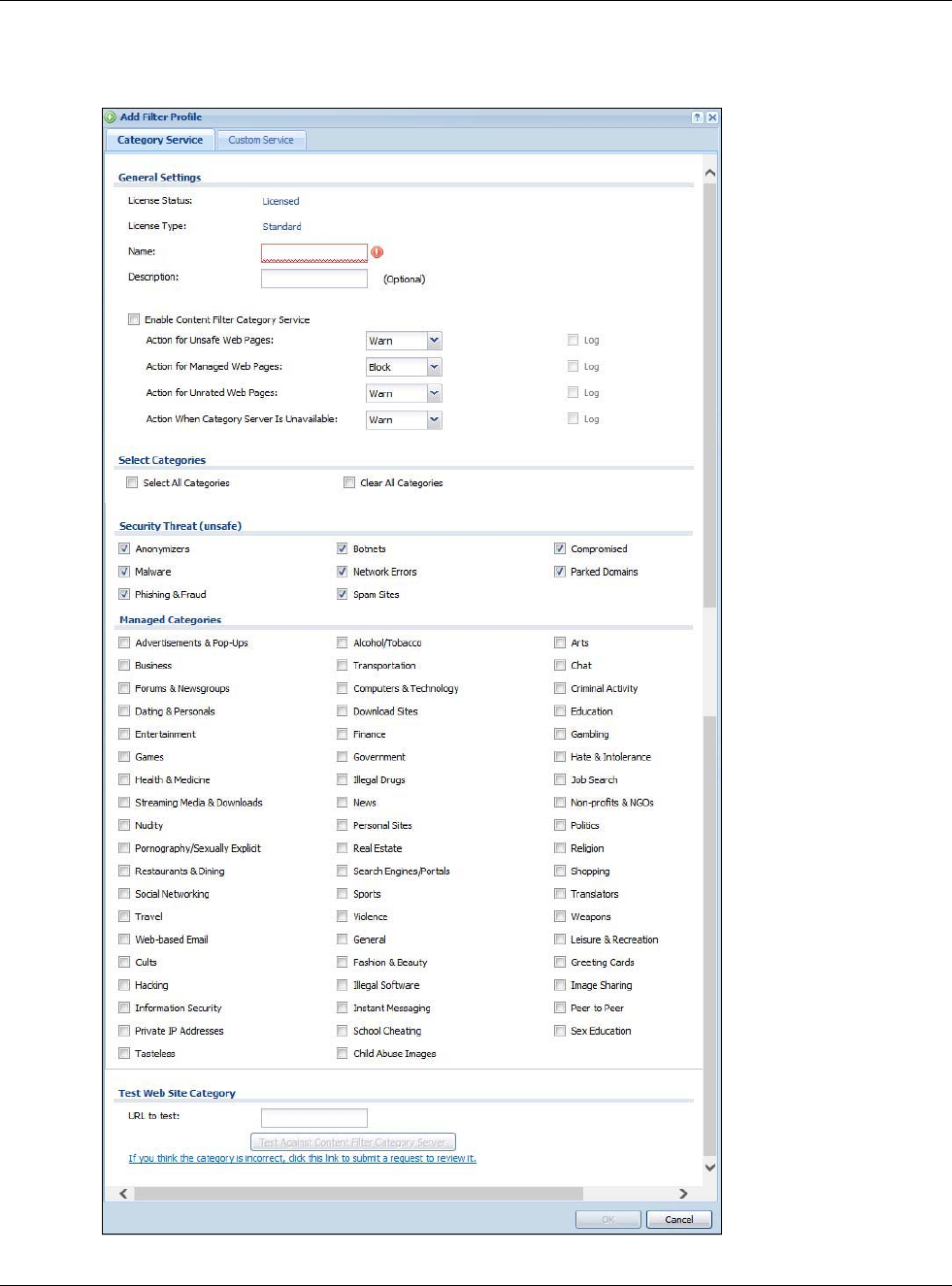
Chapter 27 Content Filtering
USG20(W)-VPN Series User’s Guide
420
27.3.1 Content Filter Add Profile Category Service
Figure 289 Content Filter > Profile > Add Filter Profile > Category Service

Chapter 27 Content Filtering
USG20(W)-VPN Series User’s Guide
421
The following table describes the labels in this screen.
Table 164 Configuration > UTM Profile> Content Filter > Profile > Add > Category Service
LABEL DESCRIPTION
License Status This read-only field displays the status of your content-filtering database
service registration.
Not Licensed displays if you have not successfully registered and activated
the service.
Expired displays if your subscription to the service has expired.
Licensed displays if you have successfully registered the USG and activated
the service.
You can view content filter reports after you register the USG and activate the
subscription service in the Registration screen.
License Type This read-only field displays what kind of service registration you have for the
content-filtering database.
None displays if you have not successfully registered and activated the
service.
Standard displays if you have successfully registered the USG and activated
the standard content filtering service.
Trial displays if you have successfully registered the USG and activated the
trial service subscription.
Name Enter a descriptive name for this content filtering profile name. You may use
1-31 alphanumeric characters, underscores(_), or dashes (-), but the first
character cannot be a number. This value is case-sensitive.
Description Enter a description for the content filtering profile rule to help identify the
purpose of rule. You may use 1-31 alphanumeric characters, underscores(_),
or dashes (-), but the first character cannot be a number. This value is case-
sensitive.
This field is optional.
Enable Content Filter
Category Service
Enable external database content filtering to have the USG check an external
database to find to which category a requested web page belongs. The USG
then blocks or forwards access to the web page depending on the
configuration of the rest of this page.
Action for Unsafe Web
Pages Select Pass to allow users to access web pages that match the unsafe
categories that you select below.
Select Block to prevent users from accessing web pages that match the
unsafe categories that you select below. When external database content
filtering blocks access to a web page, it displays the denied access message
that you configured in the Content Filter General screen along with the
category of the blocked web page.
Select Warn to display a warning message before allowing users to access
web pages that match the unsafe categories that you select below.
Select Log to record attempts to access web pages that match the unsafe
categories that you select below.

Chapter 27 Content Filtering
USG20(W)-VPN Series User’s Guide
422
Action for Managed Web
Pages Select Pass to allow users to access web pages that match the other
categories that you select below.
Select Block to prevent users from accessing web pages that match the other
categories that you select below. When external database content filtering
blocks access to a web page, it displays the denied access message that you
configured in the Content Filter General screen along with the category of
the blocked web page.
Select Log to record attempts to access web pages that match the other
categories that you select below.
Action for Unrated Web
Pages Select Pass to allow users to access web pages that the external web filtering
service has not categorized.
Select Block to prevent users from accessing web pages that the external web
filtering service has not categorized. When the external database content
filtering blocks access to a web page, it displays the denied access message
that you configured in the Content Filter General screen along with the
category of the blocked web page.
Select Warn to display a warning message before allowing users to access
web pages that the external web filtering service has not categorized.
Select Log to record attempts to access web pages that are not categorized.
Action When Category
Server Is Unavailable Select Pass to allow users to access any requested web page if the external
content filtering database is unavailable.
Select Block to block access to any requested web page if the external
content filtering database is unavailable.
Select Warn to display a warning message before allowing users to access any
requested web page if the external content filtering database is unavailable.
The following are possible causes for the external content filtering server not
being available:
• There is no response from the external content filtering server within the
time period specified in the Content Filter Server Unavailable Timeout
field.
• The USG is not able to resolve the domain name of the external content
filtering database.
• There is an error response from the external content filtering database.
This can be caused by an expired content filtering registration (External
content filtering’s license key is invalid”).
Select Log to record attempts to access web pages that occur when the
external content filtering database is unavailable.
Select Categories
Select All Categories Select this check box to restrict access to all site categories listed below.
Clear All Categories Select this check box to clear the selected categories below.
Security Threat (unsafe) Theese are the categories of web pages that are known to pose a threat to
users or their computers.
Anonymizers Sites and proxies that act as an intermediary for surfing to other Web sites in
an anonymous fashion, whether to circumvent Web filtering or for other
reasons. For example, blog.go2.tw, anonymizer.com, www.qu365.com.
Botnets Sites that use bots (zombies) including command-and-control sites.
Compromised Sites that have been compromised by someone other than the site owner in
order to install malicious programs without the user's knowledge. Includes
sites that may be vulnerable to a particular high-risk attack. For example,
www.wokoo.net, movie.sx.zj.cn.
Table 164 Configuration > UTM Profile> Content Filter > Profile > Add > Category Service
LABEL DESCRIPTION

Chapter 27 Content Filtering
USG20(W)-VPN Series User’s Guide
423
The following table describes the managed categories.
Malware Sites that install unwanted software on a user's computer with the intent to
enable third-party monitoring or make system changes without the user's
consent. For example, www.tqlkg.com, aladel.net.
Network Errors Sites that do not resolve to any IP address.
Parked Domains Sites that are inactive, typically reserved for later use. They most often do not
contain their own content, may simply say "under construction," "purchase
this domain," or display advertisements. For example, www.moemoon.com,
artlin.net, img.sedoparking.com.
Phishing & Fraud Sites that are used for deceptive or fraudulent purposes (e.g. phishing), such
as stealing financial or other user account information. These sites are most
often designed to appear as legitimate sites in order to mislead users into
entering their credentials. For example, optimizedby.rmxads.com,
218.1.71.226/.../e3b.
Spam Sites Sites that have been promoted through spam techniques. For example,
img.tongji.linezing.com, banner.chinesegamer.net.
Managed Categories These are categories of web pages based on their content. Select categories in
this section to control access to specific types of Internet content.
You must have the Category Service content filtering license to filter these
categories. See the next table for category details.
Test Web Site Category
URL to test You can check which category a web page belongs to. Enter a web site URL in
the text box.
When the content filter is active, you should see the web page’s category. The
query fails if the content filter is not active.
If you think the category is
incorrect
Click this link to see the category recorded in the USG’s content filtering
database for the web page you specified (if the database has an entry for it).
Test Against Content Filter
Category Server
Click this button to see the category recorded in the external content filter
server’s database for the web page you specified.
OK Click OK to save your changes back to the USG.
Cancel Click Cancel to exit this screen without saving your changes.
Table 165 Managed Category Descriptions
CATEGORY DESCRIPTION
Advertisements & Pop-Ups Sites that provide advertising graphics or other ad content files such as
banners and pop-ups. For example, pagead2.googlesyndication.com,
ad.yieldmanager.com.
Alcohol & Tobacco Sites that promote or sell alcohol- or tobacco-related products or services. For
example, www.drinks.com.tw, www.p9.com.tw, beer.ttl.com.tw.
Arts Sites with artistic content or relating to artistic institutions such as theaters,
museums, galleries, dance companies, photography, and digital graphic
resources. For example, www.npm.gov.tw, www.nmh.gov.tw.
Business Sites that provide business related information such as corporate Web sites.
Information, services, or products that help businesses of all sizes to do their
day-to-day commercial activities. For example, www.kinkos.com,
www.proctorgamble.com, www.bbb.org.
Chat Sites that enable web-based exchange of realtime messages through chat
services or chat rooms. For example, me.sohu.com, blufiles.storage.live.com.
Table 164 Configuration > UTM Profile> Content Filter > Profile > Add > Category Service
LABEL DESCRIPTION

Chapter 27 Content Filtering
USG20(W)-VPN Series User’s Guide
424
Child Abuse Images Sites that portray or discuss children in sexual or other abusive acts. For
example, a.uuzhijia.info.
Computers & Technology Sites that contain information about computers, software, hardware, IT,
peripheral and computer services, such as product reviews, discussions, and IT
news. For example, www.informationsecurity.com.tw, blog.ithome.com.tw.
Criminal Activity Sites that offer advice on how to commit illegal or criminal activities, or to
avoid detection. These can include how to commit murder, build bombs, pick
locks, etc. Also includes sites with information about illegal manipulation of
electronic devices, hacking, fraud and illegal distribution of software. For
example, www.hackbase.com, jia.hackbase.com, ad.adver.com.tw.
Cults Sites relating to non-traditional religious practice typically known as "cults,"
that is, considered to be false, unorthodox, extremist, or coercive, with
members often living under the direction of a charismatic leader. For example,
www.churchofsatan.com, www.ccya.org.tw.
Dating & Personals Sites that promote networking for interpersonal relationships such as dating
and marriage. Includes sites for match-making, online dating, spousal
introduction. For example, www.i-part.com.tw, www.imatchi.com.
Download Sites Sites that contain downloadable software, whether shareware, freeware, or for
a charge. Includes peer-to-peer sites. For example, www.hotdl.com,
toget.pchome.com.tw, www.azroo.com.
Education Sites sponsored by educational institutions and schools of all types including
distance education. Includes general educational and reference materials such
as dictionaries, encyclopedias, online courses, teaching aids and discussion
guides. For example, www.tfam.museum, www.lksf.org, www.1980.org.tw..
Entertainment Sites related to television, movies, music and video (including video on
demand), such as program guides, celebrity sites, and entertainment news.
For example, www.ctitv.com.tw, www.hboasia.com, www.startv.com.tw.
Fashion & Beauty Sites concerning fashion, jewelry, glamour, beauty, modeling, cosmetics or
related products or services. Includes product reviews, comparisons, and
general consumer information. For example, women.sohu.com,
baodian.women.sohu.com.
Finance Sites related to banking, finance, payment or investment, including banks,
brokerages, online stock trading, stock quotes, fund management, insurance
companies, credit unions, credit card companies, and so on. For example,
www.concords.com.tw, www.polaris.com.tw, www.bochk.com.
Forums & Newsgroups Sites for sharing information in the form of newsgroups, forums, bulletin
boards. For example, ck101.com, my.xuite.net, ptt.cc.
Gambling Sites that offer or are related to online gambling, lottery, casinos and betting
agencies involving chance. For example, www.taiwanlottery.com.tw, www.i-
win.com.tw, www.hkjc.com.
Games Sites relating to computer or other games, information about game producers,
or how to obtain cheat codes. Game-related publication sites. For example,
www.gamer.com.tw, www.wowtaiwan.com.tw, tw.lineage.gamania.com.
General Sites that do not clearly fall into other categories, for example, blank Web
pages. For example, bs.serving-sys.com, simg.sinajs.cn, i0.itc.cn.
Government Sites run by governmental organizations, departments, or agencies, including
police departments, fire departments, customs bureaus, emergency services,
civil defense, counterterrorism organizations, military and hospitals. For
example, www.ey.gov.tw, www.whitehouse.gov, www.npa.gov.tw.
Greeting cards Sites that allow people to send and receive greeting cards and postcards. For
example, www.e-card.com.tw, card.ivy.net.tw.
Table 165 Managed Category Descriptions (continued)

Chapter 27 Content Filtering
USG20(W)-VPN Series User’s Guide
425
Hacking Sites that promote or give advice about how to gain unauthorized access to
proprietary computer systems, for the purpose of stealing information,
perpetrating fraud, creating viruses, or committing other illegal activity related
to theft of digital information. For example, www.hackbase.com,
www.chinahacker.com.
Hate & Intolerance Sites that promote a supremacist political agenda, encouraging oppression of
people or groups of people based on their race, religion, gender, age, disability,
sexual orientation or nationality. For example, www.racist-jokes.com, aryan-
nations.org, whitepower.com.
Health & Medicine Sites containing information pertaining to health, healthcare services, fitness
and well-being, including information about medical equipment, hospitals,
drugstores, nursing, medicine, procedures, prescription medications, etc. For
example, www.lksf.org, www.ohayo.com.tw.
Illegal Drug Sites with information on the purchase, manufacture, and use of illegal or
recreational drugs and their paraphernalia, and misuse of prescription drugs
and other compounds For example, www.cannabis.net,
www.amphetamines.com.
Illegal Software Sites that illegally distribute software or copyrighted materials such as movies
or music, software cracks, illicit serial numbers, illegal license key generators.
For example, www.zhaokey.com.cn, www.tiansha.net.
Image Sharing Sites that host digital photographs and images, online photo albums and digital
photo exchanges. For example, photo.pchome.com.tw, photo.xuite.net,
photobucket.com.
Information Security Sites that provide legitimate information about data protection, including
newly discovered vulnerabilities and how to block them. For example,
www.informationsecurity.com.tw, www.itis.tw.
Instant Messaging Sites that enable logging in to instant messaging services such as ICQ, AOL
Instant Messenger, IRC, MSN, Jabber, Yahoo Messenger, and the like. For
example, www.meebo.com, www.aim.com, www. ebuddy.com.
Job Search Sites containing job listings, career information, assistance with job searches
(such as resume writing, interviewing tips, etc.), employment agencies or
head hunters. For example, www.104.com.tw, www.1111.com.tw,
www.yes123.com.tw.
Leisure & Recreation Sites relating to recreational activities and hobbies including zoos, public
recreation centers, pools, amusement parks, and hobbies such as gardening,
literature, arts & crafts, home improvement, home d?cor, family, etc. For
example, tpbg.tfri.gov.tw, tw.fashion.yahoo.com, www.relaxtimes.com.tw.
News Sites covering news and current events such as newspapers, newswire
services, personalized news services, broadcasting sites, and magazines. For
example, www.tvbs.com.tw?Awww.ebc.net.tw?Awww.iset.com.tw.
Non-profits & NGOs Sites devoted to clubs, communities, unions, and non-profit organizations.
Many of these groups exist for educational or charitable purposes. For
example, www.tzuchi.org.tw, web.redcross.org.tw, www.lksf.org.
Nudity Sites that contain full or partial nudity that are not necessarily overtly sexual in
intent. Includes sites that advertise or sell lingerie, intimate apparel, or
swimwear. For example, www.easyshop.com.tw, www.faster-swim.com.tw,
image.baidu.com.
Peer-to-Peer Sites that enable direct exchange of files between users without dependence
on a central server. For example, www.eyny.com.
Personal Sites Sites about or hosted by personal individuals, including those hosted on
commercial sites. For example, blog.yam.com, www.wretch.cc, blog.xuite.net.
Politics Sites that promote political parties or political advocacy, or provide information
about political parties, interest groups, elections, legislation or lobbying. Also
includes sites that offer legal information and advice. For example,
www.kmt.org.tw, www.dpp.org.tw, cpc.people.com.cn.
Table 165 Managed Category Descriptions (continued)

Chapter 27 Content Filtering
USG20(W)-VPN Series User’s Guide
426
Pornography/Sexually
Explicit
Sites that contain explicit sexual content. Includes adult products such as sex
toys, CD-ROMs, and videos, adult services such as videoconferencing, escort
services, and strip clubs, erotic stories and textual descriptions of sexual acts.
For example, www.dvd888.com, www.18center.com, blog.sina.com.tw.
Private IP Addresses Sites that are private IP addresses as defined in RFC 1918, that is, hosts that
do not require access to hosts in other enterprises (or require just limited
access) and whose IP address may be ambiguous between enterprises but are
well defined within a certain enterprise. For example, 172.21.20.123,
192.168.35.62.
Real Estate Sites relating to commercial or residential real estate services, including
renting, purchasing, selling or financing homes, offices, etc. For example,
www.sinyi.com.tw, www.yungching.com.tw, house.focus.cn.
Religion Sites that deal with faith, human spirituality or religious beliefs, including sites
of churches, synagogues, mosques and other houses of worship. For example,
www.fgs.org.tw, www.twtaoism.net, www.fhl.net.
Restaurants & Dining Sites that list, review, promote or advertise food, dining or catering services.
Includes sites for recipes, cooking instruction and tips, food products, and wine
advisors. For example, www.jogoya.com.tw, www.dintaifung.com.tw,
www2.pizzahut.com.tw.
School Cheating Sites that promote unethical practices such as cheating or plagiarism by
providing test answers, written essays, research papers, or term papers. For
example, www.zydk788.com, www.huafengksw.com.
Search Engines & Portals Sites enabling the searching of the Web, newsgroups, images, directories, and
other online content. Includes portal and directory sites such as white/yellow
pages. For example, tw.yahoo.com, www.pchome.com.tw,
www.google.com.tw.
Sex Education Sites relating to sex education, including subjects such as respect for partner,
abortion, gay and lesbian lifestyle, contraceptives, sexually transmitted
diseases, and pregnancy. For example, apps.rockyou.com,
www.howmama.com.tw, www.mombaby.com.tw.
Shopping Sites for online shopping, catalogs, online ordering, auctions, classified ads.
Excludes shopping for products and services exclusively covered by another
category such as health & medicine. For example, shopping.pchome.com.tw,
buy.yahoo.com.tw, www.tkec.com.tw.
Social Networking Sites that enable social networking for online communities of various topics,
for friendship, dating, or professional reasons. For example,
www.facebook.com, www.flickr.com, www.groups.google.com.
Sports Sites relating to sports teams, fan clubs, scores and sports news. Relates to all
sports, whether professional or recreational. For example, www.yankees.com,
www.nba.com, mlb.mlb.com.
Streaming Media &
Downloads
Sites that deliver streaming content, such as Internet radio, Internet TV or
MP3 and live or archived media download sites. Includes fan sites, or official
sites run by musicians, bands, or record labels. For example,
www.youtube.com, pfp.sina.com.cn, my.xunlei.com.
Tasteless Sites with offensive or tasteless content such as bathroom humor or profanity.
For example, comedycentral.com, dilbert.com.
Translators Sites that translate Web pages or phrases from one language to another. These
sites may be used to attempt to bypass a filtering system. For example,
translate.google.com.tw, www.smartlinkcorp.com, translation.paralink.com.
Transportation Sites that provide information about motor vehicles such as cars, motorcycles,
boats, trucks, RVs and the like. Includes manufacturer sites, dealerships,
review sites, pricing, , online purchase sites, enthusiasts clubs, etc. For
example, www.toyota.com.tw, www.ford.com.tw, www.sym.com.tw.
Table 165 Managed Category Descriptions (continued)

Chapter 27 Content Filtering
USG20(W)-VPN Series User’s Guide
427
27.3.2 Content Filter Add Filter Profile Custom Service
Click Configuration > UTM Profile > Content Filter > Filter Profile > Add or Edit > Custom
Service to open the Custom Service screen. You can create a list of good (allowed) web site
addresses and a list of bad (blocked) web site addresses. You can also block web sites based on
whether the web site’s address contains a keyword. Use this screen to add or remove specific sites
or keywords from the filter list.
Travel Sites that provide travel and tourism information or online booking of travel
services such as airlines, accommodations, car rentals. Includes regional or
city information sites. For example, www.startravel.com.tw,
taipei.grand.hyatt.com.tw, www.car-plus.com.tw.
Unknown Unknown For example, www.669.com.tw, www.appleballoon.com.tw,
www.uimco.com.tw.
Violence Sites that contain images or text depicting or advocating physical assault
against humans, animals, or institutions. Sites of a particularly gruesome
nature such as shocking depictions of blood or wounds, or cruel animal
treatment. For example, crimescene.com, deathnet.com, michiganmilitia.com.
Weapons Sites that depict, sell, review or describe guns and weapons, including for
sport. For example, www.ak-47.net, warfare.ru.
Web-based Email Sites that enable users to send and receive email through a web-accessible
email account. For example, mail.163.com, mail.google.com,
mail.yahoo.com.tw.
Table 165 Managed Category Descriptions (continued)
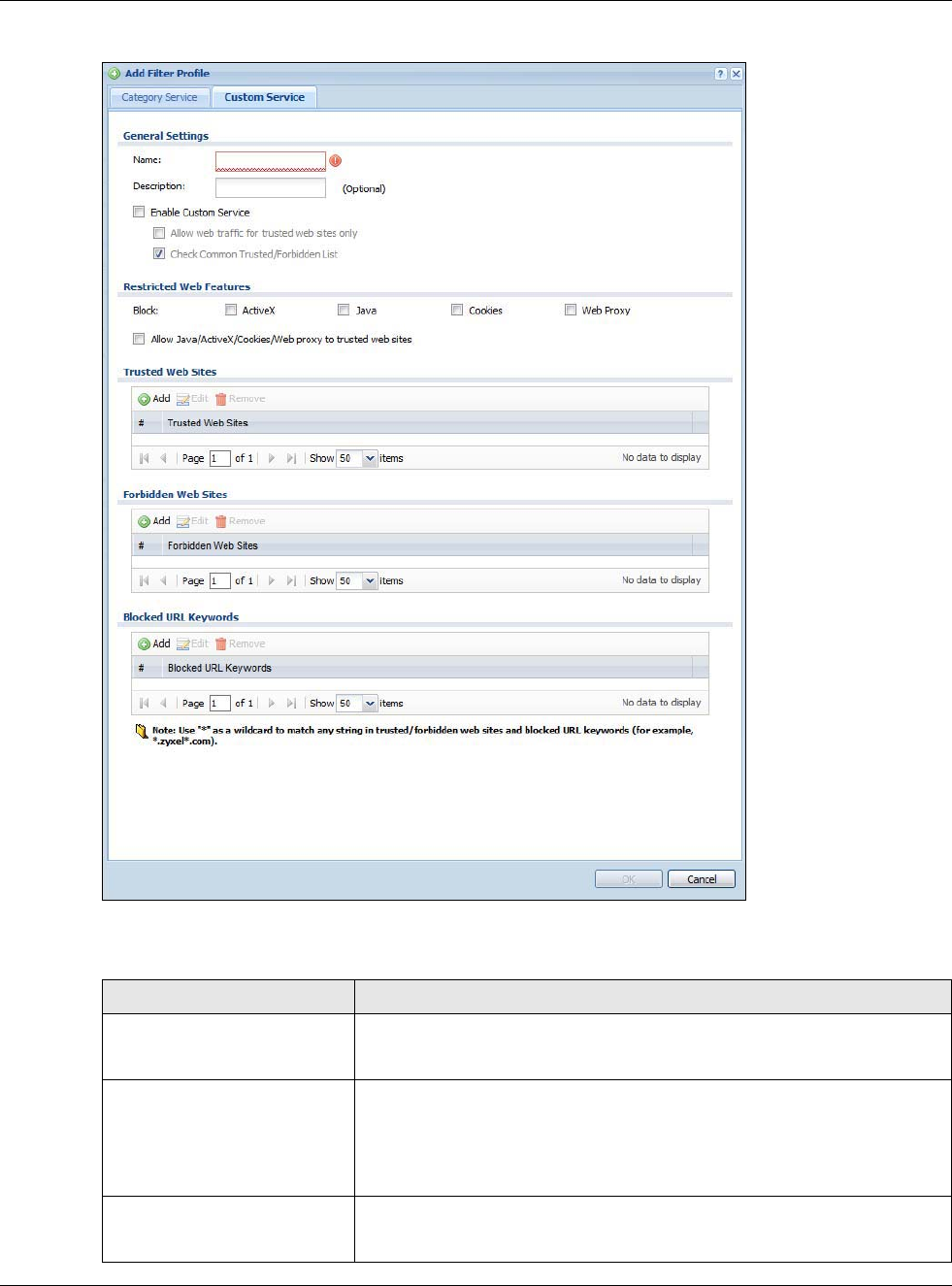
Chapter 27 Content Filtering
USG20(W)-VPN Series User’s Guide
428
Figure 290 Configuration > UTM Profile > Content Filter > Filter Profile > Custom Service
The following table describes the labels in this screen.
Table 166 Configuration > UTM Profile > Content Filter > Profile > Custom Service
LABEL DESCRIPTION
Name Enter a descriptive name for this content filtering profile name. You may use
1-31 alphanumeric characters, underscores(_), or dashes (-), but the first
character cannot be a number. This value is case-sensitive.
Description Enter a description for the content filtering profile rule to help identify the
purpose of rule. You may use 1-31 alphanumeric characters,
underscores(_), or dashes (-), but the first character cannot be a number.
This value is case-sensitive.
This field is optional.
Enable Custom Service Select this check box to allow trusted web sites and block forbidden web
sites. Content filter list customization may be enabled and disabled without
re-entering these site names.

Chapter 27 Content Filtering
USG20(W)-VPN Series User’s Guide
429
Allow Web traffic for trusted
web sites only
When this box is selected, the USG blocks Web access to sites that are not
on the Trusted Web Sites list. If they are chosen carefully, this is the most
effective way to block objectionable material.
Check Common Trusted/
Forbidden List
Select this check box to check the common trusted and forbidden web sites
lists. See Section 27.4 on page 430 and Section 27.5 on page 431 for
information on configuring these lists.
Restricted Web Features Select the check box(es) to restrict a feature. Select the check box(es) to
restrict a feature.
• When you download a page containing ActiveX or Java, that part of the
web page will be blocked with an X.
• When you download a page coming from a Web Proxy, the whole web
page will be blocked.
• When you download a page containing cookies, the cookies will be
removed, but the page will not be blocked.
Block
ActiveX
ActiveX is a tool for building dynamic and active web pages and distributed
object applications. When you visit an ActiveX web site, ActiveX controls are
downloaded to your browser, where they remain in case you visit the site
again.
Java Java is a programming language and development environment for building
downloadable Web components or Internet and intranet business
applications of all kinds.
Cookies Cookies are files stored on a computer’s hard drive. Some web servers use
them to track usage and provide service based on ID.
Web Proxy A server that acts as an intermediary between a user and the Internet to
provide security, administrative control, and caching service. When a proxy
server is located on the WAN it is possible for LAN users to circumvent
content filtering by pointing to this proxy server.
Allow Java/ActiveX/Cookies/
Web proxy to trusted web sites
When this box is selected, the USG will permit Java, ActiveX and Cookies
from sites on the Trusted Web Sites list to the LAN. In certain cases, it
may be desirable to allow Java, ActiveX or Cookies from sites that are known
and trusted.
Trusted Web Sites These are sites that you want to allow access to, regardless of their content
rating, can be allowed by adding them to this list.
Add Click this to create a new entry.
Edit Select an entry and click this to be able to modify it.
Remove Select an entry and click this to delete it.
# This displays the index number of the trusted web sites.
Trusted Web Site This column displays the trusted web sites already added.
Enter host names such as www.good-site.com into this text field. Do not
enter the complete URL of the site – that is, do not include “http://”. All
subdomains are allowed. For example, entering “*zyxel.com” also allows
“www.zyxel.com”, “partner.zyxel.com”, “press.zyxel.com”, and so on. You
can also enter just a top level domain. For example, enter “*.com” to allow
all .com domains.
Use up to 127 characters (0-9a-z-). The casing does not matter. “*” can be
used as a wildcard to match any string. The entry must contain at least one
“.” or it will be invalid.
Forbidden Web Site List Sites that you want to block access to, regardless of their content rating, can
be allowed by adding them to this list.
Add Click this to create a new entry.
Edit Select an entry and click this to be able to modify it.
Table 166 Configuration > UTM Profile > Content Filter > Profile > Custom Service (continued)
LABEL DESCRIPTION

Chapter 27 Content Filtering
USG20(W)-VPN Series User’s Guide
430
27.4 Content Filter Trusted Web Sites Screen
Click Configuration > UTM Profile > Content Filter > Trusted Web Sites to open the Trusted
Web Sites screen. You can create a common list of good (allowed) web site addresses. When you
configure Filter Profiles, you can select the option to check the Common Trusted Web Sites list.
Use this screen to add or remove specific sites from the filter list.
Remove Select an entry and click this to delete it.
# This displays the index number of the forbidden web sites.
Forbidden Web Sites This list displays the forbidden web sites already added.
Enter host names such as www.bad-site.com into this text field. Do not
enter the complete URL of the site – that is, do not include “http://”. All
subdomains are also blocked. For example, entering “*bad-site.com” also
blocks “www.bad-site.com”, “partner.bad-site.com”, “press.bad-site.com”,
and do on. You can also enter just a top level domain. For example, enter
“*.com” to block all .com domains.
Use up to 127 characters (0-9a-z-). The casing does not matter. “*” can be
used as a wildcard to match any string. The entry must contain at least one
“.” or it will be invalid.
Blocked URL Keywords This section allows you to block Web sites with URLs that contain certain
keywords in the domain name or IP address.
Add Click this to create a new entry.
Edit Select an entry and click this to be able to modify it.
Remove Select an entry and click this to delete it.
# This displays the index number of the blocked URL keywords.
Blocked URL Keywords This list displays the keywords already added.
Enter a keyword or a numerical IP address to block. You can also enter a
numerical IP address.
Use up to 127 case-insensitive characters (0-9a-zA-Z;/?:@&=+$\.-
_!~*()%). “*” can be used as a wildcard to match any string. Use “|*” to
indicate a single wildcard character.
For example enter *Bad_Site* to block access to any web page that includes
the exact phrase Bad_Site. This does not block access to web pages that
only include part of the phrase (such as Bad for example).
OK Click OK to save your changes back to the USG.
Cancel Click Cancel to exit this screen without saving your changes.
Table 166 Configuration > UTM Profile > Content Filter > Profile > Custom Service (continued)
LABEL DESCRIPTION
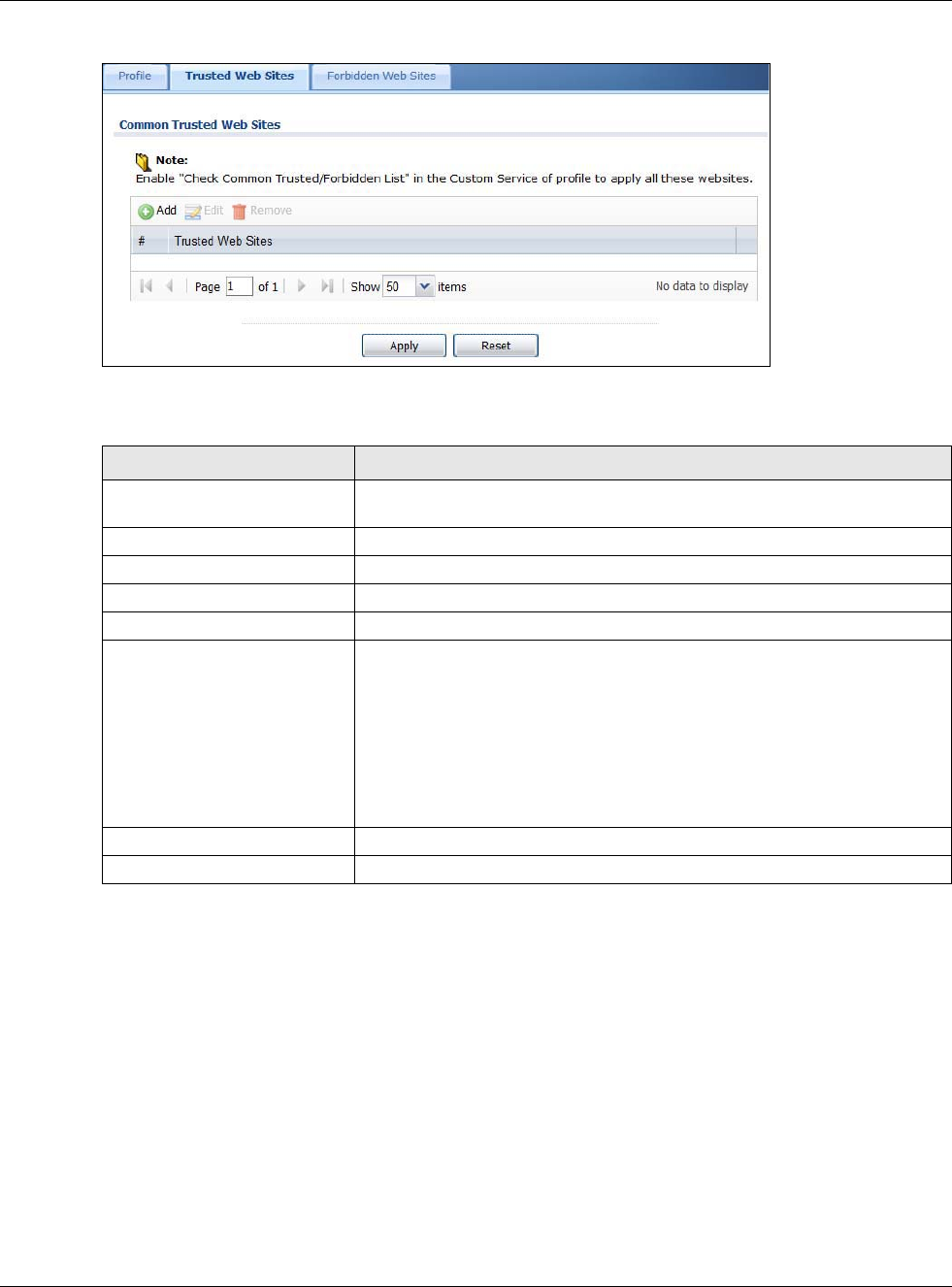
Chapter 27 Content Filtering
USG20(W)-VPN Series User’s Guide
431
Figure 291 Configuration > UTM Profile > Content Filter > Trusted Web Sites
The following table describes the labels in this screen.
27.5 Content Filter Forbidden Web Sites Screen
Click Configuration > UTM Profile > Content Filter > Forbidden Web Sites to open the
Forbidden Web Sites screen. You can create a common list of bad (blocked) web site addresses.
When you configure Filter Profiles, you can select the option to check the Common Forbidden
Web Sites list. Use this screen to add or remove specific sites from the filter list.
Table 167 Configuration > UTM Profile > Content Filter > Trusted Web Sites
LABEL DESCRIPTION
Common Trusted Web Sites These are sites that you want to allow access to, regardless of their content
rating, can be allowed by adding them to this list.
Add Click this to create a new entry.
Edit Select an entry and click this to be able to modify it.
Remove Select an entry and click this to delete it.
# This displays the index number of the trusted web sites.
Trusted Web Site This column displays the trusted web sites already added.
Enter host names such as www.good-site.com into this text field. Do not
enter the complete URL of the site – that is, do not include “http://”. All
subdomains are allowed. For example, entering “zyxel.com” also allows
“www.zyxel.com”, “partner.zyxel.com”, “press.zyxel.com”, and so on. You
can also enter just a top level domain. For example, enter .com to allow all
.com domains.
Use up to 127 characters (0-9a-z-). The casing does not matter.
Apply Click Apply to save your changes back to the USG.
Reset Click Reset to return the screen to its last-saved settings.
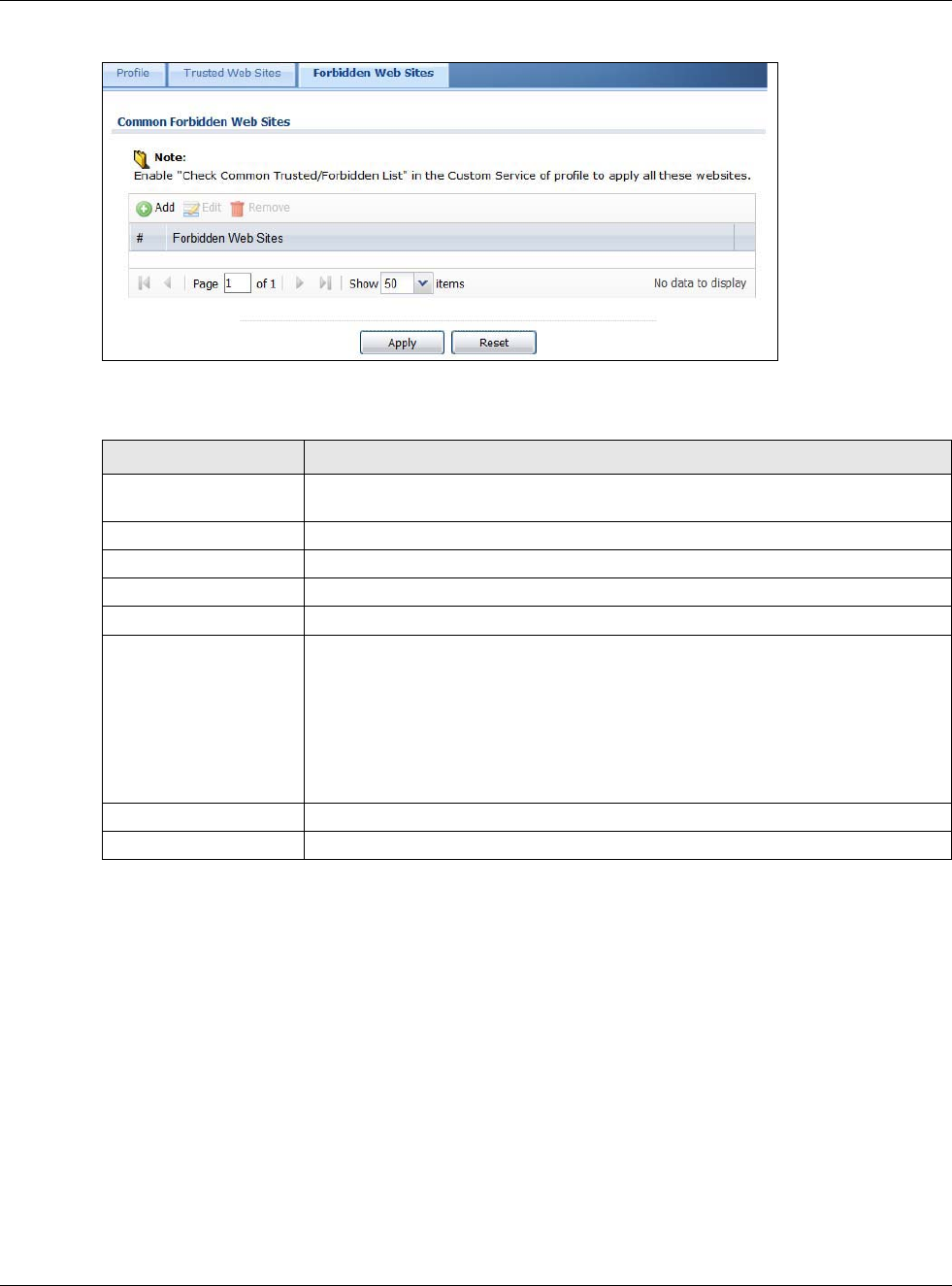
Chapter 27 Content Filtering
USG20(W)-VPN Series User’s Guide
432
Figure 292 Configuration > UTM Profile > Content Filter > Forbidden Web Sites
The following table describes the labels in this screen.
27.6 Content Filter Technical Reference
This section provides content filtering background information.
External Content Filter Server Lookup Procedure
The content filter lookup process is described below.
Table 168 Configuration > UTM Profile > Content Filter > Forbidden Web Sites
LABEL DESCRIPTION
Common Forbidden Web
Sites
Sites that you want to block access to, regardless of their content rating, can be
allowed by adding them to this list.
Add Click this to create a new entry.
Edit Select an entry and click this to be able to modify it.
Remove Select an entry and click this to delete it.
# This displays the index number of the forbidden web sites.
Forbidden Web Sites This list displays the forbidden web sites already added.
Enter host names such as www.bad-site.com into this text field. Do not enter the
complete URL of the site – that is, do not include “http://”. All subdomains are also
blocked. For example, entering “bad-site.com” also blocks “www.bad-site.com”,
“partner.bad-site.com”, “press.bad-site.com”, and do on. You can also enter just a
top level domain. For example, enter .com to block all .com domains.
Use up to 127 characters (0-9a-z-). The casing does not matter.
Apply Click Apply to save your changes back to the USG.
Cancel Click Reset to return the screen to its last-saved settings.
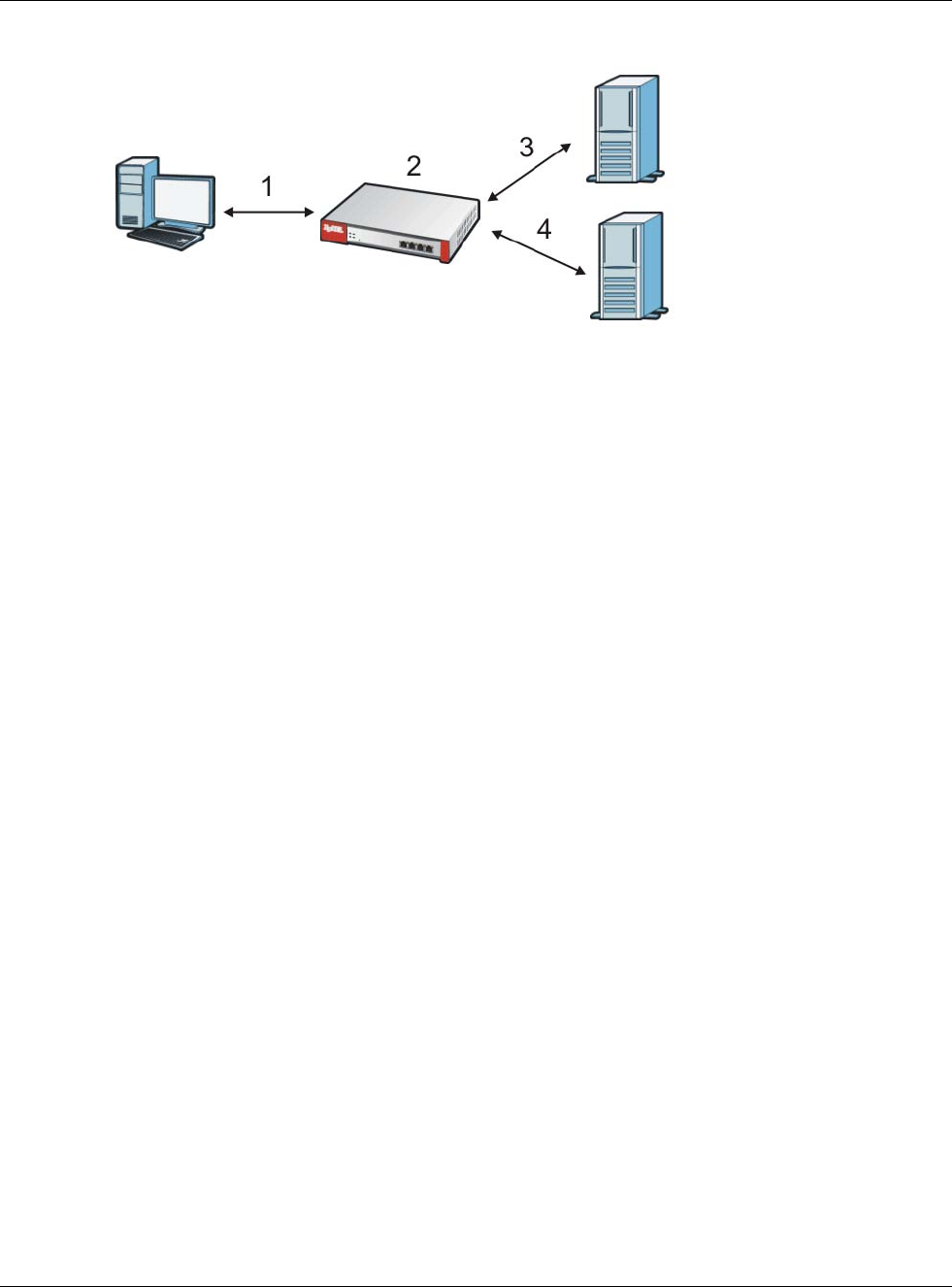
Chapter 27 Content Filtering
USG20(W)-VPN Series User’s Guide
433
Figure 293 Content Filter Lookup Procedure
1A computer behind the USG tries to access a web site.
2The USG looks up the web site in its cache. If an attempt to access the web site was made in the
past, a record of that web site’s category will be in the USG’s cache. The USG blocks, blocks and
logs or just logs the request based on your configuration.
3Use the Content Filter Cache screen to configure how long a web site address remains in the
cache as well as view those web site addresses. All of the web site address records are also cleared
from the local cache when the USG restarts.
4If the USG has no record of the web site, it queries the external content filter database and
simultaneously sends the request to the web server.
5The external content filter server sends the category information back to the USG, which then
blocks and/or logs access to the web site based on the settings in the content filter profile. The web
site’s address and category are then stored in the USG’s content filter cache.

USG20(W)-VPN Series User’s Guide
434
CHAPTER 28
Anti-Spam
28.1 Overview
The anti-spam feature can mark or discard spam (unsolicited commercial or junk e-mail). Use the
white list to identify legitimate e-mail. Use the black list to identify spam e-mail. The USG can also
check e-mail against a DNS black list (DNSBL) of IP addresses of servers that are suspected of
being used by spammers.
28.1.1 What You Can Do in this Chapter
•Use the Profile screens (Section 28.3 on page 436) to turn anti-spam on or off and manage anti-
spam policies.
•Use the Mail Scan screen (Section 28.4 on page 439) to enable and configure the mail scan
functions.
•Use the Black/White List screens (Section 28.5 on page 441) to set up a black list to identify
spam and a white list to identify legitimate e-mail.
•Use the DNSBL screens (Section 28.7 on page 446) to have the USG check e-mail against DNS
Black Lists.
28.1.2 What You Need to Know
White List
Configure white list entries to identify legitimate e-mail. The white list entries have the USG classify
any e-mail that is from a specified sender or uses a specified header field and header value as being
legitimate (see E-mail Headers on page 435 for more on mail headers). The anti-spam feature
checks an e-mail against the white list entries before doing any other anti-spam checking. If the e-
mail matches a white list entry, the USG classifies the e-mail as legitimate and does not perform
any more anti-spam checking on that individual e-mail. A properly configured white list helps keep
important e-mail from being incorrectly classified as spam. The white list can also increases the
USG’s anti-spam speed and efficiency by not having the USG perform the full anti-spam checking
process on legitimate e-mail.
Black List
Configure black list entries to identify spam. The black list entries have the USG classify any e-mail
that is from or forwarded by a specified IP address or uses a specified header field and header value
as being spam. If an e-mail does not match any of the white list entries, the USG checks it against
the black list entries. The USG classifies an e-mail that matches a black list entry as spam and
immediately takes the configured action for dealing with spam. If an e-mail matches a blacklist
entry, the USG does not perform any more anti-spam checking on that individual e-mail. A properly

Chapter 28 Anti-Spam
USG20(W)-VPN Series User’s Guide
435
configured black list helps catch spam e-mail and increases the USG’s anti-spam speed and
efficiency.
SMTP and POP3
Simple Mail Transfer Protocol (SMTP) is the Internet’s message transport standard. It controls the
sending of e-mail messages between servers. E-mail clients (also called e-mail applications) then
use mail server protocols such as POP (Post Office Protocol) or IMAP (Internet Message Access
Protocol) to retrieve e-mail. E-mail clients also generally use SMTP to send messages to a mail
server. The older POP2 requires SMTP for sending messages while the newer POP3 can be used with
or without it. This is why many e-mail applications require you to specify both the SMTP server and
the POP or IMAP server (even though they may actually be the same server).
The USG’s anti-spam feature checks SMTP (TCP port 25) and POP3 (TCP port 110) e-mails by
default. You can also specify custom SMTP and POP3 ports for the USG to check.
E-mail Headers
Every email has a header and a body. The header is structured into fields and includes the
addresses of the recipient and sender, the subject, and other information about the e-mail and its
journey. The body is the actual message text and any attachments. You can have the USG check for
specific header fields with specific values.
E-mail programs usually only show you the To:, From:, Subject:, and Date: header fields but there
are others such as Received: and Content-Type:. To see all of an e-mail’s header, you can select an
e-mail in your e-mail program and look at its properties or details. For example, in Microsoft’s
Outlook Express, select a mail and click File > Properties > Details. This displays the e-mail’s
header. Click Message Source to see the source for the entire mail including both the header and
the body.
E-mail Header Buffer Size
The USG has a 5 K buffer for an individual e-mail header. If an e-mail’s header is longer than 5 K,
the USG only checks up to the first 5 K.
DNSBL
A DNS Black List (DNSBL) is a server that hosts a list of IP addresses known or suspected of having
sent or forwarded spam. A DNSBL is also known as a DNS spam blocking list. The USG can check
the routing addresses of e-mail against DNSBLs and classify an e-mail as spam if it was sent or
forwarded by a computer with an IP address in the DNSBL.
Finding Out More
See Section 28.8 on page 448 for more background information on anti-spam.
28.2 Before You Begin
• Before using the Anti-Spam features (IP Reputation, Mail Content Analysis and Virus Outbreak
Detection) you must activate your Anti-Spam Service license.
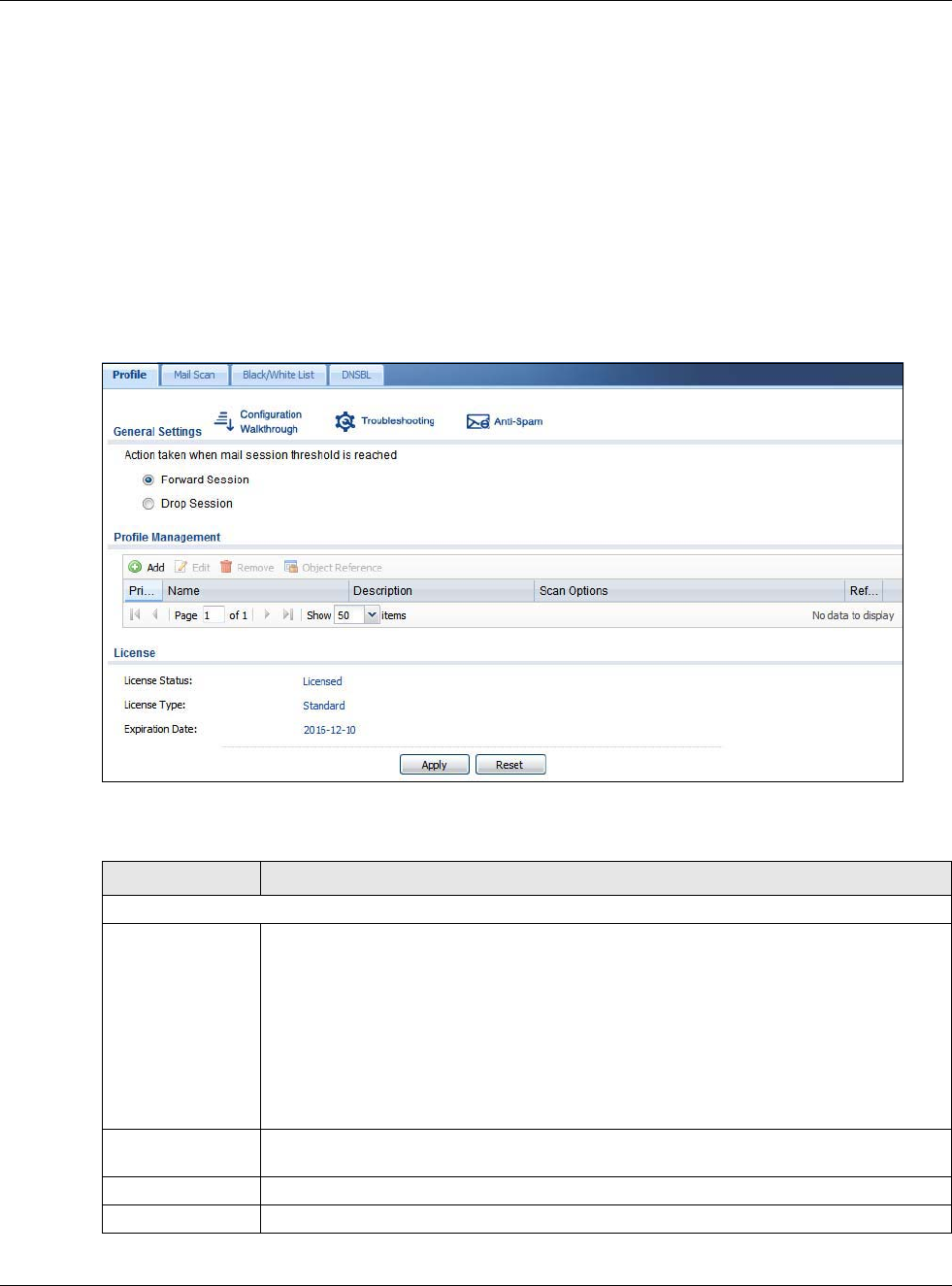
Chapter 28 Anti-Spam
USG20(W)-VPN Series User’s Guide
436
• Configure your zones before you configure anti-spam.
28.3 The Anti-Spam Profile Screen
Click Configuration > UTM Profile > Anti-Spam to open the Anti-Spam Profile screen. Use
this screen to turn the anti-spam feature on or off and manage anti-spam policies. You can also
select the action the USG takes when the mail sessions threshold is reached.
Click on the icons to go to the OneSecurity.com website where there is guidance on configuration
walkthroughs, troubleshooting and other information.
Figure 294 Configuration > UTM Profile > Anti-Spam > Profilel
The following table describes the labels in this screen.
Table 169 Configuration > UTM Profile > Anti-Spam > Profile
LABEL DESCRIPTION
General Settings
Action taken when
mail sessions
threshold is
reached
An e-mail session is when an e-mail client and e-mail server (or two e-mail servers)
connect through the USG. Select how to handle concurrent e-mail sessions that exceed
the maximum number of concurrent e-mail sessions that the anti-spam feature can
handle. See the chapter of product specifications for the threshold.
Select Forward Session to have the USG allow the excess e-mail sessions without any
spam filtering.
Select Drop Session to have the USG drop mail connections to stop the excess e-mail
sessions. The e-mail client or server will have to re-attempt to send or receive e-mail
later when the number of e-mail sessions is under the threshold.
Add Click this to create a new entry. Select an entry and click Add to create a new entry after
the selected entry.
Edit Select an entry and click this to be able to modify it.
Remove Select an entry and click this to delete it.

Chapter 28 Anti-Spam
USG20(W)-VPN Series User’s Guide
437
28.3.1 The Anti-Spam Profile Add or Edit Screen
Click the Add or Edit icon in the Configuration > UTM Profile > Anti-Spam > Profile screen to
display the configuration screen as shown next. Use this screen to configure an anti-spam policy
that controls what traffic direction of e-mail to check, which e-mail protocols to scan, the scanning
options, and the action to take on spam traffic.
Object
Reference Select an entry and click Object References to open a screen that shows which settings
use the entry. Click Refresh to update information in this screen.
Priority This is the index number of the anti-spam rule. Antis-spam rules are applied in turn.
Name The name identifies the anti-spam rule.
Description This is some optional extra information on the rule.
Scan Options This shows which types (protocols) of traffic to scan for spam.
Reference This shows how many objects are referenced in the rule.
License
License Status This read-only field displays the status of your anti-spam scanning service registration.
Not Licensed displays if you have not successfully registered and activated the service.
Expired displays if your subscription to the service has expired.
Licensed displays if you have successfully registered the USG and activated the service.
License Type This read-only field displays what kind of service registration you have for the anti-spam
scanning.
None displays if you have not successfully registered and activated the service.
Standard displays if you have successfully registered the USG and activated the service
with your iCard’s PIN number.
Trial displays if you have successfully registered the USG and activated the trial service
subscription.
Expiration
Date This field displays the date your service license expires.
Apply Click Apply to save your changes back to the USG.
Reset Click Reset to return the screen to its last-saved settings.
Table 169 Configuration > UTM Profile > Anti-Spam > Profile
LABEL DESCRIPTION
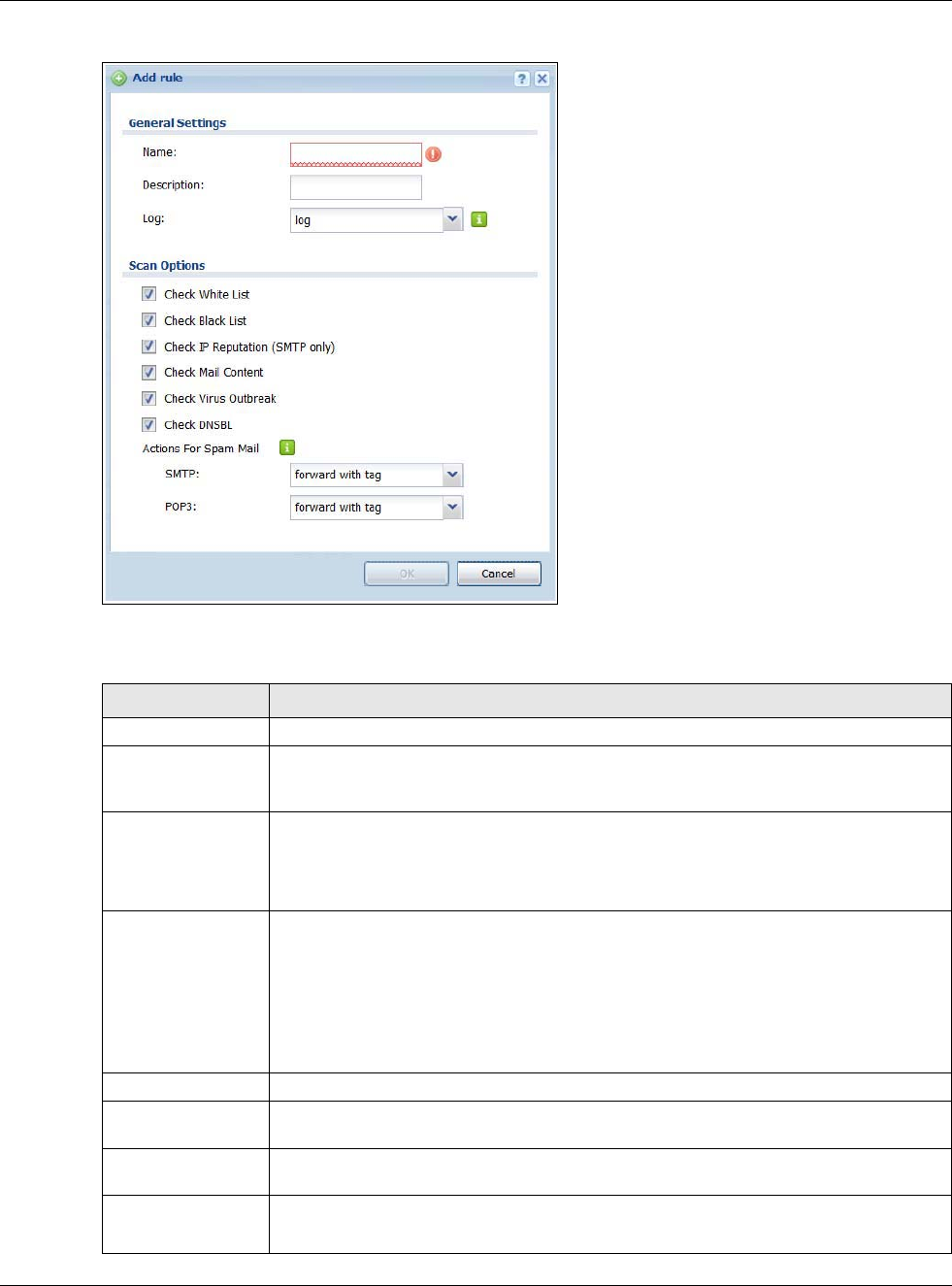
Chapter 28 Anti-Spam
USG20(W)-VPN Series User’s Guide
438
Figure 295 Configuration > UTM Profile > Anti-Spam > Profile > Add
The following table describes the labels in this screen.
Table 170 Configuration > UTM Profile > Anti-Spam > Profile > Add
LABEL DESCRIPTION
General Settings
Name Enter a descriptive name for this anti-spam rule. You may use 1-31 alphanumeric
characters, underscores(_), or dashes (-), but the first character cannot be a number.
This value is case-sensitive.
Description Enter a description for the anti-spam rule to help identify the purpose of rule. You may
use 1-31 alphanumeric characters, underscores(_), or dashes (-), but the first
character cannot be a number. This value is case-sensitive.
This field is optional.
Log Select how the USG is to log the event when the DNSBL times out or an e-mail matches
the white list, black list, or DNSBL.
no: Do not create a log.
log: Create a log on the USG.
log alert: An alert is an e-mailed log for more serious events that may need more
immediate attention. Select this option to have the USG send an alert.
Scan Options
Check White
List Select this check box to check e-mail against the white list. The USG classifies e-mail
that matches a white list entry as legitimate (not spam).
Check Black List Select this check box to check e-mail against the black list. The USG classifies e-mail
that matches a black list entry as spam.
Check IP
Reputation
(SMTP Only)
Select this to use IP reputation to identify Spam or Unwanted Bulk Email by the
sender’s IP address.
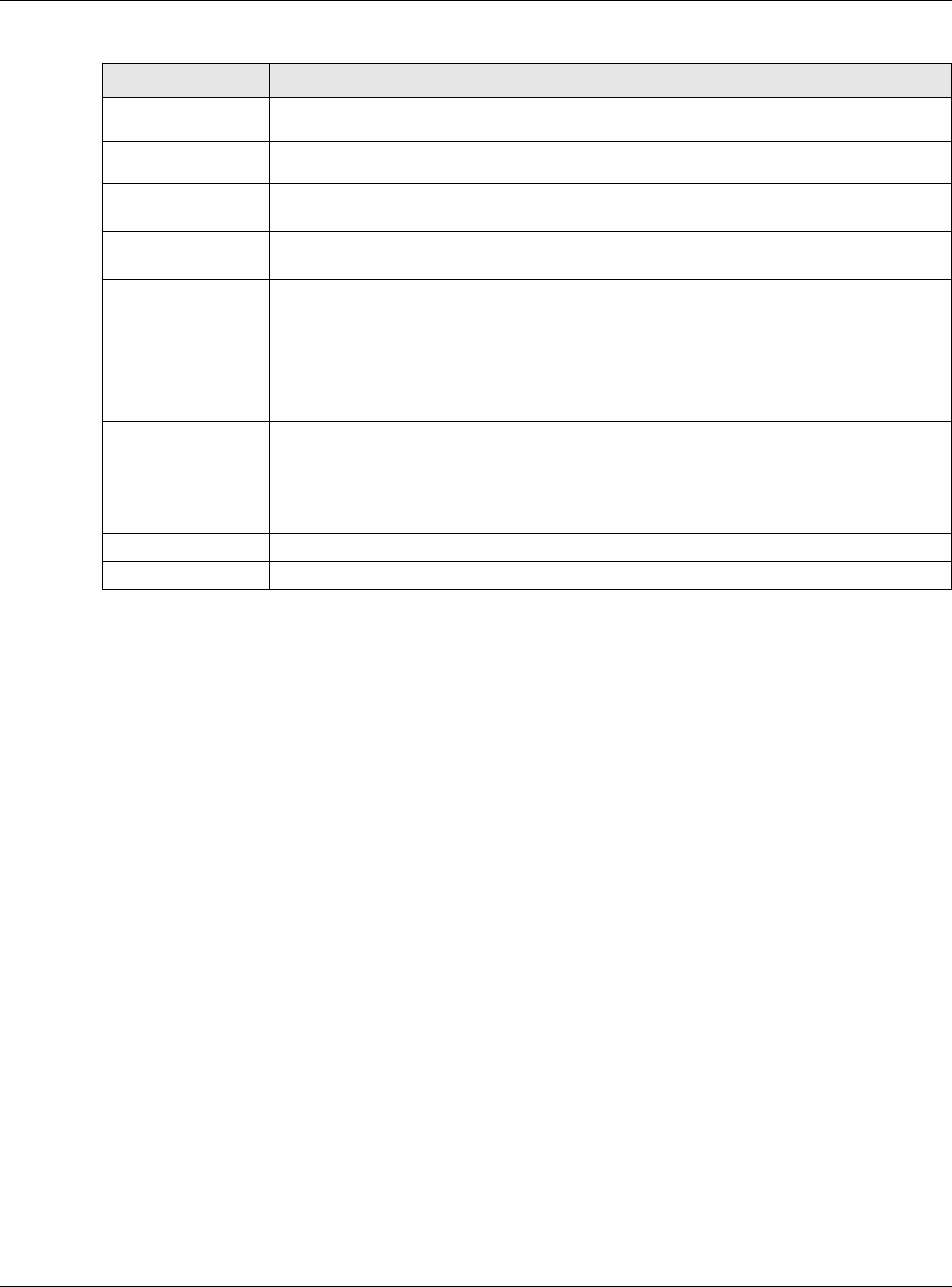
Chapter 28 Anti-Spam
USG20(W)-VPN Series User’s Guide
439
28.4 The Mail Scan Screen
Click Configuration > UTM Profile > Anti-Spam > Mail Scan to open the Mail Scan screen.
Use this screen to enable and configure the Mail Scan functions. You must first enable the Mail Scan
functions on this screen before selecting them in the Configuration > UTM Profile > Anti-Spam
> Profile > Add/Edit screen.
Check Mail
Content Select this to identify Spam Email by content, such as malicious content.
Check Virus
Outbreak Select this to scan emails for attached viruses.
Check DNSBL Select this check box to check e-mail against the USG’s configured DNSBL domains. The
USG classifies e-mail that matches a DNS black list as spam.
Actions for Spam
Mail
Use this section to set how the USG is to handle spam mail.
SMTP Select how the USG is to handle spam SMTP mail.
Select drop to discard spam SMTP mail.
Select forward to allow spam SMTP mail to go through.
Select forward with tag to add a spam tag to an SMTP spam mail’s mail subject and
send it on to the destination.
POP3 Select how the USG is to handle spam POP3 mail.
Select forward to allow spam POP3 mail to go through.
Select forward with tag to add a spam tag to an POP3 spam mail’s mail subject and
send it on to the destination.
OK Click OK to save your changes.
Cancel Click Cancel to exit this screen without saving your changes.
Table 170 Configuration > UTM Profile > Anti-Spam > Profile > Add (continued)
LABEL DESCRIPTION
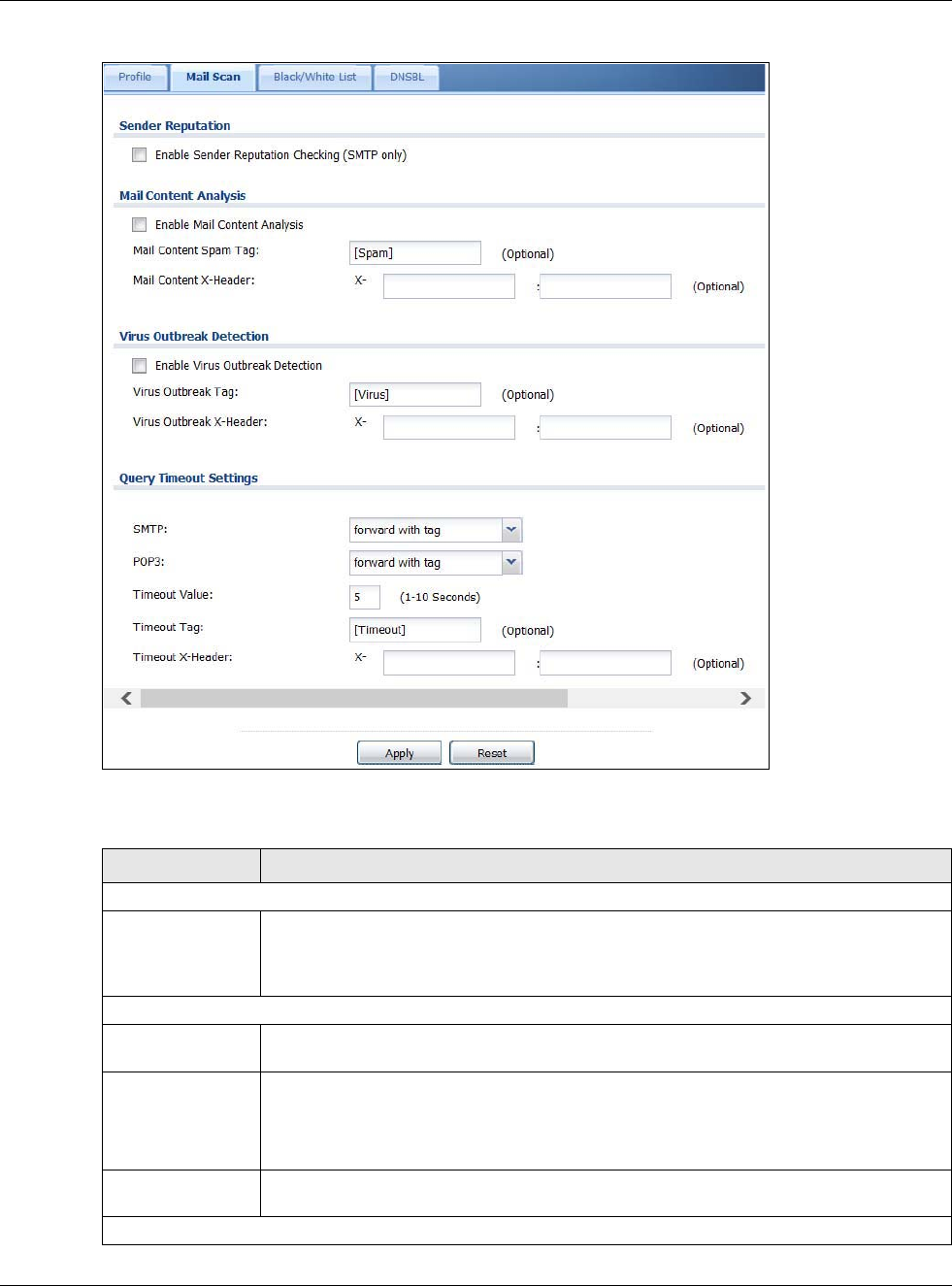
Chapter 28 Anti-Spam
USG20(W)-VPN Series User’s Guide
440
Figure 296 Configuration > UTM Profile > Anti-Spam > Mail Scan
The following table describes the labels in this screen.
Table 171 Configuration > UTM Profile > Anti-Spam > Mail Scan
LABEL DESCRIPTION
Sender Reputation
Enable Sender
Reputation
Checking (SMTP
only)
Select this to have the USG scan for spam e-mail by IP Reputation. Spam or Unwanted
Bulk Email is determined by the sender’s IP address.
Mail Content Analysis
Enable Mail
Content Analysis
Select this to identify Spam Email by content, such as malicious content.
Mail Content Spam
Tag
Enter a message or label (up to 15 ASCII characters) to add to the beginning of the mail
subject of e-mails that are determined to spam based on the mail content analysis.
This tag is only added if the anti-spam policy is configured to forward spam mail with a
spam tag.
Mail Content X-
Header
Specify the name and value for the X-Header to be added when an email is determined
to be spam by mail content.
Virus Outbreak Detection

Chapter 28 Anti-Spam
USG20(W)-VPN Series User’s Guide
441
28.5 The Anti-Spam Black List Screen
Click Configuration > UTM Profile > Anti-Spam > Black /White List to display the Anti-Spam
Black List screen.
Configure the black list to identify spam e-mail. You can create black list entries based on the
sender’s or relay server’s IP address or e-mail address. You can also create entries that check for
particular e-mail header fields with specific values or specific subject text. Click a column’s heading
cell to sort the table entries by that column’s criteria. Click the heading cell again to reverse the sort
order.
Enable Virus
Outbreak
Detection
This scans emails for attached viruses.
Virus Outbreak
Tag
Enter a message or label (up to 15 ASCII characters) to add to the beginning of the mail
subject of e-mails that are determined have an attached viruses.
This tag is only added if the anti-spam policy is configured to forward spam mail with a
spam tag.
Virus Outbreak X-
Header
Specify the name and value for the X-Header to be added when an email is determined
to have an attached virus.
Query Timeout Settings
SMTP Select how the USG is to handle SMTP mail query timeout.
Select drop to discard SMTP mail.
Select forward to allow SMTP mail to go through.
Select forward with tag to add a tag to an SMTP query timeout mail’s mail subject and
send it on to the destination.
POP3 Select how the USG is to handle POP3 mail query timeout.
Select forward to allow POP3 mail to go through.
Select forward with tag to add a tag to an POP3 query timeout mail’s mail subject and
send it on to the destination.
Timeout Value Set how long the USG waits for a reply from the mail scan server. If there is no reply
before this time period expires, the USG takes the action defined in the relevant Actions
when Query Timeout field.
Timeout Tag Enter a message or label (up to 15 ASCII characters) to add to the mail subject of e-
mails that the USG forwards if queries to the mail scan servers time out.
Timeout X-Header Specify the name and value for the X-Header to be added when queries to the mail scan
servers time out.
Apply Click Apply to save your changes back to the USG.
Reset Click Reset to return the screen to its last-saved settings.
Table 171 Configuration > UTM Profile > Anti-Spam > Mail Scan
LABEL DESCRIPTION
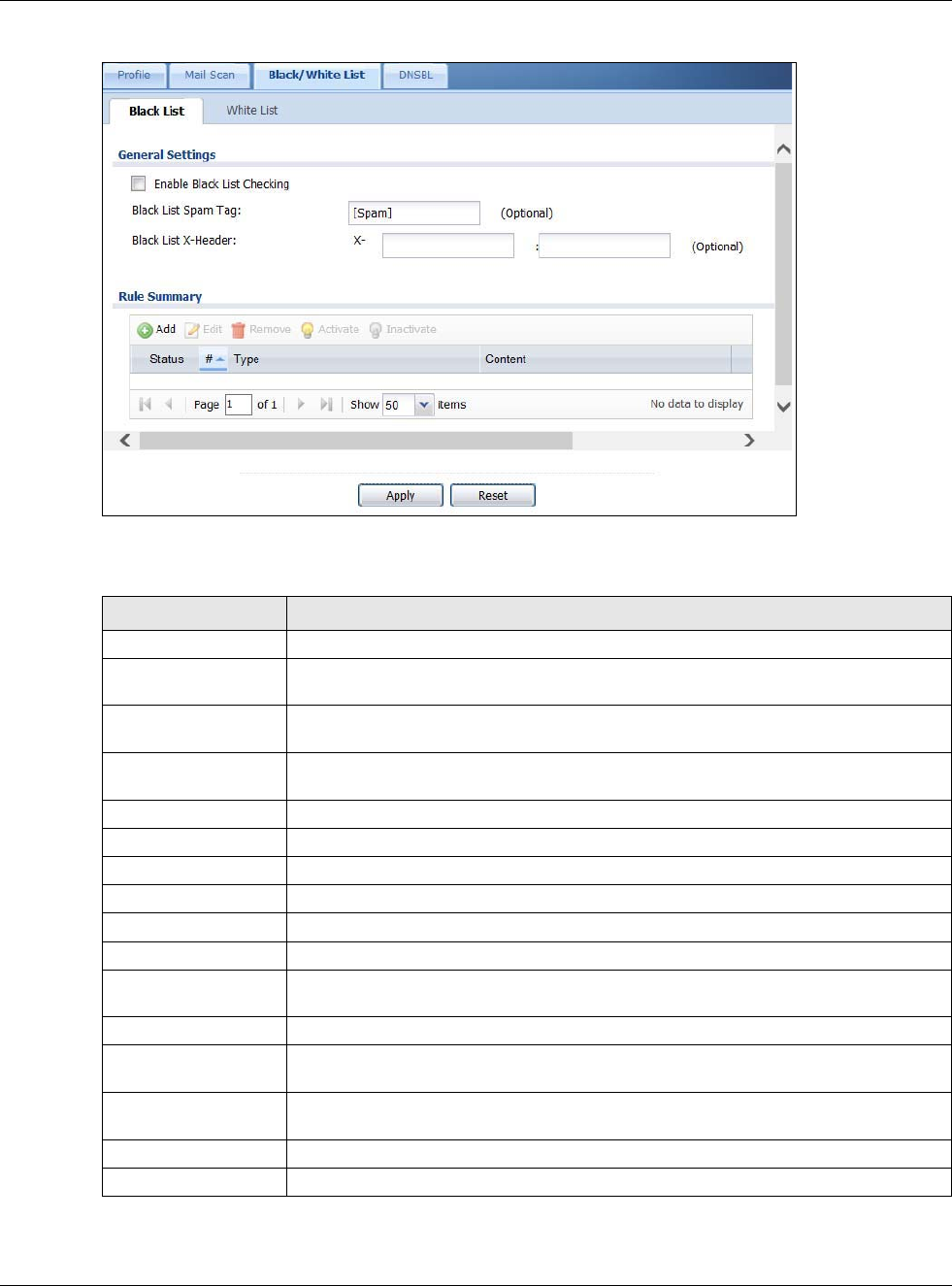
Chapter 28 Anti-Spam
USG20(W)-VPN Series User’s Guide
442
Figure 297 Configuration > UTM Profile > Anti-Spam > Black/White List > Black List
The following table describes the labels in this screen.
Table 172 Configuration > UTM Profile > Anti-Spam > Black/White List > Black List
LABEL DESCRIPTION
General Settings
Enable Black List
Checking
Select this check box to have the USG treat e-mail that matches (an active) black list
entry as spam.
Black List Spam Tag Enter a message or label (up to 15 ASCII characters) to add to the mail subject of e-
mails that match the USG’s spam black list.
Black List X-Header Specify the name and value for the X-Header to be added to e-mails that match the
USG’s spam black list.
Rule Summary
Add Click this to create a new entry.
Edit Select an entry and click this to be able to modify it.
Remove Select an entry and click this to delete it.
Activate To turn on an entry, select it and click Activate.
Inactivate To turn off an entry, select it and click Inactivate.
Status The activate (light bulb) icon is lit when the entry is active and dimmed when the
entry is inactive.
#This is the entry’s index number in the list.
Type This field displays whether the entry is based on the e-mail’s subject, source or relay
IP address, source e-mail address, or header.
Content This field displays the subject content, source or relay IP address, source e-mail
address, or header value for which the entry checks.
Apply Click Apply to save your changes back to the USG.
Reset Click Reset to return the screen to its last-saved settings.
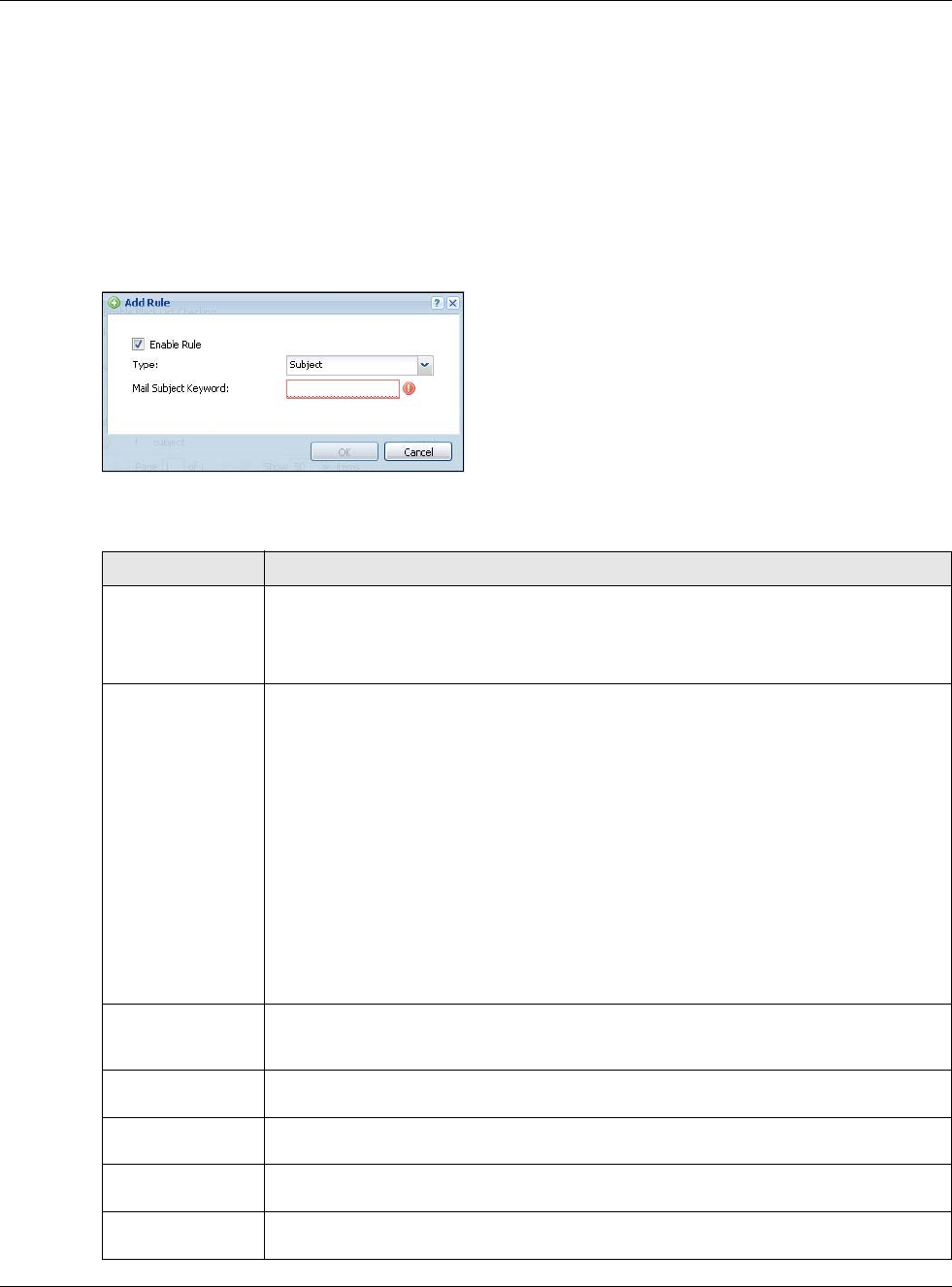
Chapter 28 Anti-Spam
USG20(W)-VPN Series User’s Guide
443
28.5.1 The Anti-Spam Black or White List Add/Edit Screen
In the anti-spam Black List or White List screen, click the Add icon or an Edit icon to display the
following screen.
Use this screen to configure an anti-spam black list entry to identify spam e-mail. You can create
entries based on specific subject text, or the sender’s or relay’s IP address or e-mail address. You
can also create entries that check for particular header fields and values.
Figure 298 Configuration > UTM Profile > Anti-Spam > Black/White List > Black List (or White List)
> Add
The following table describes the labels in this screen.
Table 173 Configuration > UTM Profile > Anti-Spam > Black/White List > Black/White List > Add
LABEL DESCRIPTION
Enable Rule Select this to have the USG use this entry as part of the black or white list.
To actually use the entry, you must also turn on the use of the list in the corresponding
list screen, enable the anti-spam feature in the anti-spam general screen, and configure
an anti-spam policy to use the list.
Type Use this field to base the entry on the e-mail’s subject, source or relay IP address,
source e-mail address, or header.
Select Subject to have the USG check e-mail for specific content in the subject line.
Select IP Address to have the USG check e-mail for a specific source or relay IP
address.
Select IPv6 Address to have the USG check e-mail for a specific source or relay IPv6
address.
Select E-Mail Address to have the USG check e-mail for a specific source e-mail
address or domain name.
Select Mail Header to have the USG check e-mail for specific header fields and values.
Configure black list header entries to check for e-mail from bulk mail programs or with
content commonly used in spam. Configure white list header entries to allow certain
header values that identify the e-mail as being from a trusted source.
Mail Subject
Keyword
This field displays when you select the Subject type. Enter up to 63 ASCII characters of
text to check for in e-mail headers. Spaces are not allowed, although you could
substitute a question mark (?). See Section 28.5.2 on page 444 for more details.
Sender or Mail
Relay IP Address
This field displays when you select the IP Address type. Enter an IP address in dotted
decimal notation.
Sender or Mail
Relay IPv6 Address
This field displays when you select the IPv6 Address type. Enter an IPv6 address with
prefix.
Netmask This field displays when you select the IP type. Enter the subnet mask here, if
applicable.
Sender E-Mail
Address
This field displays when you select the E-Mail type. Enter a keyword (up to 63 ASCII
characters). See Section 28.5.2 on page 444 for more details.

Chapter 28 Anti-Spam
USG20(W)-VPN Series User’s Guide
444
28.5.2 Regular Expressions in Black or White List Entries
The following applies for a black or white list entry based on an e-mail subject, e-mail address, or
e-mail header value.
• Use a question mark (?) to let a single character vary. For example, use “a?c” (without the
quotation marks) to specify abc, acc and so on.
• You can also use a wildcard (*). For example, if you configure *def.com, any e-mail address that
ends in def.com matches. So “mail.def.com” matches.
• The wildcard can be anywhere in the text string and you can use more than one wildcard. You
cannot use two wildcards side by side, there must be other characters between them.
• The USG checks the first header with the name you specified in the entry. So if the e-mail has
more than one “Received” header, the USG checks the first one.
28.6 The Anti-Spam White List Screen
Click Configuration > UTM Profile > Anti-Spam > Black/White List and then the White List
tab to display the Anti-Spam White List screen.
Configure the white list to identify legitimate e-mail. You can create white list entries based on the
sender’s or relay’s IP address or e-mail address. You can also create entries that check for
particular header fields and values or specific subject text.
Mail Header Field
Name
This field displays when you select the Mail Header type.
Type the name part of an e-mail header (the part that comes before the colon). Use up
to 63 ASCII characters.
For example, if you want the entry to check the “Received:” header for a specific mail
server’s domain, enter “Received” here.
Field Value
Keyword
This field displays when you select the Mail Header type.
Type the value part of an e-mail header (the part that comes after the colon). Use up to
63 ASCII characters.
For example, if you want the entry to check the “Received:” header for a specific mail
server’s domain, enter the mail server’s domain here.
See Section 28.5.2 on page 444 for more details.
OK Click OK to save your changes.
Cancel Click Cancel to exit this screen without saving your changes.
Table 173 Configuration > UTM Profile > Anti-Spam > Black/White List > Black/White List > Add
LABEL DESCRIPTION
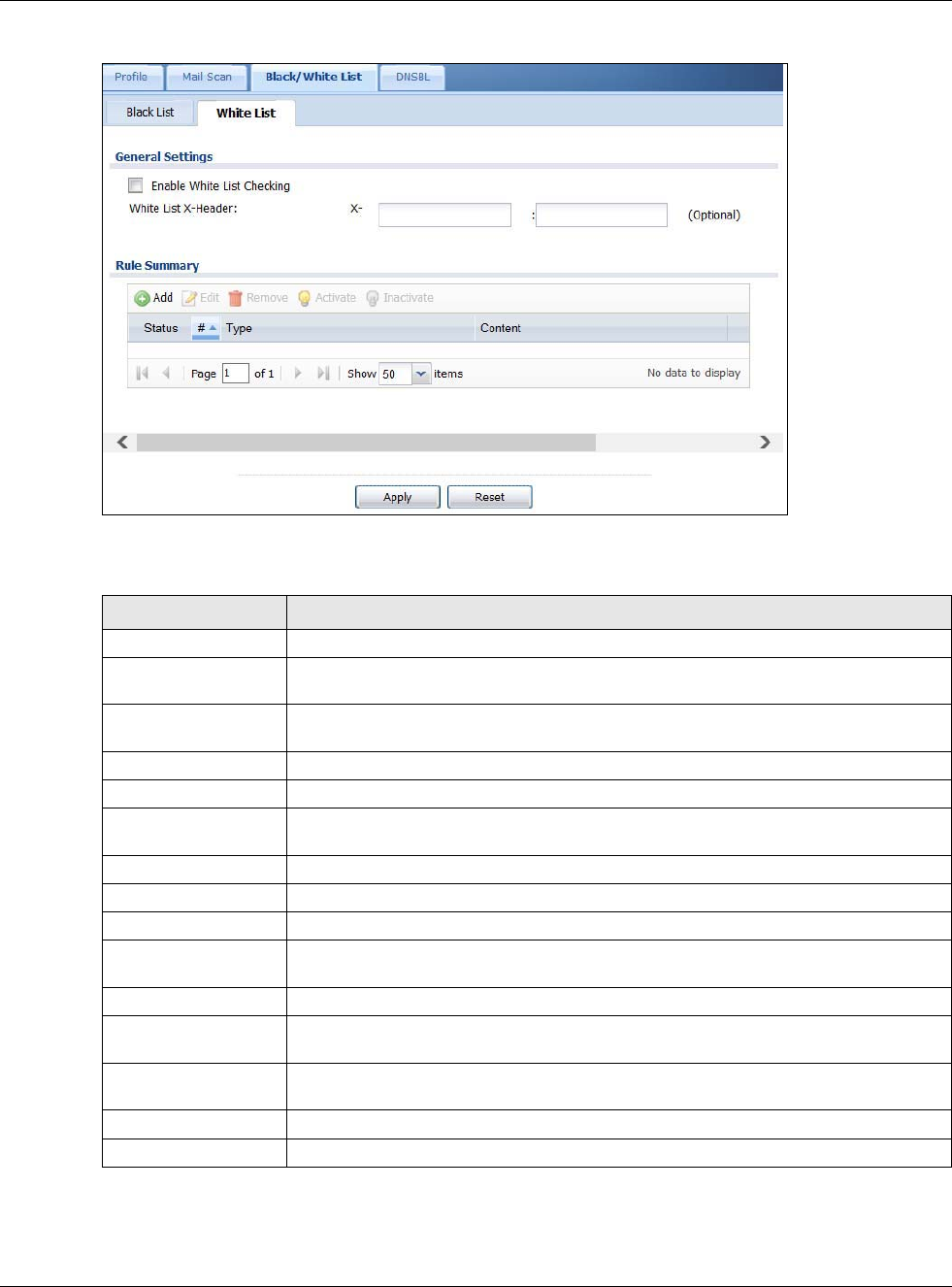
Chapter 28 Anti-Spam
USG20(W)-VPN Series User’s Guide
445
Figure 299 Configuration > UTM Profile > Anti-Spam > Black/White List > White List
The following table describes the labels in this screen.
Table 174 Configuration > UTM Profile > Anti-Spam > Black/White List > White List
LABEL DESCRIPTION
General Settings
Enable White List
Checking
Select this check box to have the USG forward e-mail that matches (an active) white
list entry without doing any more anti-spam checking on that individual e-mail.
White List X-Header Specify the name and value for the X-Header to be added to e-mails that match the
USG’s spam white list.
Rule Summary
Add Click this to create a new entry. See Section 28.5.1 on page 443 for details.
Edit Select an entry and click this to be able to modify it. See Section 28.5.1 on page 443
for details.
Remove Select an entry and click this to delete it.
Activate To turn on an entry, select it and click Activate.
Inactivate To turn off an entry, select it and click Inactivate.
Status The activate (light bulb) icon is lit when the entry is active and dimmed when the
entry is inactive.
#This is the entry’s index number in the list.
Type This field displays whether the entry is based on the e-mail’s subject, source or relay
IP address, source e-mail address, or a header.
Content This field displays the subject content, source or relay IP address, source e-mail
address, or header value for which the entry checks.
Apply Click Apply to save your changes back to the USG.
Reset Click Reset to return the screen to its last-saved settings.
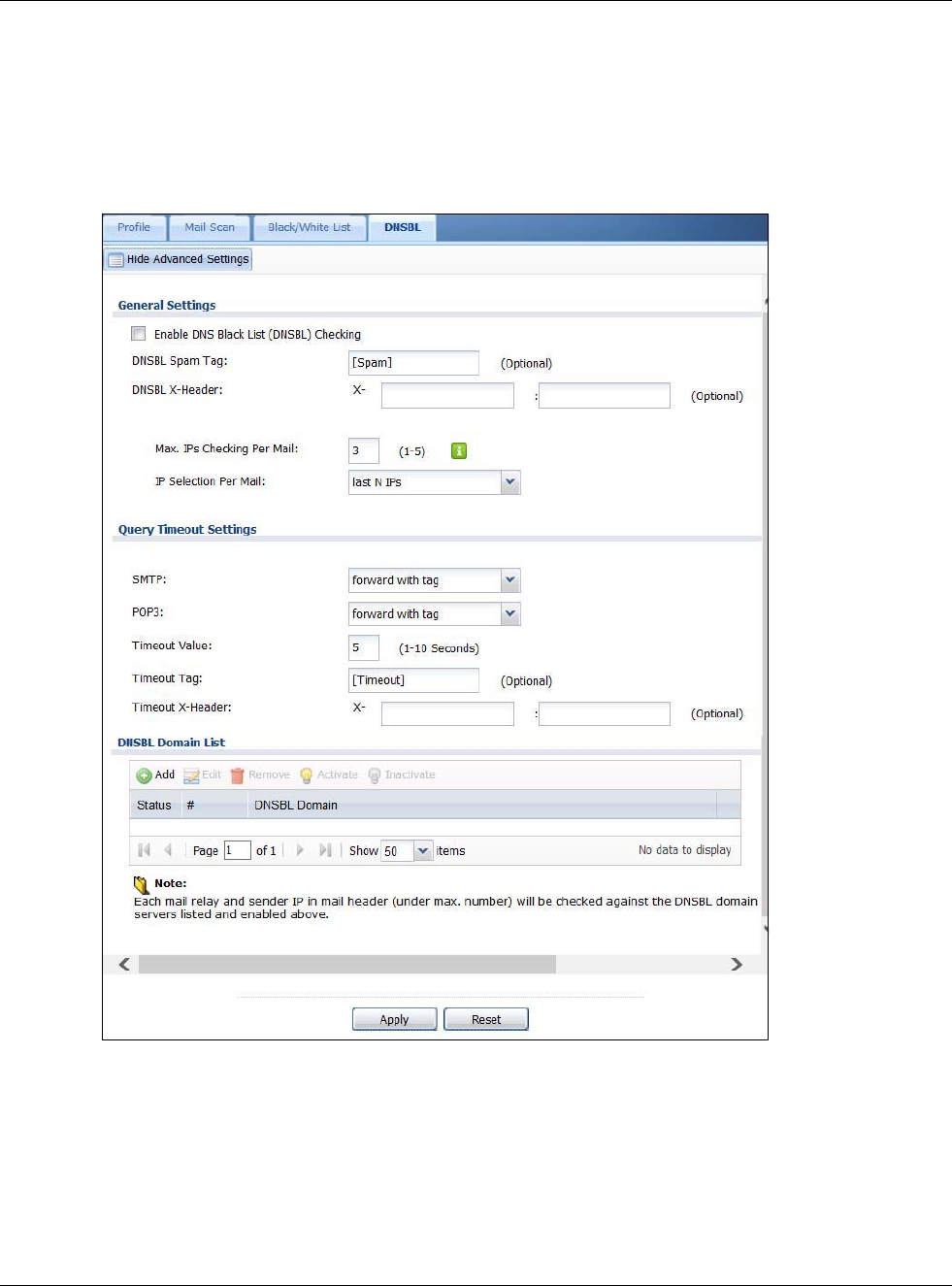
Chapter 28 Anti-Spam
USG20(W)-VPN Series User’s Guide
446
28.7 The DNSBL Screen
Click Configuration > UTM Profile > Anti-Spam > DNSBL to display the anti-spam DNSBL
screen. Use this screen to configure the USG to check the sender and relay IP addresses in e-mail
headers against DNS (Domain Name Service)-based spam Black Lists (DNSBLs).
Figure 300 Configuration > UTM Profile > Anti-Spam > DNSBL

Chapter 28 Anti-Spam
USG20(W)-VPN Series User’s Guide
447
The following table describes the labels in this screen.
Table 175 Configuration > UTM Profile > Anti-Spam > DNSBL
LABEL DESCRIPTION
Show Advanced
Settings / Hide
Advanced Settings
Click this button to display a greater or lesser number of configuration fields.
Enable DNS Black List
(DNSBL) Checking
Select this to have the USG check the sender and relay IP addresses in e-mail
headers against the DNSBL servers maintained by the DNSBL domains listed in the
USG.
DNSBL Spam Tag Enter a message or label (up to 15 ASCII characters) to add to the beginning of the
mail subject of e-mails that have a sender or relay IP address in the header that
matches a black list maintained by one of the DNSBL domains listed in the USG.
This tag is only added if the anti-spam policy is configured to forward spam mail with
a spam tag.
DSBNL X-Header Specify the name and value for the X-Header to be added to e-mails that have a
sender or relay IP address in the header that matches a black list maintained by one
of the DNSBL domains listed in the USG.
Max. IPs Checking Per
Mail
Set the maximum number of sender and relay server IP addresses in the mail header
to check against the DNSBL domain servers.
IP Selection Per Mail Select first N IPs to have the USG start checking from the first IP address in the mail
header. This is the IP of the sender or the first server that forwarded the mail.
Select last N IPs to have the USG start checking from the last IP address in the mail
header. This is the IP of the last server that forwarded the mail.
Query Timeout
Setting
SMTP Select how the USG is to handle SMTP mail (mail going to an e-mail server) if the
queries to the DNSBL domains time out.
Select drop to discard SMTP mail.
Select forward to allow SMTP mail to go through.
Select forward with tag to add a DNSBL timeout tag to the mail subject of an SMTP
mail and send it.
POP3 Select how the USG is to handle POP3 mail (mail coming to an e-mail client) if the
queries to the DNSBL domains time out.
Select forward to allow POP3 mail to go through.
Select forward with tag to add a DNSBL timeout tag to the mail subject of an POP3
mail and send it.
Timeout Value Set how long the USG waits for a reply from the DNSBL domains listed below. If there
is no reply before this time period expires, the USG takes the action defined in the
relevant Actions when Query Timeout field.
Timeout Tag Enter a message or label (up to 15 ASCII characters) to add to the mail subject of e-
mails that the USG forwards if queries to the DNSBL domains time out.
Timeout X-Header Specify the name and value for the X-Header to be added to e-mails that the USG
forwards if queries to the DNSBL domains time out.
DNSBL Domain List
Add Click this to create a new entry.
Edit Select an entry and click this to be able to modify it.
Remove Select an entry and click this to delete it.
Activate To turn on an entry, select it and click Activate.
Inactivate To turn off an entry, select it and click Inactivate.

Chapter 28 Anti-Spam
USG20(W)-VPN Series User’s Guide
448
28.8 Anti-Spam Technical Reference
Here is more detailed anti-spam information.
DNSBL
• The USG checks only public sender and relay IP addresses, it does not check private IP
addresses.
• The USG sends a separate query (DNS lookup) for each sender or relay IP address in the e-mail’s
header to each of the USG’s DNSBL domains at the same time.
• The DNSBL servers send replies as to whether or not each IP address matches an entry in their
list. Each IP address has a separate reply.
• As long as the replies are indicating the IP addresses do not match entries on the DNSBL lists,
the USG waits until it receives at least one reply for each IP address.
• If the USG receives a DNSBL reply that one of the IP addresses is in the DNSBL list, the USG
immediately classifies the e-mail as spam and takes the anti-spam policy’s configured action for
spam. The USG does not wait for any more DNSBL replies.
• If the USG receives at least one non-spam reply for each of an e-mail’s routing IP addresses, the
USG immediately classifies the e-mail as legitimate and forwards it.
• Any further DNSBL replies that come after the USG classifies an e-mail as spam or legitimate
have no effect.
• The USG records DNSBL responses for IP addresses in a cache for up to 72 hours. The USG
checks an e-mail’s sender and relay IP addresses against the cache first and only sends DNSBL
queries for IP addresses that are not in the cache.
Here is an example of an e-mail classified as spam based on DNSBL replies.
Status The activate (light bulb) icon is lit when the entry is active and dimmed when the
entry is inactive.
#This is the entry’s index number in the list.
DNSBL Domain This is the name of a domain that maintains DNSBL servers. Enter the domain that is
maintaining a DNSBL.
Apply Click Apply to save your changes back to the USG.
Reset Click Reset to return the screen to its last-saved settings.
Table 175 Configuration > UTM Profile > Anti-Spam > DNSBL (continued)
LABEL DESCRIPTION
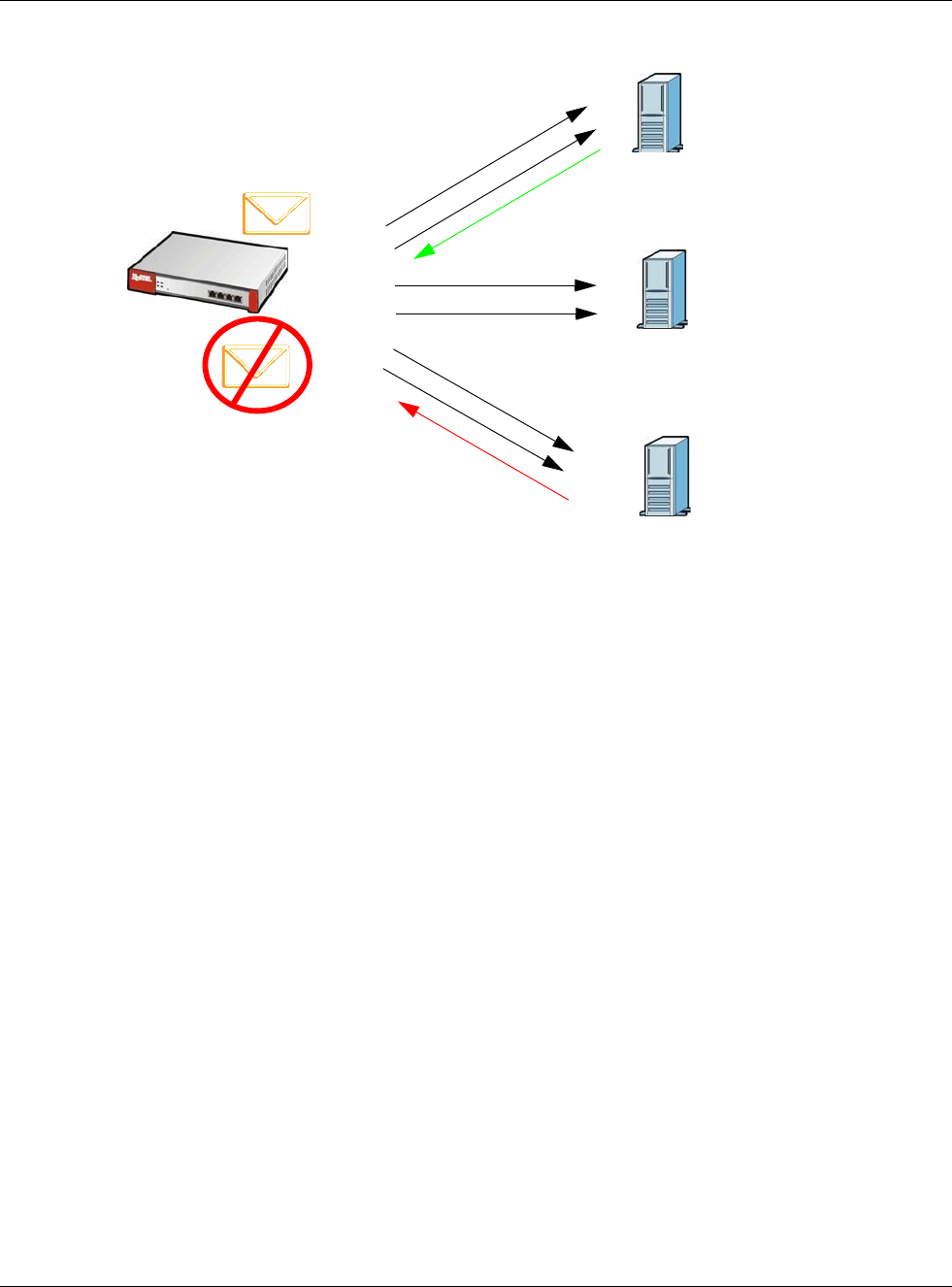
Chapter 28 Anti-Spam
USG20(W)-VPN Series User’s Guide
449
Figure 301 DNSBL Spam Detection Example
1The USG receives an e-mail that was sent from IP address a.a.a.a and relayed by an e-mail server
at IP address b.b.b.b. The USG sends a separate query to each of its DNSBL domains for IP address
a.a.a.a. The USG sends another separate query to each of its DNSBL domains for IP address
b.b.b.b.
2DNSBL A replies that IP address a.a.a.a does not match any entries in its list (not spam).
3DNSBL C replies that IP address b.b.b.b matches an entry in its list.
4The USG immediately classifies the e-mail as spam and takes the action for spam that you defined
in the anti-spam policy. In this example it was an SMTP mail and the defined action was to drop the
mail. The USG does not wait for any more DNSBL replies.
Here is an example of an e-mail classified as legitimate based on DNSBL replies.
DNSBL A
DNSBL B
DNSBL C
IPs: a.a.a.a
b.b.b.b
1
2
a.a.a.a Not spam
3
4
a.a.a.a?
b.b.b.b?
a.a.a.a?
b.b.b.b?
a.a.a.a?
b.b.b.b?
b.b.b.b Spam
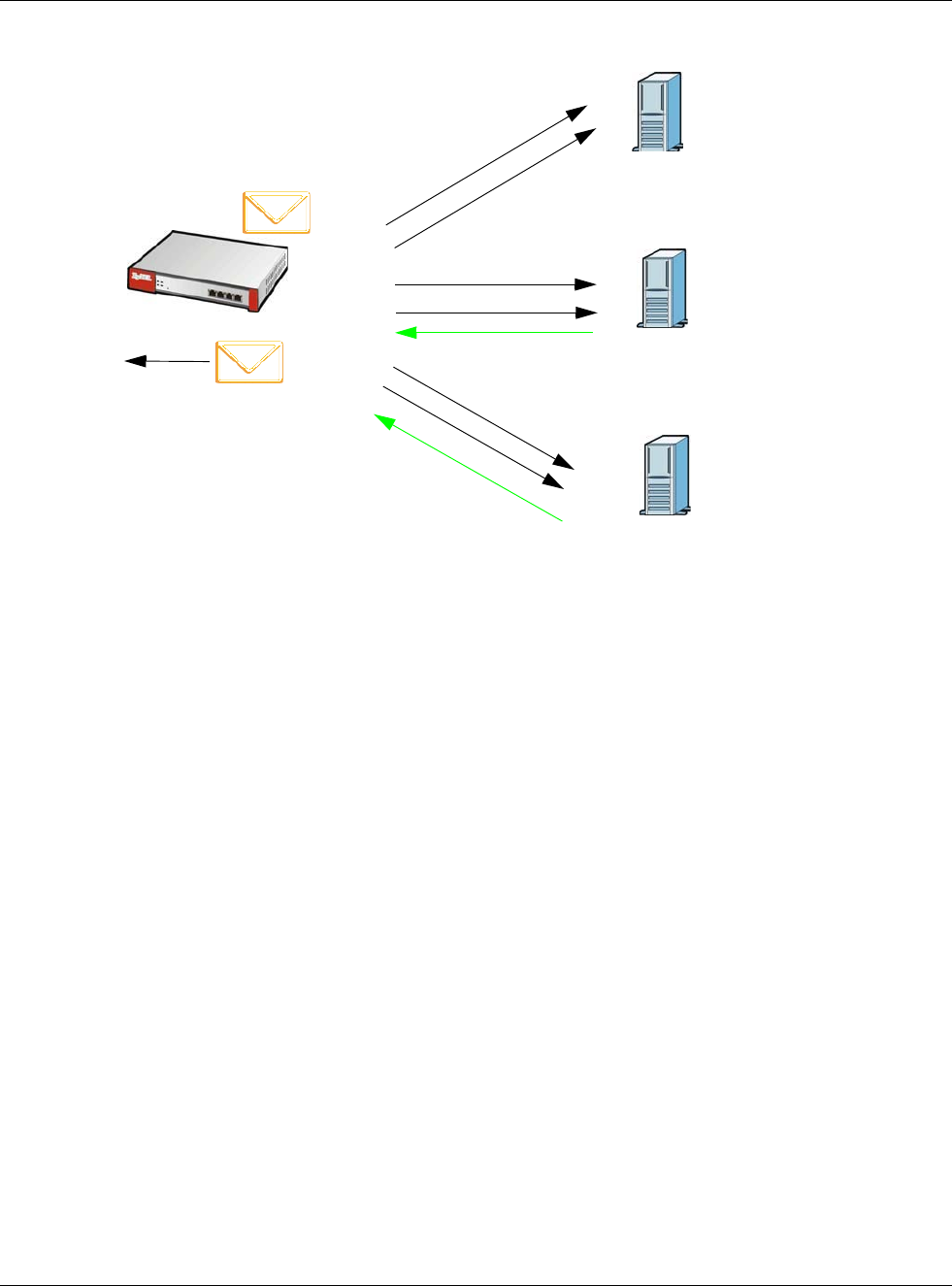
Chapter 28 Anti-Spam
USG20(W)-VPN Series User’s Guide
450
Figure 302 DNSBL Legitimate E-mail Detection Example
1The USG receives an e-mail that was sent from IP address c.c.c.c and relayed by an e-mail server
at IP address d.d.d.d. The USG sends a separate query to each of its DNSBL domains for IP address
c.c.c.c. The USG sends another separate query to each of its DNSBL domains for IP address
d.d.d.d.
2DNSBL B replies that IP address d.d.d.d does not match any entries in its list (not spam).
3DNSBL C replies that IP address c.c.c.c does not match any entries in its list (not spam).
4Now that the USG has received at least one non-spam reply for each of the e-mail’s routing IP
addresses, the USG immediately classifies the e-mail as legitimate and forwards it. The USG does
not wait for any more DNSBL replies.
If the USG receives conflicting DNSBL replies for an e-mail routing IP address, the USG classifies
the e-mail as spam. Here is an example.
DNSBL A
DNSBL B
DNSBL C
IPs: c.c.c.c
d.d.d.d
1
c.c.c.c Not spam
2
4
c.c.c.c?
d.d.d.d?
c.c.c.c?
d.d.d.d?
c.c.c.c?
d.d.d.d?
d.d.d.d Not spam
3
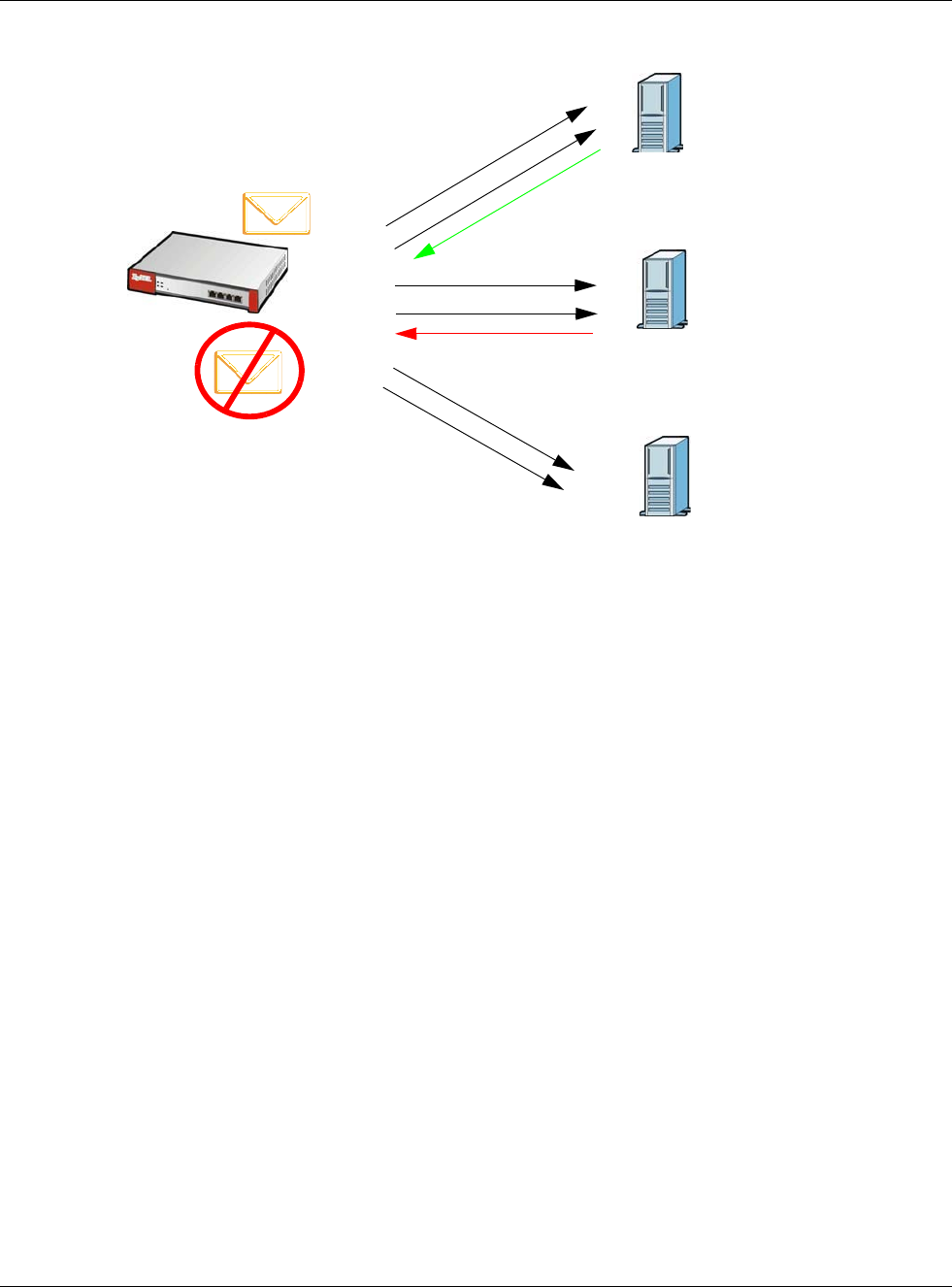
Chapter 28 Anti-Spam
USG20(W)-VPN Series User’s Guide
451
Figure 303 Conflicting DNSBL Replies Example
1The USG receives an e-mail that was sent from IP address a.b.c.d and relayed by an e-mail server
at IP address w.x.y.z. The USG sends a separate query to each of its DNSBL domains for IP address
a.b.c.d. The USG sends another separate query to each of its DNSBL domains for IP address
w.x.y.z.
2DNSBL A replies that IP address a.b.c.d does not match any entries in its list (not spam).
3While waiting for a DNSBL reply about IP address w.x.y.z, the USG receives a reply from DNSBL B
saying IP address a.b.c.d is in its list.
4The USG immediately classifies the e-mail as spam and takes the action for spam that you defined
in the anti-spam policy. In this example it was an SMTP mail and the defined action was to drop the
mail. The USG does not wait for any more DNSBL replies.
DNSBL A
DNSBL B
DNSBL C
IPs: a.b.c.d
w.x.y.z
1
2
a.b.c.d Not spam
3
4
a.b.c.d?
w.x.y.z?
a.b.c.d?
w.x.y.z?
a.b.c.d?
w.x.y.z?
a.b.c.d Spam!
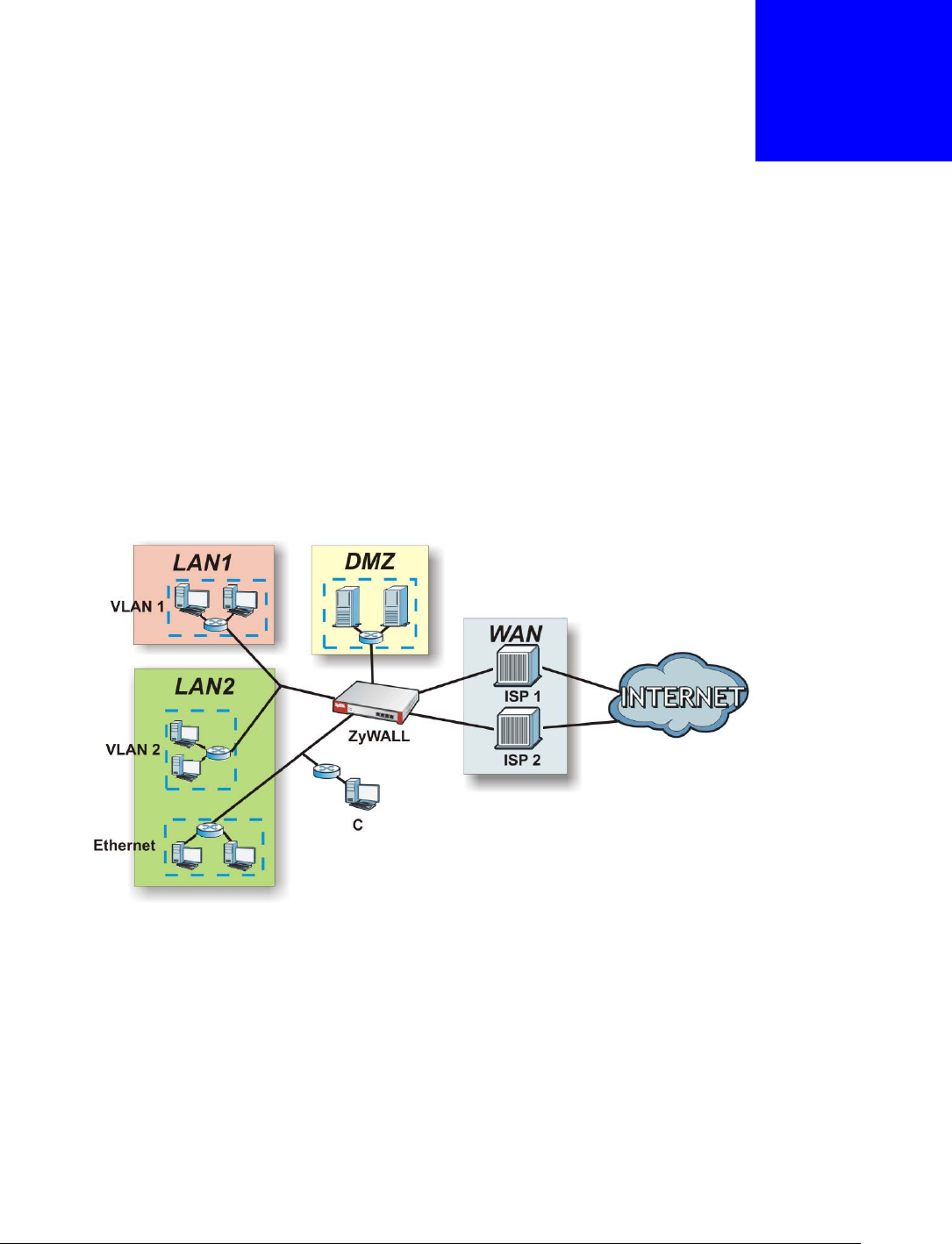
USG20(W)-VPN Series User’s Guide
452
CHAPTER 29
Object
29.1 Zones Overview
Set up zones to configure network security and network policies in the USG. A zone is a group of
interfaces and/or VPN tunnels. The USG uses zones instead of interfaces in many security and
policy settings, such as Secure Policies rules, UTM Profile, and remote management.
Zones cannot overlap. Each Ethernet interface, VLAN interface, bridge interface, PPPoE/PPTP
interface and VPN tunnel can be assigned to at most one zone. Virtual interfaces are automatically
assigned to the same zone as the interface on which they run.
Figure 304 Example: Zones
Use the Zone screens (see Section 29.7.2 on page 497) to manage the USG’s zones.
29.1.1 What You Need to Know
Zones effectively divide traffic into three types--intra-zone traffic, inter-zone traffic, and extra-zone
traffic.
Intra-zone Traffic
• Intra-zone traffic is traffic between interfaces or VPN tunnels in the same zone. For example, in
Figure 304 on page 452, traffic between VLAN 2 and the Ethernet is intra-zone traffic.
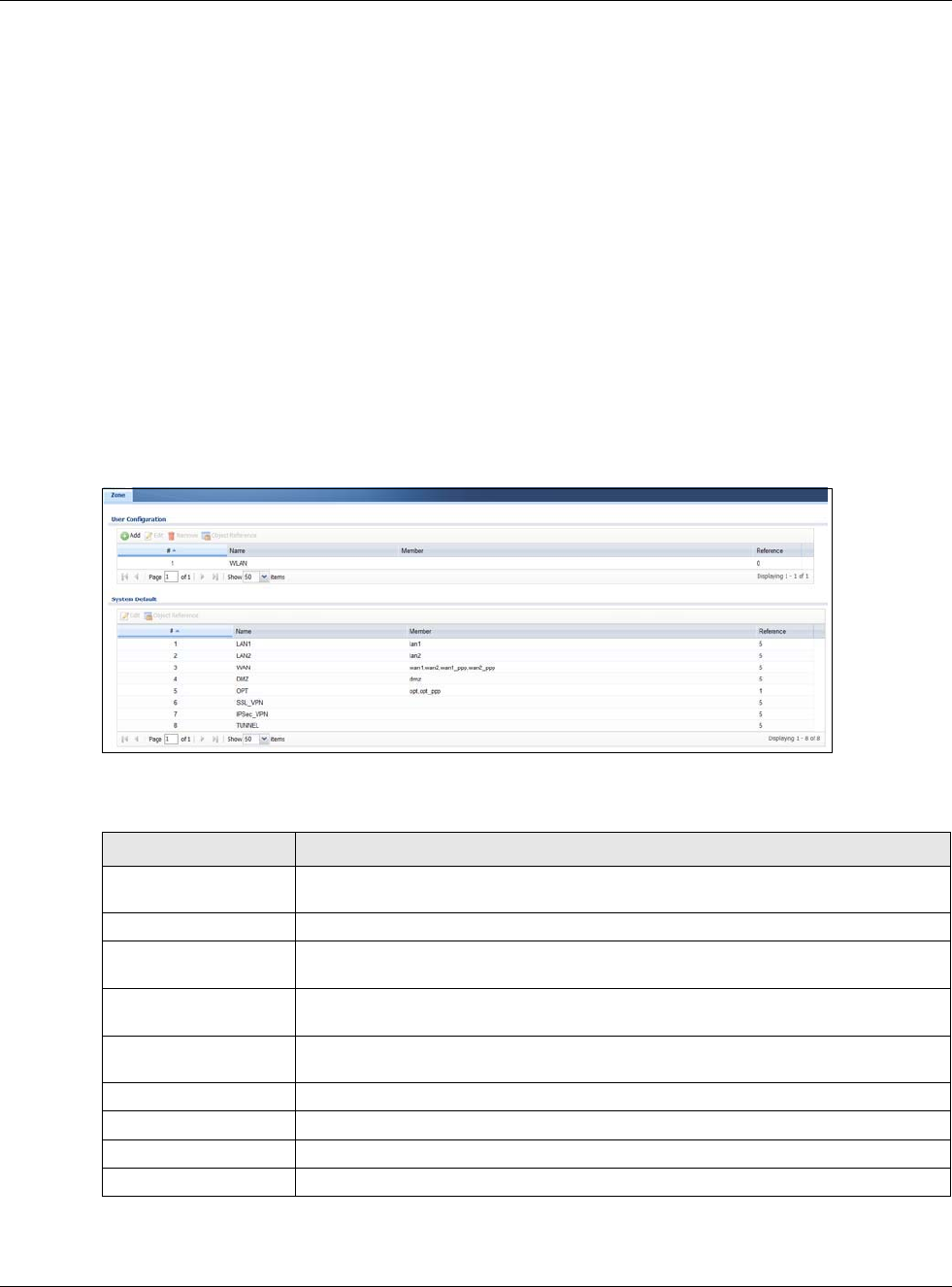
Chapter 29 Object
USG20(W)-VPN Series User’s Guide
453
Inter-zone Traffic
Inter-zone traffic is traffic between interfaces or VPN tunnels in different zones. For example, in
Figure 304 on page 452, traffic between VLAN 1 and the Internet is inter-zone traffic. This is the
normal case when zone-based security and policy settings apply.
Extra-zone Traffic
• Extra-zone traffic is traffic to or from any interface or VPN tunnel that is not assigned to a zone.
For example, in Figure 304 on page 452, traffic to or from computer C is extra-zone traffic.
• Some zone-based security and policy settings may apply to extra-zone traffic, especially if you
can set the zone attribute in them to Any or All. See the specific feature for more information.
29.1.2 The Zone Screen
The Zone screen provides a summary of all zones. In addition, this screen allows you to add, edit,
and remove zones. To access this screen, click Configuration > Object > Zone.
Figure 305 Configuration > Object > Zone
The following table describes the labels in this screen.
Table 176 Configuration > Object > Zone
LABEL DESCRIPTION
User Configuration /
System Default
The USG comes with pre-configured System Default zones that you cannot delete.
You can create your own User Configuration zones
Add Click this to create a new, user-configured zone.
Edit Double-click an entry or select it and click Edit to open a screen where you can
modify the entry’s settings.
Remove To remove a user-configured trunk, select it and click Remove. The USG confirms
you want to remove it before doing so.
Object References Select an entry and click Object References to open a screen that shows which
settings use the entry. Click Refresh to update information in this screen.
# This field is a sequential value, and it is not associated with any interface.
Name This field displays the name of the zone.
Member This field displays the names of the interfaces that belong to each zone.
Reference This field displays the number of times an Object Reference is used in a policy.
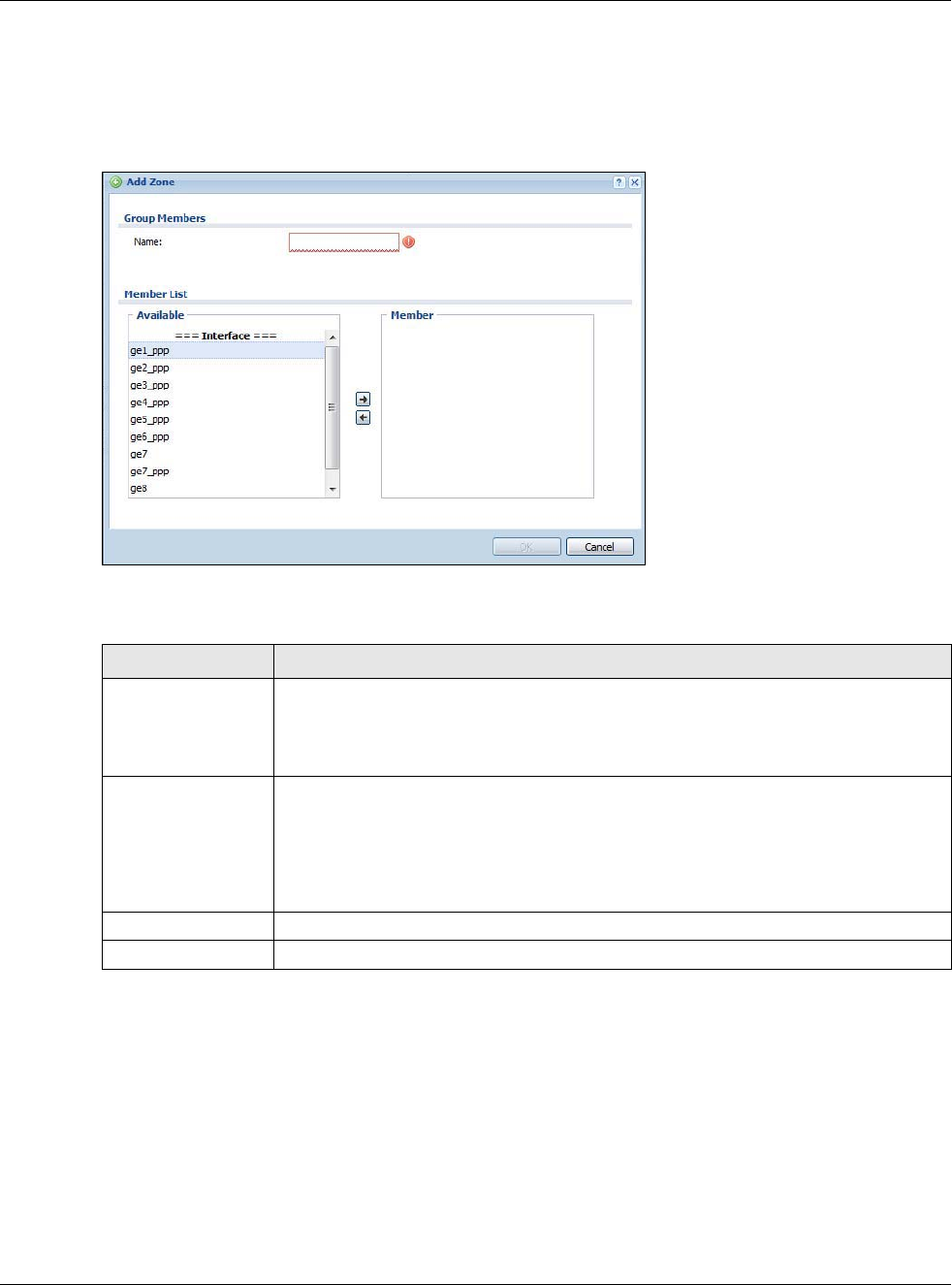
Chapter 29 Object
USG20(W)-VPN Series User’s Guide
454
29.1.2.1 Zone Edit
The Zone Edit screen allows you to add or edit a zone. To access this screen, go to the Zone
screen (see Section 29.7.2 on page 497), and click the Add icon or an Edit icon.
Figure 306 Configuration > Object > Zone > Add
The following table describes the labels in this screen.
29.2 User/Group Overview
This section describes how to set up user accounts, user groups, and user settings for the USG. You
can also set up rules that control when users have to log in to the USG before the USG routes traffic
for them.
•The User screen (see Section 29.2.2 on page 457) provides a summary of all user accounts.
Table 177 Configuration > Object > Zone > Add/Edit
LABEL DESCRIPTION
Name For a system default zone, the name is read only.
For a user-configured zone, type the name used to refer to the zone. You may use 1-31
alphanumeric characters, underscores (_), or dashes (-), but the first character cannot
be a number. This value is case-sensitive.
Member List Available lists the interfaces and VPN tunnels that do not belong to any zone. Select
the interfaces and VPN tunnels that you want to add to the zone you are editing, and
click the right arrow button to add them.
Member lists the interfaces and VPN tunnels that belong to the zone. Select any
interfaces that you want to remove from the zone, and click the left arrow button to
remove them.
OK Click OK to save your customized settings and exit this screen.
Cancel Click Cancel to exit this screen without saving.
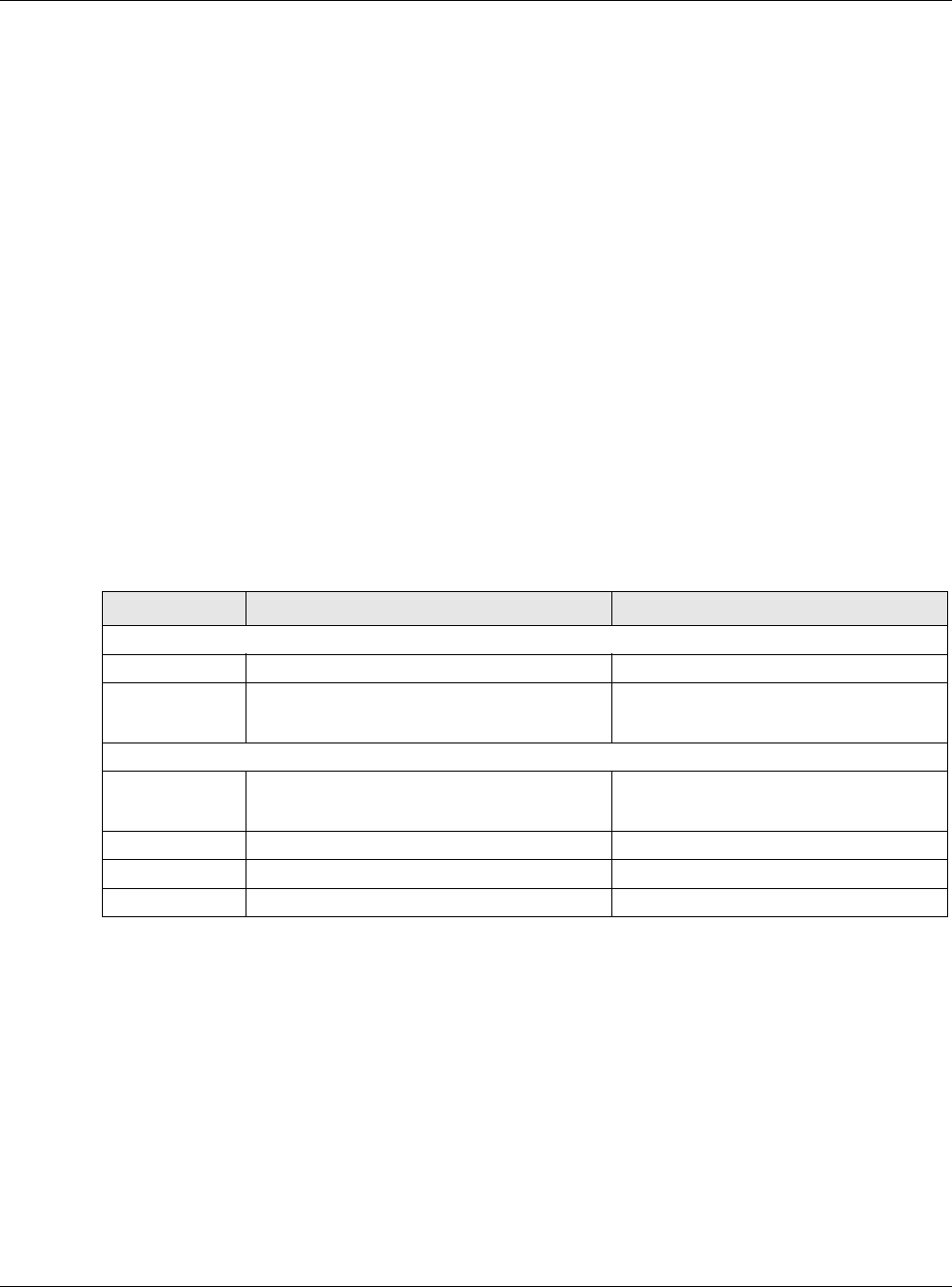
Chapter 29 Object
USG20(W)-VPN Series User’s Guide
455
•The Group screen (see Section 29.2.3 on page 460) provides a summary of all user groups. In
addition, this screen allows you to add, edit, and remove user groups. User groups may consist of
access users and other user groups. You cannot put admin users in user groups
•The Setting screen (see Section 29.2.4 on page 461) controls default settings, login settings,
lockout settings, and other user settings for the USG. You can also use this screen to specify
when users must log in to the USG before it routes traffic for them.
•The MAC Address screen (see Section 29.2.5 on page 466) allows you to configure the MAC
addresses or OUI (Organizationally Unique Identifier) of wireless clients for MAC authentication
using the local user database. The OUI is the first three octets in a MAC address and uniquely
identifies the manufacturer of a network device.
29.2.1 What You Need To Know
User Account
A user account defines the privileges of a user logged into the USG. User accounts are used in
security policies, in addition to controlling access to configuration and services in the USG.
User Types
These are the types of user accounts the USG uses.
Note: The default admin account is always authenticated locally, regardless of the
authentication method setting. (See Chapter 29 on page 510 for more information
about authentication methods.)
Ext-User Accounts
Set up an ext-user account if the user is authenticated by an external server and you want to set
up specific policies for this user in the USG. If you do not want to set up policies for this user, you
do not have to set up an ext-user account.
All ext-user users should be authenticated by an external server, such as AD, LDAP or RADIUS. If
the USG tries to use the local database to authenticate an ext-user, the authentication attempt
always fails. (This is related to AAA servers and authentication methods, which are discussed in
those chapters in this guide.)
Table 178 Types of User Accounts
TYPE ABILITIES LOGIN METHOD(S)
Admin Users
admin Change USG configuration (web, CLI) WWW, TELNET, SSH, FTP, Console
limited-admin Look at USG configuration (web, CLI)
Perform basic diagnostics (CLI)
WWW, TELNET, SSH, Console
Access Users
user Access network services
Browse user-mode commands (CLI)
WWW, TELNET, SSH
guest Access network services WWW
ext-user External user account WWW
ext-group-user External group user account WWW

Chapter 29 Object
USG20(W)-VPN Series User’s Guide
456
Note: If the USG tries to authenticate an ext-user using the local database, the attempt
always fails.
Once an ext-user user has been authenticated, the USG tries to get the user type (see Table 178
on page 455) from the external server. If the external server does not have the information, the
USG sets the user type for this session to User.
For the rest of the user attributes, such as reauthentication time, the USG checks the following
places, in order.
1User account in the remote server.
2User account (Ext-User) in the USG.
3Default user account for AD users (ad-users), LDAP users (ldap-users) or RADIUS users (radius-
users) in the USG.
See Setting up User Attributes in an External Server on page 468 for a list of attributes and how to
set up the attributes in an external server.
Ext-Group-User Accounts
Ext-Group-User accounts work are similar to ext-user accounts but allow you to group users by
the value of the group membership attribute configured for the AD or LDAP server. See Section
29.8.5.1 on page 505 for more on the group membership attribute.
User Groups
User groups may consist of user accounts or other user groups. Use user groups when you want to
create the same rule for several user accounts, instead of creating separate rules for each one.
Note: You cannot put access users and admin users in the same user group.
Note: You cannot put the default admin account into any user group.
The sequence of members in a user group is not important.
User Awareness
By default, users do not have to log into the USG to use the network services it provides. The USG
automatically routes packets for everyone. If you want to restrict network services that certain
users can use via the USG, you can require them to log in to the USG first. The USG is then ‘aware’
of the user who is logged in and you can create ‘user-aware policies’ that define what services they
can use. See Section 29.2.6 on page 467 for a user-aware login example.
Finding Out More
•See Section 29.2.6 on page 467 for some information on users who use an external
authentication server in order to log in.
• The USG supports TTLS using PAP so you can use the USG’s local user database to authenticate
users with WPA or WPA2 instead of needing an external RADIUS server.
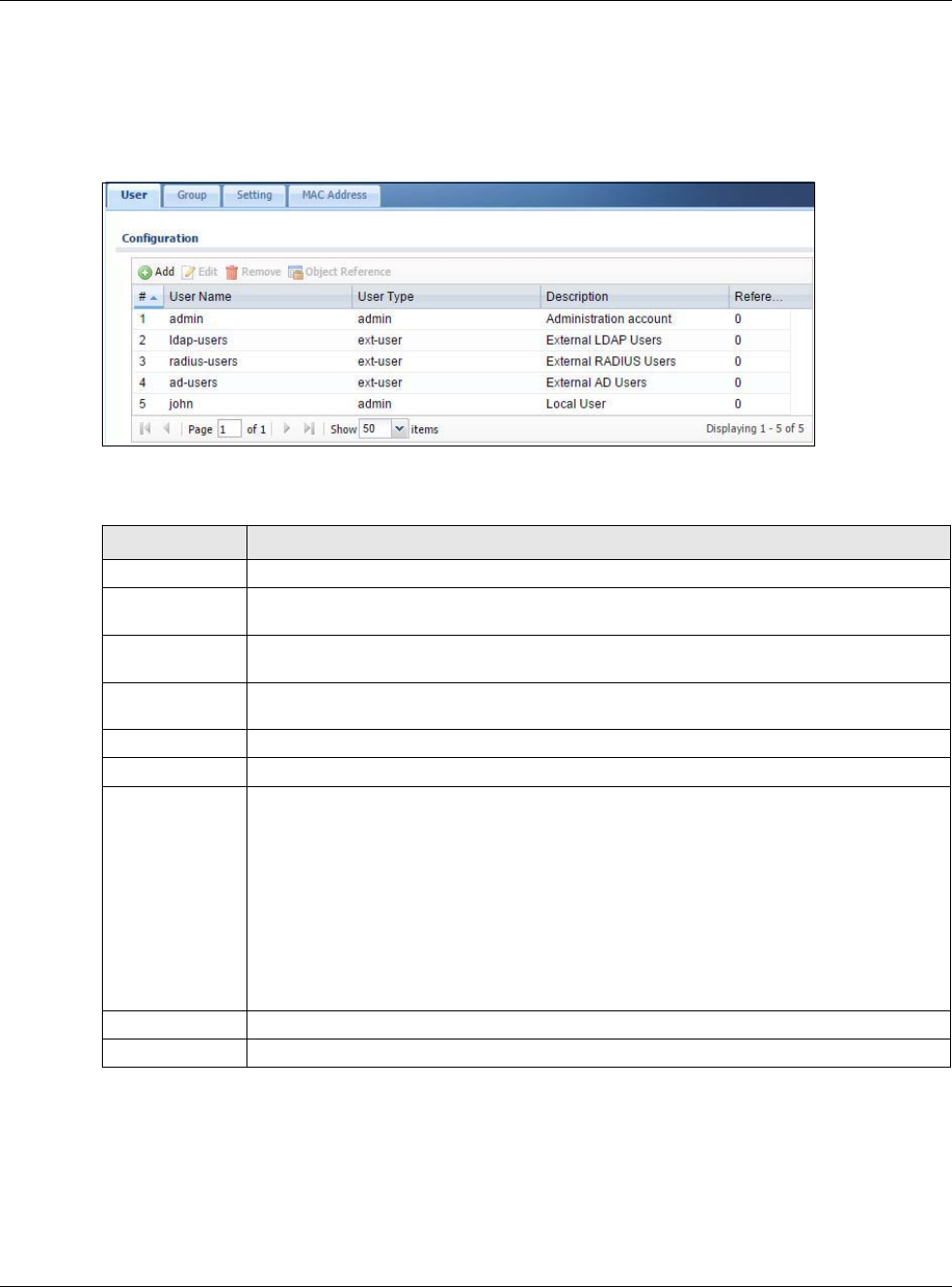
Chapter 29 Object
USG20(W)-VPN Series User’s Guide
457
29.2.2 User/Group User Summary Screen
The User screen provides a summary of all user accounts. To access this screen, login to the Web
Configurator, and click Configuration > Object > User/Group.
Figure 307 Configuration > Object > User/Group > User
The following table describes the labels in this screen.
29.2.2.1 User Add/Edit Screen
The User Add/Edit screen allows you to create a new user account or edit an existing one.
29.2.2.2 Rules for User Names
Enter a user name from 1 to 31 characters.
Table 179 Configuration > Object > User/Group > User
LABEL DESCRIPTION
Add Click this to create a new entry.
Edit Double-click an entry or select it and click Edit to open a screen where you can modify the
entry’s settings.
Remove To remove an entry, select it and click Remove. The USG confirms you want to remove it
before doing so.
Object
References
Select an entry and click Object References to open a screen that shows which settings
use the entry.
# This field is a sequential value, and it is not associated with a specific user.
User Name This field displays the user name of each user.
User Type This field displays the types of user accounts the USG uses:
•admin - this user can look at and change the configuration of the USG
•limited-admin - this user can look at the configuration of the USG but not to change it
•user - this user has access to the USG’s services and can also browse user-mode
commands (CLI).
•guest - this user has access to the USG’s services but cannot look at the configuration
•ext-user - this user account is maintained in a remote server, such as RADIUS or
LDAP. See Ext-User Accounts on page 455 for more information about this type.
•ext-group-user - this user account is maintained in a remote server, such as RADIUS
or LDAP. See Ext-Group-User Accounts on page 456 for more information about this
type.
Description This field displays the description for each user.
Reference This displays the number of times an object reference is used in a profile.
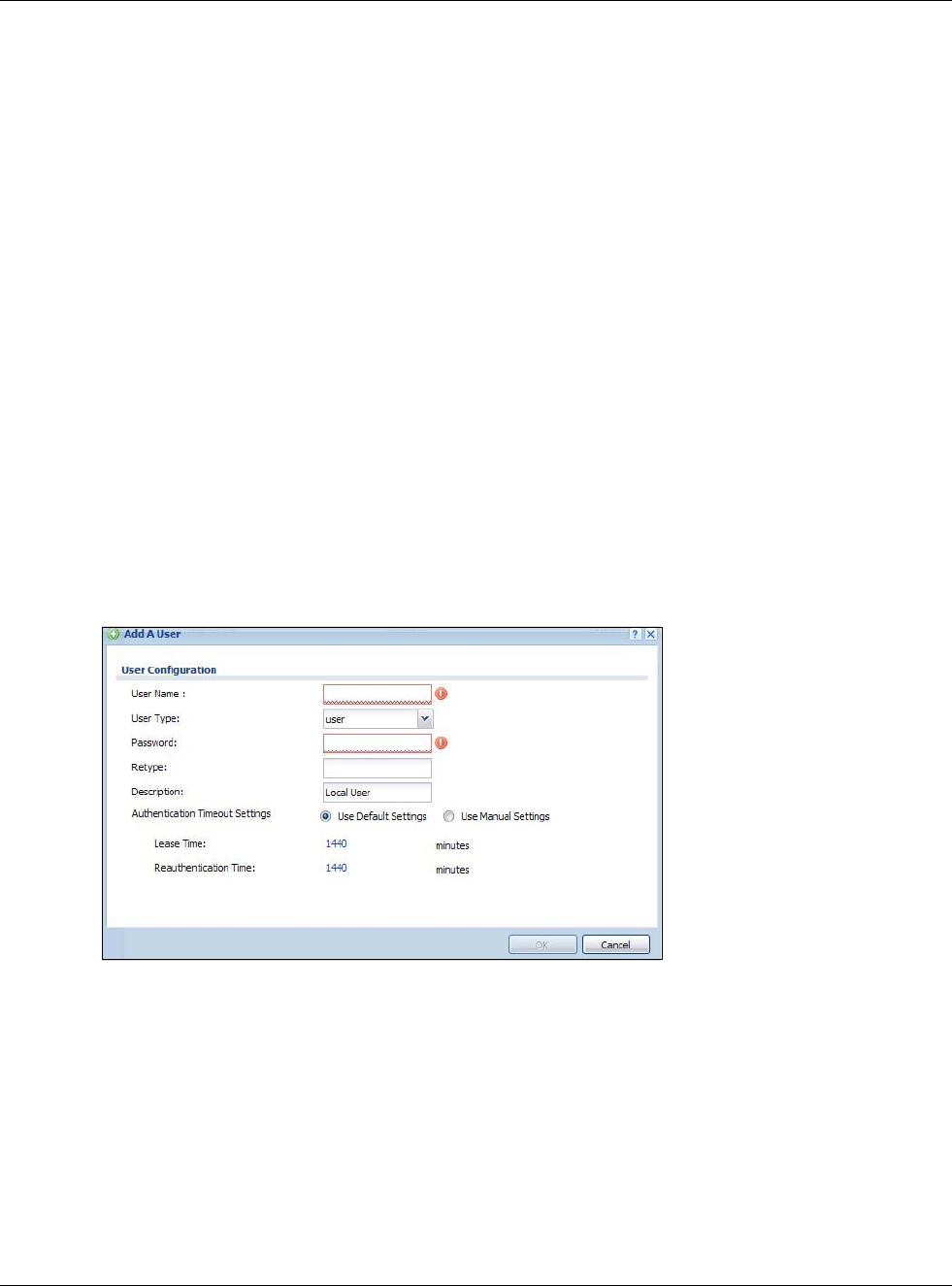
Chapter 29 Object
USG20(W)-VPN Series User’s Guide
458
The user name can only contain the following characters:
• Alphanumeric A-z 0-9 (there is no unicode support)
• _ [underscores]
•- [dashes]
The first character must be alphabetical (A-Z a-z), an underscore (_), or a dash (-). Other
limitations on user names are:
• User names are case-sensitive. If you enter a user 'bob' but use 'BOB' when connecting via CIFS
or FTP, it will use the account settings used for 'BOB' not ‘bob’.
• User names have to be different than user group names.
• Here are the reserved user names:
To access this screen, go to the User screen (see Section 29.2.2 on page 457), and click either the
Add icon or an Edit icon.
Figure 308 Configuration > Object > User/Group > User > Add
•adm •admin •any •bin •daemon
•debug •devicehaecived•ftp •games •halt
•ldap-users •lp •mail •news •nobody
•operator •radius-users •root •shutdown •sshd
•sync •uucp •zyxel

Chapter 29 Object
USG20(W)-VPN Series User’s Guide
459
The following table describes the labels in this screen.
Table 180 Configuration > Object > User/Group > User > Add
LABEL DESCRIPTION
User Name Type the user name for this user account. You may use 1-31 alphanumeric characters,
underscores(_), or dashes (-), but the first character cannot be a number. This value is
case-sensitive. User names have to be different than user group names, and some
words are reserved. See Section 29.2.2.2 on page 457.
User Type This field displays the types of user accounts the USG uses:
•admin - this user can look at and change the configuration of the USG
•limited-admin - this user can look at the configuration of the USG but not to
change it
•user - this user has access to the USG’s services and can also browse user-mode
commands (CLI).
•guest - this user has access to the USG’s services but cannot look at the
configuration.
•ext-user - this user account is maintained in a remote server, such as RADIUS or
LDAP. See Ext-User Accounts on page 455 for more information about this type.
•ext-group-user - this user account is maintained in a remote server, such as
RADIUS or LDAP. See Ext-Group-User Accounts on page 456 for more information
about this type.
Password This field is not available if you select the ext-user or ext-group-user type.
Enter the password of this user account. It can consist of 4 - 31 alphanumeric
characters.
Retype This field is not available if you select the ext-user or ext-group-user type.
Group Identifier This field is available for a ext-group-user type user account.
Specify the value of the AD or LDAP server’s Group Membership Attribute that
identifies the group to which this user belongs.
Associated AAA
Server Object
This field is available for a ext-group-user type user account. Select the AAA server to
use to authenticate this account’s users.
Description Enter the description of each user, if any. You can use up to 60 printable ASCII
characters. Default descriptions are provided.
Authentication
Timeout Settings
If you want the system to use default settings, select Use Default Settings. If you
want to set authentication timeout to a value other than the default settings, select Use
Manual Settings then fill your preferred values in the fields that follow.
Lease Time If you select Use Default Settings in the Authentication Timeout Settings field, the
default lease time is shown.
If you select Use Manual Settings, you need to enter the number of minutes this user
has to renew the current session before the user is logged out. You can specify 1 to
1440 minutes. You can enter 0 to make the number of minutes unlimited. Admin users
renew the session every time the main screen refreshes in the Web Configurator. Access
users can renew the session by clicking the Renew button on their screen. If you allow
access users to renew time automatically (see Section 29.2.4 on page 461), the users
can select this check box on their screen as well. In this case, the session is
automatically renewed before the lease time expires.
Reauthentication
Time
If you select Use Default Settings in the Authentication Timeout Settings field, the
default lease time is shown.
If you select Use Manual Settings, you need to type the number of minutes this user
can be logged into the USG in one session before the user has to log in again. You can
specify 1 to 1440 minutes. You can enter 0 to make the number of minutes unlimited.
Unlike Lease Time, the user has no opportunity to renew the session without logging
out.
Configuration
Validation
Use a user account from the group specified above to test if the configuration is correct.
Enter the account’s user name in the User Name field and click Test.
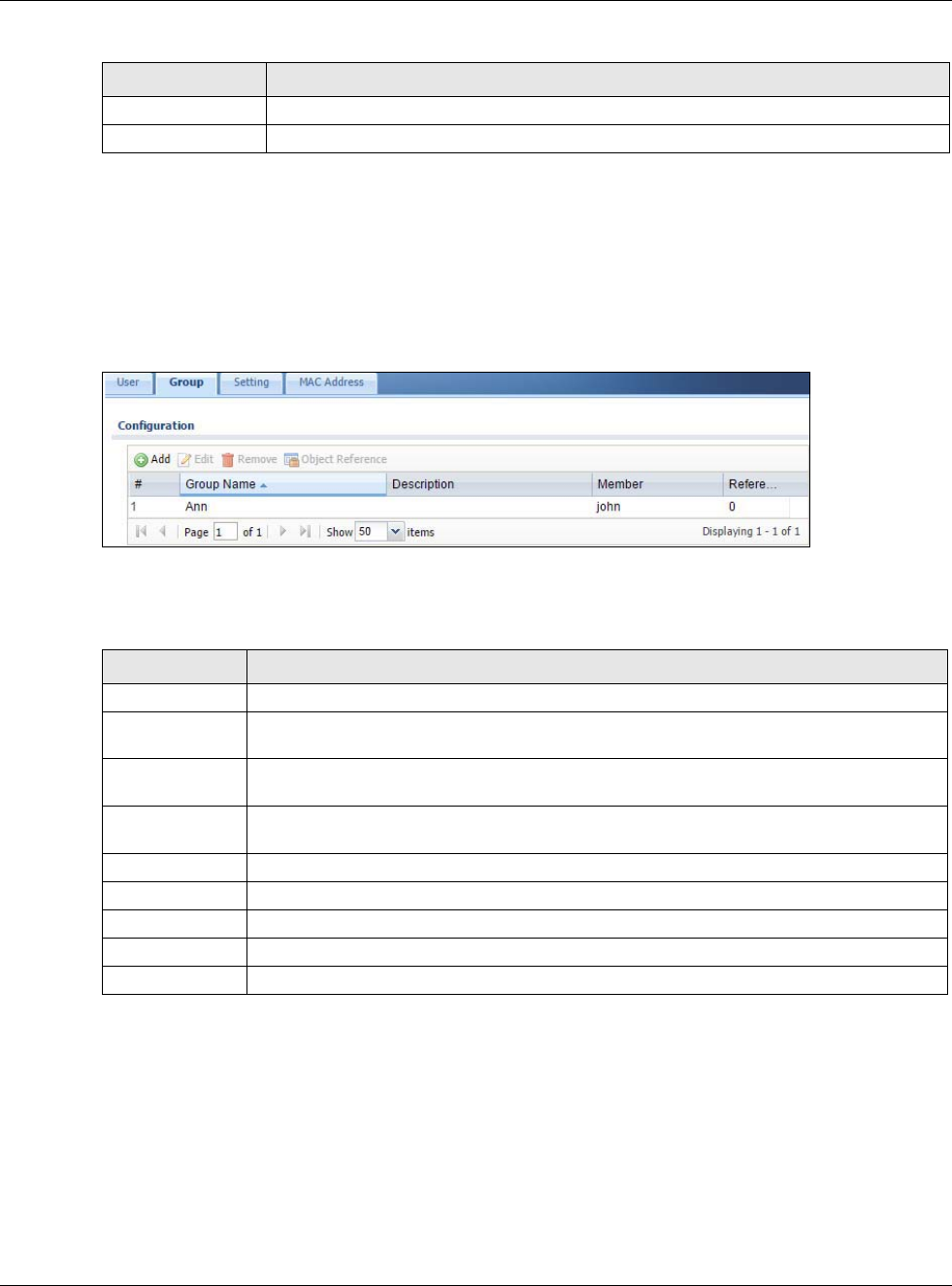
Chapter 29 Object
USG20(W)-VPN Series User’s Guide
460
29.2.3 User/Group Group Summary Screen
User groups consist of access users and other user groups. You cannot put admin users in user
groups. The Group screen provides a summary of all user groups. In addition, this screen allows
you to add, edit, and remove user groups. To access this screen, login to the Web Configurator, and
click Configuration > Object > User/Group > Group.
Figure 309 Configuration > Object > User/Group > Group
The following table describes the labels in this screen. See Section 29.2.3.1 on page 460 for more
information as well.
29.2.3.1 Group Add/Edit Screen
The Group Add/Edit screen allows you to create a new user group or edit an existing one. To
access this screen, go to the Group screen (see Section 29.2.3 on page 460), and click either the
Add icon or an Edit icon.
OK Click OK to save your changes back to the USG.
Cancel Click Cancel to exit this screen without saving your changes.
Table 180 Configuration > Object > User/Group > User > Add (continued)
LABEL DESCRIPTION
Table 181 Configuration > Object > User/Group > Group
LABEL DESCRIPTION
Add Click this to create a new entry.
Edit Double-click an entry or select it and click Edit to open a screen where you can modify the
entry’s settings.
Remove To remove an entry, select it and click Remove. The USG confirms you want to remove it
before doing so. Removing a group does not remove the user accounts in the group.
Object
References
Select an entry and click Object References to open a screen that shows which settings
use the entry.
# This field is a sequential value, and it is not associated with a specific user group.
Group Name This field displays the name of each user group.
Description This field displays the description for each user group.
Member This field lists the members in the user group. Each member is separated by a comma.
Reference This displays the number of times an object reference is used in a profile.
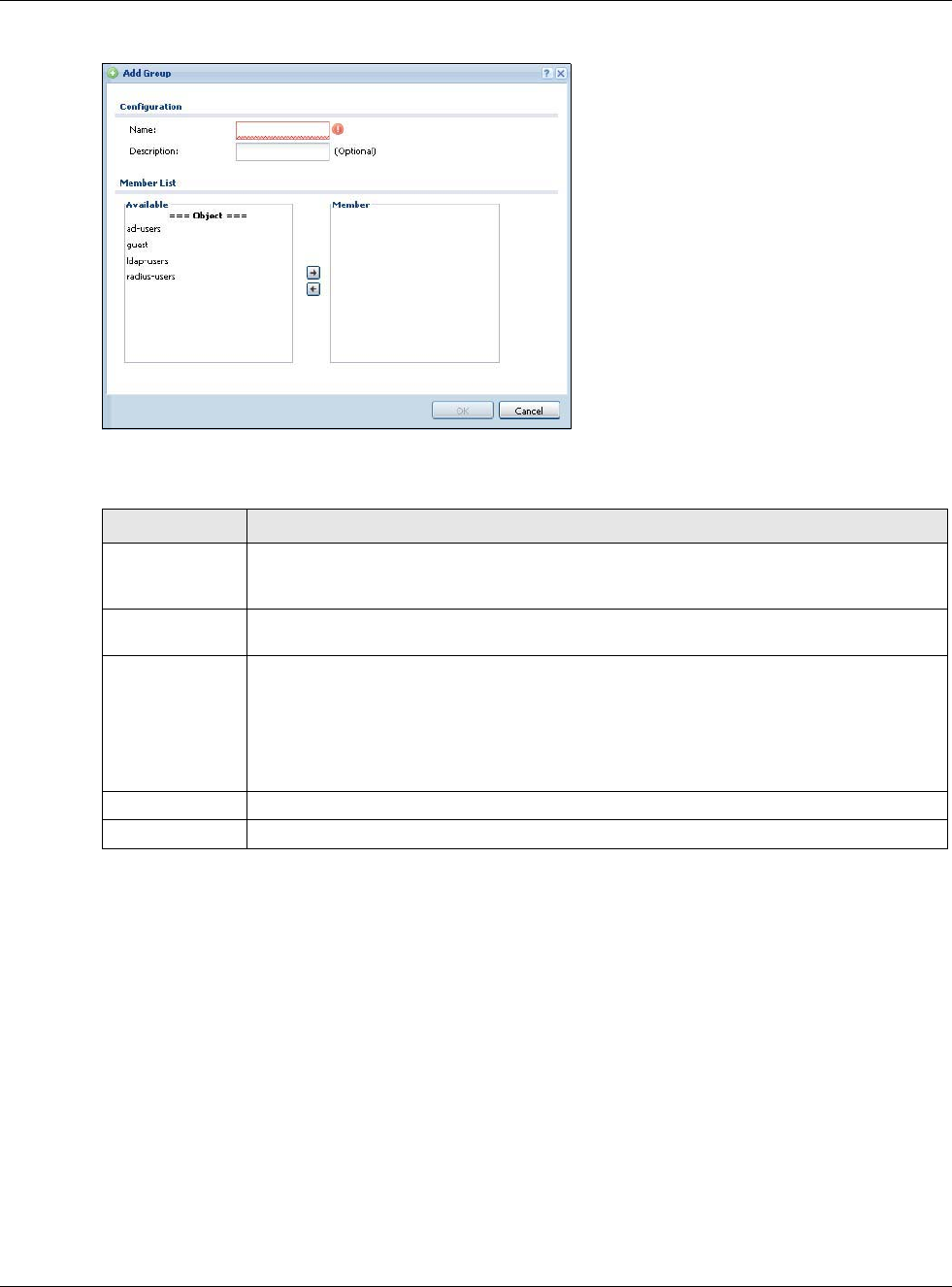
Chapter 29 Object
USG20(W)-VPN Series User’s Guide
461
Figure 310 Configuration > Object > User/Group > Group > Add
The following table describes the labels in this screen.
29.2.4 User/Group Setting Screen
The Setting screen controls default settings, login settings, lockout settings, and other user
settings for the USG. You can also use this screen to specify when users must log in to the USG
before it routes traffic for them.
To access this screen, login to the Web Configurator, and click Configuration > Object > User/
Group > Setting.
Table 182 Configuration > Object > User/Group > Group > Add
LABEL DESCRIPTION
Name Type the name for this user group. You may use 1-31 alphanumeric characters,
underscores(_), or dashes (-), but the first character cannot be a number. This value is
case-sensitive. User group names have to be different than user names.
Description Enter the description of the user group, if any. You can use up to 60 characters,
punctuation marks, and spaces.
Member List The Member list displays the names of the users and user groups that have been added
to the user group. The order of members is not important. Select users and groups from
the Available list that you want to be members of this group and move them to the
Member list. You can double-click a single entry to move it or use the [Shift] or [Ctrl] key
to select multiple entries and use the arrow button to move them.
Move any members you do not want included to the Available list.
OK Click OK to save your changes back to the USG.
Cancel Click Cancel to exit this screen without saving your changes.
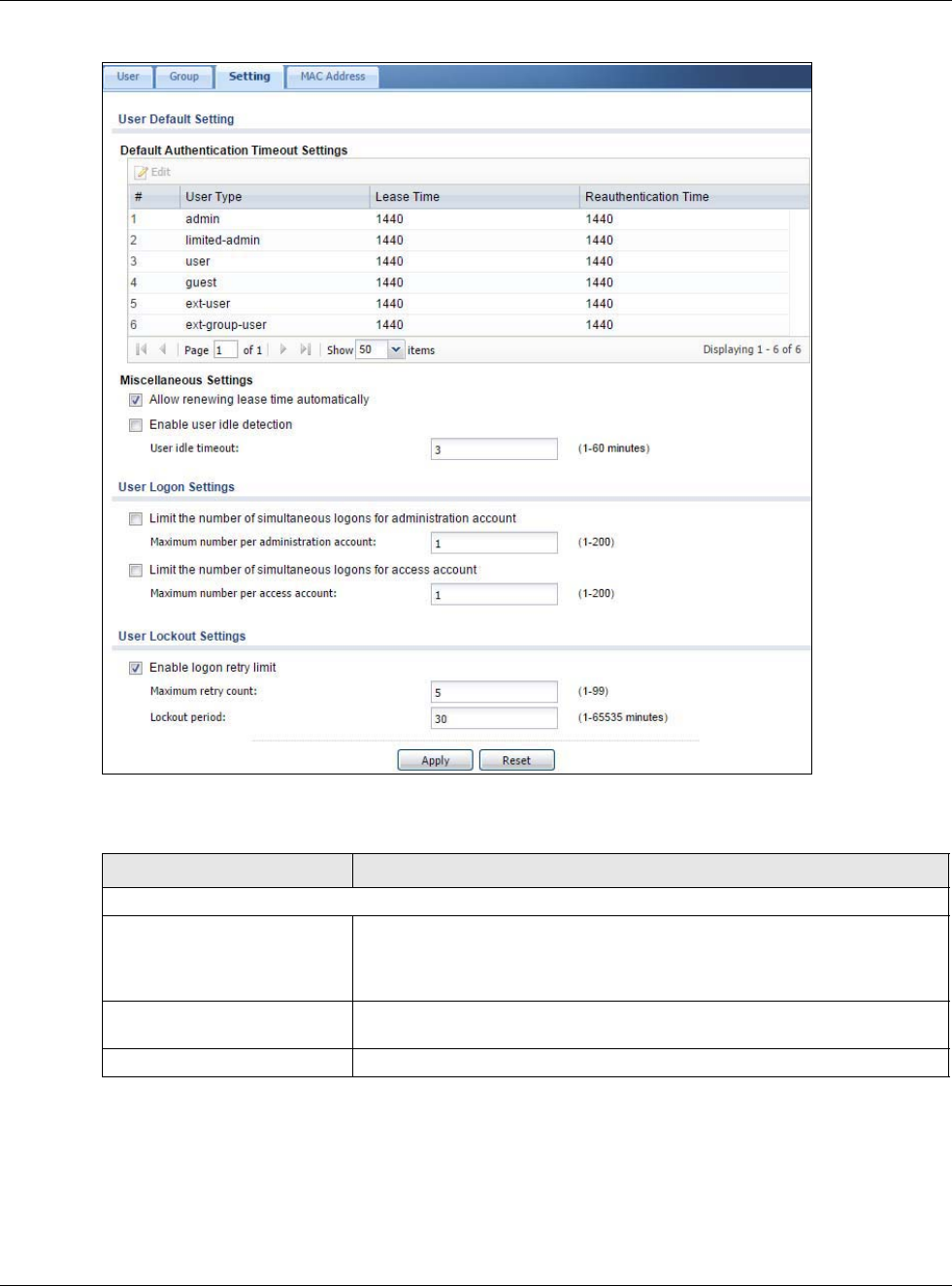
Chapter 29 Object
USG20(W)-VPN Series User’s Guide
462
Figure 311 Configuration > Object > User/Group > Setting
The following table describes the labels in this screen.
Table 183 Configuration > Object > User/Group > Setting
LABEL DESCRIPTION
User Authentication Timeout Settings
Default Authentication
Timeout Settings
These authentication timeout settings are used by default when you create a
new user account. They also control the settings for any existing user
accounts that are set to use the default settings. You can still manually
configure any user account’s authentication timeout settings.
Edit Double-click an entry or select it and click Edit to open a screen where you
can modify the entry’s settings.
# This field is a sequential value, and it is not associated with a specific entry.

Chapter 29 Object
USG20(W)-VPN Series User’s Guide
463
User Type These are the kinds of user account the USG supports.
•admin - this user can look at and change the configuration of the USG
•limited-admin - this user can look at the configuration of the USG but
not to change it
•user - this user has access to the USG’s services but cannot look at the
configuration
•guest - this user has access to the USG’s services but cannot look at the
configuration
•ext-user - this user account is maintained in a remote server, such as
RADIUS or LDAP. See Ext-User Accounts on page 455 for more
information about this type.
•ext-group-user - this user account is maintained in a remote server,
such as RADIUS or LDAP. See Ext-Group-User Accounts on page 456 for
more information about this type.
Lease Time This is the default lease time in minutes for each type of user account. It
defines the number of minutes the user has to renew the current session
before the user is logged out.
Admin users renew the session every time the main screen refreshes in the
Web Configurator. Access users can renew the session by clicking the
Renew button on their screen. If you allow access users to renew time
automatically (see Section 29.2.4 on page 461), the users can select this
check box on their screen as well. In this case, the session is automatically
renewed before the lease time expires.
Reauthentication Time This is the default reauthentication time in minutes for each type of user
account. It defines the number of minutes the user can be logged into the
USG in one session before having to log in again. Unlike Lease Time, the
user has no opportunity to renew the session without logging out.
Miscellaneous Settings
Allow renewing lease time
automatically Select this check box if access users can renew lease time automatically, as
well as manually, simply by selecting the Updating lease time
automatically check box on their screen.
Enable user idle detection This is applicable for access users.
Select this check box if you want the USG to monitor how long each access
user is logged in and idle (in other words, there is no traffic for this access
user). The USG automatically logs out the access user once the User idle
timeout has been reached.
User idle timeout This is applicable for access users.
This field is effective when Enable user idle detection is checked. Type the
number of minutes each access user can be logged in and idle before the
USG automatically logs out the access user.
User Logon Settings
Limit the number of
simultaneous logons for
administration account
Select this check box if you want to set a limit on the number of
simultaneous logins by admin users. If you do not select this, admin users
can login as many times as they want at the same time using the same or
different IP addresses.
Maximum number per
administration account This field is effective when Limit ... for administration account is
checked. Type the maximum number of simultaneous logins by each admin
user.
Limit the number of
simultaneous logons for
access account
Select this check box if you want to set a limit on the number of
simultaneous logins by non-admin users. If you do not select this, access
users can login as many times as they want as long as they use different IP
addresses.
Maximum number per
access account This field is effective when Limit ... for access account is checked. Type
the maximum number of simultaneous logins by each access user.
Table 183 Configuration > Object > User/Group > Setting (continued)
LABEL DESCRIPTION
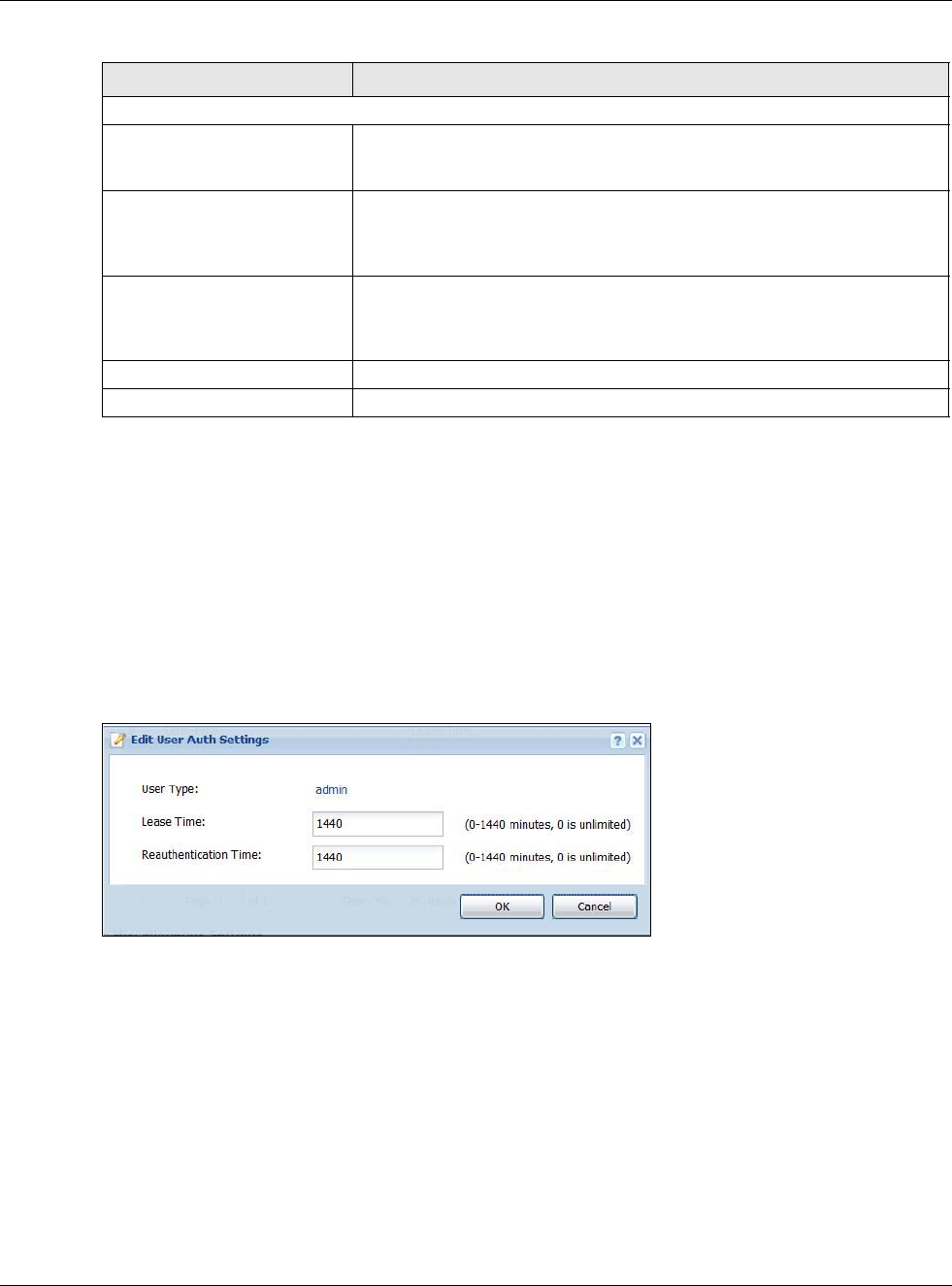
Chapter 29 Object
USG20(W)-VPN Series User’s Guide
464
29.2.4.1 Default User Authentication Timeout Settings Edit Screens
The Default Authentication Timeout Settings Edit screen allows you to set the default
authentication timeout settings for the selected type of user account. These default authentication
timeout settings also control the settings for any existing user accounts that are set to use the
default settings. You can still manually configure any user account’s authentication timeout
settings.
To access this screen, go to the Configuration > Object > User/Group > Setting screen (see
Section 29.2.4 on page 461), and click one of the Default Authentication Timeout Settings
section’s Edit icons.
Figure 312 Configuration > Object > User/Group > Setting > Edit
User Lockout Settings
Enable logon retry limit Select this check box to set a limit on the number of times each user can
login unsuccessfully (for example, wrong password) before the IP address is
locked out for a specified amount of time.
Maximum retry count This field is effective when Enable logon retry limit is checked. Type the
maximum number of times each user can login unsuccessfully before the IP
address is locked out for the specified lockout period. The number must be
between 1 and 99.
Lockout period This field is effective when Enable logon retry limit is checked. Type the
number of minutes the user must wait to try to login again, if logon retry
limit is enabled and the maximum retry count is reached. This number
must be between 1 and 65,535 (about 45.5 days).
Apply Click Apply to save the changes.
Reset Click Reset to return the screen to its last-saved settings.
Table 183 Configuration > Object > User/Group > Setting (continued)
LABEL DESCRIPTION
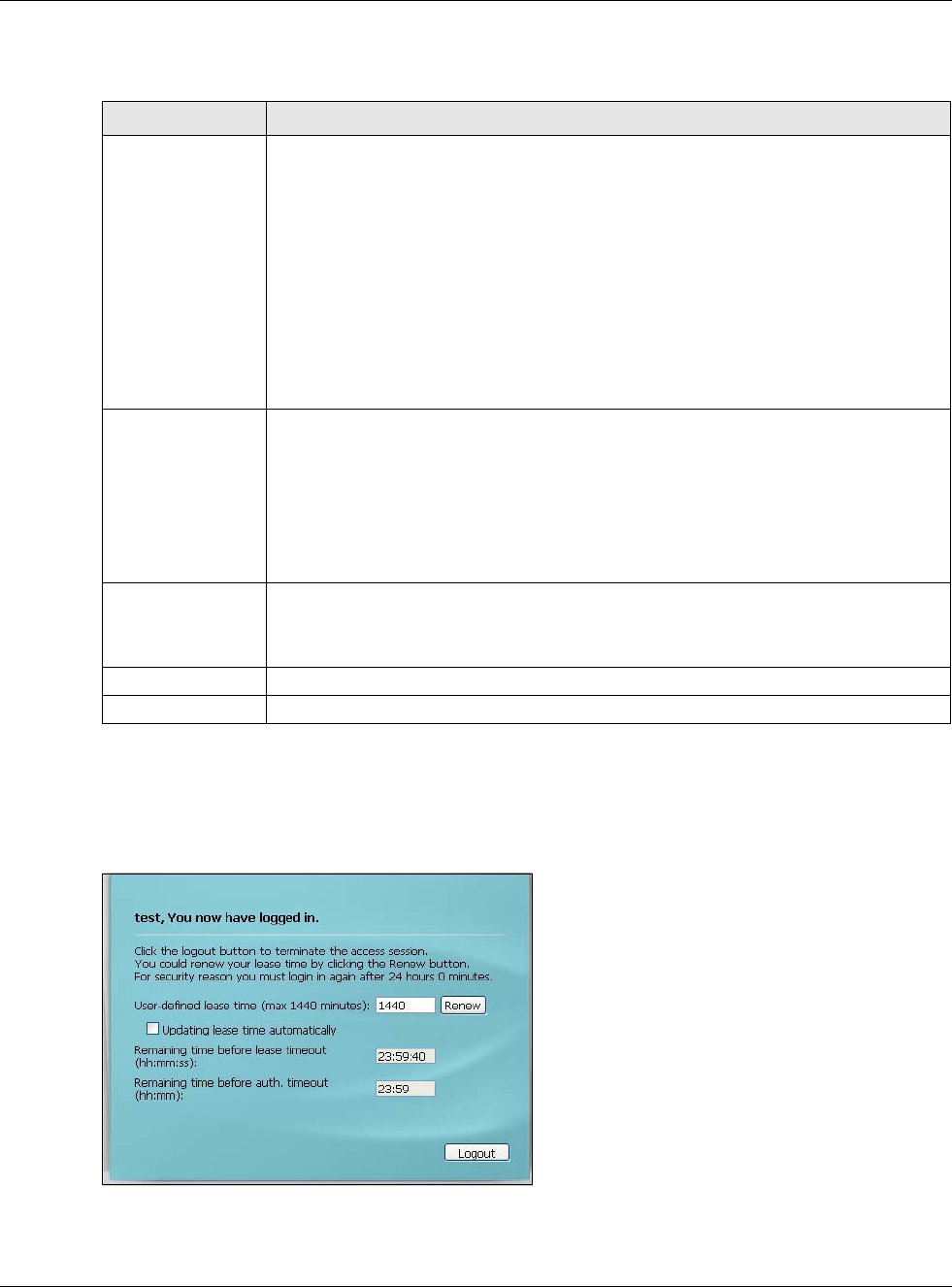
Chapter 29 Object
USG20(W)-VPN Series User’s Guide
465
The following table describes the labels in this screen.
29.2.4.2 User Aware Login Example
Access users cannot use the Web Configurator to browse the configuration of the USG. Instead,
after access users log into the USG, the following screen appears.
Figure 313 Web Configurator for Non-Admin Users
Table 184 Configuration > Object > User/Group > Setting > Edit
LABEL DESCRIPTION
User Type This read-only field identifies the type of user account for which you are configuring the
default settings.
•admin - this user can look at and change the configuration of the USG
•limited-admin - this user can look at the configuration of the USG but not to
change it.
•user - this user has access to the USG’s services but cannot look at the
configuration.
•guest - this user has access to the USG’s services but cannot look at the
configuration.
•ext-user - this user account is maintained in a remote server, such as RADIUS or
LDAP. See Ext-User Accounts on page 455 for more information about this type.
•ext-group-user - this user account is maintained in a remote server, such as
RADIUS or LDAP. See Ext-Group-User Accounts on page 456 for more information
about this type.
Lease Time Enter the number of minutes this type of user account has to renew the current session
before the user is logged out. You can specify 1 to 1440 minutes. You can enter 0 to
make the number of minutes unlimited.
Admin users renew the session every time the main screen refreshes in the Web
Configurator. Access users can renew the session by clicking the Renew button on their
screen. If you allow access users to renew time automatically (see Section 29.2.4 on
page 461), the users can select this check box on their screen as well. In this case, the
session is automatically renewed before the lease time expires.
Reauthentication
Time
Type the number of minutes this type of user account can be logged into the USG in one
session before the user has to log in again. You can specify 1 to 1440 minutes. You can
enter 0 to make the number of minutes unlimited. Unlike Lease Time, the user has no
opportunity to renew the session without logging out.
OK Click OK to save your changes back to the USG.
Cancel Click Cancel to exit this screen without saving your changes.
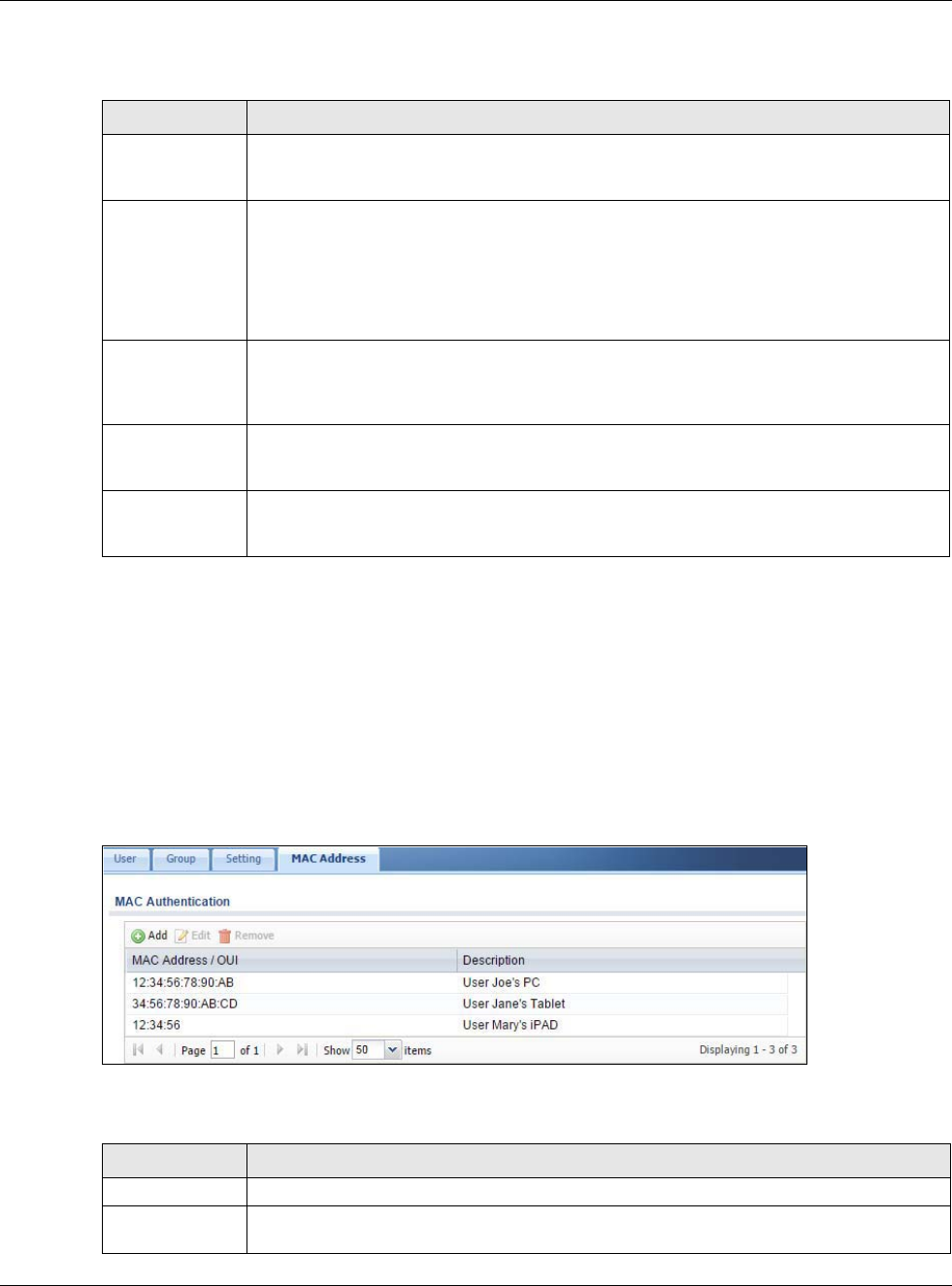
Chapter 29 Object
USG20(W)-VPN Series User’s Guide
466
The following table describes the labels in this screen.
29.2.5 User/Group MAC Address Summary Screen
This screen shows the MAC addresses of wireless clients, which can be authenticated by their MAC
addresses using the local user database. Click Configuration > Object > User/Group > MAC
Address to open this screen.
Note: You need to configure an SSID security profile’s MAC authentication settings to
have the AP use the USG’s local database to authenticate wireless clients by their
MAC addresses.
Figure 314 Configuration > Object > User/Group > MAC Address
The following table describes the labels in this screen.
Table 185 Web Configurator for Non-Admin Users
LABEL DESCRIPTION
User-defined
lease time (max
... minutes)
Access users can specify a lease time shorter than or equal to the one that you specified.
The default value is the lease time that you specified.
Renew Access users can click this button to reset the lease time, the amount of time remaining
before the USG automatically logs them out. The USG sets this amount of time according
to the
•User-defined lease time field in this screen
•Lease time field in the User Add/Edit screen (see Section 29.2.5.1 on page 467)
•Lease time field in the Setting screen (see Section 29.2.4 on page 461)
Updating lease
time
automatically
This box appears if you checked the Allow renewing lease time automatically box in
the Setting screen. (See Section 29.2.4 on page 461.) Access users can select this check
box to reset the lease time automatically 30 seconds before it expires. Otherwise, access
users have to click the Renew button to reset the lease time.
Remaining time
before lease
timeout
This field displays the amount of lease time that remains, though the user might be able to
reset it.
Remaining time
before auth.
timeout
This field displays the amount of time that remains before the USG automatically logs the
access user out, regardless of the lease time.
Table 186 Configuration > Object > User/Group > MAC Address
LABEL DESCRIPTION
Add Click this to create a new entry.
Edit Double-click an entry or select it and click Edit to open a screen where you can modify the
entry’s settings.
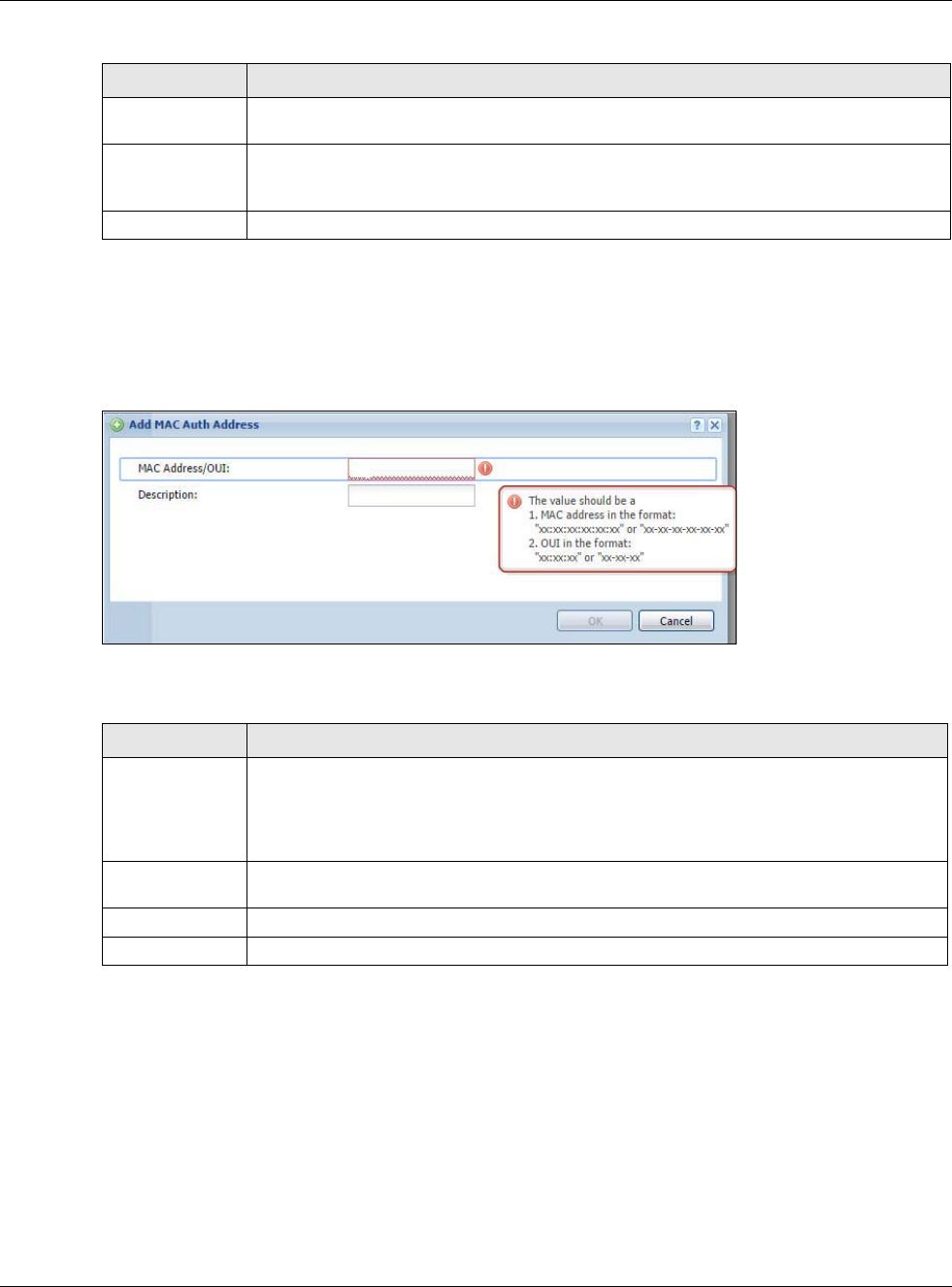
Chapter 29 Object
USG20(W)-VPN Series User’s Guide
467
29.2.5.1 MAC Address Add/Edit Screen
This screen allows you to create a new allowed device or edit an existing one. To access this screen,
go to the MAC Address screen (see Section 29.2.5 on page 466), and click either the Add icon or
an Edit icon.
Figure 315 Configuration > Object > User/Group > MAC Address > Add
The following table describes the labels in this screen.
29.2.6 User /Group Technical Reference
This section provides some information on users who use an external authentication server in order
to log in.
Remove To remove an entry, select it and click Remove. The USG confirms you want to remove it
before doing so.
MAC Address/
OUI
This field displays the MAC address or OUI (Organizationally Unique Identifier of computer
hardware manufacturers) of wireless clients using MAC authentication with the USG local
user database.
Description This field displays a description of the device identified by the MAC address or OUI.
Table 186 Configuration > Object > User/Group > MAC Address (continued)
LABEL DESCRIPTION
Table 187 Configuration > Object > User/Group > MAC Address > Add
LABEL DESCRIPTION
MAC Address/
OUI
Type the MAC address (six hexadecimal number pairs separated by colons or hyphens) or
OUI (three hexadecimal number pairs separated by colons or hyphens) to identify specific
wireless clients for MAC authentication using the USG local user database. The OUI is the
first three octets in a MAC address and uniquely identifies the manufacturer of a network
device.
Description Enter an optional description of the wireless device(s) identified by the MAC or OUI. You
can use up to 60 characters, punctuation marks, and spaces.
OK Click OK to save your changes back to the USG.
Cancel Click Cancel to exit this screen without saving your changes.
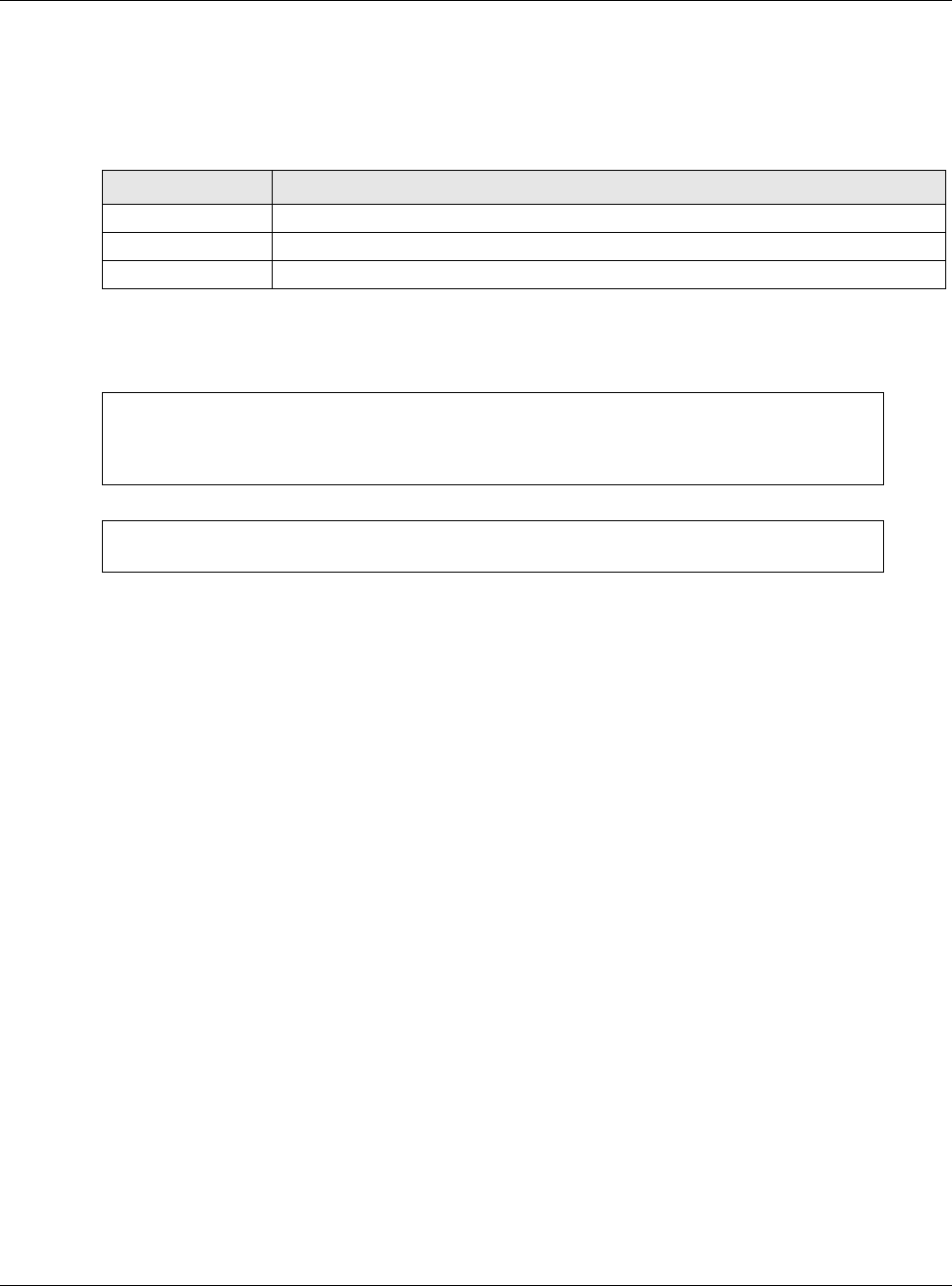
Chapter 29 Object
USG20(W)-VPN Series User’s Guide
468
Setting up User Attributes in an External Server
To set up user attributes, such as reauthentication time, in LDAP or RADIUS servers, use the
following keywords in the user configuration file.
The following examples show you how you might set up user attributes in LDAP and RADIUS
servers.
Creating a Large Number of Ext-User Accounts
If you plan to create a large number of Ext-User accounts, you might use CLI commands, instead
of the Web Configurator, to create the accounts. Extract the user names from the LDAP or RADIUS
server, and create a shell script that creates the user accounts.
29.3 AP Profile Overview
This section shows you how to configure preset profiles for the Access Points (APs) connected to
your USG’s wireless network.
•The Radio screen (Section 29.3.1 on page 469) creates radio configurations that can be used by
the APs.
•The SSID screen (Section 29.3.2 on page 475) configures three different types of profiles for
your networked APs.
29.3.0.1 What You Need To Know
The following terms and concepts may help as you read this section.
Wireless Profiles
At the heart of all wireless AP configurations on the USG are profiles. A profile represents a group of
saved settings that you can use across any number of connected APs. You can set up the following
wireless profile types:
Table 188 LDAP/RADIUS: Keywords for User Attributes
KEYWORD CORRESPONDING ATTRIBUTE IN WEB CONFIGURATOR
type User Type. Possible Values: admin, limited-admin, user, guest.
leaseTime Lease Time. Possible Values: 1-1440 (minutes).
reauthTime Reauthentication Time. Possible Values: 1-1440 (minutes).
Figure 316 LDAP Example: Keywords for User Attributes
type: admin
leaseTime: 99
reauthTime: 199
Figure 317 RADIUS Example: Keywords for User Attributes
type=user;leaseTime=222;reauthTime=222

Chapter 29 Object
USG20(W)-VPN Series User’s Guide
469
•Radio - This profile type defines the properties of an AP’s radio transmitter. You can have a
maximum of 32 radio profiles on the USG.
•SSID - This profile type defines the properties of a single wireless network signal broadcast by
an AP. Each radio on a single AP can broadcast up to 8 SSIDs. You can have a maximum of 32
SSID profiles on the USG.
•Security - This profile type defines the security settings used by a single SSID. It controls the
encryption method required for a wireless client to associate itself with the SSID. You can have a
maximum of 32 security profiles on the USG.
•MAC Filtering - This profile provides an additional layer of security for an SSID, allowing you to
block access or allow access to that SSID based on wireless client MAC addresses. If a client’s
MAC address is on the list, then it is either allowed or denied, depending on how you set up the
MAC Filter profile. You can have a maximum of 32 MAC filtering profiles on the USG.
SSID
The SSID (Service Set IDentifier) is the name that identifies the Service Set with which a wireless
station is associated. Wireless stations associating to the access point (AP) must have the same
SSID. In other words, it is the name of the wireless network that clients use to connect to it.
WEP
WEP (Wired Equivalent Privacy) encryption scrambles all data packets transmitted between the AP
and the wireless stations associated with it in order to keep network communications private. Both
the wireless stations and the access points must use the same WEP key for data encryption and
decryption.
WPA and WPA2
Wi-Fi Protected Access (WPA) is a subset of the IEEE 802.11i standard. WPA2 (IEEE 802.11i) is a
wireless security standard that defines stronger encryption, authentication and key management
than WPA. Key differences between WPA(2) and WEP are improved data encryption and user
authentication.
IEEE 802.1x
The IEEE 802.1x standard outlines enhanced security methods for both the authentication of
wireless stations and encryption key management. Authentication is done using an external
RADIUS server.
29.3.1 Radio Screen
This screen allows you to create radio profiles for the APs on your network. A radio profile is a list of
settings that the built-in AP can use to configure its radio transmitters. To access this screen click
Configuration > Object > AP Profile.
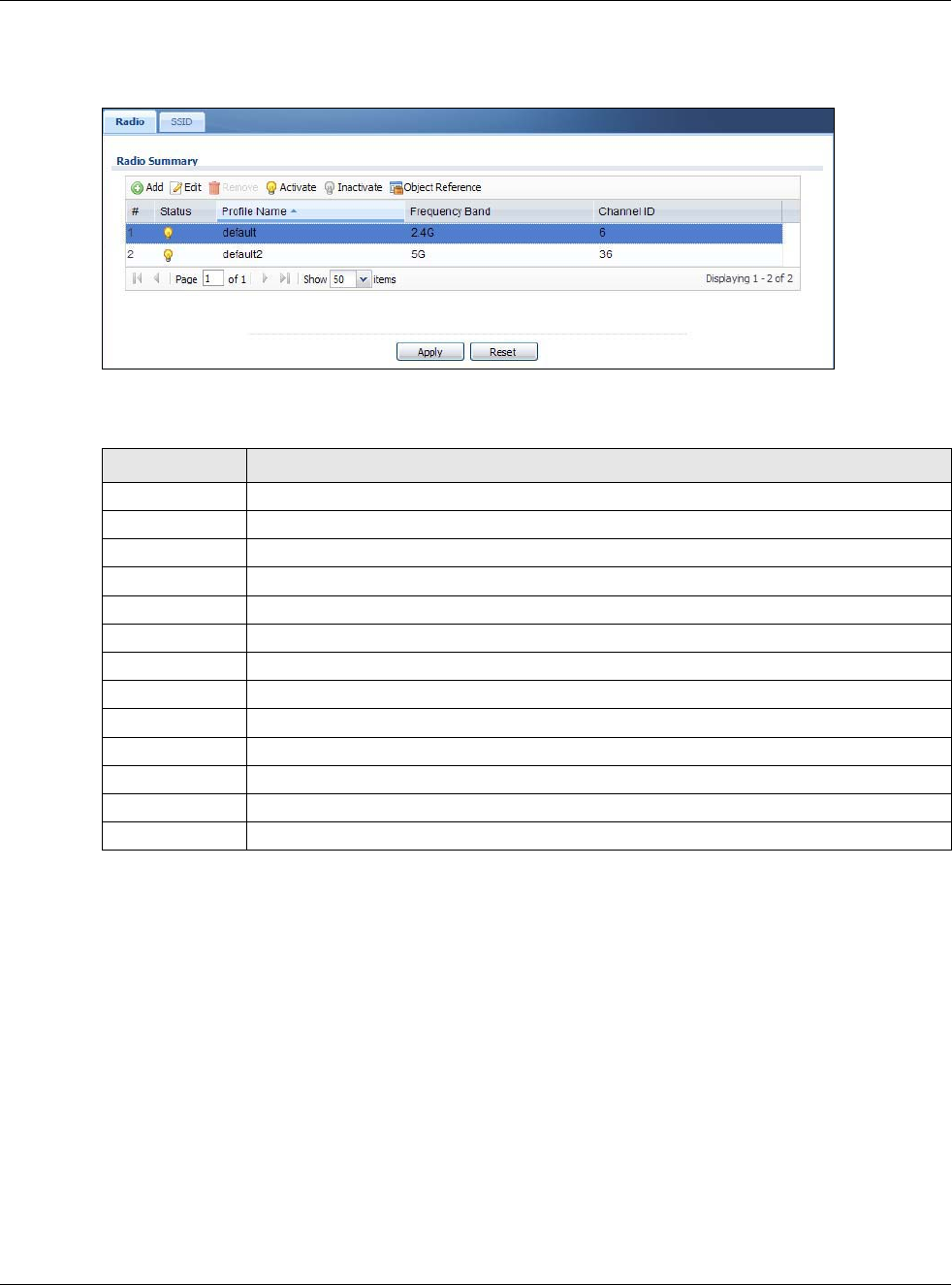
Chapter 29 Object
USG20(W)-VPN Series User’s Guide
470
Note: You can have a maximum of 32 radio profiles on the USG.
Figure 318 Configuration > Object > AP Profile > Radio
The following table describes the labels in this screen.
Table 189 Configuration > Object > AP Profile > Radio
LABEL DESCRIPTION
Add Click this to add a new radio profile.
Edit Click this to edit the selected radio profile.
Remove Click this to remove the selected radio profile.
Activate To turn on an entry, select it and click Activate.
Inactivate To turn off an entry, select it and click Inactivate.
Object Reference Click this to view which other objects are linked to the selected radio profile.
# This field is a sequential value, and it is not associated with a specific profile.
Status This icon is lit when the entry is active and dimmed when the entry is inactive.
Profile Name This field indicates the name assigned to the radio profile.
Frequency Band This field indicates the frequency band which this radio profile is configured to use.
Channel ID This field indicates the broadcast channel which this radio profile is configured to use.
Apply Click Apply to save your changes back to the USG.
Reset Click Reset to return the screen to its last-saved settings.
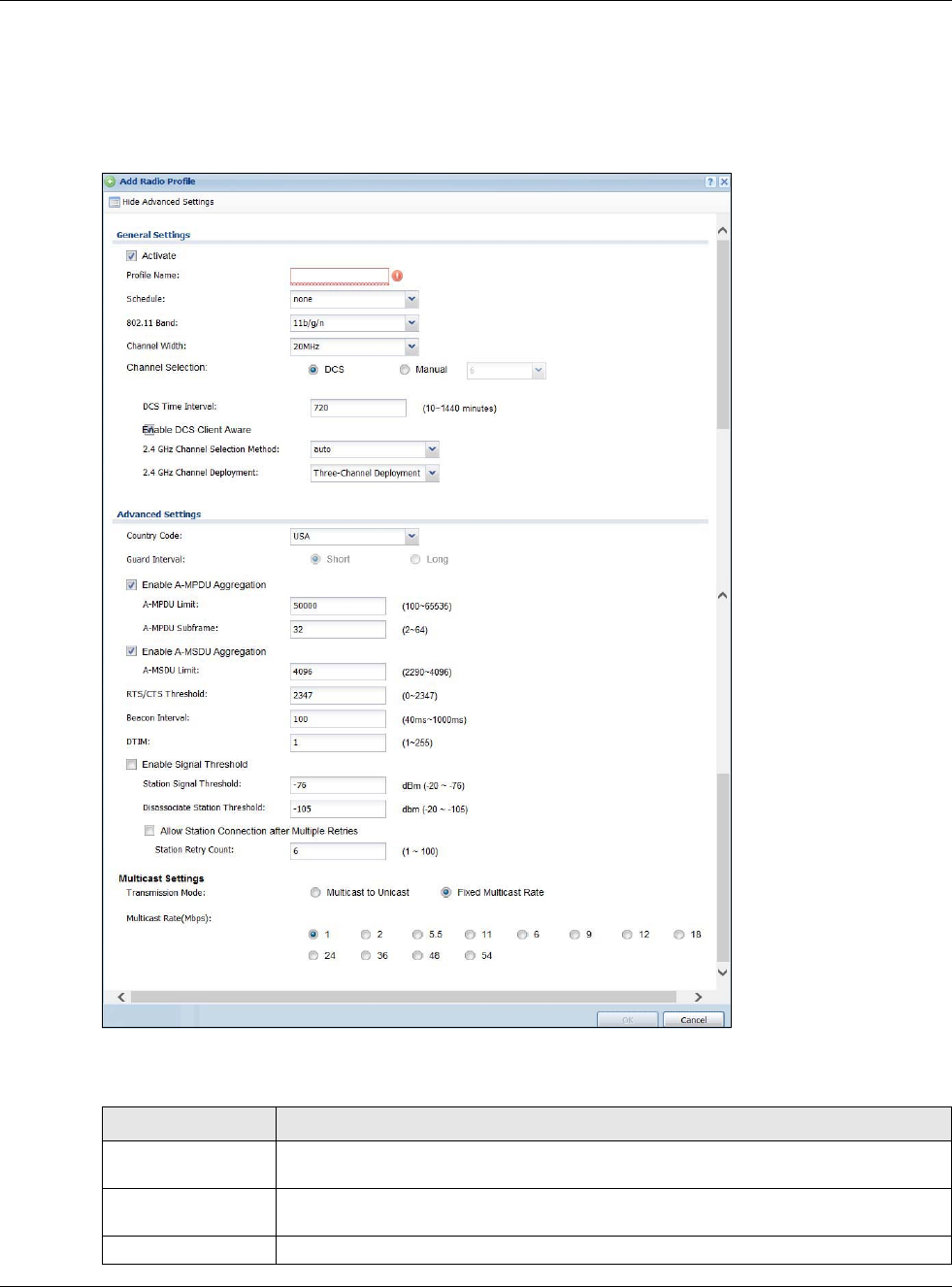
Chapter 29 Object
USG20(W)-VPN Series User’s Guide
471
29.3.1.1 Add/Edit Radio Profile
This screen allows you to create a new radio profile or edit an existing one. To access this screen,
click the Add button or select a radio profile from the list and click the Edit button.
Figure 319 Configuration > Object > AP Profile > Add/Edit Radio Profile
The following table describes the labels in this screen.
Table 190 Configuration > Object > AP Profile > Add/Edit Radio Profile
LABEL DESCRIPTION
Hide / Show
Advanced Settings
Click this to hide or show the Advanced Settings in this window.
Create New Object Select an item from this menu to create a new object of that type. Any objects created
in this way are automatically linked to this radio profile.
General Settings

Chapter 29 Object
USG20(W)-VPN Series User’s Guide
472
Activate Select this option to make this profile active.
Profile Name Enter up to 31 alphanumeric characters to be used as this profile’s name. Spaces and
underscores are allowed.
802.11 Band Select the wireless band which this radio profile should use.
2.4 GHz is the frequency used by IEEE 802.11b/g/n wireless clients.
5 GHz is the frequency used by IEEE 802.11ac/a/n wireless clients.
Channel Width Select the wireless channel bandwidth you want the AP to use.
A standard 20 MHz channel offers transfer speeds of up to 217Mbps (2.4GHz) or
217Mbps (5GHZ) whereas a 40MHz channel uses two standard channels and offers
speeds of up to 450Mbps (2.4GHz) or 450Mbps (5GHZ). An IEEE 802.11ac-specific
80MHz channel offers speeds of up to 1.3Gbps.
40 MHz (channel bonding or dual channel) bonds two adjacent radio channels to
increase throughput. A 80 MHz channel consists of two adjacent 40 MHz channels. The
wireless clients must also support 40 MHz or 80 MHz. It is often better to use the 20
MHz setting in a location where the environment hinders the wireless signal.
Because not all devices support 40 MHz and/or 80 MHz channels, select 20/40MHz or
20/40/80MHz to allow the AP to adjust the channel bandwidth automatically.
Select 20MHz if you want to lessen radio interference with other wireless devices in
your neighborhood or the wireless clients do not support channel bonding.
Channel
Selection Select the wireless channel which this radio profile should use.
Select DCS to have the AP automatically select the radio channel upon which it
broadcasts by scanning the area around it and determining what channels are
currently being used by other devices.
Select Manual and specify the channels the AP uses.
It is recommended that you choose the channel least in use by other APs in the region
where this profile will be implemented. This will reduce the amount of interference
between wireless clients and the AP to which this profile is assigned.
Some 5 GHz channels include the label indoor use only. These are for use with an
indoor AP only. Do not use them with an outdoor AP.
Note: If you change the country code later, Channel Selection is set to Manual
automatically.
DCS Time
Interval This field is available when you set Channel Selection to DCS.
Enter a number of minutes. This regulates how often the USG surveys the other APs
within its broadcast radius. If the channel on which it is currently broadcasting
suddenly comes into use by another AP, the USG will then dynamically select the next
available clean channel or a channel with lower interference.
Enable DCS
Client Aware This field is available when you set Channel Selection to DCS.
Select this to have the AP wait until all connected clients have disconnected before
switching channels.
If you disable this then the AP switches channels immediately regardless of any client
connections. In this instance, clients that are connected to the AP when it switches
channels are dropped.
Table 190 Configuration > Object > AP Profile > Add/Edit Radio Profile (continued)
LABEL DESCRIPTION

Chapter 29 Object
USG20(W)-VPN Series User’s Guide
473
2.4 GHz Channel
Selection Method This field is available when you set Channel Selection to DCS.
Select auto to have the AP search for available channels automatically in the 2.4 GHz
band. The available channels vary depending on what you select in the 2.4 GHz
Channel Deployment field.
Select manual and specify the channels the AP uses in the 2.4 GHz band.
Channel ID This field is available only when you set Channel Selection to DCS and set 2.4 GHz
Channel Selection Method to manual.
Select the check boxes of the channels that you want the AP to use.
2.4 GHz Channel
Deployment This field is available only when you set Channel Selection to DCS and set 2.4 GHz
Channel Selection Method to auto.
Select Three-Channel Deployment to limit channel switching to channels 1,6, and
11, the three channels that are sufficiently attenuated to have almost no impact on one
another. In other words, this allows you to minimize channel interference by limiting
channel-hopping to these three “safe” channels.
Select Four-Channel Deployment to limit channel switching to four channels.
Depending on the country domain, if the only allowable channels are 1-11 then the
USG uses channels 1, 4, 7, 11 in this configuration; otherwise, the USG uses channels
1, 5, 9, 13 in this configuration. Four channel deployment expands your pool of
possible channels while keeping the channel interference to a minimum.
Enable 5 GHz
DFS Aware This field is available only when you select 11a, 11a/n or 11ac in the 802.11 Band
field.
Select this if your APs are operating in an area known to have RADAR devices. This
allows the device to downgrade its frequency to below 5 GHz in the event a RADAR
signal is detected, thus preventing it from interfering with that signal.
Enabling this forces the AP to select a non-DFS channel.
5 GHz Channel
Selection Method This shows auto and allows the AP to search for available channels automatically in the
5 GHz band.
Advanced Settings
Country Code Select the country where the USG is located/installed.
The available channels vary depending on the country you selected. Be sure to select
the correct/same country for both radios on an AP and all connected APs, in order to
prevent roaming failure and interference to other systems.
Guard Interval This field is available only when the channel width is 20/40MHz or 20/40/80MHz.
Set the guard interval for this radio profile to either short or long.
The guard interval is the gap introduced between data transmission from users in order
to reduce interference. Reducing the interval increases data transfer rates but also
increases interference. Increasing the interval reduces data transfer rates but also
reduces interference.
Enable A-MPDU
Aggregation Select this to enable A-MPDU aggregation.
Message Protocol Data Unit (MPDU) aggregation collects Ethernet frames along with
their 802.11n headers and wraps them in a 802.11n MAC header. This method is useful
for increasing bandwidth throughput in environments that are prone to high error
rates.
A-MPDU Limit Enter the maximum frame size to be aggregated.
A-MPDU
Subframe Enter the maximum number of frames to be aggregated each time.
Table 190 Configuration > Object > AP Profile > Add/Edit Radio Profile (continued)
LABEL DESCRIPTION

Chapter 29 Object
USG20(W)-VPN Series User’s Guide
474
Enable A-MSDU
Aggregation Select this to enable A-MSDU aggregation.
Mac Service Data Unit (MSDU) aggregation collects Ethernet frames without any of
their 802.11n headers and wraps the header-less payload in a single 802.11n MAC
header. This method is useful for increasing bandwidth throughput. It is also more
efficient than A-MPDU except in environments that are prone to high error rates.
A-MSDU Limit Enter the maximum frame size to be aggregated.
RTS/CTS
Threshold Use RTS/CTS to reduce data collisions on the wireless network if you have wireless
clients that are associated with the same AP but out of range of one another. When
enabled, a wireless client sends an RTS (Request To Send) and then waits for a CTS
(Clear To Send) before it transmits. This stops wireless clients from transmitting
packets at the same time (and causing data collisions).
A wireless client sends an RTS for all packets larger than the number (of bytes) that
you enter here. Set the RTS/CTS equal to or higher than the fragmentation threshold
to turn RTS/CTS off.
Beacon Interval When a wirelessly networked device sends a beacon, it includes with it a beacon
interval. This specifies the time period before the device sends the beacon again. The
interval tells receiving devices on the network how long they can wait in low-power
mode before waking up to handle the beacon. A high value helps save current
consumption of the access point.
DTIM Delivery Traffic Indication Message (DTIM) is the time period after which broadcast and
multicast packets are transmitted to mobile clients in the Active Power Management
mode. A high DTIM value can cause clients to lose connectivity with the network. This
value can be set from 1 to 255.
Enable Signal
Threshold Select the check box to use the signal threshold to ensure wireless clients receive good
throughput. This allows only wireless clients with a strong signal to connect to the AP.
Clear the check box to not require wireless clients to have a minimum signal strength
to connect to the AP.
Station Signal
Threshold Set a minimum client signal strength. A wireless client is allowed to connect to the AP
only when its signal strength is stronger than the specified threshold.
-20 dBm is the strongest signal you can require and -76 is the weakest.
Disassociate
Station
Threshold
Set a minimum kick-off signal strength. When a wireless client’s signal strength is
lower than the specified threshold, the USG disconnects the wireless client from the AP.
-20 dBm is the strongest signal you can require and -90 is the weakest.
Allow Station
Connection after
Multiple Retries
Select this option to allow a wireless client to try to associate with the AP again after it
is disconnected due to weak signal strength.
Station Retry
Count Set the maximum number of times a wireless client can attempt to re-connect to the
AP.
Multicast Settings Use this section to set a transmission mode and maximum rate for multicast traffic.
Transmission
Mode Set how the AP handles multicast traffic.
Select Multicast to Unicast to broadcast wireless multicast traffic to all of the wireless
clients as unicast traffic. Unicast traffic dynamically changes the data rate based on the
application’s bandwidth requirements. The retransmit mechanism of unicast traffic
provides more reliable transmission of the multicast traffic, although it also produces
duplicate packets.
Select Fixed Multicast Rate to send wireless multicast traffic at a single data rate.
You must know the multicast application’s bandwidth requirements and set it in the
following field.
Multicast Rate
(Mbps) If you set the multicast transmission mode to fixed multicast rate, set the data rate for
multicast traffic here. For example, to deploy 4 Mbps video, select a fixed multicast
rate higher than 4 Mbps.
Table 190 Configuration > Object > AP Profile > Add/Edit Radio Profile (continued)
LABEL DESCRIPTION
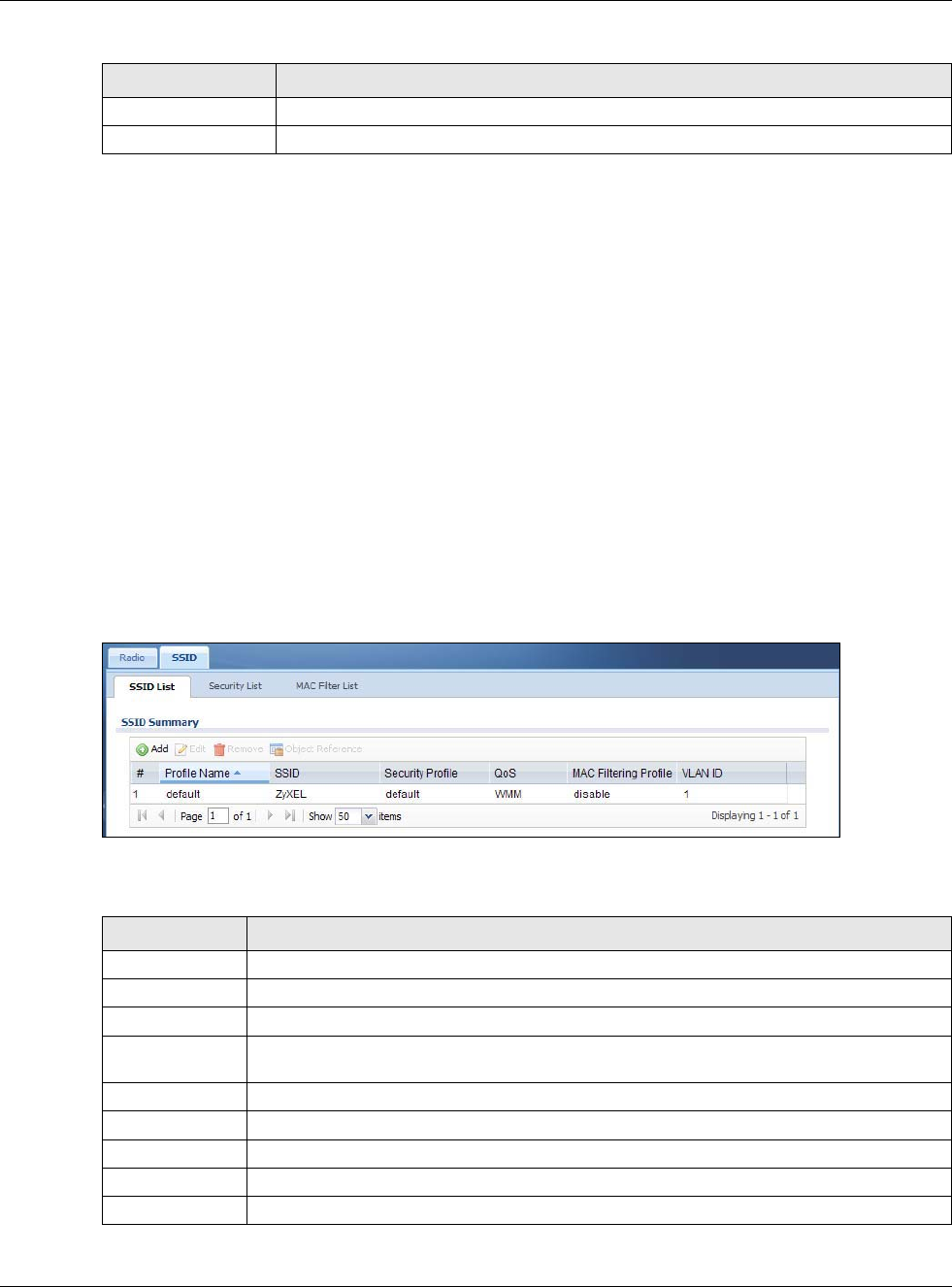
Chapter 29 Object
USG20(W)-VPN Series User’s Guide
475
29.3.2 SSID Screen
The SSID screens allow you to configure three different types of profiles for your networked APs: an
SSID list, which can assign specific SSID configurations to your APs; a security list, which can
assign specific encryption methods to the APs when allowing wireless clients to connect to them;
and a MAC filter list, which can limit connections to an AP based on wireless clients MAC addresses.
29.3.2.1 SSID List
This screen allows you to create and manage SSID configurations that can be used by the APs. An
SSID, or Service Set IDentifier, is basically the name of the wireless network to which a wireless
client can connect. The SSID appears as readable text to any device capable of scanning for
wireless frequencies (such as the WiFi adapter in a laptop), and is displayed as the wireless network
name when a person makes a connection to it.
To access this screen click Configuration > Object > AP Profile > SSID.
Note: You can have a maximum of 32 SSID profiles on the USG.
Figure 320 Configuration > Object > AP Profile > SSID > SSID List
The following table describes the labels in this screen.
OK Click OK to save your changes back to the USG.
Cancel Click Cancel to exit this screen without saving your changes.
Table 190 Configuration > Object > AP Profile > Add/Edit Radio Profile (continued)
LABEL DESCRIPTION
Table 191 Configuration > Object > AP Profile > SSID > SSID List
LABEL DESCRIPTION
Add Click this to add a new SSID profile.
Edit Click this to edit the selected SSID profile.
Remove Click this to remove the selected SSID profile.
Object Reference Click this to view which other objects are linked to the selected SSID profile (for example,
radio profile).
# This field is a sequential value, and it is not associated with a specific profile.
Profile Name This field indicates the name assigned to the SSID profile.
SSID This field indicates the SSID name as it appears to wireless clients.
Security Profile This field indicates which (if any) security profile is associated with the SSID profile.
QoS This field indicates the QoS type associated with the SSID profile.
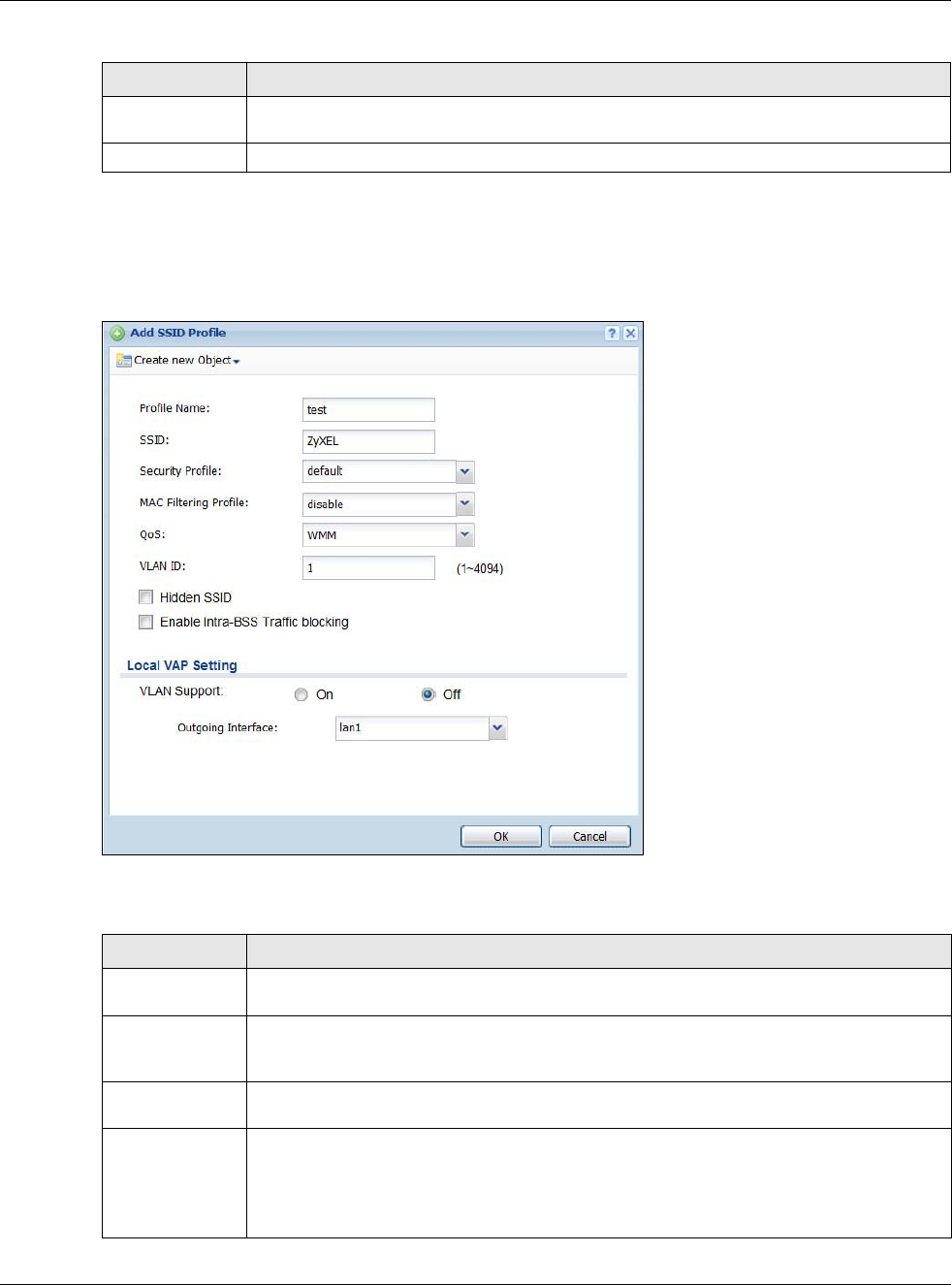
Chapter 29 Object
USG20(W)-VPN Series User’s Guide
476
29.3.2.2 Add/Edit SSID Profile
This screen allows you to create a new SSID profile or edit an existing one. To access this screen,
click the Add button or select an SSID profile from the list and click the Edit button.
Figure 321 Configuration > Object > AP Profile > SSID > Add/Edit SSID Profile
The following table describes the labels in this screen.
MAC Filtering
Profile
This field indicates which (if any) MAC Filter Profile is associated with the SSID profile.
VLAN ID This field indicates the VLAN ID associated with the SSID profile.
Table 191 Configuration > Object > AP Profile > SSID > SSID List (continued)
LABEL DESCRIPTION
Table 192 Configuration > Object > AP Profile > SSID > Add/Edit SSID Profile
LABEL DESCRIPTION
Create new
Object
Select an object type from the list to create a new one associated with this SSID profile.
Profile Name Enter up to 31 alphanumeric characters for the profile name. This name is only visible in
the Web Configurator and is only for management purposes. Spaces and underscores are
allowed.
SSID Enter the SSID name for this profile. This is the name visible on the network to wireless
clients. Enter up to 32 characters, spaces and underscores are allowed.
Security Profile Select a security profile from this list to associate with this SSID. If none exist, you can use
the Create new Object menu to create one.
Note: It is highly recommended that you create security profiles for all of your SSIDs to
enhance your network security.

Chapter 29 Object
USG20(W)-VPN Series User’s Guide
477
MAC Filtering
Profile
Select a MAC filtering profile from the list to associate with this SSID. If none exist, you can
use the Create new Object menu to create one.
MAC filtering allows you to limit the wireless clients connecting to your network through a
particular SSID by wireless client MAC addresses. Any clients that have MAC addresses not
in the MAC filtering profile of allowed addresses are denied connections.
The disable setting means no MAC filtering is used.
QoS Select a Quality of Service (QoS) access category to associate with this SSID. Access
categories minimize the delay of data packets across a wireless network. Certain
categories, such as video or voice, are given a higher priority due to the time sensitive
nature of their data packets.
QoS access categories are as follows:
disable: Turns off QoS for this SSID. All data packets are treated equally and not tagged
with access categories.
WMM: Enables automatic tagging of data packets. The USG assigns access categories to
the SSID by examining data as it passes through it and making a best guess effort. If
something looks like video traffic, for instance, it is tagged as such.
WMM_VOICE: All wireless traffic to the SSID is tagged as voice data. This is
recommended if an SSID is used for activities like placing and receiving VoIP phone calls.
WMM_VIDEO: All wireless traffic to the SSID is tagged as video data. This is
recommended for activities like video conferencing.
WMM_BEST_EFFORT: All wireless traffic to the SSID is tagged as “best effort,” meaning
the data travels the best route it can without displacing higher priority traffic. This is good
for activities that do not require the best bandwidth throughput, such as surfing the
Internet.
WMM_BACKGROUND: All wireless traffic to the SSID is tagged as low priority or
“background traffic”, meaning all other access categories take precedence over this one. If
traffic from an SSID does not have strict throughput requirements, then this access
category is recommended. For example, an SSID that only has network printers connected
to it.
VLAN ID Enter the VLAN ID that will be used to tag all traffic originating from this SSID if the VLAN
is different from the native VLAN.
Hidden SSID Select this if you want to “hide” your SSID from wireless clients. This tells any wireless
clients in the vicinity of the AP using this SSID profile not to display its SSID name as a
potential connection. Not all wireless clients respect this flag and display it anyway.
When an SSID is “hidden” and a wireless client cannot see it, the only way you can connect
to the SSID is by manually entering the SSID name in your wireless connection setup
screen(s) (these vary by client, client connectivity software, and operating system).
Enable Intra-BSS
Traffic Blocking
Select this option to prevent crossover traffic from within the same SSID.
Local VAP
Setting
This part of the screen only applies to USG models that have built-in wireless functionality
(AP) - see Table 1 on page 18.
VLAN Support Select On to have the USG assign the VLAN ID listed in the top part of the screen to the
built-in AP.
Select Off to have the USG ignore the VLAN ID listed in the top part of the screen. Select
an Outgoing Interface to have the USG assign an IP address in the same subnet as the
selected interface to the built-in AP.
OK Click OK to save your changes back to the USG.
Cancel Click Cancel to exit this screen without saving your changes.
Table 192 Configuration > Object > AP Profile > SSID > Add/Edit SSID Profile (continued)
LABEL DESCRIPTION
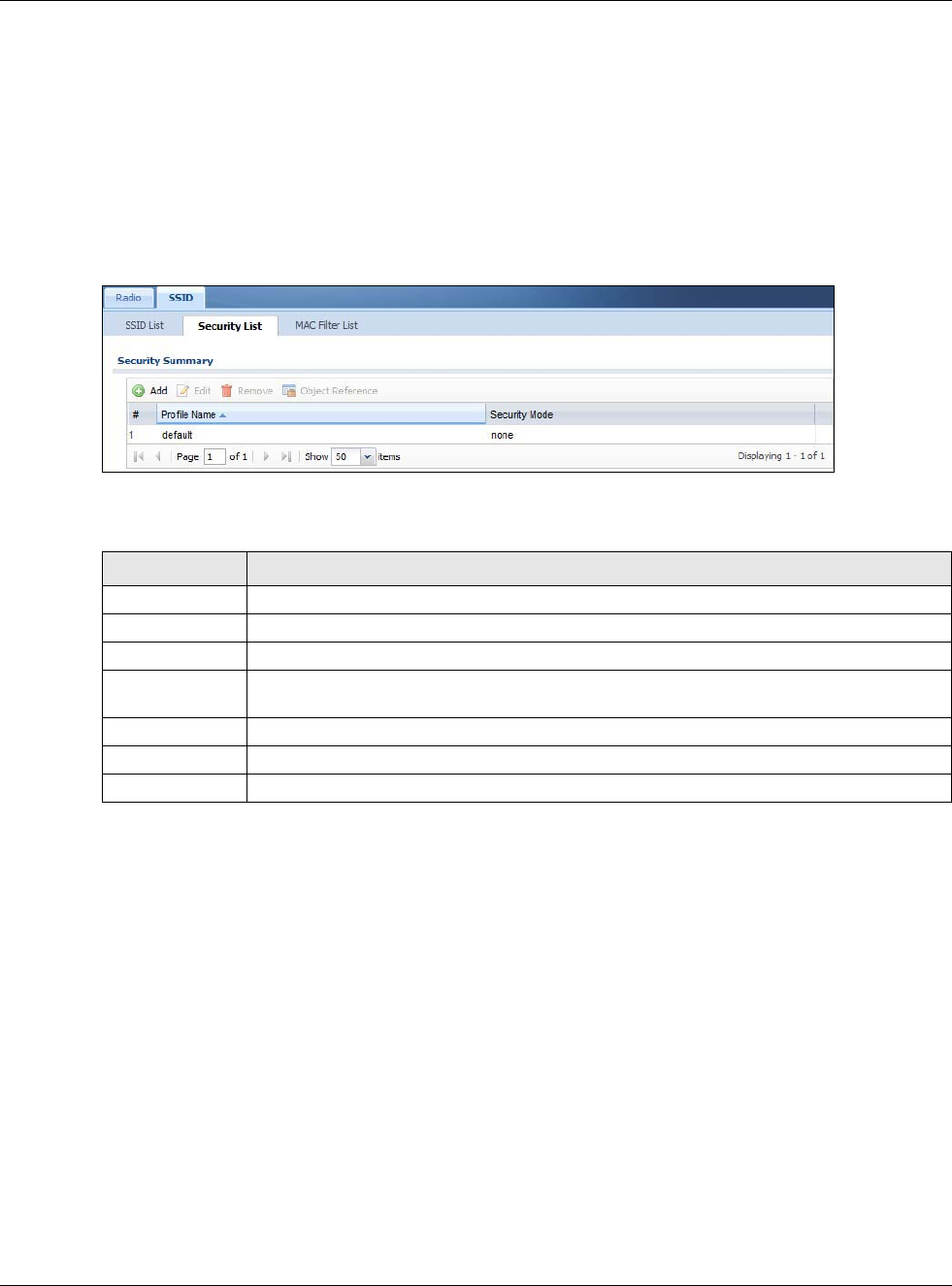
Chapter 29 Object
USG20(W)-VPN Series User’s Guide
478
29.3.2.3 Security List
This screen allows you to manage wireless security configurations that can be used by your SSIDs.
Wireless security is implemented strictly between the AP broadcasting the SSID and the stations
that are connected to it.
To access this screen click Configuration > Object > AP Profile > SSID > Security List.
Note: You can have a maximum of 32 security profiles on the USG.
Figure 322 Configuration > Object > AP Profile > SSID > Security List
The following table describes the labels in this screen.
Table 193 Configuration > Object > AP Profile > SSID > Security List
LABEL DESCRIPTION
Add Click this to add a new security profile.
Edit Click this to edit the selected security profile.
Remove Click this to remove the selected security profile.
Object Reference Click this to view which other objects are linked to the selected security profile (for
example, SSID profile).
# This field is a sequential value, and it is not associated with a specific profile.
Profile Name This field indicates the name assigned to the security profile.
Security Mode This field indicates this profile’s security mode (if any).
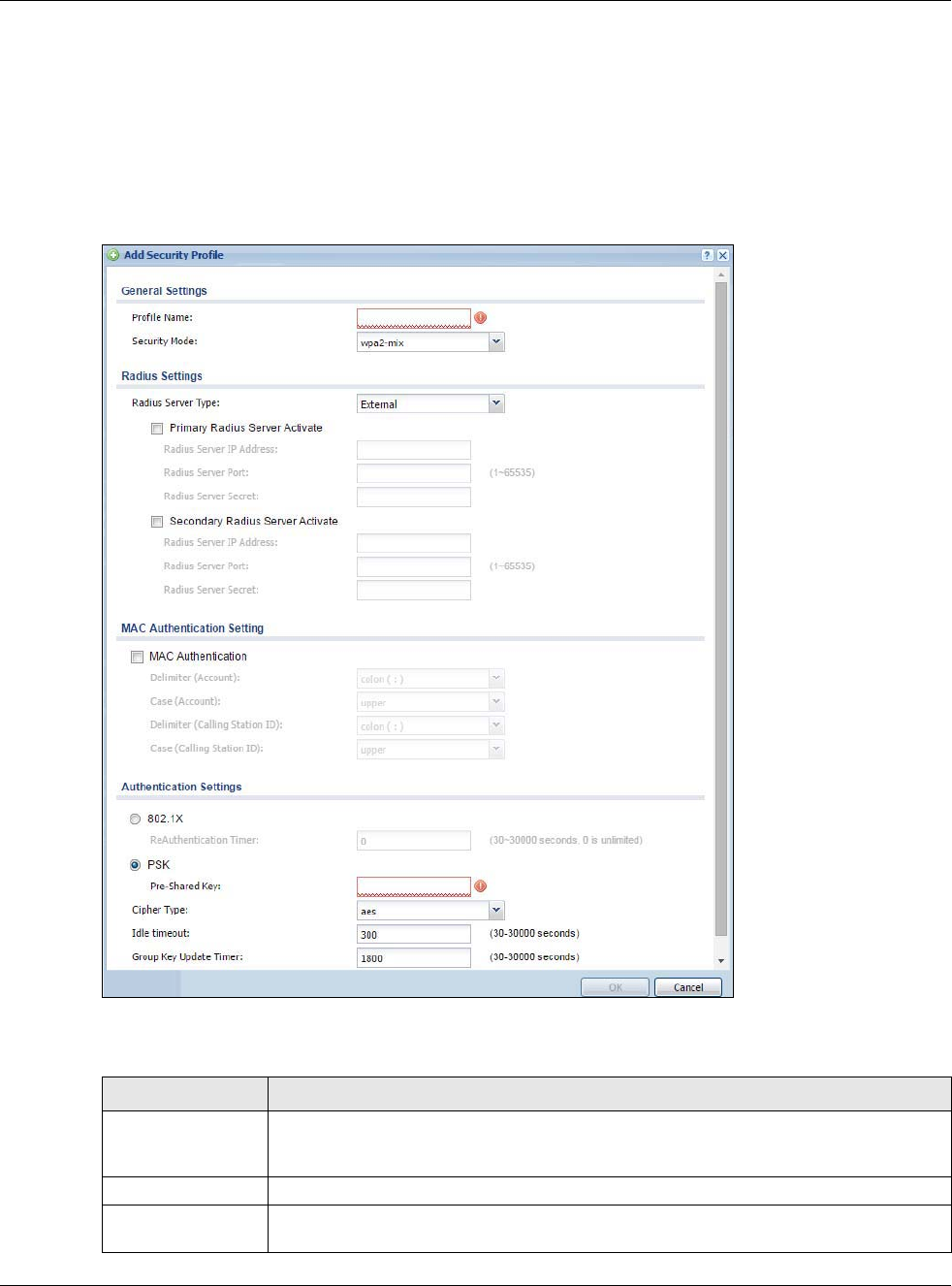
Chapter 29 Object
USG20(W)-VPN Series User’s Guide
479
29.3.2.3.1 Add/Edit Security Profile
This screen allows you to create a new security profile or edit an existing one. To access this screen,
click the Add button or select a security profile from the list and click the Edit button.
Note: This screen’s options change based on the Security Mode selected. Only the
default screen is displayed here.
Figure 323 Configuration > Object > AP Profile > SSID > Security Profile > Add/Edit Security Profile
The following table describes the labels in this screen.
Table 194 Configuration > Object > AP Profile > SSID > Security Profile > Add/Edit Security Profile
LABEL DESCRIPTION
Profile Name Enter up to 31 alphanumeric characters for the profile name. This name is only visible in
the Web Configurator and is only for management purposes. Spaces and underscores
are allowed.
Security Mode Select a security mode from the list: none, wep, wpa2, or wpa2-mix.
Radius Server Type Select Internal to use the USG’s internal authentication database, or External to use
an external RADIUS server for authentication.

Chapter 29 Object
USG20(W)-VPN Series User’s Guide
480
Primary /
Secondary Radius
Server Activate
Select this to have the USG use the specified RADIUS server.
Radius Server IP
Address
Enter the IP address of the RADIUS server to be used for authentication.
Radius Server Port Enter the port number of the RADIUS server to be used for authentication.
Radius Server
Secret
Enter the shared secret password of the RADIUS server to be used for authentication.
MAC Authentication Select this to use an external server or the USG’s local database to authenticate wireless
clients by their MAC addresses. Users cannot get an IP address if the MAC
authentication fails.
An external server can use the wireless client’s account (username/password) or Calling
Station ID for MAC authentication. Configure the ones the external server uses.
Delimiter
(Account) Select the separator the external server uses for the two-character pairs within account
MAC addresses.
Case (Account) Select the case (upper or lower) the external server requires for letters in the account
MAC addresses.
Delimiter
(Calling Station
ID)
RADIUS servers can require the MAC address in the Calling Station ID RADIUS attribute.
Select the separator the external server uses for the pairs in calling station MAC
addresses.
Case (Calling
Station ID) Select the case (upper or lower) the external server requires for letters in the calling
station MAC addresses.
802.1X Select this to enable 802.1x secure authentication.
Auth. Method This field is available only when you set the RADIUS server type to Internal.
Select an authentication method if you have created any in the Configuration >
Object > Auth. Method screen.
ReAuthenticatio
n Timer Enter the interval (in seconds) between authentication requests. Enter a 0 for unlimited
requests.
The following fields are available if you set Security Mode to wep.
Idle Timeout Enter the idle interval (in seconds) that a client can be idle before authentication is
discontinued.
Authentication Type Select a WEP authentication method. Choices are Open or Share key.
Key Length Select the bit-length of the encryption key to be used in WEP connections.
If you select WEP-64:
• Enter 10 hexadecimal digits in the range of “A-F”, “a-f” and “0-9” (for example,
0x11AA22BB33) for each Key used.
or
• Enter 5 ASCII characters (case sensitive) ranging from “a-z”, “A-Z” and “0-9” (for
example, MyKey) for each Key used.
If you select WEP-128:
• Enter 26 hexadecimal digits in the range of “A-F”, “a-f” and “0-9” (for example,
0x00112233445566778899AABBCC) for each Key used.
or
• Enter 13 ASCII characters (case sensitive) ranging from “a-z”, “A-Z” and “0-9” (for
example, MyKey12345678) for each Key used.
Key 1~4 Based on your Key Length selection, enter the appropriate length hexadecimal or
ASCII key.
Table 194 Configuration > Object > AP Profile > SSID > Security Profile > Add/Edit Security Profile
LABEL DESCRIPTION

Chapter 29 Object
USG20(W)-VPN Series User’s Guide
481
The following fields are available if you set Security Mode to wpa2 or wpa2-mix.
PSK Select this option to use a Pre-Shared Key with WPA encryption.
Pre-Shared Key Enter a pre-shared key of between 8 and 63 case-sensitive ASCII characters (including
spaces and symbols) or 64 hexadecimal characters.
Cipher Type Select an encryption cipher type from the list.
•auto - This automatically chooses the best available cipher based on the cipher in
use by the wireless client that is attempting to make a connection.
•tkip - This is the Temporal Key Integrity Protocol encryption method added later to
the WEP encryption protocol to further secure. Not all wireless clients may support
this.
•aes - This is the Advanced Encryption Standard encryption method. It is a more
recent development over TKIP and considerably more robust. Not all wireless clients
may support this.
Idle Timeout Enter the idle interval (in seconds) that a client can be idle before authentication is
discontinued.
Group Key Update
Timer
Enter the interval (in seconds) at which the AP updates the group WPA encryption key.
Pre-Authentication This field is available only when you set Security Mode to wpa2 or wpa2-mix and
enable 802.1x authentication.
Enable or Disable pre-authentication to allow the AP to send authentication
information to other APs on the network, allowing connected wireless clients to switch
APs without having to re-authenticate their network connection.
Management Frame
Protection
This field is available only when you select wpa2 or wpa2-mix in the Security Mode
field and set Cipher Type to aes.
Data frames in 802.11 WLANs can be encrypted and authenticated with WEP, WPA or
WPA2. But 802.11 management frames, such as beacon/probe response, association
request, association response, de-authentication and disassociation are always
unauthenticated and unencrypted. IEEE 802.11w Protected Management Frames allows
APs to use the existing security mechanisms (encryption and authentication methods
defined in IEEE 802.11i WPA/WPA2) to protect management frames. This helps prevent
wireless DoS attacks.
Select the check box to enable management frame protection (MFP) to add security to
802.11 management frames.
Select Optional if you do not require the wireless clients to support MFP. Management
frames will be encrypted if the clients support MFP.
Select Required and wireless clients must support MFP in order to join the AP’s wireless
network.
OK Click OK to save your changes back to the USG.
Cancel Click Cancel to exit this screen without saving your changes.
Table 194 Configuration > Object > AP Profile > SSID > Security Profile > Add/Edit Security Profile
LABEL DESCRIPTION
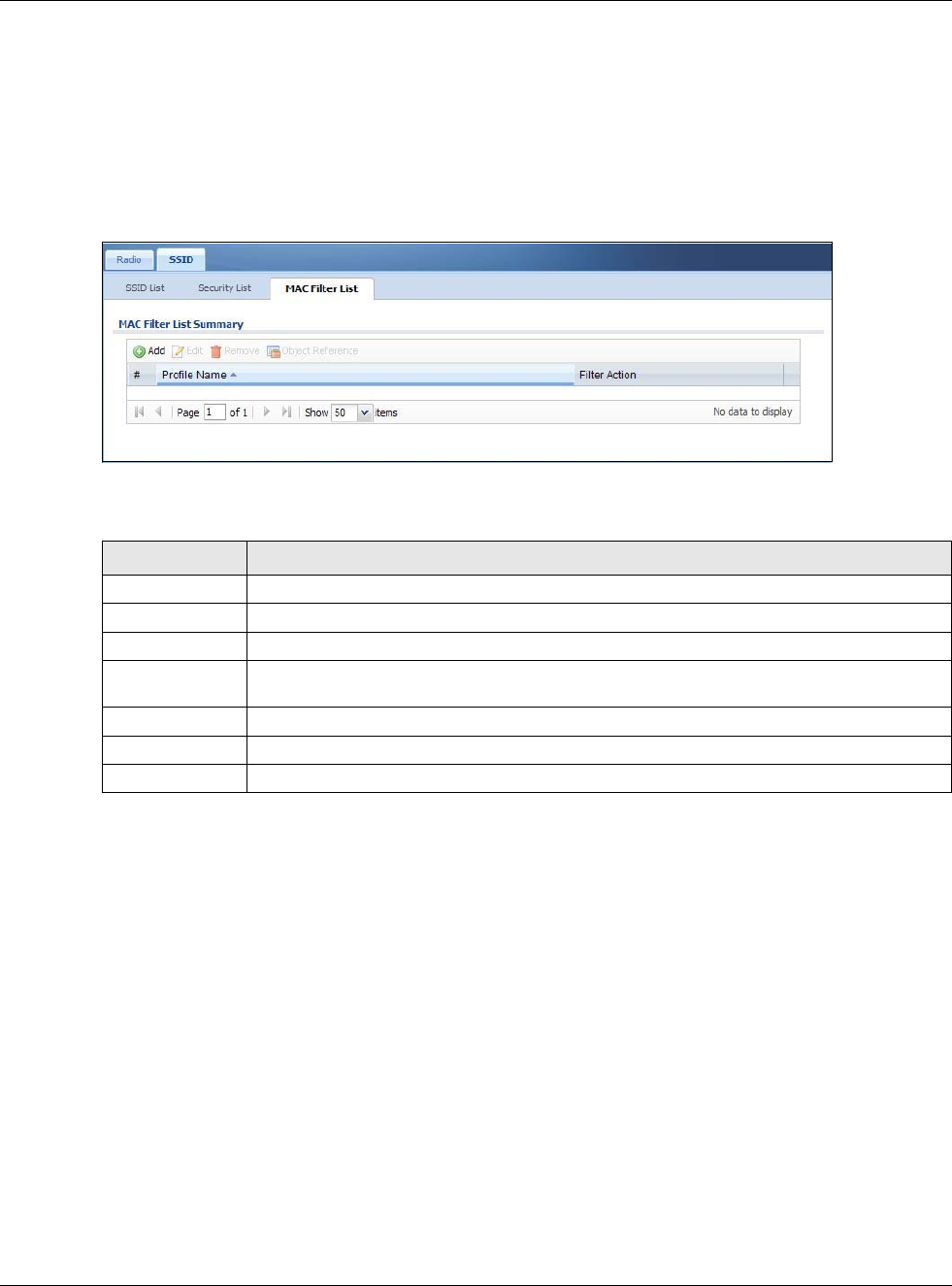
Chapter 29 Object
USG20(W)-VPN Series User’s Guide
482
29.3.2.4 MAC Filter List
This screen allows you to create and manage security configurations that can be used by your
SSIDs. To access this screen click Configuration > Object > AP Profile > SSID > MAC Filter
List.
Note: You can have a maximum of 32 MAC filtering profiles on the USG.
Figure 324 Configuration > Object > AP Profile > SSID > MAC Filter List
The following table describes the labels in this screen.
Table 195 Configuration > Object > AP Profile > SSID > MAC Filter List
LABEL DESCRIPTION
Add Click this to add a new MAC filtering profile.
Edit Click this to edit the selected MAC filtering profile.
Remove Click this to remove the selected MAC filtering profile.
Object Reference Click this to view which other objects are linked to the selected MAC filtering profile (for
example, SSID profile).
# This field is a sequential value, and it is not associated with a specific profile.
Profile Name This field indicates the name assigned to the MAC filtering profile.
Filter Action This field indicates this profile’s filter action (if any).
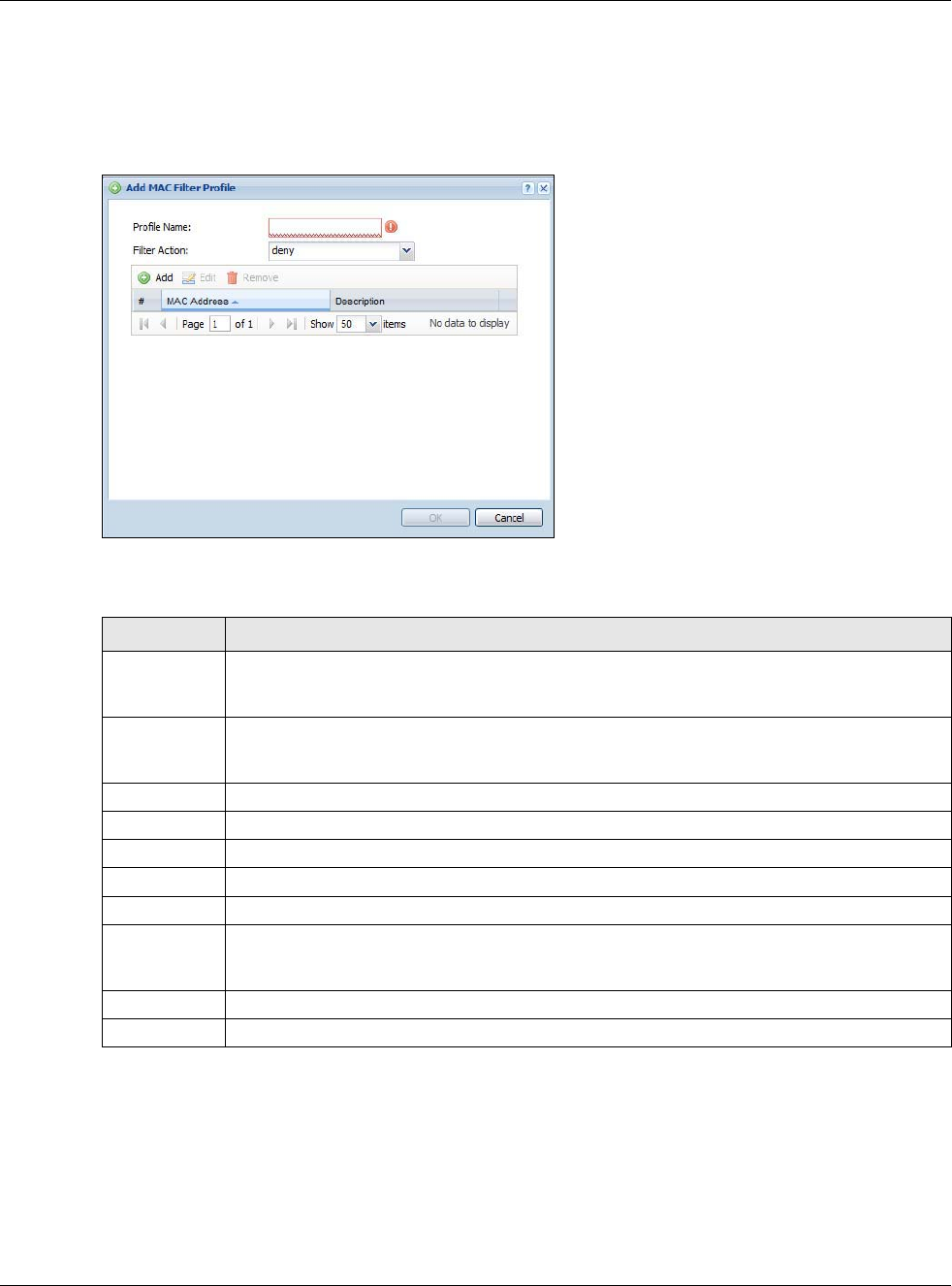
Chapter 29 Object
USG20(W)-VPN Series User’s Guide
483
29.3.2.4.1 Add/Edit MAC Filter Profile
This screen allows you to create a new MAC filtering profile or edit an existing one. To access this
screen, click the Add button or select a MAC filter profile from the list and click the Edit button.
Figure 325 SSID > MAC Filter List > Add/Edit MAC Filter Profile
The following table describes the labels in this screen.
Table 196 SSID > MAC Filter List > Add/Edit MAC Filter Profile
LABEL DESCRIPTION
Profile Name Enter up to 31 alphanumeric characters for the profile name. This name is only visible in the
Web Configurator and is only for management purposes. Spaces and underscores are
allowed.
Filter Action Select allow to permit the wireless client with the MAC addresses in this profile to connect to
the network through the associated SSID; select deny to block the wireless clients with the
specified MAC addresses.
Add Click this to add a MAC address to the profile’s list.
Edit Click this to edit the selected MAC address in the profile’s list.
Remove Click this to remove the selected MAC address from the profile’s list.
# This field is a sequential value, and it is not associated with a specific profile.
MAC Address This field specifies a MAC address associated with this profile.
Description This field displays a description for the MAC address associated with this profile. You can click
the description to make it editable. Enter up to 60 characters, spaces and underscores
allowed.
OK Click OK to save your changes back to the USG.
Cancel Click Cancel to exit this screen without saving your changes.
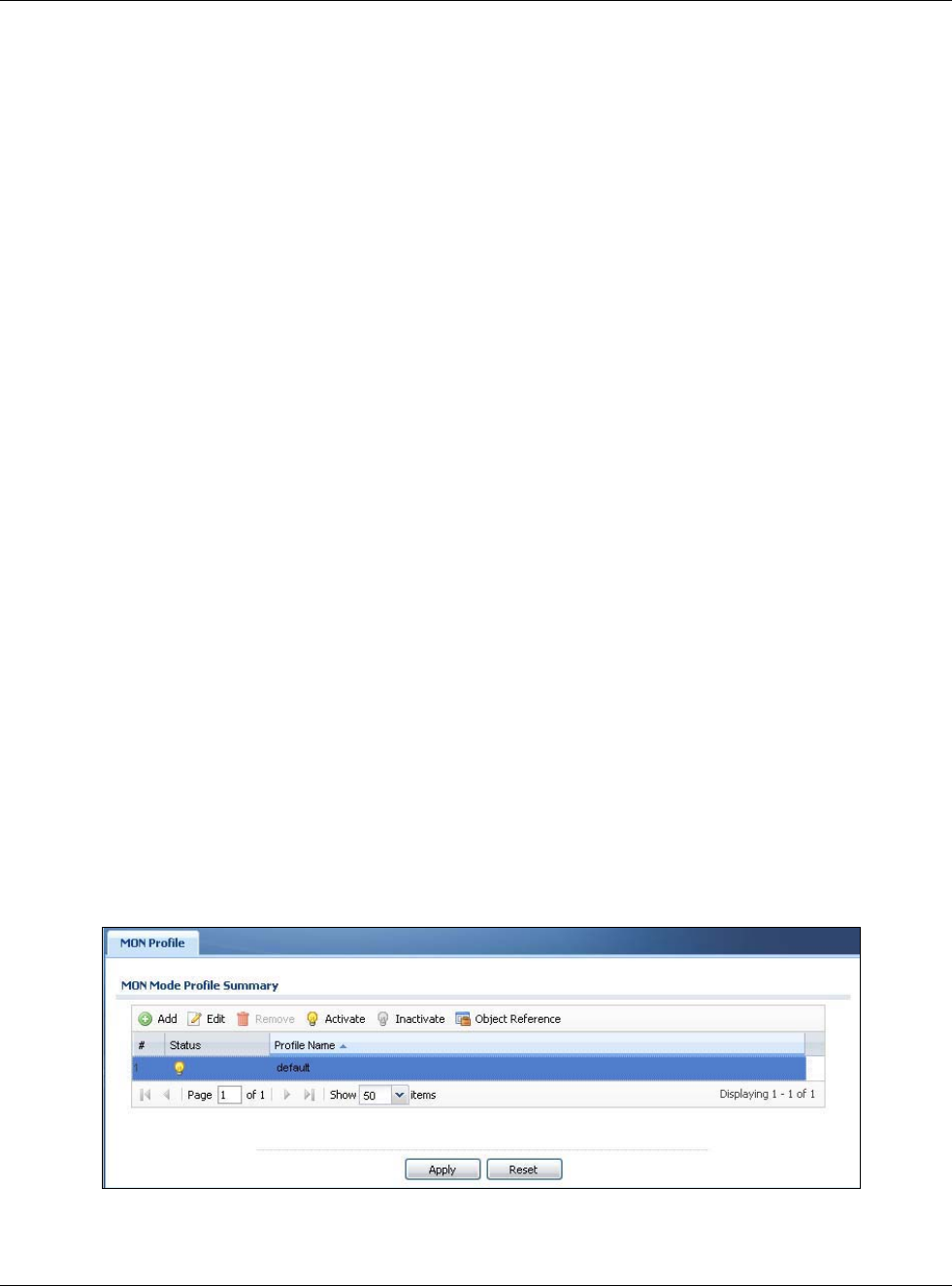
Chapter 29 Object
USG20(W)-VPN Series User’s Guide
484
29.4 MON Profile
29.4.1 Overview
This screen allows you to set up monitor mode configurations that allow your connected APs to scan
for other wireless devices in the vicinity.
29.4.1.1 What You Can Do in this Chapter
The MON Profile screen (Section 29.4.2 on page 484) creates preset monitor mode configurations
that can be used by the APs.
29.4.1.2 What You Need To Know
The following terms and concepts may help as you read this chapter.
Active Scan
An active scan is performed when an 802.11-compatible wireless monitoring device is explicitly
triggered to scan a specified channel or number of channels for other wireless devices broadcasting
on the 802.11 frequencies by sending probe request frames.
Passive Scan
A passive scan is performed when an 802.11-compatible monitoring device is set to periodically
listen to a specified channel or number of channels for other wireless devices broadcasting on the
802.11 frequencies.
29.4.2 MON Profile
This screen allows you to create monitor mode configurations that can be used by the APs. To
access this screen, login to the Web Configurator, and click Configuration > Object > MON
Profile.
Figure 326 Configuration > Object > MON Profile
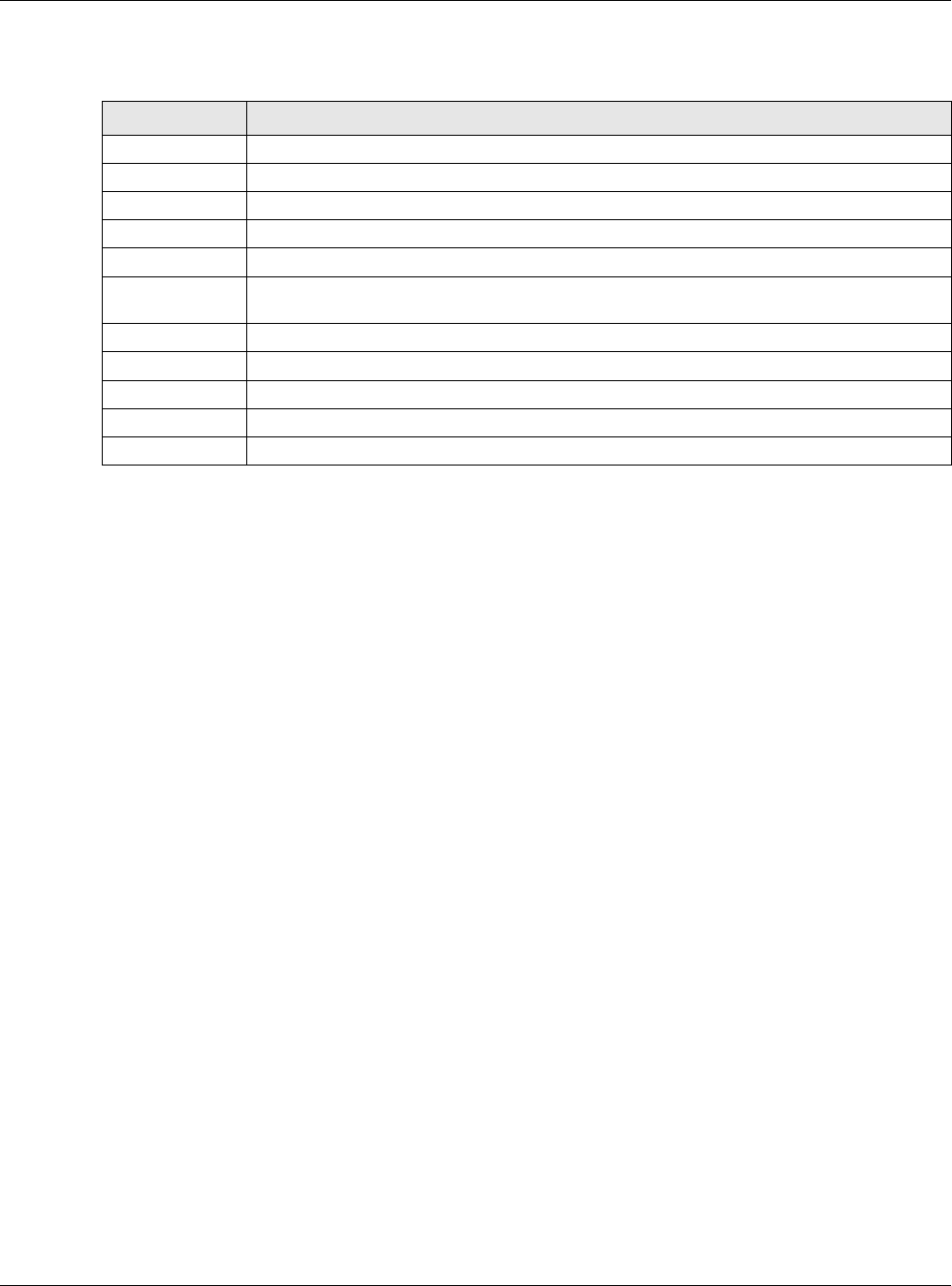
Chapter 29 Object
USG20(W)-VPN Series User’s Guide
485
The following table describes the labels in this screen.
29.4.2.1 Add/Edit MON Profile
This screen allows you to create a new monitor mode profile or edit an existing one. To access this
screen, click the Add button or select and existing monitor mode profile and click the Edit button.
Table 197 Configuration > Object > MON Profile
LABEL DESCRIPTION
Add Click this to add a new monitor mode profile.
Edit Click this to edit the selected monitor mode profile.
Remove Click this to remove the selected monitor mode profile.
Activate To turn on an entry, select it and click Activate.
Inactivate To turn off an entry, select it and click Inactivate.
Object Reference Click this to view which other objects are linked to the selected monitor mode profile (for
example, an AP management profile).
# This field is a sequential value, and it is not associated with a specific user.
Status This icon is lit when the entry is active and dimmed when the entry is inactive.
Profile Name This field indicates the name assigned to the monitor profile.
Apply Click Apply to save your changes back to the USG.
Reset Click Reset to return the screen to its last-saved settings.
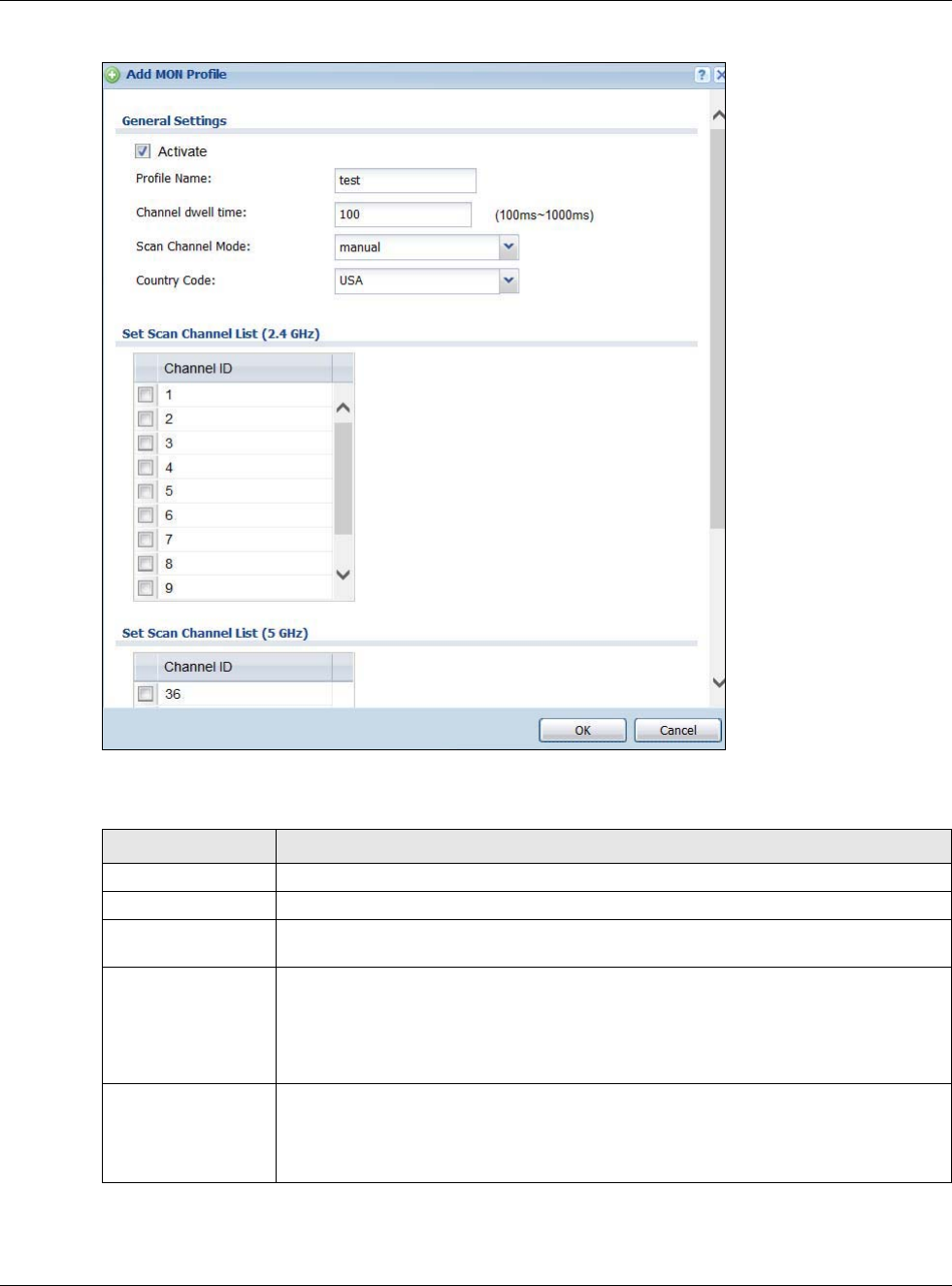
Chapter 29 Object
USG20(W)-VPN Series User’s Guide
486
Figure 327 Configuration > Object > MON Profile > Add/Edit MON Profile
The following table describes the labels in this screen.
Table 198 Configuration > Object > MON Profile > Add/Edit MON Profile
LABEL DESCRIPTION
Activate Select this to activate this monitor mode profile.
Profile Name This field indicates the name assigned to the monitor mode profile.
Channel dwell time Enter the interval (in milliseconds) before the AP switches to another channel for
monitoring.
Scan Channel Mode Select auto to have the AP switch to the next sequential channel once the Channel
dwell time expires.
Select manual to set specific channels through which to cycle sequentially when the
Channel dwell time expires. Selecting this options makes the Scan Channel List
options available.
Country Code Select the country where the USG is located/installed.
The available channels vary depending on the country you selected. Be sure to select
the correct/same country for both radios on an AP and all connected APs, in order to
prevent roaming failure and interference to other systems.
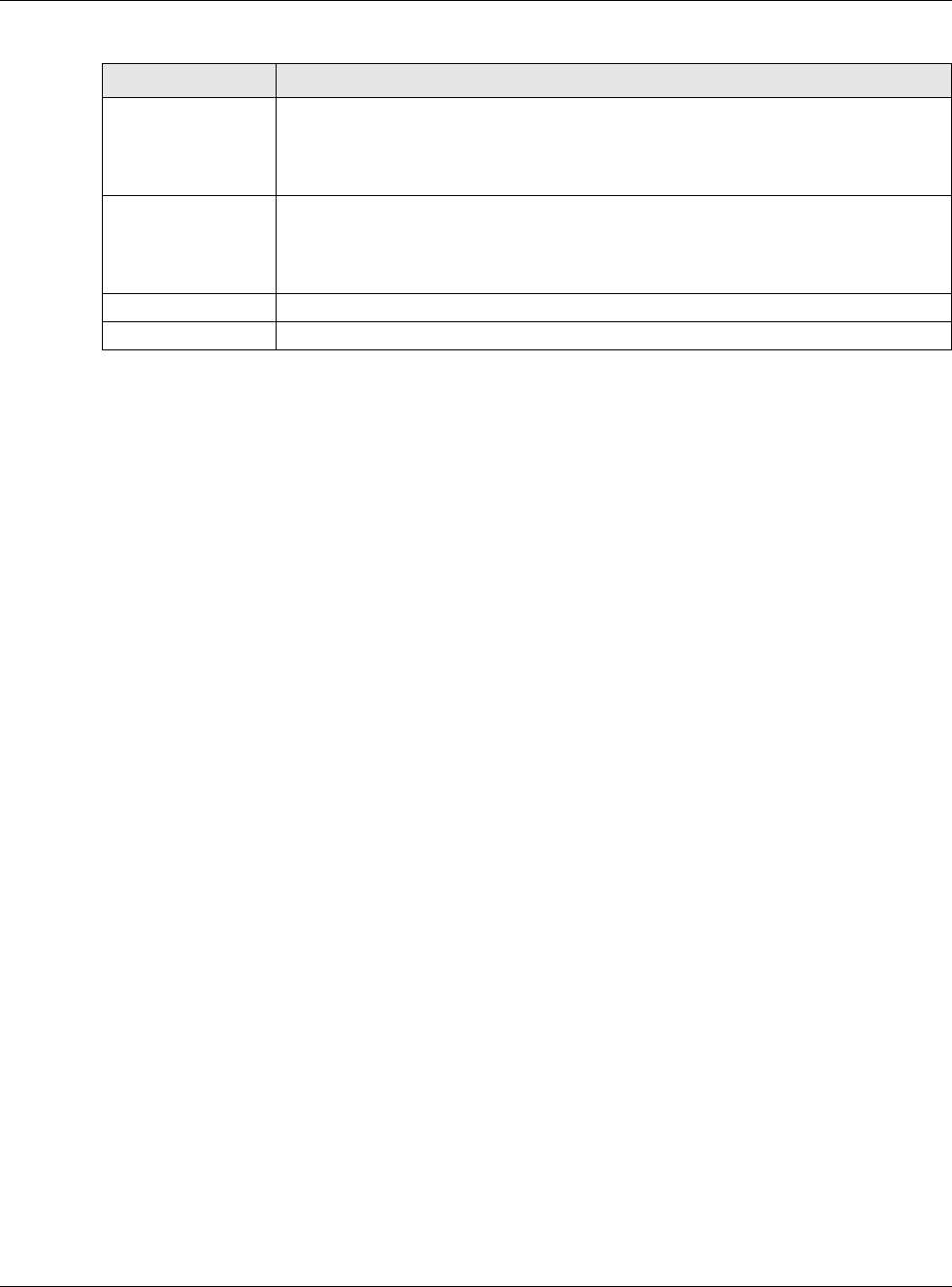
Chapter 29 Object
USG20(W)-VPN Series User’s Guide
487
29.5 Address Overview
Address objects can represent a single IP address or a range of IP addresses. Address groups are
composed of address objects and other address groups.
•The Address screen (Section 29.5.2 on page 487) provides a summary of all addresses in the
USG. Use the Address Add/Edit screen to create a new address or edit an existing one.
•Use the Address Group summary screen (Section 29.5.2.2 on page 489) and the Address
Group Add/Edit screen, to maintain address groups in the USG.
29.5.1 What You Need To Know
Address objects and address groups are used in dynamic routes, security policies, content filtering,
and VPN connection policies. For example, addresses are used to specify where content restrictions
apply in content filtering. Please see the respective sections for more information about how
address objects and address groups are used in each one.
Address groups are composed of address objects and address groups. The sequence of members in
the address group is not important.
29.5.2 Address Summary Screen
The address screens are used to create, maintain, and remove addresses. There are the types of
address objects.
•HOST - a host address is defined by an IP Address.
•RANGE - a range address is defined by a Starting IP Address and an Ending IP Address.
•SUBNET - a network address is defined by a Network IP address and Netmask subnet mask.
The Address screen provides a summary of all addresses in the USG. To access this screen, click
Configuration > Object > Address > Address. Click a column’s heading cell to sort the table
entries by that column’s criteria. Click the heading cell again to reverse the sort order.
Set Scan Channel
List (2.4 GHz)
Move a channel from the Available channels column to the Channels selected
column to have the APs using this profile scan that channel when Scan Channel Mode
is set to manual.
These channels are limited to the 2 GHz range (802.11 b/g/n).
Set Scan Channel
List (5 GHz)
Move a channel from the Available channels column to the Channels selected
column to have the APs using this profile scan that channel when Scan Channel Mode
is set to manual.
These channels are limited to the 5 GHz range (802.11 a/n).
OK Click OK to save your changes back to the USG.
Cancel Click Cancel to exit this screen without saving your changes.
Table 198 Configuration > Object > MON Profile > Add/Edit MON Profile (continued)
LABEL DESCRIPTION
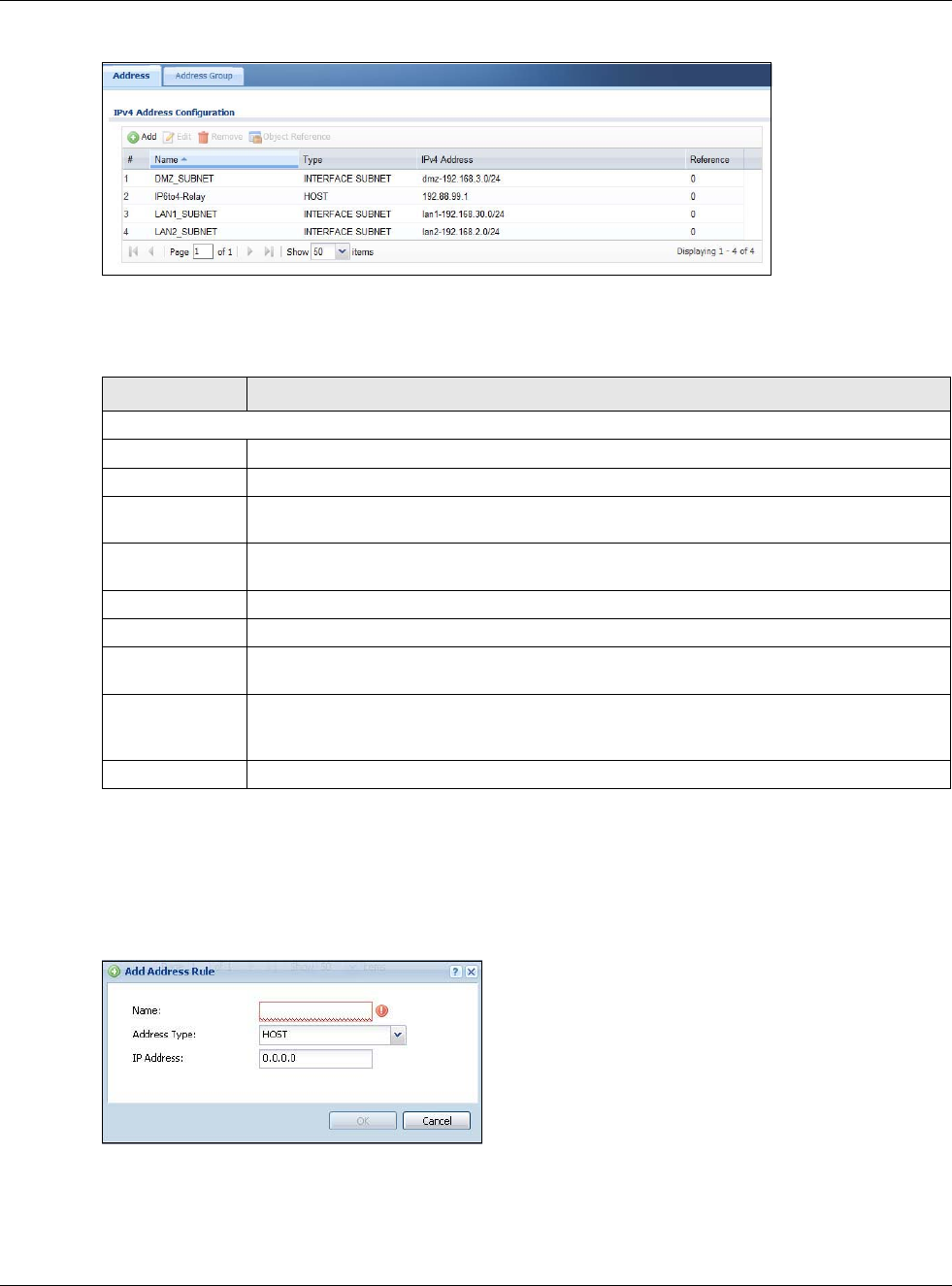
Chapter 29 Object
USG20(W)-VPN Series User’s Guide
488
Figure 328 Configuration > Object > Address > Address
The following table describes the labels in this screen. See Section 29.5.2.1 on page 488 for more
information as well.
29.5.2.1 IPv4 Address Add/Edit Screen
The Configuration > IPv4 Address Add/Edit screen allows you to create a new address or edit
an existing one. To access this screen, go to the Address screen (see Section 29.5.2 on page 487),
and click either the Add icon or an Edit icon in the IPv4 Address Configuration section.
Figure 329 IPv4 Address Configuration > Add/Edit
Table 199 Configuration > Object > Address > Address
LABEL DESCRIPTION
IPv4 Address Configuration
Add Click this to create a new entry.
Edit Double-click an entry or select it and click Edit to be able to modify the entry’s settings.
Remove To remove an entry, select it and click Remove. The USG confirms you want to remove it
before doing so.
Object
References
Select an entry and click Object References to open a screen that shows which settings
use the entry.
# This field is a sequential value, and it is not associated with a specific address.
Name This field displays the configured name of each address object.
Type This field displays the type of each address object. “INTERFACE” means the object uses
the settings of one of the USG’s interfaces.
IPv4 Address This field displays the IPv4 addresses represented by each address object. If the object’s
settings are based on one of the USG’s interfaces, the name of the interface displays first
followed by the object’s current address settings.
Reference This displays the number of times an object reference is used in a profile.
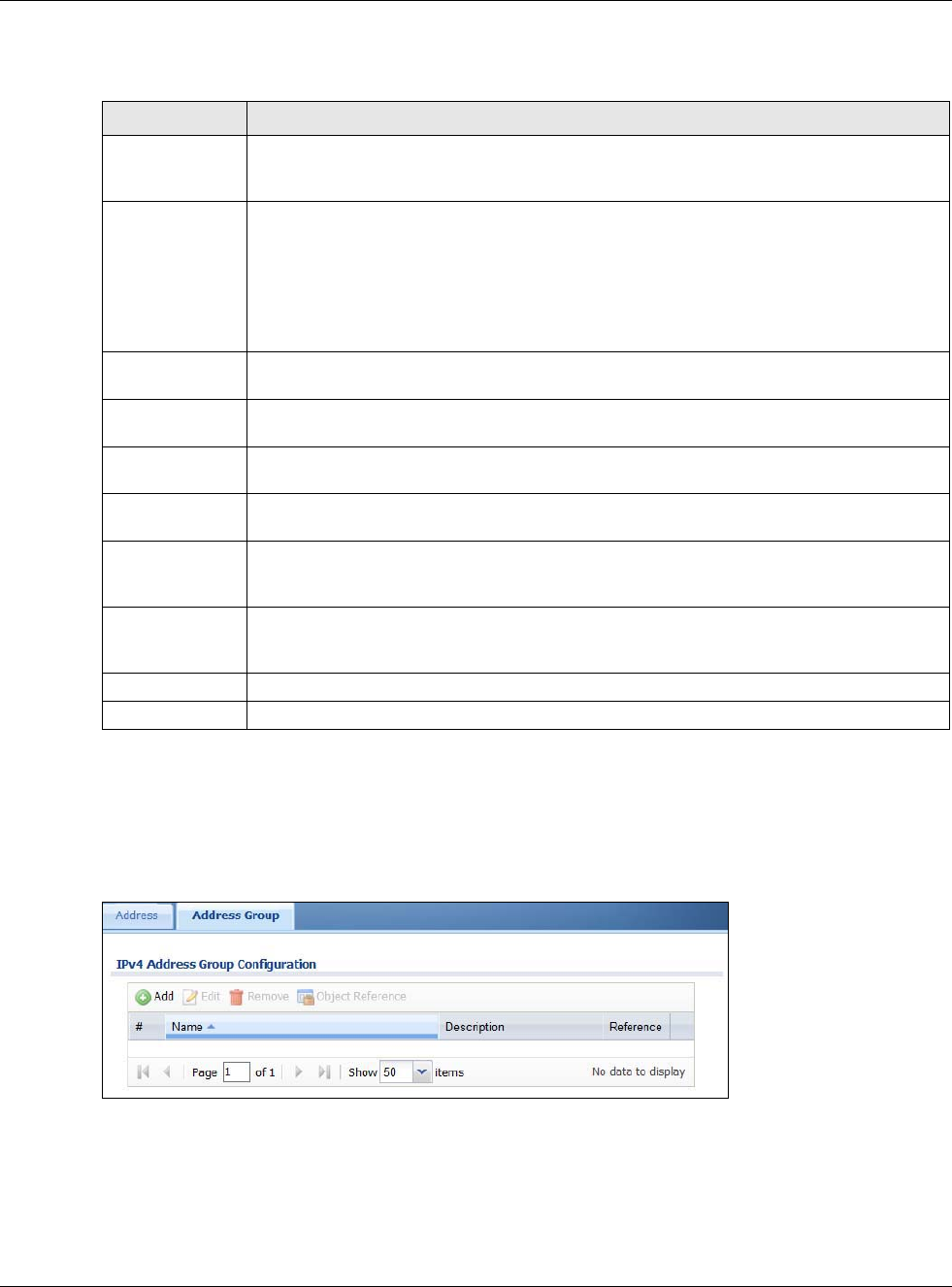
Chapter 29 Object
USG20(W)-VPN Series User’s Guide
489
The following table describes the labels in this screen.
29.5.2.2 Address Group Summary Screen
The Address Group screen provides a summary of all address groups. To access this screen, click
Configuration > Object > Address > Address Group. Click a column’s heading cell to sort the
table entries by that column’s criteria. Click the heading cell again to reverse the sort order.
Figure 330 Configuration > Object > Address > Address Group
Table 200 IPv4 Address Configuration > Add/Edit
LABEL DESCRIPTION
Name Type the name used to refer to the address. You may use 1-31 alphanumeric characters,
underscores(_), or dashes (-), but the first character cannot be a number. This value is
case-sensitive.
Address Type Select the type of address you want to create. Choices are: HOST, RANGE, SUBNET,
INTERFACE IP, INTERFACE SUBNET, and INTERFACE GATEWAY.
Note: The USG automatically updates address objects that are based on an interface’s IP
address, subnet, or gateway if the interface’s IP address settings change. For
example, if you change 1’s IP address, the USG automatically updates the
corresponding interface-based, LAN subnet address object.
IP Address This field is only available if the Address Type is HOST. This field cannot be blank. Enter
the IP address that this address object represents.
Starting IP
Address
This field is only available if the Address Type is RANGE. This field cannot be blank.
Enter the beginning of the range of IP addresses that this address object represents.
Ending IP
Address
This field is only available if the Address Type is RANGE. This field cannot be blank.
Enter the end of the range of IP address that this address object represents.
Network This field is only available if the Address Type is SUBNET, in which case this field cannot
be blank. Enter the IP address of the network that this address object represents.
Netmask This field is only available if the Address Type is SUBNET, in which case this field cannot
be blank. Enter the subnet mask of the network that this address object represents. Use
dotted decimal format.
Interface If you selected INTERFACE IP, INTERFACE SUBNET, or INTERFACE GATEWAY as the
Address Type, use this field to select the interface of the network that this address object
represents.
OK Click OK to save your changes back to the USG.
Cancel Click Cancel to exit this screen without saving your changes.

Chapter 29 Object
USG20(W)-VPN Series User’s Guide
490
The following table describes the labels in this screen. See Section 29.5.2.3 on page 490 for more
information as well.
29.5.2.3 Address Group Add/Edit Screen
The Address Group Add/Edit screen allows you to create a new address group or edit an existing
one. To access this screen, go to the Address Group screen (see Section 29.5.2.2 on page 489),
and click either the Add icon or an Edit icon in the IPv4 Address Group Configuration or IPv6
Address Group Configuration section.
Table 201 Configuration > Object > Address > Address Group
LABEL DESCRIPTION
IPv4 Address Group Configuration
Add Click this to create a new entry.
Edit Double-click an entry or select it and click Edit to be able to modify the entry’s settings.
Remove To remove an entry, select it and click Remove. The USG confirms you want to remove it
before doing so.
Object
References
Select an entry and click Object References to open a screen that shows which settings
use the entry.
# This field is a sequential value, and it is not associated with a specific address group.
Name This field displays the name of each address group.
Description This field displays the description of each address group, if any.
Reference This displays the number of times an object reference is used in a profile.
IPv6 Address Group Configuration
Add Click this to create a new entry.
Edit Double-click an entry or select it and click Edit to be able to modify the entry’s settings.
Remove To remove an entry, select it and click Remove. The USG confirms you want to remove it
before doing so.
Object
References
Select an entry and click Object References to open a screen that shows which settings
use the entry.
# This field is a sequential value, and it is not associated with a specific address group.
Name This field displays the name of each address group.
Description This field displays the description of each address group, if any.
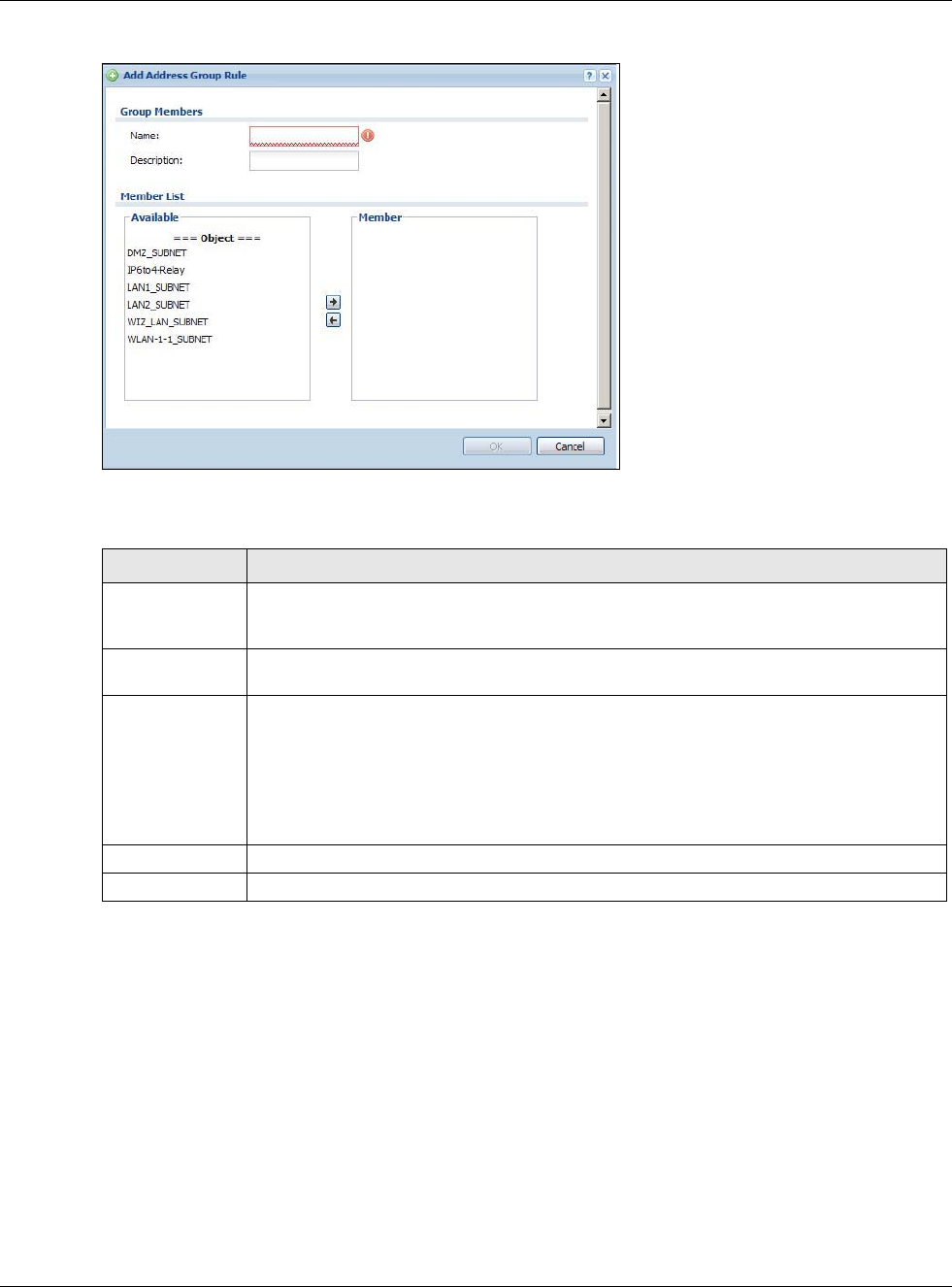
Chapter 29 Object
USG20(W)-VPN Series User’s Guide
491
Figure 331 IPv4/IPv6 Address Group Configuration > Add
The following table describes the labels in this screen.
29.6 Service Overview
Use service objects to define TCP applications, UDP applications, and ICMP messages. You can also
create service groups to refer to multiple service objects in other features.
•Use the Service screens (Section 29.6.2 on page 492) to view and configure the USG’s list of
services and their definitions.
•Use the Service Group screens (Section 29.6.2 on page 492) to view and configure the USG’s
list of service groups.
Table 202 IPv4/IPv6 Address Group Configuration > Add
LABEL DESCRIPTION
Name Enter a name for the address group. You may use 1-31 alphanumeric characters,
underscores(_), or dashes (-), but the first character cannot be a number. This value is
case-sensitive.
Description This field displays the description of each address group, if any. You can use up to 60
characters, punctuation marks, and spaces.
Member List The Member list displays the names of the address and address group objects that have
been added to the address group. The order of members is not important.
Select items from the Available list that you want to be members and move them to the
Member list. You can double-click a single entry to move it or use the [Shift] or [Ctrl] key
to select multiple entries and use the arrow button to move them.
Move any members you do not want included to the Available list.
OK Click OK to save your changes back to the USG.
Cancel Click Cancel to exit this screen without saving your changes.

Chapter 29 Object
USG20(W)-VPN Series User’s Guide
492
29.6.1 What You Need to Know
IP Protocols
IP protocols are based on the eight-bit protocol field in the IP header. This field represents the next-
level protocol that is sent in this packet. This section discusses three of the most common IP
protocols.
Computers use Transmission Control Protocol (TCP, IP protocol 6) and User Datagram Protocol
(UDP, IP protocol 17) to exchange data with each other. TCP guarantees reliable delivery but is
slower and more complex. Some uses are FTP, HTTP, SMTP, and TELNET. UDP is simpler and faster
but is less reliable. Some uses are DHCP, DNS, RIP, and SNMP.
TCP creates connections between computers to exchange data. Once the connection is established,
the computers exchange data. If data arrives out of sequence or is missing, TCP puts it in sequence
or waits for the data to be re-transmitted. Then, the connection is terminated.
In contrast, computers use UDP to send short messages to each other. There is no guarantee that
the messages arrive in sequence or that the messages arrive at all.
Both TCP and UDP use ports to identify the source and destination. Each port is a 16-bit number.
Some port numbers have been standardized and are used by low-level system processes; many
others have no particular meaning.
Unlike TCP and UDP, Internet Control Message Protocol (ICMP, IP protocol 1) is mainly used to send
error messages or to investigate problems. For example, ICMP is used to send the response if a
computer cannot be reached. Another use is ping. ICMP does not guarantee delivery, but networks
often treat ICMP messages differently, sometimes looking at the message itself to decide where to
send it.
Service Objects and Service Groups
Use service objects to define IP protocols.
• TCP applications
• UDP applications
• ICMP messages
• user-defined services (for other types of IP protocols)
These objects are used in policy routes, and security policies.
Use service groups when you want to create the same rule for several services, instead of creating
separate rules for each service. Service groups may consist of services and other service groups.
The sequence of members in the service group is not important.
29.6.2 The Service Summary Screen
The Service summary screen provides a summary of all services and their definitions. In addition,
this screen allows you to add, edit, and remove services.
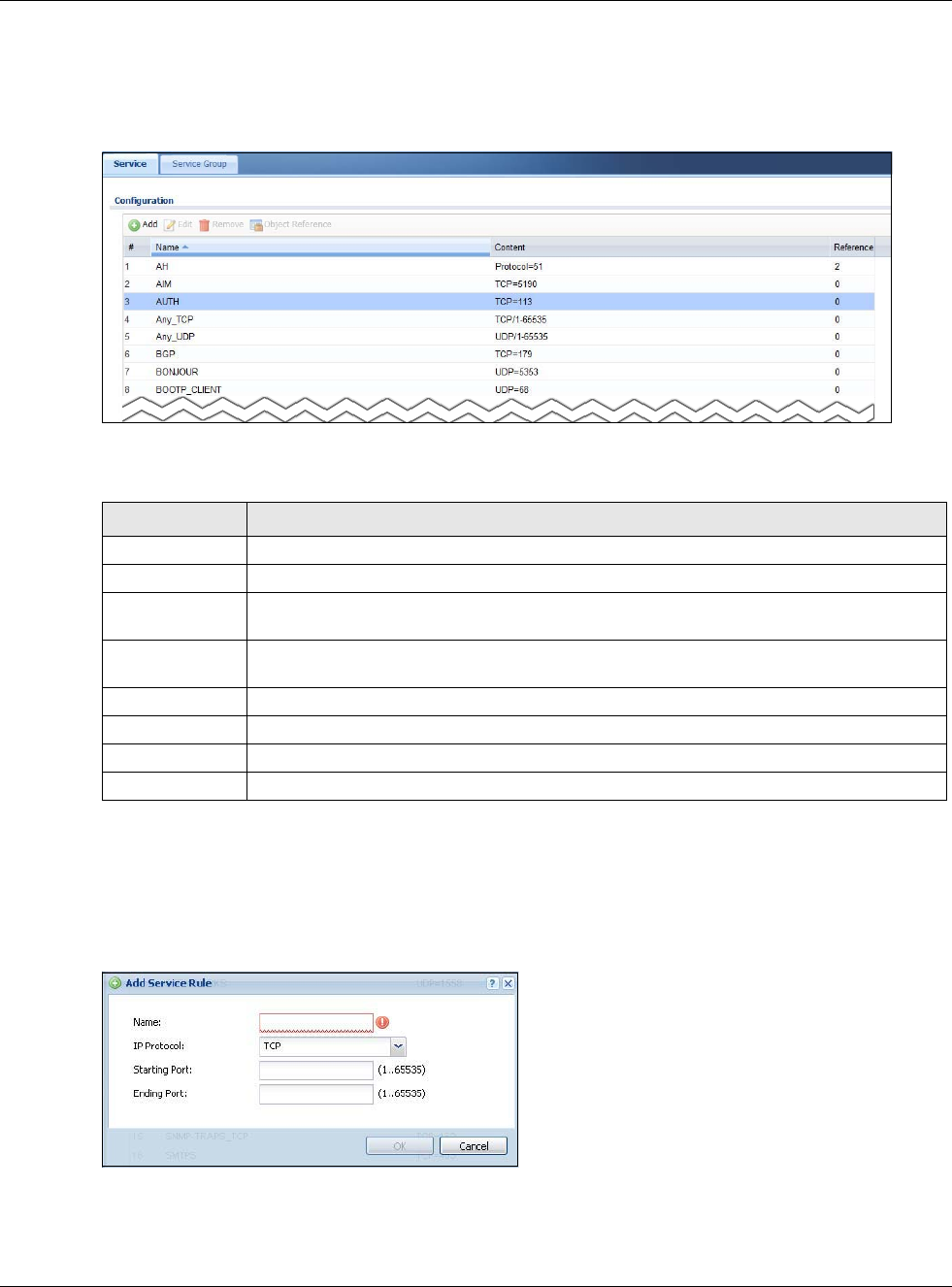
Chapter 29 Object
USG20(W)-VPN Series User’s Guide
493
To access this screen, log in to the Web Configurator, and click Configuration > Object > Service
> Service. Click a column’s heading cell to sort the table entries by that column’s criteria. Click the
heading cell again to reverse the sort order.
Figure 332 Configuration > Object > Service > Service
The following table describes the labels in this screen.
29.6.2.1 The Service Add/Edit Screen
The Service Add/Edit screen allows you to create a new service or edit an existing one. To access
this screen, go to the Service screen (see Section 29.6.2 on page 492), and click either the Add
icon or an Edit icon.
Figure 333 Configuration > Object > Service > Service > Edit
Table 203 Configuration > Object > Service > Service
LABEL DESCRIPTION
Add Click this to create a new entry.
Edit Double-click an entry or select it and click Edit to be able to modify the entry’s settings.
Remove To remove an entry, select it and click Remove. The USG confirms you want to remove it
before doing so.
Object
References
Select an entry and click Object References to open a screen that shows which settings
use the entry.
# This field is a sequential value, and it is not associated with a specific service.
Name This field displays the name of each service.
Content This field displays a description of each service.
Reference This displays the number of times an object reference is used in a profile.
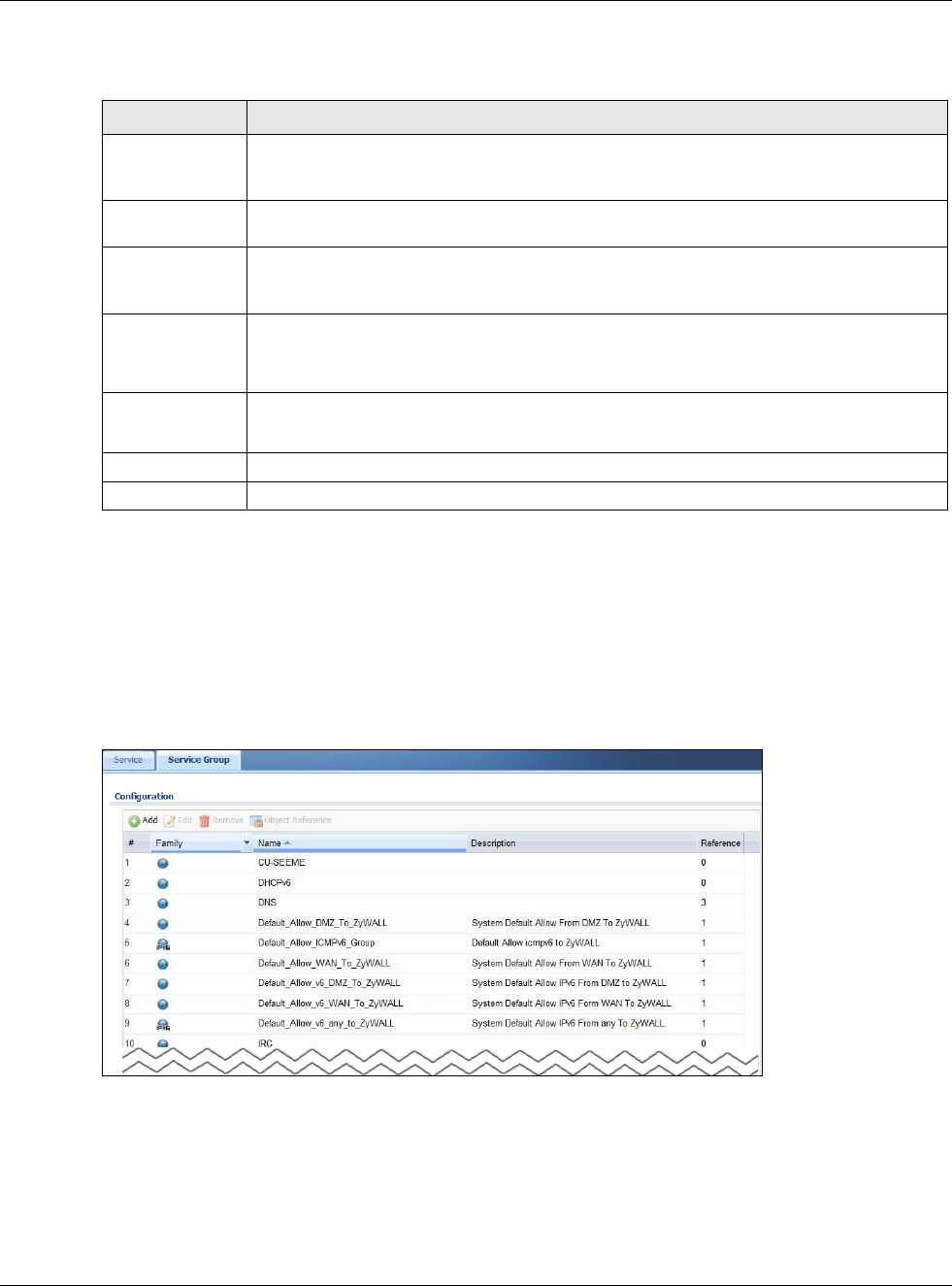
Chapter 29 Object
USG20(W)-VPN Series User’s Guide
494
The following table describes the labels in this screen.
29.6.3 The Service Group Summary Screen
The Service Group summary screen provides a summary of all service groups. In addition, this
screen allows you to add, edit, and remove service groups.
To access this screen, log in to the Web Configurator, and click Configuration > Object > Service
> Service Group.
Figure 334 Configuration > Object > Service > Service Group
Table 204 Configuration > Object > Service > Service > Edit
LABEL DESCRIPTION
Name Type the name used to refer to the service. You may use 1-31 alphanumeric characters,
underscores(_), or dashes (-), but the first character cannot be a number. This value is
case-sensitive.
IP Protocol Select the protocol the service uses. Choices are: TCP, UDP, ICMP, ICMPv6, and User
Defined.
Starting Port
Ending Port
This field appears if the IP Protocol is TCP or UDP. Specify the port number(s) used by
this service. If you fill in one of these fields, the service uses that port. If you fill in both
fields, the service uses the range of ports.
ICMP Type This field appears if the IP Protocol is ICMP or ICMPv6.
Select the ICMP message used by this service. This field displays the message text, not
the message number.
IP Protocol
Number
This field appears if the IP Protocol is User Defined.
Enter the number of the next-level protocol (IP protocol). Allowed values are 1 - 255.
OK Click OK to save your changes back to the USG.
Cancel Click Cancel to exit this screen without saving your changes.
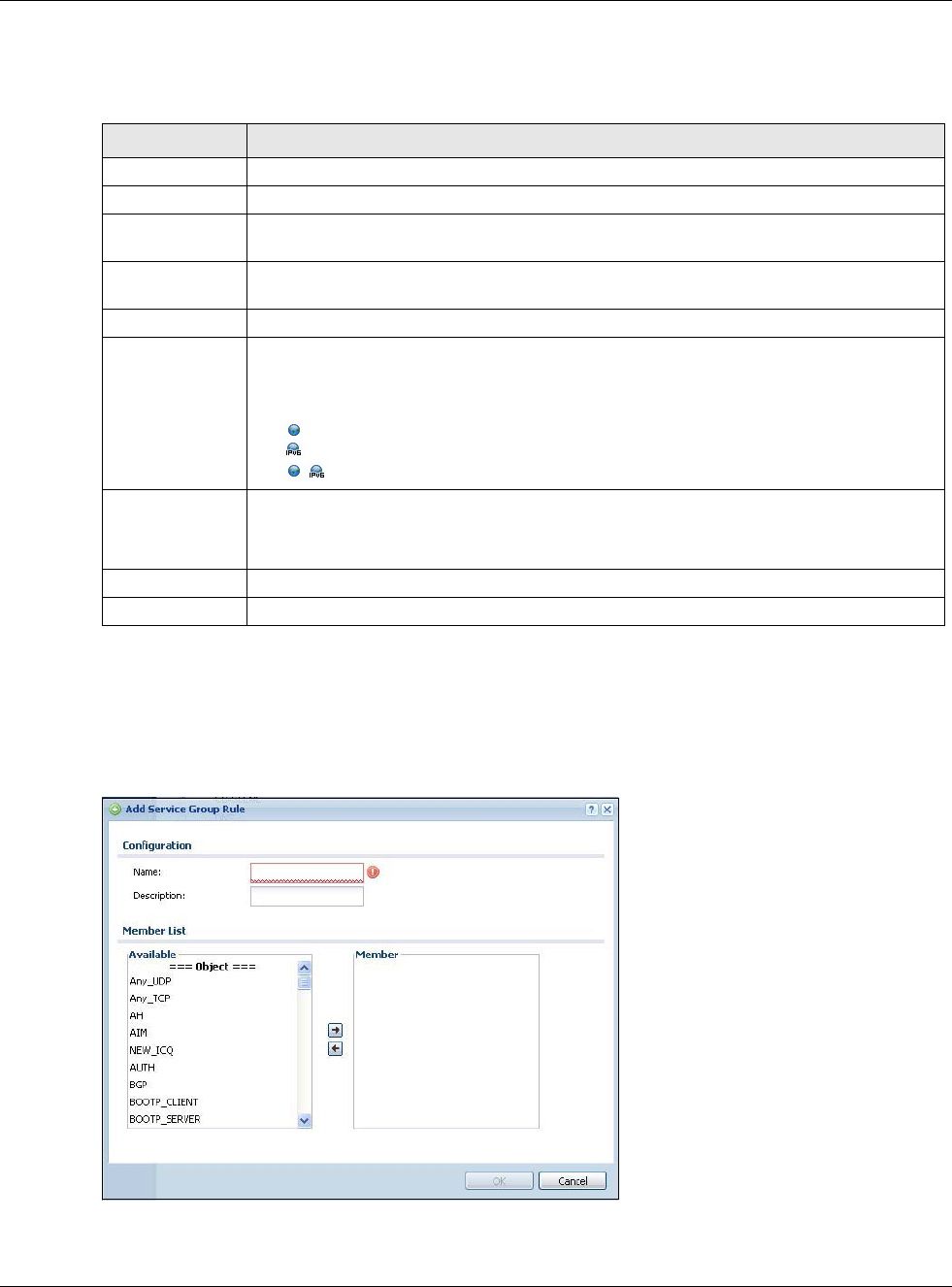
Chapter 29 Object
USG20(W)-VPN Series User’s Guide
495
The following table describes the labels in this screen. See Section 29.6.3.1 on page 495 for more
information as well.
29.6.3.1 The Service Group Add/Edit Screen
The Service Group Add/Edit screen allows you to create a new service group or edit an existing
one. To access this screen, go to the Service Group screen (see Section 29.6.3 on page 494), and
click either the Add icon or an Edit icon.
Figure 335 Configuration > Object > Service > Service Group > Edit
Table 205 Configuration > Object > Service > Service Group
LABEL DESCRIPTION
Add Click this to create a new entry.
Edit Double-click an entry or select it and click Edit to be able to modify the entry’s settings.
Remove To remove an entry, select it and click Remove. The USG confirms you want to remove it
before doing so.
Object
References
Select an entry and click Object References to open a screen that shows which settings
use the entry.
# This field is a sequential value, and it is not associated with a specific service group.
Family This field displays the Server Group supported type, which is according to your
configurations in the Service Group Add/Edit screen.
There are 3 types of families:
• : Supports IPv4 only
• : Supports IPv6 only
• : Supports both IPv4 and IPv6
Name This field displays the name of each service group.
By default, the USG uses services starting with “Default_Allow_” in the security policies to
allow certain services to connect to the USG.
Description This field displays the description of each service group, if any.
Reference This displays the number of times an object reference is used in a profile.
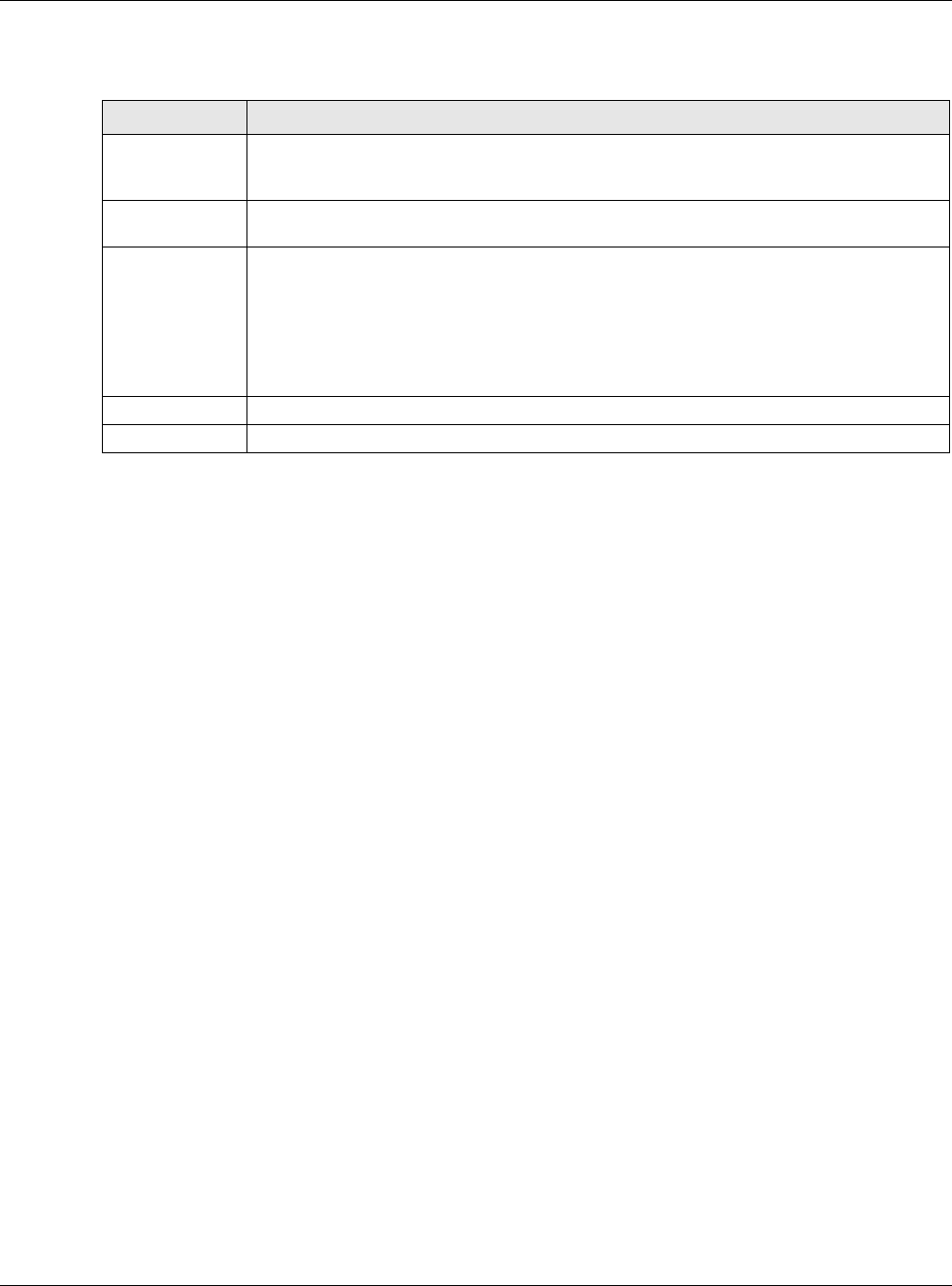
Chapter 29 Object
USG20(W)-VPN Series User’s Guide
496
The following table describes the labels in this screen.
29.7 Schedule Overview
Use schedules to set up one-time and recurring schedules for policy routes, security policies, and
content filtering. The USG supports one-time and recurring schedules. One-time schedules are
effective only once, while recurring schedules usually repeat. Both types of schedules are based on
the current date and time in the USG.
Note: Schedules are based on the USG’s current date and time.
•Use the Schedule summary screen (Section 29.7.2 on page 497) to see a list of all schedules in
the USG.
•Use the One-Time Schedule Add/Edit screen (Section 29.7.2.1 on page 498) to create or edit
a one-time schedule.
•Use the Recurring Schedule Add/Edit screen (Section 29.7.2.2 on page 499) to create or edit
a recurring schedule.
• Use the Schedule Group screen (Section 29.7.3 on page 500) to merge individual schedule
objects as one object.
29.7.1 What You Need to Know
One-time Schedules
One-time schedules begin on a specific start date and time and end on a specific stop date and
time. One-time schedules are useful for long holidays and vacation periods.
Recurring Schedules
Recurring schedules begin at a specific start time and end at a specific stop time on selected days of
the week (Sunday, Monday, Tuesday, Wednesday, Thursday, Friday, and Saturday). Recurring
Table 206 Configuration > Object > Service > Service Group > Edit
LABEL DESCRIPTION
Name Enter the name of the service group. You may use 1-31 alphanumeric characters,
underscores(_), or dashes (-), but the first character cannot be a number. This value is
case-sensitive.
Description Enter a description of the service group, if any. You can use up to 60 printable ASCII
characters.
Member List The Member list displays the names of the service and service group objects that have
been added to the service group. The order of members is not important.
Select items from the Available list that you want to be members and move them to the
Member list. You can double-click a single entry to move it or use the [Shift] or [Ctrl] key
to select multiple entries and use the arrow button to move them.
Move any members you do not want included to the Available list.
OK Click OK to save your changes back to the USG.
Cancel Click Cancel to exit this screen without saving your changes.
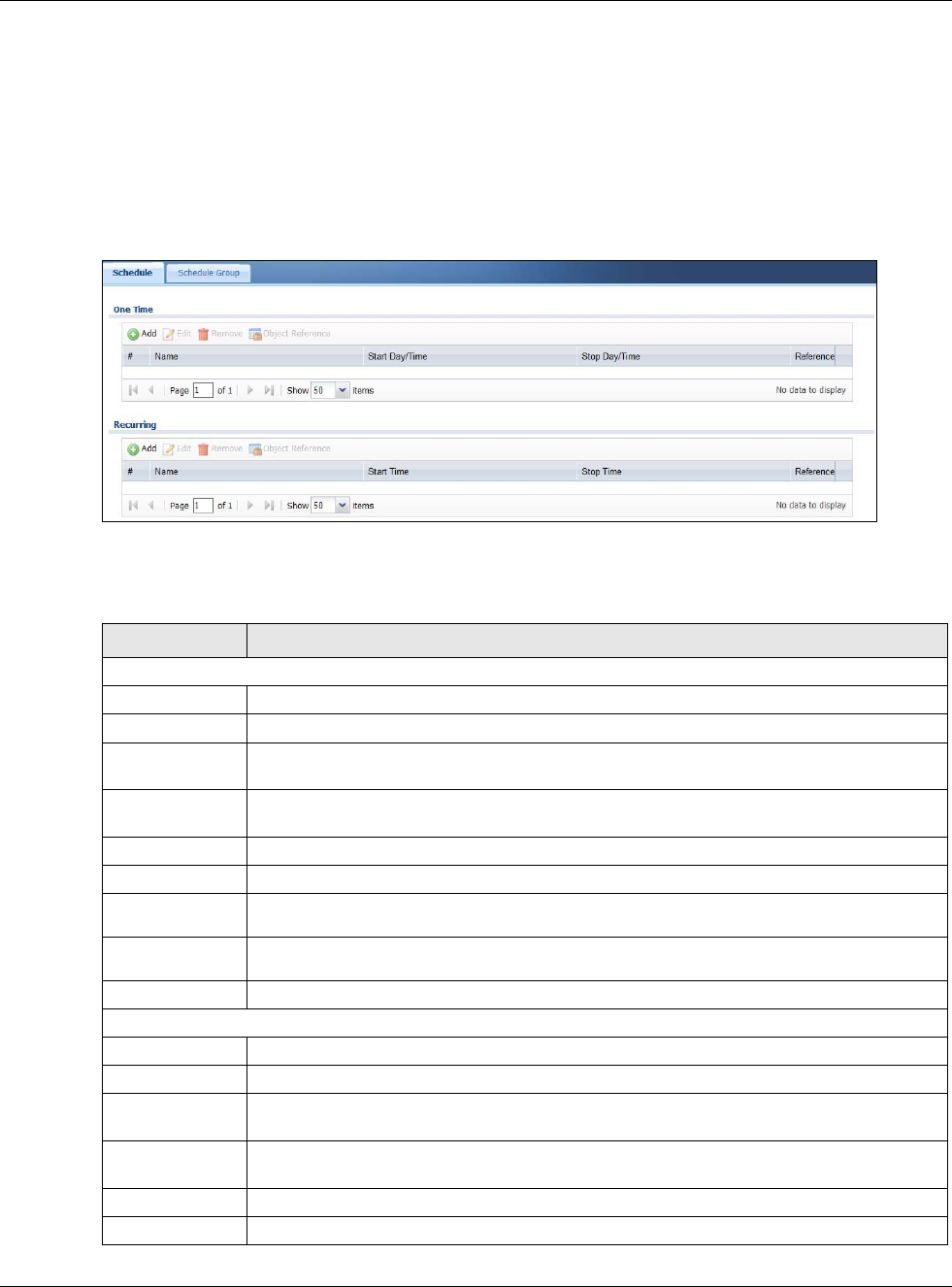
Chapter 29 Object
USG20(W)-VPN Series User’s Guide
497
schedules always begin and end in the same day. Recurring schedules are useful for defining the
workday and off-work hours.
29.7.2 The Schedule Summary Screen
The Schedule summary screen provides a summary of all schedules in the USG. To access this
screen, click Configuration > Object > Schedule.
Figure 336 Configuration > Object > Schedule
The following table describes the labels in this screen. See Section 29.7.2.1 on page 498 and
Section 29.7.2.2 on page 499 for more information as well.
Table 207 Configuration > Object > Schedule
LABEL DESCRIPTION
One Time
Add Click this to create a new entry.
Edit Double-click an entry or select it and click Edit to be able to modify the entry’s settings.
Remove To remove an entry, select it and click Remove. The USG confirms you want to remove it
before doing so.
Object
References Select an entry and click Object References to open a screen that shows which settings
use the entry.
# This field is a sequential value, and it is not associated with a specific schedule.
Name This field displays the name of the schedule, which is used to refer to the schedule.
Start Day /
Time This field displays the date and time at which the schedule begins.
Stop Day /
Time This field displays the date and time at which the schedule ends.
Reference This displays the number of times an object reference is used in a profile.
Recurring
Add Click this to create a new entry.
Edit Double-click an entry or select it and click Edit to be able to modify the entry’s settings.
Remove To remove an entry, select it and click Remove. The USG confirms you want to remove it
before doing so.
Object
References Select an entry and click Object References to open a screen that shows which settings
use the entry.
# This field is a sequential value, and it is not associated with a specific schedule.
Name This field displays the name of the schedule, which is used to refer to the schedule.
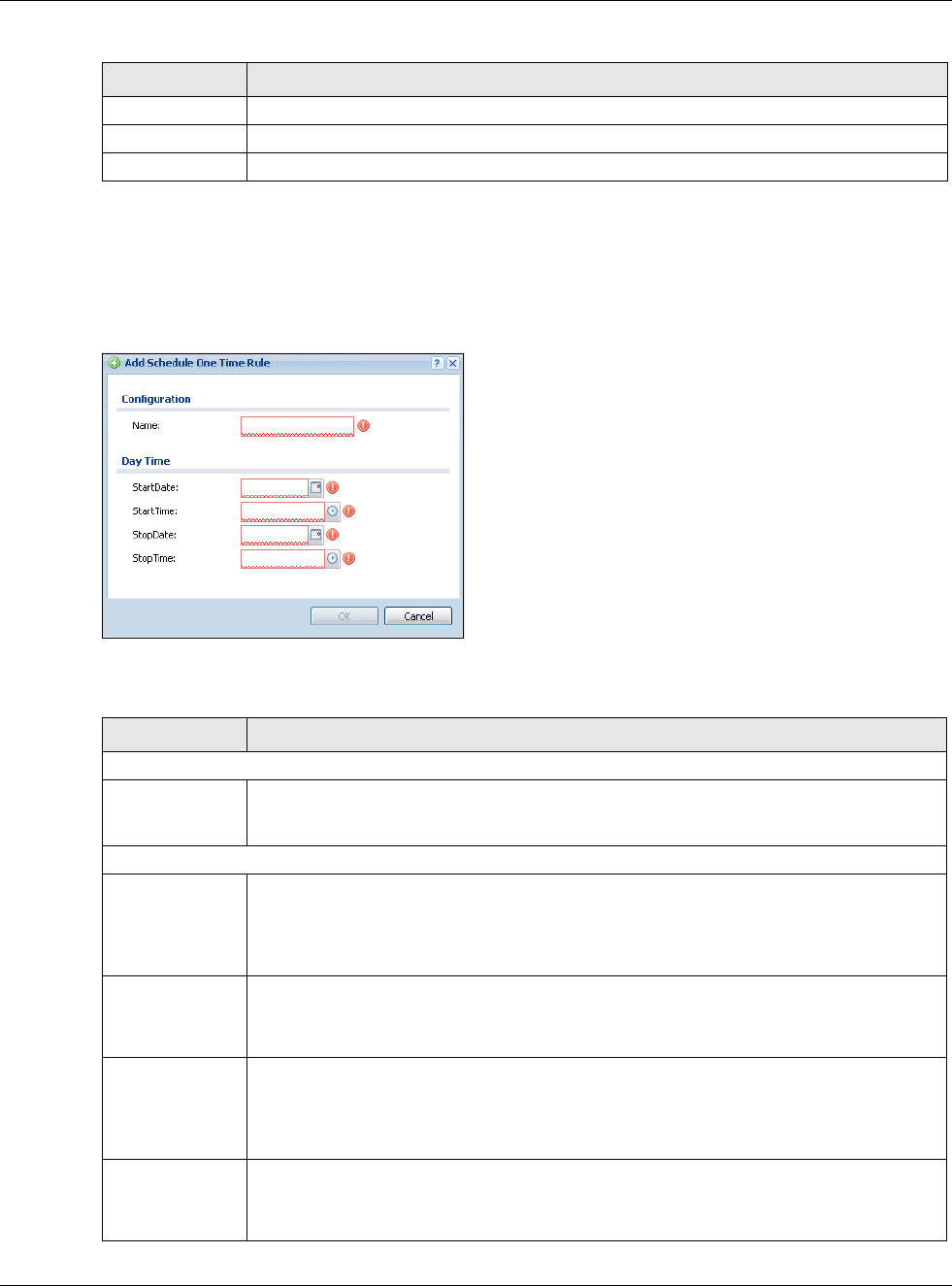
Chapter 29 Object
USG20(W)-VPN Series User’s Guide
498
29.7.2.1 The One-Time Schedule Add/Edit Screen
The One-Time Schedule Add/Edit screen allows you to define a one-time schedule or edit an
existing one. To access this screen, go to the Schedule screen (see Section 29.7.2 on page 497),
and click either the Add icon or an Edit icon in the One Time section.
Figure 337 Configuration > Object > Schedule > Edit (One Time)
The following table describes the labels in this screen.
Start Time This field displays the time at which the schedule begins.
Stop Time This field displays the time at which the schedule ends.
Reference This displays the number of times an object reference is used in a profile.
Table 207 Configuration > Object > Schedule (continued)
LABEL DESCRIPTION
Table 208 Configuration > Object > Schedule > Edit (One Time)
LABEL DESCRIPTION
Configuration
Name Type the name used to refer to the one-time schedule. You may use 1-31 alphanumeric
characters, underscores(_), or dashes (-), but the first character cannot be a number.
This value is case-sensitive.
Date Time
StartDate Specify the year, month, and day when the schedule begins.
•Year - 1900 - 2999
•Month - 1 - 12
•Day - 1 - 31 (it is not possible to specify illegal dates, such as February 31.)
StartTime Specify the hour and minute when the schedule begins.
•Hour - 0 - 23
•Minute - 0 - 59
StopDate Specify the year, month, and day when the schedule ends.
•Year - 1900 - 2999
•Month - 1 - 12
•Day - 1 - 31 (it is not possible to specify illegal dates, such as February 31.)
StopTime Specify the hour and minute when the schedule ends.
•Hour - 0 - 23
•Minute - 0 - 59
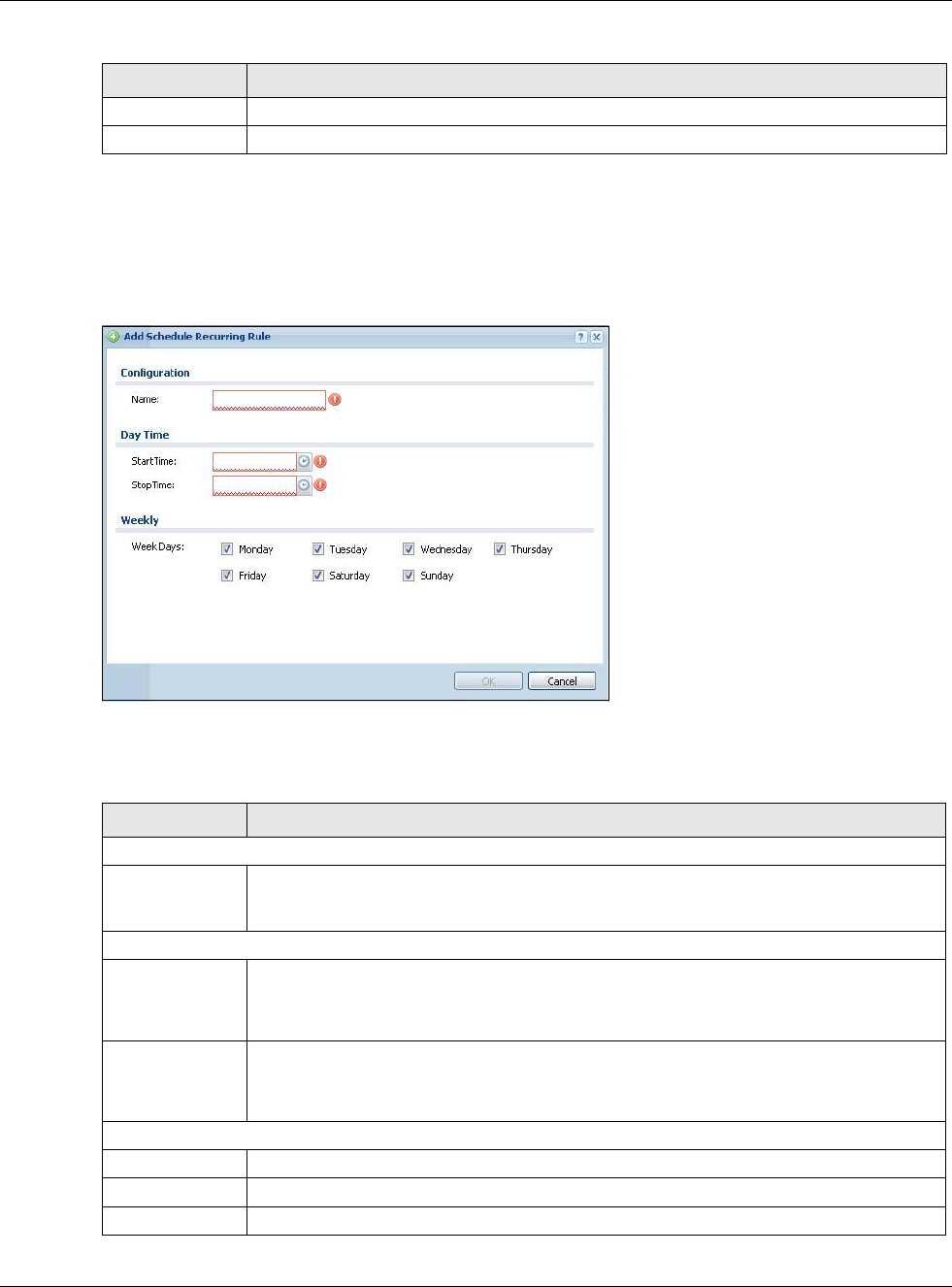
Chapter 29 Object
USG20(W)-VPN Series User’s Guide
499
29.7.2.2 The Recurring Schedule Add/Edit Screen
The Recurring Schedule Add/Edit screen allows you to define a recurring schedule or edit an
existing one. To access this screen, go to the Schedule screen (see Section 29.7.2 on page 497),
and click either the Add icon or an Edit icon in the Recurring section.
Figure 338 Configuration > Object > Schedule > Edit (Recurring)
The Year, Month, and Day columns are not used in recurring schedules and are disabled in this
screen. The following table describes the remaining labels in this screen.
OK Click OK to save your changes back to the USG.
Cancel Click Cancel to exit this screen without saving your changes.
Table 208 Configuration > Object > Schedule > Edit (One Time) (continued)
LABEL DESCRIPTION
Table 209 Configuration > Object > Schedule > Edit (Recurring)
LABEL DESCRIPTION
Configuration
Name Type the name used to refer to the recurring schedule. You may use 1-31 alphanumeric
characters, underscores(_), or dashes (-), but the first character cannot be a number.
This value is case-sensitive.
Date Time
StartTime Specify the hour and minute when the schedule begins each day.
•Hour - 0 - 23
•Minute - 0 - 59
StopTime Specify the hour and minute when the schedule ends each day.
•Hour - 0 - 23
•Minute - 0 - 59
Weekly
Week Days Select each day of the week the recurring schedule is effective.
OK Click OK to save your changes back to the USG.
Cancel Click Cancel to exit this screen without saving your changes.
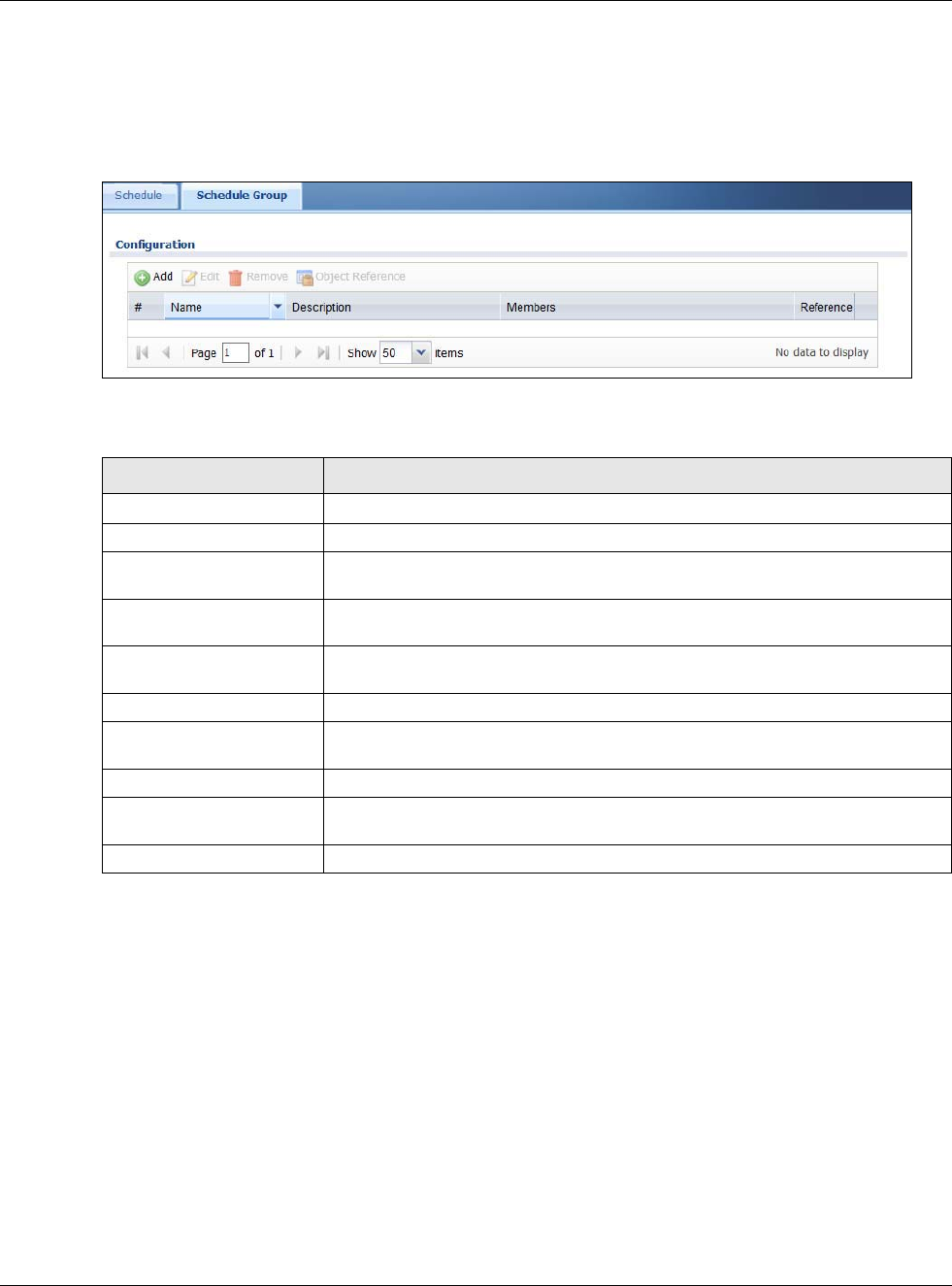
Chapter 29 Object
USG20(W)-VPN Series User’s Guide
500
29.7.3 The Schedule Group Screen
The Schedule Group summary screen provides a summary of all groups of schedules in the USG.
To access this screen, click Configuration > Object > Schedule >Group.
Figure 339 Configuration > Object > Schedule > Schedule Group
The following table describes the fields in the above screen.
29.7.3.1 The Schedule Group Add/Edit Screen
The Schedule Group Add/Edit screen allows you to define a schedule group or edit an existing
one. To access this screen, go to the Schedule screen (see ), and click either the Add icon or an
Edit icon in the Schedule Group section.
Table 210 Configuration > Object > Schedule > Schedule Group
LABEL DESCRIPTION
Configuration
Add Click this to create a new entry.
Edit Double-click an entry or select it and click Edit to be able to modify the entry’s
settings.
Remove To remove an entry, select it and click Remove. The USG confirms you want to
remove it before doing so.
Object Reference Select an entry and click Object References to open a screen that shows which
settings use the entry.
# This field is a sequential value, and it is not associated with a specific schedule.
Name This field displays the name of the schedule group, which is used to refer to the
schedule.
Description This field displays the decription of the schedule group.
Members This field lists the members in the schedule group. Each member is separated by
a comma.
Reference This displays the number of times an object reference is used in a profile.
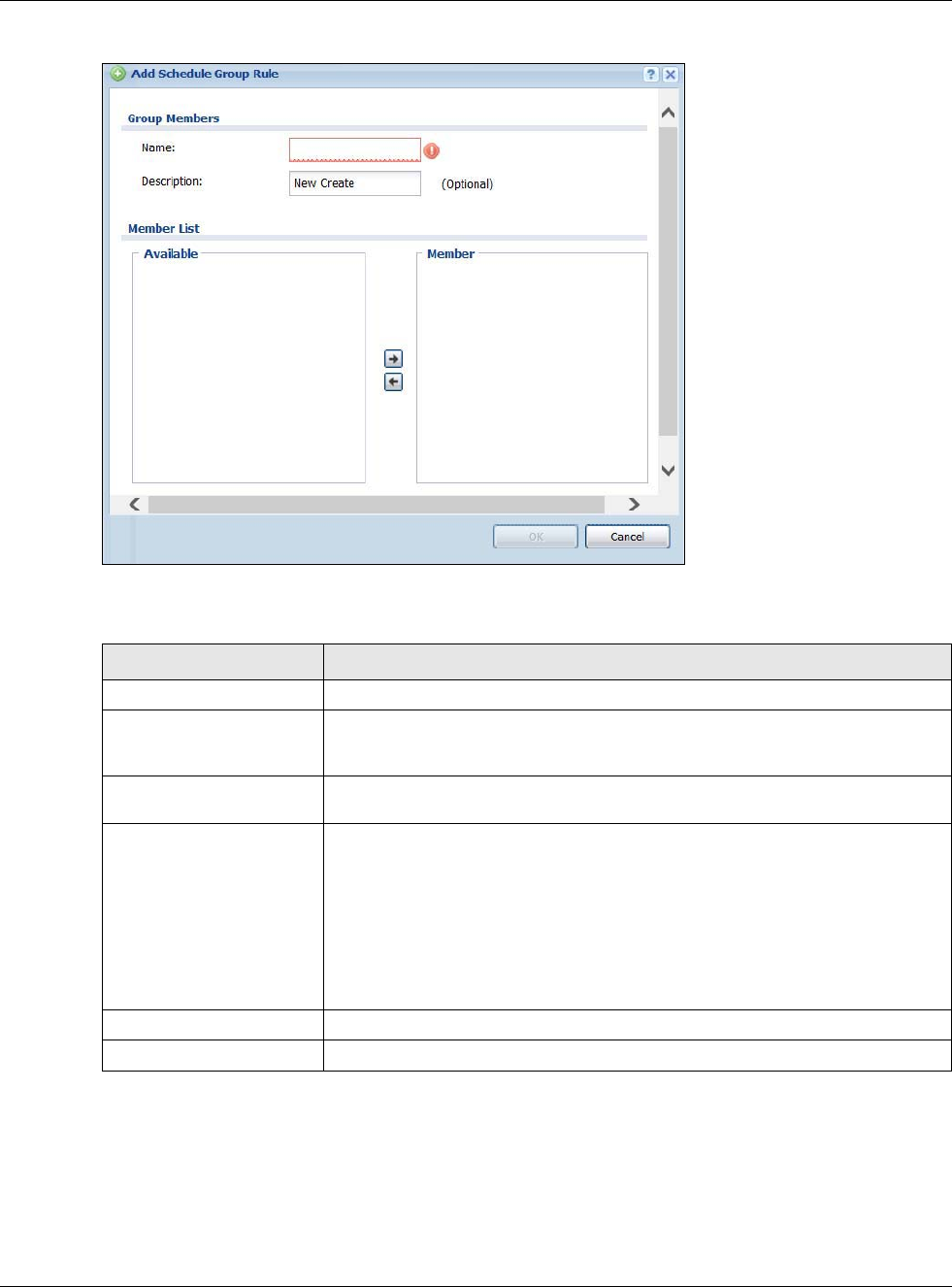
Chapter 29 Object
USG20(W)-VPN Series User’s Guide
501
Figure 340 Configuration > Schedule > Schedule Group > Add
The following table describes the fields in the above screen.
29.8 AAA Server Overview
You can use a AAA (Authentication, Authorization, Accounting) server to provide access control to
your network. The AAA server can be a Active Directory, LDAP, or RADIUS server. Use the AAA
Server screens to create and manage objects that contain settings for using AAA servers. You use
Table 211 Configuration > Schedule > Schedule Group > Add
LABEL DESCRIPTION
Group Members
Name Type the name used to refer to the recurring schedule. You may use 1-31
alphanumeric characters, underscores(_), or dashes (-), but the first character
cannot be a number. This value is case-sensitive.
Description Enter a description of the service group, if any. You can use up to 60 printable
ASCII characters.
Member List The Member list displays the names of the service and service group objects
that have been added to the service group. The order of members is not
important.
Select items from the Available list that you want to be members and move
them to the Member list. You can double-click a single entry to move it or use
the [Shift] or [Ctrl] key to select multiple entries and use the arrow button to
move them.
Move any members you do not want included to the Available list.
OK Click OK to save your changes back to the USG.
Cancel Click Cancel to exit this screen without saving your changes.
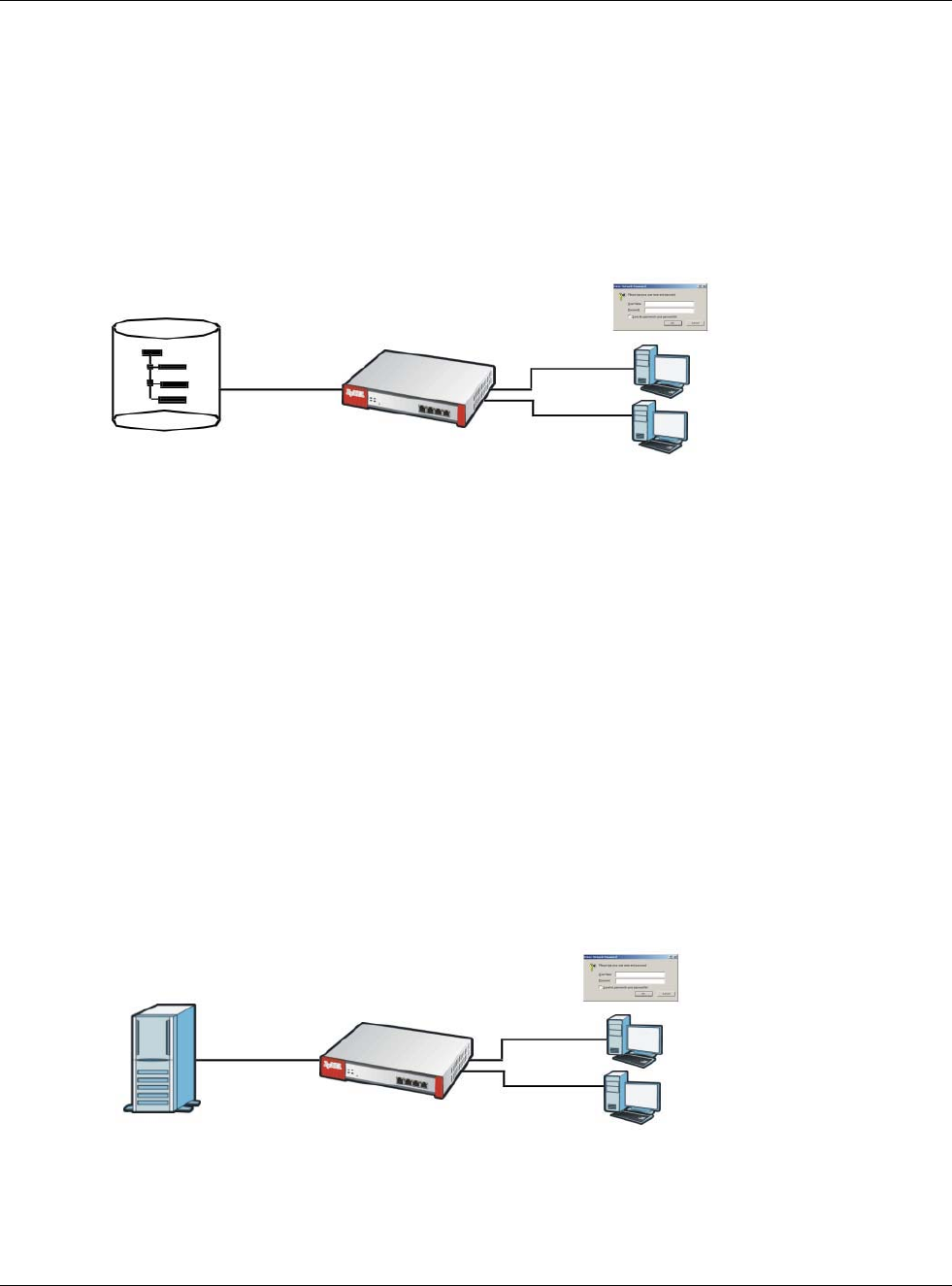
Chapter 29 Object
USG20(W)-VPN Series User’s Guide
502
AAA server objects in configuring ext-group-user user objects and authentication method objects
(see Chapter 29 on page 510).
29.8.1 Directory Service (AD/LDAP)
LDAP/AD allows a client (the USG) to connect to a server to retrieve information from a directory. A
network example is shown next.
Figure 341 Example: Directory Service Client and Server
The following describes the user authentication procedure via an LDAP/AD server.
1A user logs in with a user name and password pair.
2The USG tries to bind (or log in) to the LDAP/AD server.
3When the binding process is successful, the USG checks the user information in the directory
against the user name and password pair.
4If it matches, the user is allowed access. Otherwise, access is blocked.
29.8.2 RADIUS Server
RADIUS (Remote Authentication Dial-In User Service) authentication is a popular protocol used to
authenticate users by means of an external server instead of (or in addition to) an internal device
user database that is limited to the memory capacity of the device. In essence, RADIUS
authentication allows you to validate a large number of users from a central location.
Figure 342 RADIUS Server Network Example
29.8.3 ASAS
ASAS (Authenex Strong Authentication System) is a RADIUS server that works with the One-Time
Password (OTP) feature. Purchase a USG OTP package in order to use this feature. The package

Chapter 29 Object
USG20(W)-VPN Series User’s Guide
503
contains server software and physical OTP tokens (PIN generators). Do the following to use OTP.
See the documentation included on the ASAS’ CD for details.
1Install the ASAS server software on a computer.
2Create user accounts on the USG and in the ASAS server.
3Import each token’s database file (located on the included CD) into the server.
4Assign users to OTP tokens (on the ASAS server).
5Configure the ASAS as a RADIUS server in the USG’s Configuration > Object > AAA Server
screens.
6Give the OTP tokens to (local or remote) users.
•Use the Configuration > Object > AAA Server > Active Directory (or LDAP) screens
(Section 29.8.5 on page 504) to configure Active Directory or LDAP server objects.
•Use the Configuration > Object > AAA Server > RADIUS screen (Section 29.8.2 on page
502) to configure the default external RADIUS server to use for user authentication.
29.8.4 What You Need To Know
AAA Servers Supported by the USG
The following lists the types of authentication server the USG supports.
•Local user database
The USG uses the built-in local user database to authenticate administrative users logging into
the USG’s Web Configurator or network access users logging into the network through the USG.
You can also use the local user database to authenticate VPN users.
• Directory Service (LDAP/AD)
LDAP (Lightweight Directory Access Protocol)/AD (Active Directory) is a directory service that is
both a directory and a protocol for controlling access to a network. The directory consists of a
database specialized for fast information retrieval and filtering activities. You create and store
user profile and login information on the external server.
•RADIUS
RADIUS (Remote Authentication Dial-In User Service) authentication is a popular protocol used
to authenticate users by means of an external or built-in RADIUS server. RADIUS authentication
allows you to validate a large number of users from a central location.
Directory Structure
The directory entries are arranged in a hierarchical order much like a tree structure. Normally, the
directory structure reflects the geographical or organizational boundaries. The following figure
shows a basic directory structure branching from countries to organizations to organizational units
to individuals.
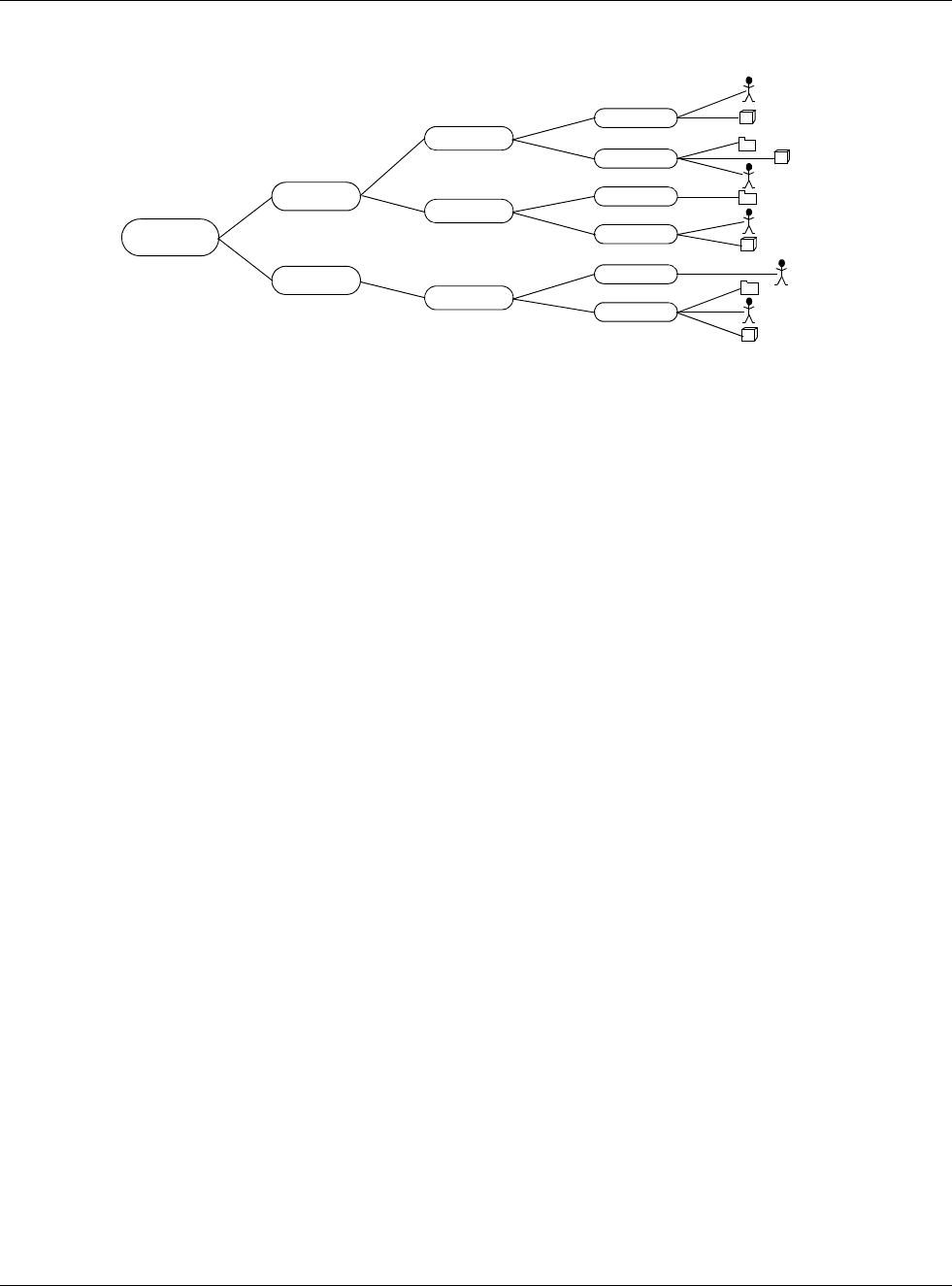
Chapter 29 Object
USG20(W)-VPN Series User’s Guide
504
Figure 343 Basic Directory Structure
Distinguished Name (DN)
A DN uniquely identifies an entry in a directory. A DN consists of attribute-value pairs separated by
commas. The leftmost attribute is the Relative Distinguished Name (RDN). This provides a unique
name for entries that have the same “parent DN” (“cn=domain1.com, ou=Sales, o=MyCompany” in
the following examples).
cn=domain1.com, ou = Sales, o=MyCompany, c=US
cn=domain1.com, ou = Sales, o=MyCompany, c=JP
Base DN
A base DN specifies a directory. A base DN usually contains information such as the name of an
organization, a domain name and/or country. For example, o=MyCompany, c=UK where o means
organization and c means country.
Bind DN
A bind DN is used to authenticate with an LDAP/AD server. For example a bind DN of
cn=zywallAdmin allows the USG to log into the LDAP/AD server using the user name of
zywallAdmin. The bind DN is used in conjunction with a bind password. When a bind DN is not
specified, the USG will try to log in as an anonymous user. If the bind password is incorrect, the
login will fail.
29.8.5 Active Directory or LDAP Server Summary
Use the Active Directory or LDAP screen to manage the list of AD or LDAP servers the USG can
use in authenticating users.
Click Configuration > Object > AAA Server > Active Directory (or LDAP) to display the
Active Directory (or LDAP) screen.
Root
US
Japan
Sprint
UPS
NEC
Sales
RD3
QA
CSO
Sales
RD
Countries (c) Organizations Organization Units Unique
Common Name
(cn)
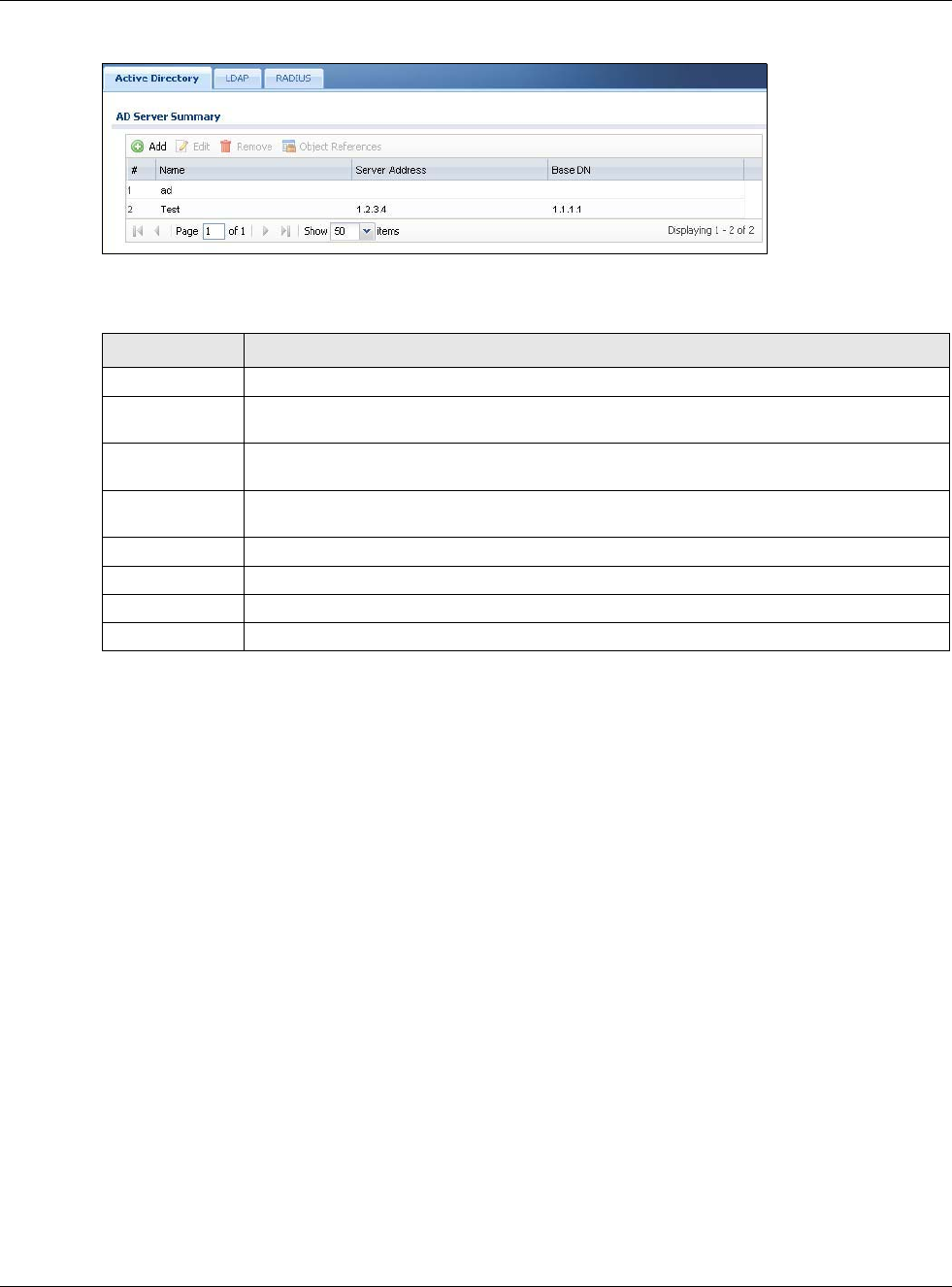
Chapter 29 Object
USG20(W)-VPN Series User’s Guide
505
Figure 344 Configuration > Object > AAA Server > Active Directory (or LDAP)
The following table describes the labels in this screen.
29.8.5.1 Adding an Active Directory or LDAP Server
Click Object > AAA Server > Active Directory (or LDAP) to display the Active Directory (or
LDAP) screen. Click the Add icon or an Edit icon to display the following screen. Use this screen to
create a new AD or LDAP entry or edit an existing one.
Table 212 Configuration > Object > AAA Server > Active Directory (or LDAP)
LABEL DESCRIPTION
Add Click this to create a new entry.
Edit Double-click an entry or select it and click Edit to open a screen where you can modify the
entry’s settings.
Remove To remove an entry, select it and click Remove. The USG confirms you want to remove it
before doing so.
Object
References
Select an entry and click Object References to open a screen that shows which settings
use the entry.
# This field is a sequential value, and it is not associated with a specific AD or LDAP server.
Name This field displays the name of the Active Directory.
Server Address This is the address of the AD or LDAP server.
Base DN This specifies a directory. For example, o=ZyXEL, c=US.
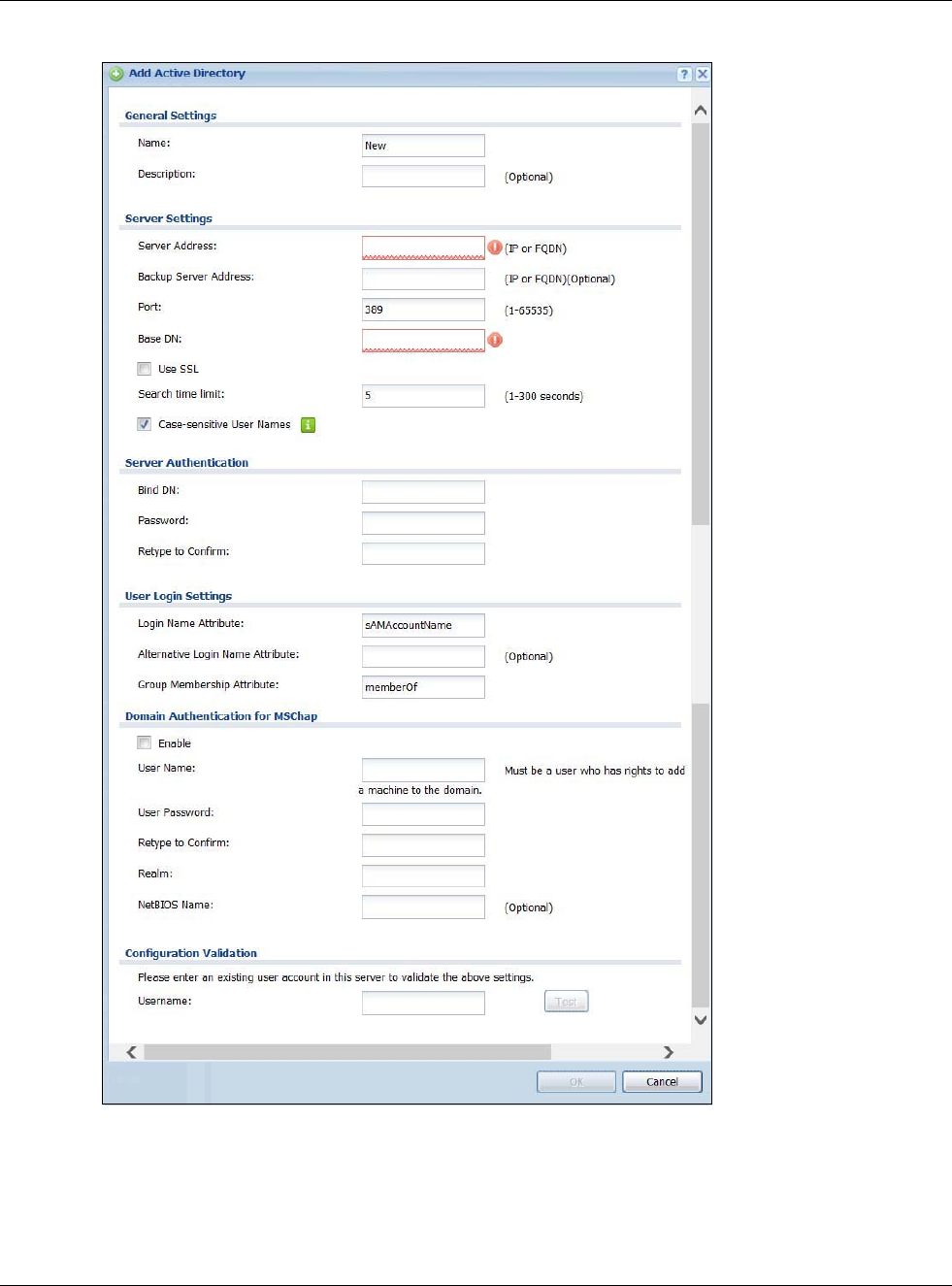
Chapter 29 Object
USG20(W)-VPN Series User’s Guide
506
Figure 345 Configuration > Object > AAA Server > Active Directory (or LDAP) > Add

Chapter 29 Object
USG20(W)-VPN Series User’s Guide
507
The following table describes the labels in this screen.
Table 213 Configuration > Object > AAA Server > Active Directory (or LDAP) > Add
LABEL DESCRIPTION
Name Enter a descriptive name (up to 63 alphanumerical characters) for identification
purposes.
Description Enter the description of each server, if any. You can use up to 60 printable ASCII
characters.
Server Address Enter the address of the AD or LDAP server.
Backup Server
Address
If the AD or LDAP server has a backup server, enter its address here.
Port Specify the port number on the AD or LDAP server to which the USG sends authentication
requests. Enter a number between 1 and 65535.
This port number should be the same on all AD or LDAP server(s) in this group.
Base DN Specify the directory (up to 127 alphanumerical characters). For example, o=ZyXEL,
c=US.
This is only for LDAP.
Use SSL Select Use SSL to establish a secure connection to the AD or LDAP server(s).
Search time limit Specify the timeout period (between 1 and 300 seconds) before the USG disconnects
from the AD or LDAP server. In this case, user authentication fails.
Search timeout occurs when either the user information is not in the AD or LDAP
server(s) or the AD or LDAP server(s) is down.
Case-sensitive
User Names
Select this if the server checks the case of the usernames.
Bind DN Specify the bind DN for logging into the AD or LDAP server. Enter up to 127
alphanumerical characters.
For example, cn=zywallAdmin specifies zywallAdmin as the user name.
Password If required, enter the password (up to 15 alphanumerical characters) for the USG to bind
(or log in) to the AD or LDAP server.
Retype to Confirm Retype your new password for confirmation.
Login Name
Attribute
Enter the type of identifier the users are to use to log in. For example “name” or “e-mail
address”.
Alternative Login
Name Attribute
If there is a second type of identifier that the users can use to log in, enter it here. For
example “name” or “e-mail address”.
Group
Membership
Attribute
An AD or LDAP server defines attributes for its accounts. Enter the name of the attribute
that the USG is to check to determine to which group a user belongs. The value for this
attribute is called a group identifier; it determines to which group a user belongs. You can
add ext-group-user user objects to identify groups based on these group identifier
values.
For example you could have an attribute named “memberOf” with values like “sales”,
“RD”, and “management”. Then you could also create a ext-group-user user object for
each group. One with “sales” as the group identifier, another for “RD” and a third for
“management”.
Domain
Authentication for
MSChap
Select the Enable checkbox to enable domain authentication for MSChap.
This is only for Active Directory.
User Name Enter the user name for the user who has rights to add a machine to the domain.
This is only for Active Directory.
User Password Enter the password for the associated user name.
This is only for Active Directory.
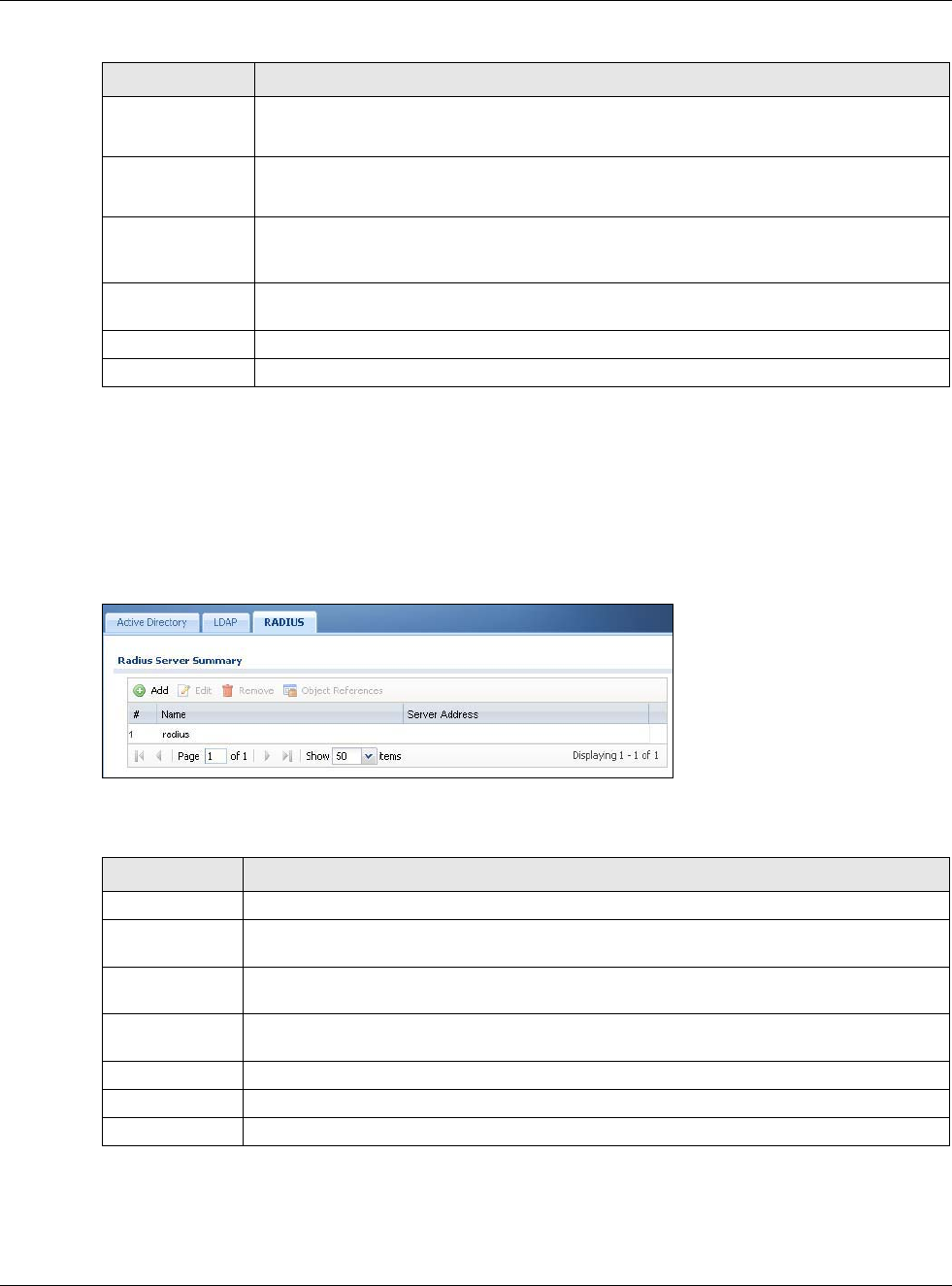
Chapter 29 Object
USG20(W)-VPN Series User’s Guide
508
29.8.6 RADIUS Server Summary
Use the RADIUS screen to manage the list of RADIUS servers the USG can use in authenticating
users.
Click Configuration > Object > AAA Server > RADIUS to display the RADIUS screen.
Figure 346 Configuration > Object > AAA Server > RADIUS
The following table describes the labels in this screen.
Retype to Confirm Retype your new password for confirmation.
This is only for Active Directory.
Realm Enter the realm FQDN.
This is only for Active Directory.
NetBIOS Name Type the NetBIOS name. This field is optional. NetBIOS packets are TCP or UDP packets
that enable a computer to connect to and communicate with a LAN which allows local
computers to find computers on the remote network and vice versa.
Configuration
Validation
Use a user account from the server specified above to test if the configuration is correct.
Enter the account’s user name in the Username field and click Test.
OK Click OK to save the changes.
Cancel Click Cancel to discard the changes.
Table 213 Configuration > Object > AAA Server > Active Directory (or LDAP) > Add (continued)
LABEL DESCRIPTION
Table 214 Configuration > Object > AAA Server > RADIUS
LABEL DESCRIPTION
Add Click this to create a new entry.
Edit Double-click an entry or select it and click Edit to open a screen where you can modify the
entry’s settings.
Remove To remove an entry, select it and click Remove. The USG confirms you want to remove it
before doing so.
Object
References
Select an entry and click Object References to open a screen that shows which settings
use the entry.
# This field displays the index number.
Name This is the name of the RADIUS server entry.
Server Address This is the address of the AD or LDAP server.
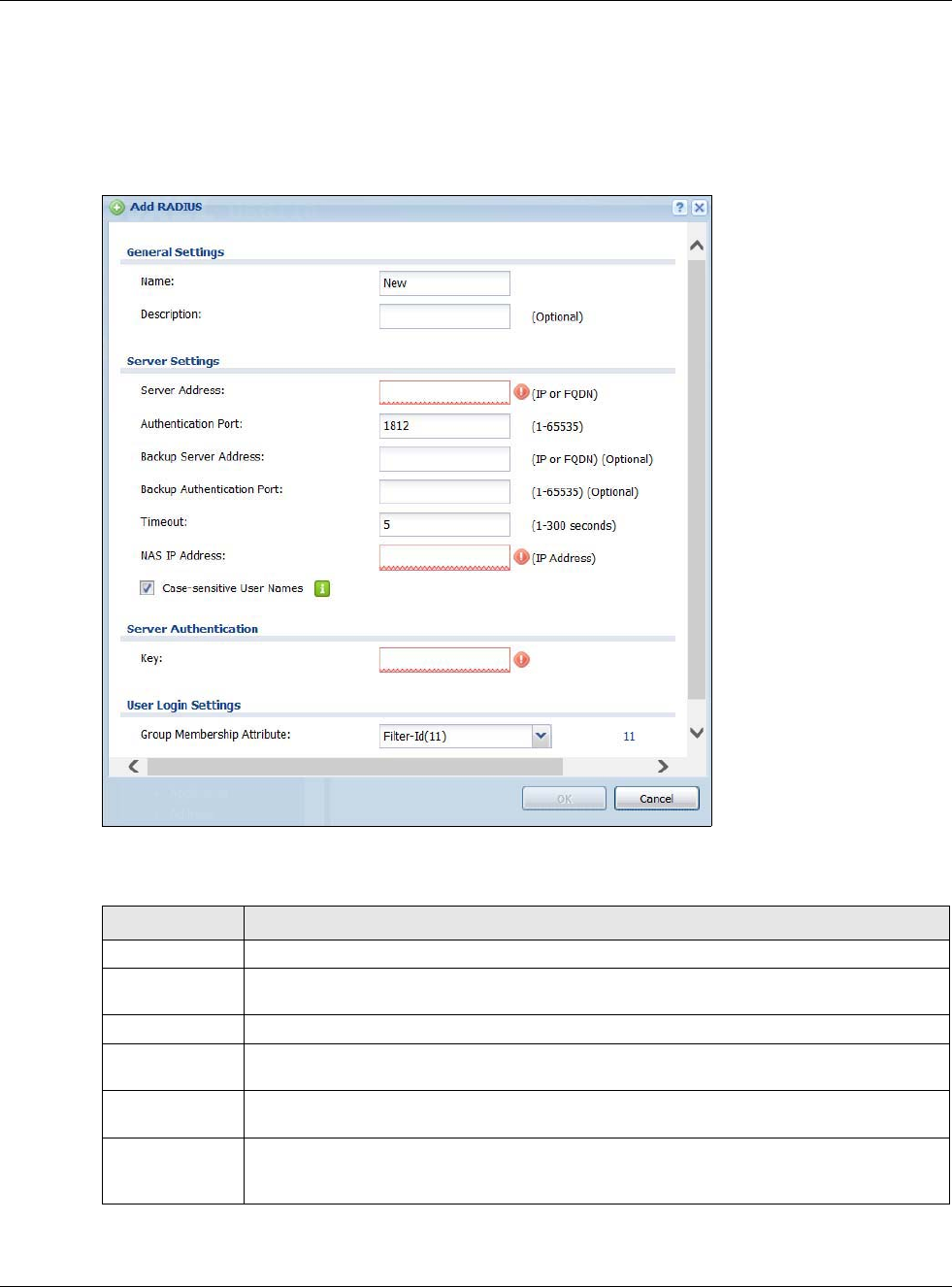
Chapter 29 Object
USG20(W)-VPN Series User’s Guide
509
29.8.6.1 Adding a RADIUS Server
Click Configuration > Object > AAA Server > RADIUS to display the RADIUS screen. Click the
Add icon or an Edit icon to display the following screen. Use this screen to create a new AD or
LDAP entry or edit an existing one.
Figure 347 Configuration > Object > AAA Server > RADIUS > Add
The following table describes the labels in this screen.
Table 215 Configuration > Object > AAA Server > RADIUS > Add
LABEL DESCRIPTION
Name Enter a descriptive name (up to 63 alphanumerical characters) for identification purposes.
Description Enter the description of each server, if any. You can use up to 60 printable ASCII
characters.
Server Address Enter the address of the RADIUS server.
Authentication
Port
Specify the port number on the RADIUS server to which the USG sends authentication
requests. Enter a number between 1 and 65535.
Backup Server
Address
If the RADIUS server has a backup server, enter its address here.
Backup
Authentication
Port
Specify the port number on the RADIUS server to which the USG sends authentication
requests. Enter a number between 1 and 65535.

Chapter 29 Object
USG20(W)-VPN Series User’s Guide
510
29.9 Auth. Method Overview
Authentication method objects set how the USG authenticates wireless, HTTP/HTTPS clients, and
peer IPSec routers (extended authentication) clients. Configure authentication method objects to
have the USG use the local user database, and/or the authentication servers and authentication
server groups specified by AAA server objects. By default, user accounts created and stored on the
USG are authenticated locally.
•Use the Configuration > Object > Auth. Method screens (Section 29.9.3 on page 511) to
create and manage authentication method objects.
29.9.1 Before You Begin
Configure AAA server objects before you configure authentication method objects.
29.9.2 Example: Selecting a VPN Authentication Method
After you set up an authentication method object in the Auth. Method screens, you can use it in
the VPN Gateway screen to authenticate VPN users for establishing a VPN connection. Refer to the
chapter on VPN for more information.
Follow the steps below to specify the authentication method for a VPN connection.
Timeout Specify the timeout period (between 1 and 300 seconds) before the USG disconnects from
the RADIUS server. In this case, user authentication fails.
Search timeout occurs when either the user information is not in the RADIUS server or the
RADIUS server is down.
NAS IP Address Type the IP address of the NAS (Network Access Server).
Case-sensitive
User Names
Select this if you want configure your username as case-sensitive.
Key Enter a password (up to 15 alphanumeric characters) as the key to be shared between the
external authentication server and the USG.
The key is not sent over the network. This key must be the same on the external
authentication server and the USG.
Group
Membership
Attribute
A RADIUS server defines attributes for its accounts. Select the name and number of the
attribute that the USG is to check to determine to which group a user belongs. If it does
not display, select user-defined and specify the attribute’s number.
This attribute’s value is called a group identifier; it determines to which group a user
belongs. You can add ext-group-user user objects to identify groups based on these
group identifier values.
For example you could have an attribute named “memberOf” with values like “sales”, “RD”,
and “management”. Then you could also create a ext-group-user user object for each
group. One with “sales” as the group identifier, another for “RD” and a third for
“management”.
OK Click OK to save the changes.
Cancel Click Cancel to discard the changes.
Table 215 Configuration > Object > AAA Server > RADIUS > Add (continued)
LABEL DESCRIPTION
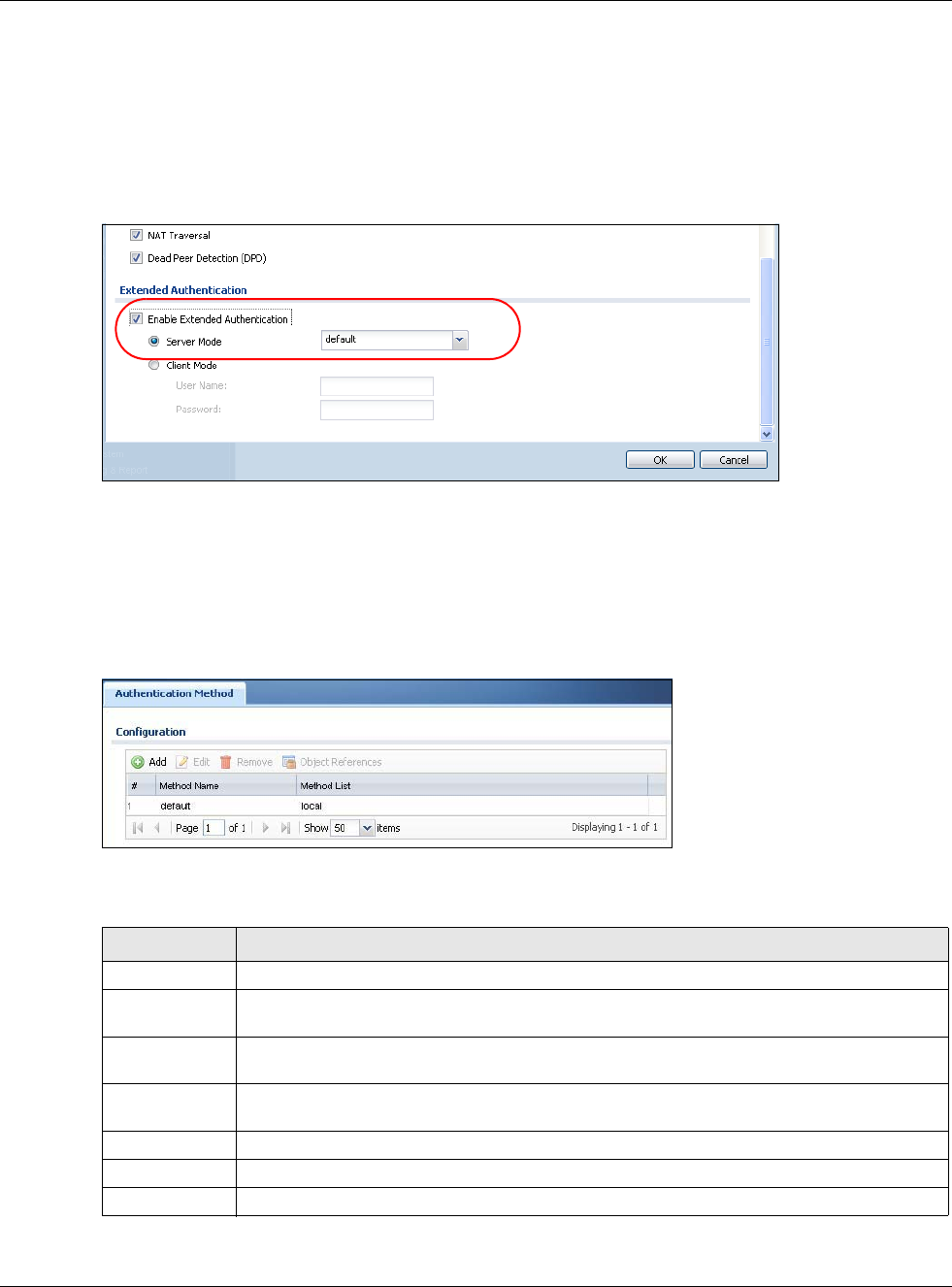
Chapter 29 Object
USG20(W)-VPN Series User’s Guide
511
1Access the Configuration > VPN > IPSec VPN > VPN Gateway > Edit screen.
2Click Show Advance Setting and select Enable Extended Authentication.
3Select Server Mode and select an authentication method object from the drop-down list box.
4Click OK to save the settings.
Figure 348 Example: Using Authentication Method in VPN
29.9.3 Authentication Method Objects
Click Configuration > Object > Auth. Method to display the screen as shown.
Note: You can create up to 16 authentication method objects.
Figure 349 Configuration > Object > Auth. Method
The following table describes the labels in this screen.
Table 216 Configuration > Object > Auth. Method
LABEL DESCRIPTION
Add Click this to create a new entry.
Edit Double-click an entry or select it and click Edit to open a screen where you can modify the
entry’s settings.
Remove To remove an entry, select it and click Remove. The USG confirms you want to remove it
before doing so.
Object
References
Select an entry and click Object References to open a screen that shows which settings
use the entry.
# This field displays the index number.
Method Name This field displays a descriptive name for identification purposes.
Method List This field displays the authentication method(s) for this entry.
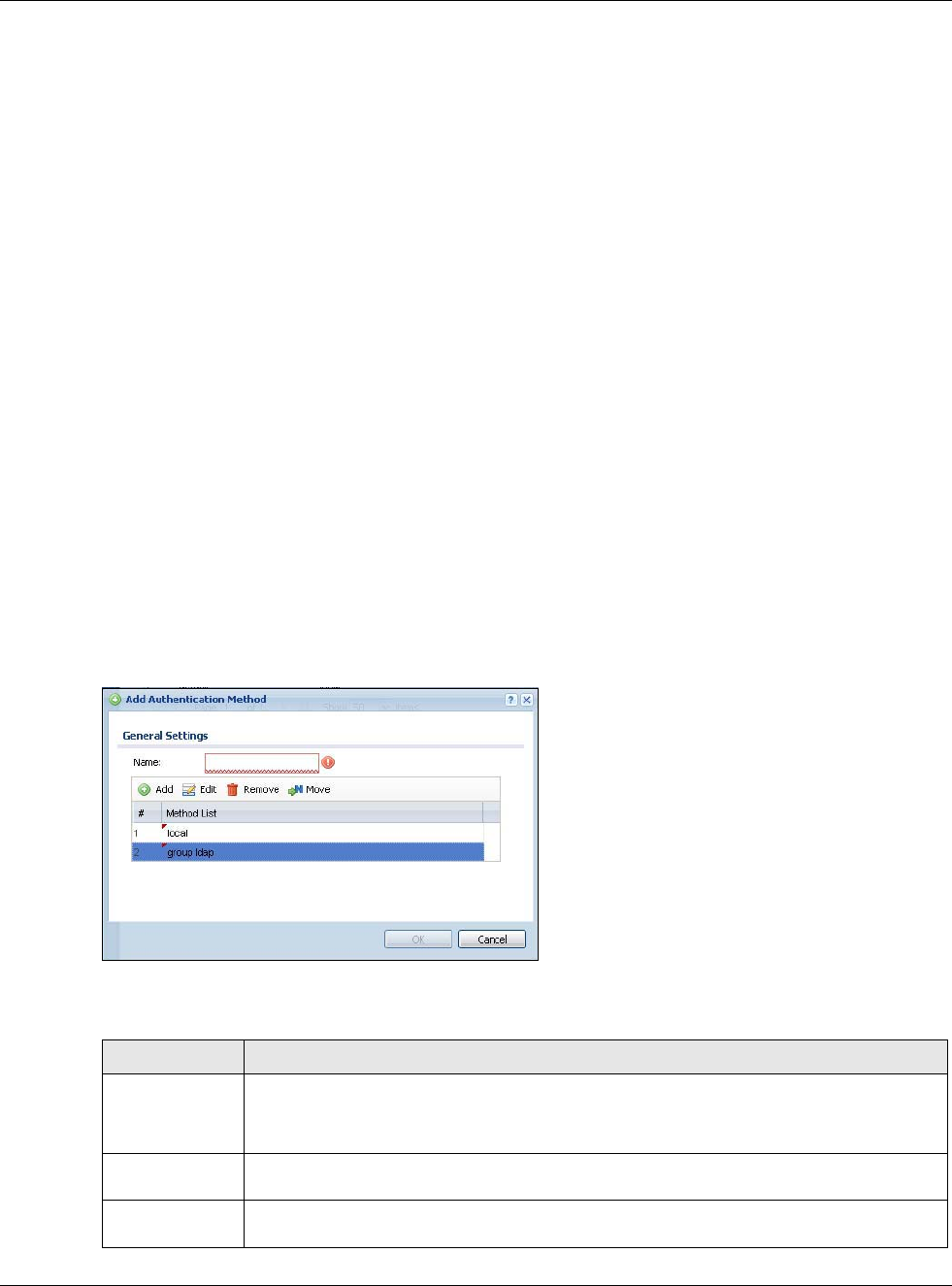
Chapter 29 Object
USG20(W)-VPN Series User’s Guide
512
29.9.3.1 Creating an Authentication Method Object
Follow the steps below to create an authentication method object.
1Click Configuration > Object > Auth. Method.
2Click Add.
3Specify a descriptive name for identification purposes in the Name field. You may use 1-31
alphanumeric characters, underscores(_), or dashes (-), but the first character cannot be a number.
This value is case-sensitive. For example, “My_Device”.
4Click Add to insert an authentication method in the table.
5Select a server object from the Method List drop-down list box.
6You can add up to four server objects to the table. The ordering of the Method List column is
important. The USG authenticates the users using the databases (in the local user database or the
external authentication server) in the order they appear in this screen.
If two accounts with the same username exist on two authentication servers you specify, the USG
does not continue the search on the second authentication server when you enter the username
and password that doesn’t match the one on the first authentication server.
Note: You can NOT select two server objects of the same type.
7Click OK to save the settings or click Cancel to discard all changes and return to the previous
screen.
Figure 350 Configuration > Object > Auth. Method > Add
The following table describes the labels in this screen.
Table 217 Configuration > Object > Auth. Method > Add
LABEL DESCRIPTION
Name Specify a descriptive name for identification purposes.
You may use 1-31 alphanumeric characters, underscores(_), or dashes (-), but the first
character cannot be a number. This value is case-sensitive. For example, “My_Device”.
Add Click this to create a new entry. Select an entry and click Add to create a new entry after
the selected entry.
Edit Double-click an entry or select it and click Edit to open a screen where you can modify the
entry’s settings.
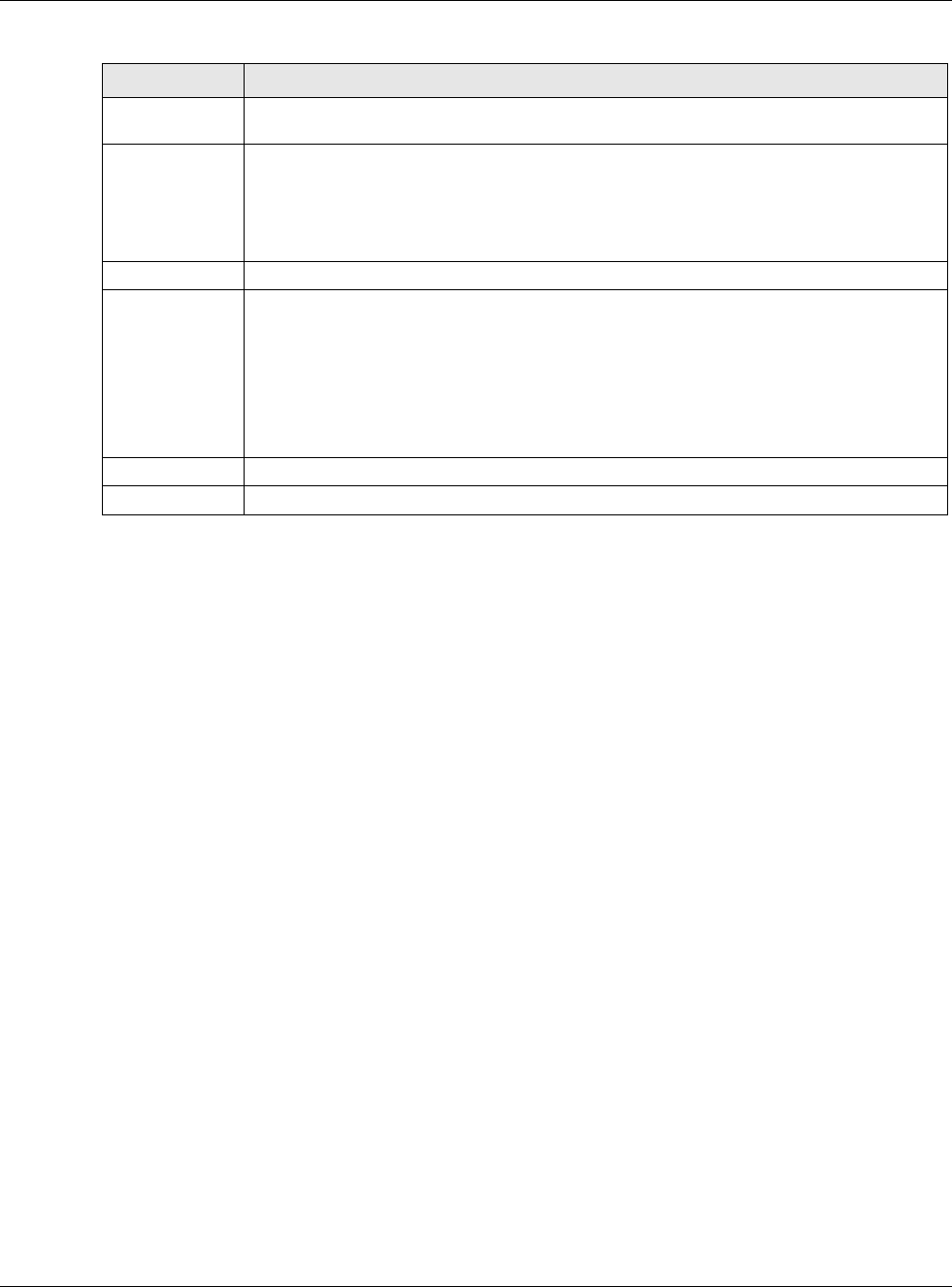
Chapter 29 Object
USG20(W)-VPN Series User’s Guide
513
29.10 Certificate Overview
The USG can use certificates (also called digital IDs) to authenticate users. Certificates are based
on public-private key pairs. A certificate contains the certificate owner’s identity and public key.
Certificates provide a way to exchange public keys for use in authentication.
•Use the My Certificates screens (see Section 29.10.3 on page 516 to Section 29.10.3.3 on page
522) to generate and export self-signed certificates or certification requests and import the CA-
signed certificates.
•Use the Trusted Certificates screens (see Section 29.10.4 on page 523 to Section 29.10.4.2 on
page 527) to save CA certificates and trusted remote host certificates to the USG. The USG trusts
any valid certificate that you have imported as a trusted certificate. It also trusts any valid
certificate signed by any of the certificates that you have imported as a trusted certificate.
29.10.1 What You Need to Know
When using public-key cryptology for authentication, each host has two keys. One key is public and
can be made openly available. The other key is private and must be kept secure.
These keys work like a handwritten signature (in fact, certificates are often referred to as “digital
signatures”). Only you can write your signature exactly as it should look. When people know what
your signature looks like, they can verify whether something was signed by you, or by someone
else. In the same way, your private key “writes” your digital signature and your public key allows
people to verify whether data was signed by you, or by someone else. This process works as
follows.
Remove To remove an entry, select it and click Remove. The USG confirms you want to remove it
before doing so.
Move To change a method’s position in the numbered list, select the method and click Move to
display a field to type a number for where you want to put it and press [ENTER] to move
the rule to the number that you typed.
The ordering of your methods is important as USG authenticates the users using the
authentication methods in the order they appear in this screen.
# This field displays the index number.
Method List Select a server object from the drop-down list box. You can create a server object in the
AAA Server screen.
The USG authenticates the users using the databases (in the local user database or the
external authentication server) in the order they appear in this screen.
If two accounts with the same username exist on two authentication servers you specify,
the USG does not continue the search on the second authentication server when you enter
the username and password that doesn’t match the one on the first authentication server.
OK Click OK to save the changes.
Cancel Click Cancel to discard the changes.
Table 217 Configuration > Object > Auth. Method > Add (continued)
LABEL DESCRIPTION

Chapter 29 Object
USG20(W)-VPN Series User’s Guide
514
1Tim wants to send a message to Jenny. He needs her to be sure that it comes from him, and that
the message content has not been altered by anyone else along the way. Tim generates a public
key pair (one public key and one private key).
2Tim keeps the private key and makes the public key openly available. This means that anyone who
receives a message seeming to come from Tim can read it and verify whether it is really from him
or not.
3Tim uses his private key to sign the message and sends it to Jenny.
4Jenny receives the message and uses Tim’s public key to verify it. Jenny knows that the message is
from Tim, and that although other people may have been able to read the message, no-one can
have altered it (because they cannot re-sign the message with Tim’s private key).
5Additionally, Jenny uses her own private key to sign a message and Tim uses Jenny’s public key to
verify the message.
The USG uses certificates based on public-key cryptology to authenticate users attempting to
establish a connection, not to encrypt the data that you send after establishing a connection. The
method used to secure the data that you send through an established connection depends on the
type of connection. For example, a VPN tunnel might use the triple DES encryption algorithm.
The certification authority uses its private key to sign certificates. Anyone can then use the
certification authority’s public key to verify the certificates.
A certification path is the hierarchy of certification authority certificates that validate a certificate.
The USG does not trust a certificate if any certificate on its path has expired or been revoked.
Certification authorities maintain directory servers with databases of valid and revoked certificates.
A directory of certificates that have been revoked before the scheduled expiration is called a CRL
(Certificate Revocation List). The USG can check a peer’s certificate against a directory server’s list
of revoked certificates. The framework of servers, software, procedures and policies that handles
keys is called PKI (public-key infrastructure).
Advantages of Certificates
Certificates offer the following benefits.
• The USG only has to store the certificates of the certification authorities that you decide to trust,
no matter how many devices you need to authenticate.
• Key distribution is simple and very secure since you can freely distribute public keys and you
never need to transmit private keys.
Self-signed Certificates
You can have the USG act as a certification authority and sign its own certificates.
Factory Default Certificate
The USG generates its own unique self-signed certificate when you first turn it on. This certificate is
referred to in the GUI as the factory default certificate.
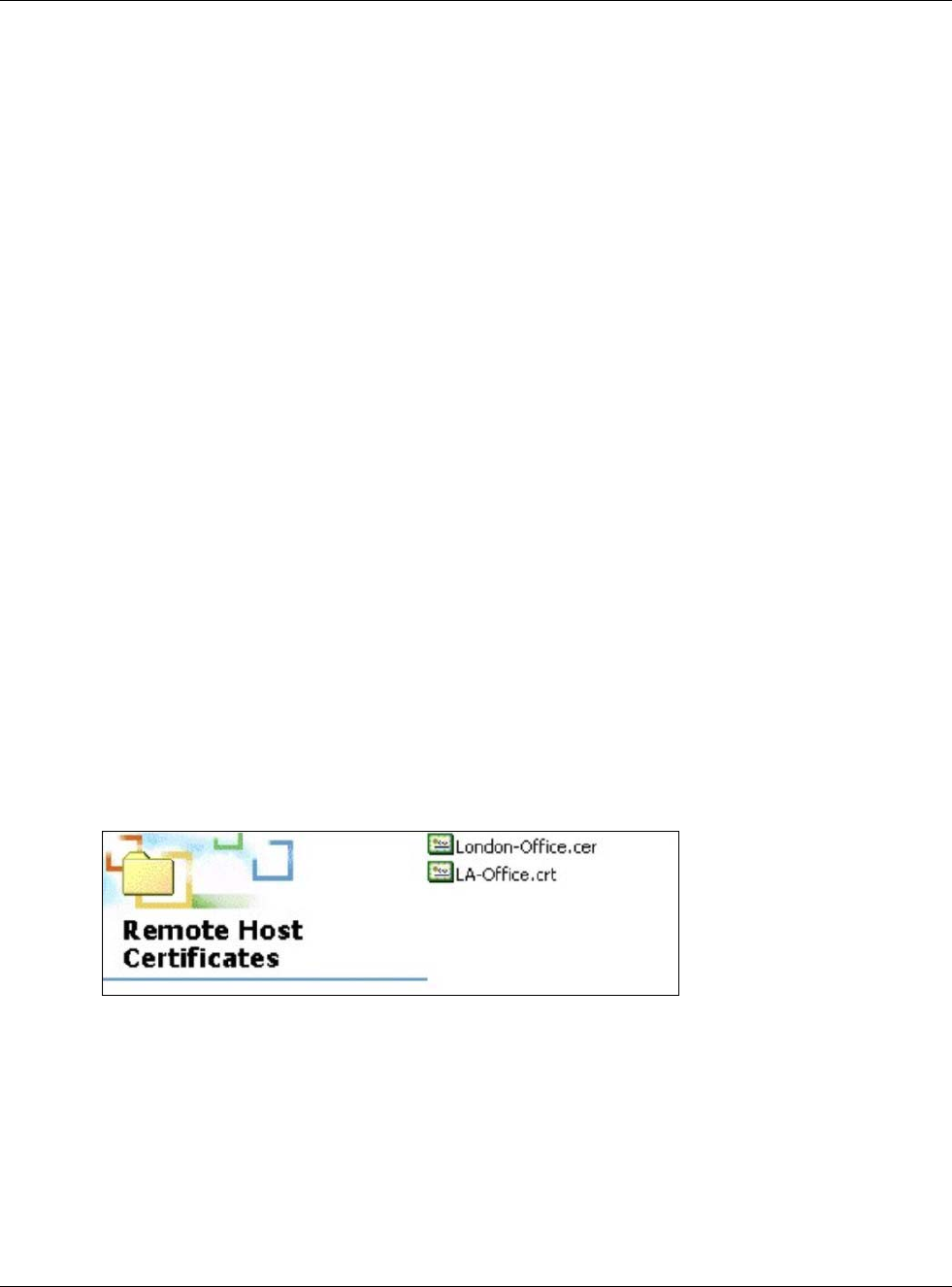
Chapter 29 Object
USG20(W)-VPN Series User’s Guide
515
Certificate File Formats
Any certificate that you want to import has to be in one of these file formats:
• Binary X.509: This is an ITU-T recommendation that defines the formats for X.509 certificates.
• PEM (Base-64) encoded X.509: This Privacy Enhanced Mail format uses lowercase letters,
uppercase letters and numerals to convert a binary X.509 certificate into a printable form.
• Binary PKCS#7: This is a standard that defines the general syntax for data (including digital
signatures) that may be encrypted. A PKCS #7 file is used to transfer a public key certificate. The
private key is not included. The USG currently allows the importation of a PKS#7 file that
contains a single certificate.
• PEM (Base-64) encoded PKCS#7: This Privacy Enhanced Mail (PEM) format uses lowercase
letters, uppercase letters and numerals to convert a binary PKCS#7 certificate into a printable
form.
• Binary PKCS#12: This is a format for transferring public key and private key certificates. The
private key in a PKCS #12 file is within a password-encrypted envelope. The file’s password is not
connected to your certificate’s public or private passwords. Exporting a PKCS #12 file creates this
and you must provide it to decrypt the contents when you import the file into the USG.
Note: Be careful not to convert a binary file to text during the transfer process. It is easy
for this to occur since many programs use text files by default.
29.10.2 Verifying a Certificate
Before you import a trusted certificate into the USG, you should verify that you have the correct
certificate. You can do this using the certificate’s fingerprint. A certificate’s fingerprint is a message
digest calculated using the MD5 or SHA1 algorithm. The following procedure describes how to check
a certificate’s fingerprint to verify that you have the actual certificate.
1Browse to where you have the certificate saved on your computer.
2Make sure that the certificate has a “.cer” or “.crt” file name extension.
Figure 351 Remote Host Certificates
3Double-click the certificate’s icon to open the Certificate window. Click the Details tab and scroll
down to the Thumbprint Algorithm and Thumbprint fields.
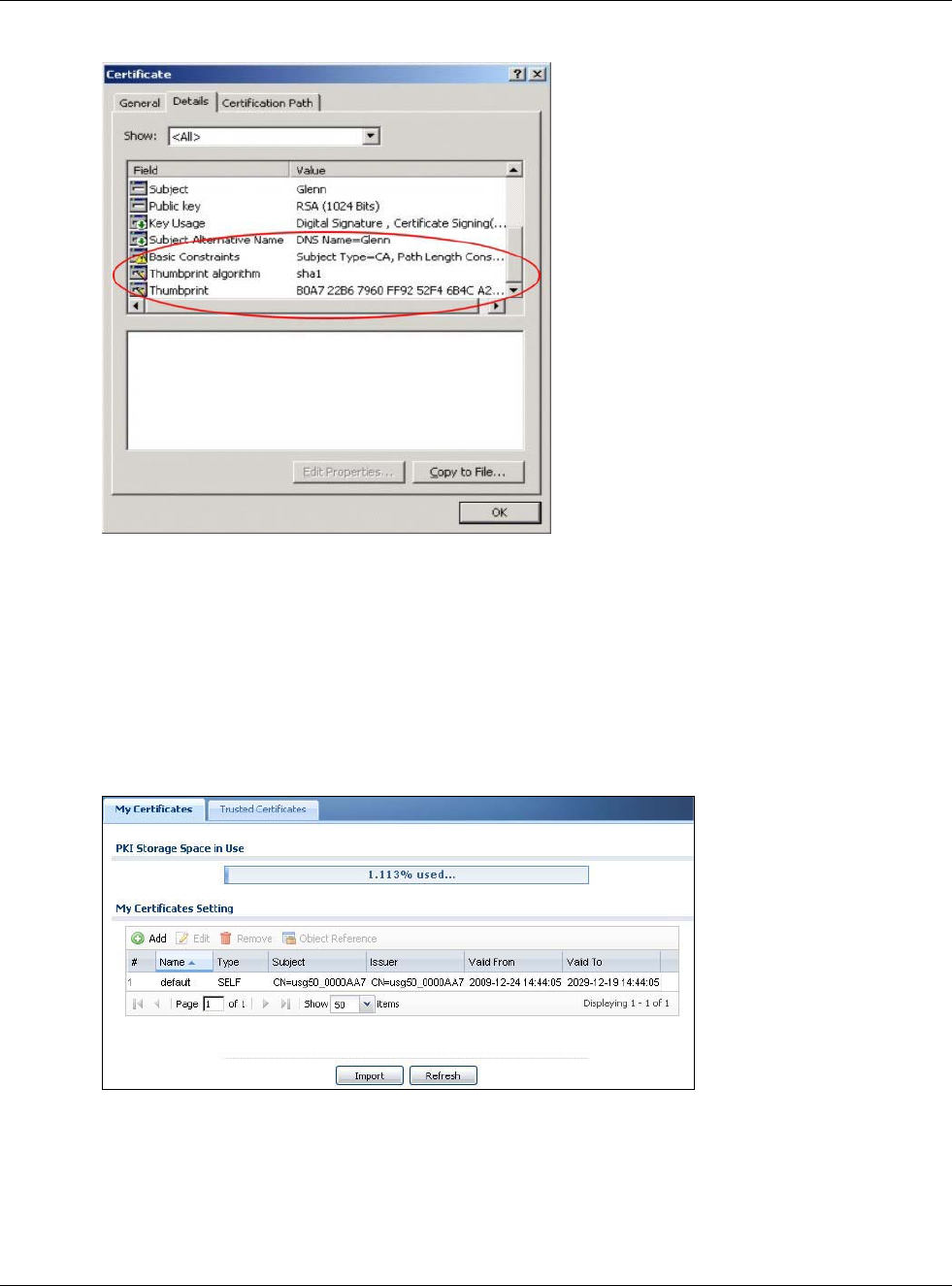
Chapter 29 Object
USG20(W)-VPN Series User’s Guide
516
Figure 352 Certificate Details
4Use a secure method to verify that the certificate owner has the same information in the
Thumbprint Algorithm and Thumbprint fields. The secure method may very based on your
situation. Possible examples would be over the telephone or through an HTTPS connection.
29.10.3 The My Certificates Screen
Click Configuration > Object > Certificate > My Certificates to open the My Certificates
screen. This is the USG’s summary list of certificates and certification requests.
Figure 353 Configuration > Object > Certificate > My Certificates

Chapter 29 Object
USG20(W)-VPN Series User’s Guide
517
The following table describes the labels in this screen.
29.10.3.1 The My Certificates Add Screen
Click Configuration > Object > Certificate > My Certificates and then the Add icon to open
the My Certificates Add screen. Use this screen to have the USG create a self-signed certificate,
enroll a certificate with a certification authority or generate a certification request.
Table 218 Configuration > Object > Certificate > My Certificates
LABEL DESCRIPTION
PKI Storage
Space in Use
This bar displays the percentage of the USG’s PKI storage space that is currently in use.
When the storage space is almost full, you should consider deleting expired or
unnecessary certificates before adding more certificates.
Add Click this to go to the screen where you can have the USG generate a certificate or a
certification request.
Edit Double-click an entry or select it and click Edit to open a screen with an in-depth list of
information about the certificate.
Remove The USG keeps all of your certificates unless you specifically delete them. Uploading a
new firmware or default configuration file does not delete your certificates. To remove an
entry, select it and click Remove. The USG confirms you want to remove it before doing
so. Subsequent certificates move up by one when you take this action.
Object References You cannot delete certificates that any of the USG’s features are configured to use. Select
an entry and click Object References to open a screen that shows which settings use
the entry.
# This field displays the certificate index number. The certificates are listed in alphabetical
order.
Name This field displays the name used to identify this certificate. It is recommended that you
give each certificate a unique name.
Type This field displays what kind of certificate this is.
REQ represents a certification request and is not yet a valid certificate. Send a
certification request to a certification authority, which then issues a certificate. Use the
My Certificate Import screen to import the certificate and replace the request.
SELF represents a self-signed certificate.
CERT represents a certificate issued by a certification authority.
Subject This field displays identifying information about the certificate’s owner, such as CN
(Common Name), OU (Organizational Unit or department), O (Organization or company)
and C (Country). It is recommended that each certificate have unique subject
information.
Issuer This field displays identifying information about the certificate’s issuing certification
authority, such as a common name, organizational unit or department, organization or
company and country. With self-signed certificates, this is the same information as in the
Subject field.
Valid From This field displays the date that the certificate becomes applicable.
Valid To This field displays the date that the certificate expires. The text displays in red and
includes an Expired! message if the certificate has expired.
Import Click Import to open a screen where you can save a certificate to the USG.
Refresh Click Refresh to display the current validity status of the certificates.
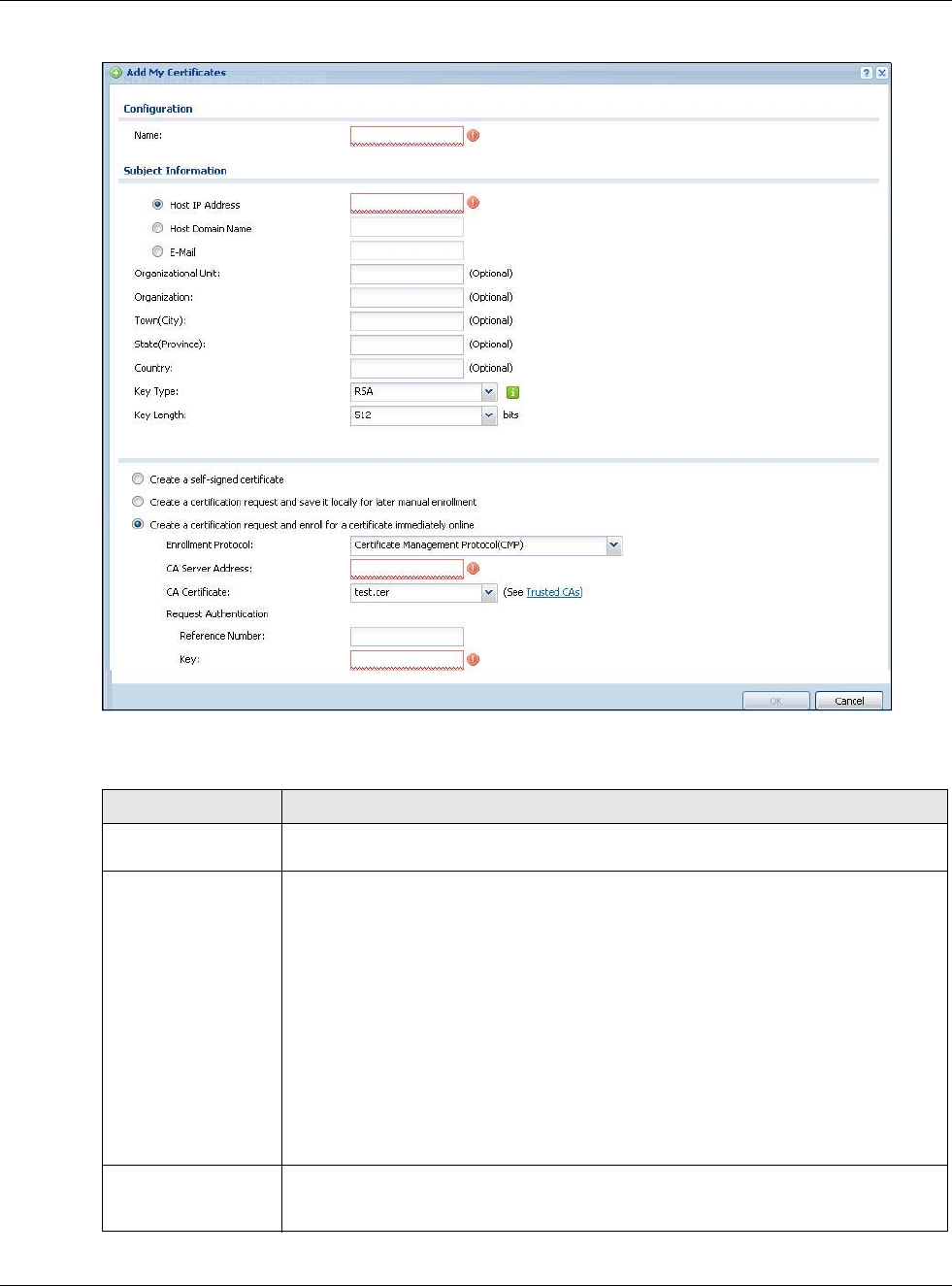
Chapter 29 Object
USG20(W)-VPN Series User’s Guide
518
Figure 354 Configuration > Object > Certificate > My Certificates > Add
The following table describes the labels in this screen.
Table 219 Configuration > Object > Certificate > My Certificates > Add
LABEL DESCRIPTION
Name Type a name to identify this certificate. You can use up to 31 alphanumeric and
;‘~!@#$%^&()_+[]{}’,.=- characters.
Subject Information Use these fields to record information that identifies the owner of the certificate. You
do not have to fill in every field, although you must specify a Host IP Address, Host
IPv6 Address, Host Domain Name, or E-Mail. The certification authority may add
fields (such as a serial number) to the subject information when it issues a certificate.
It is recommended that each certificate have unique subject information.
Select a radio button to identify the certificate’s owner by IP address, domain name or
e-mail address. Type the IP address (in dotted decimal notation), domain name or e-
mail address in the field provided. The domain name or e-mail address is for
identification purposes only and can be any string.
A domain name can be up to 255 characters. You can use alphanumeric characters,
the hyphen and periods.
An e-mail address can be up to 63 characters. You can use alphanumeric characters,
the hyphen, the @ symbol, periods and the underscore.
Organizational Unit Identify the organizational unit or department to which the certificate owner belongs.
You can use up to 31 characters. You can use alphanumeric characters, the hyphen
and the underscore.

Chapter 29 Object
USG20(W)-VPN Series User’s Guide
519
If you configured the My Certificate Create screen to have the USG enroll a certificate and the
certificate enrollment is not successful, you see a screen with a Return button that takes you back
to the My Certificate Create screen. Click Return and check your information in the My
Certificate Create screen. Make sure that the certification authority information is correct and that
your Internet connection is working properly if you want the USG to enroll a certificate online.
Organization Identify the company or group to which the certificate owner belongs. You can use up
to 31 characters. You can use alphanumeric characters, the hyphen and the
underscore.
Town (City) Identify the town or city where the certificate owner is located. You can use up to 31
characters. You can use alphanumeric characters, the hyphen and the underscore.
State, (Province) Identify the state or province where the certificate owner is located. You can use up to
31 characters. You can use alphanumeric characters, the hyphen and the underscore.
Country Identify the nation where the certificate owner is located. You can use up to 31
characters. You can use alphanumeric characters, the hyphen and the underscore.
Key Type Select RSA to use the Rivest, Shamir and Adleman public-key algorithm.
Select DSA to use the Digital Signature Algorithm public-key algorithm.
Key Length Select a number from the drop-down list box to determine how many bits the key
should use (512 to 2048). The longer the key, the more secure it is. A longer key also
uses more PKI storage space.
Extended Key Usage
Server Authentication Select this to have USG generate and store a request for server authentication
certificate.
Client Authentication Select this to have USG generate and store a request for client authentication
certificate.
IKE Intermediate Select this to have USG generate and store a request for IKE Intermediate
authentication certificate.
Create a self-signed
certificate
Select this to have the USG generate the certificate and act as the Certification
Authority (CA) itself. This way you do not need to apply to a certification authority for
certificates.
Create a certification
request and save it
locally for later
manual enrollment
Select this to have the USG generate and store a request for a certificate. Use the My
Certificate Details screen to view the certification request and copy it to send to the
certification authority.
Copy the certification request from the My Certificate Details screen (see Section
29.10.3.2 on page 520) and then send it to the certification authority.
Create a certification
request and enroll for
a certificate
immediately online
Select this to have the USG generate a request for a certificate and apply to a
certification authority for a certificate.
You must have the certification authority’s certificate already imported in the Trusted
Certificates screen.
When you select this option, you must select the certification authority’s enrollment
protocol and the certification authority’s certificate from the drop-down list boxes and
enter the certification authority’s server address. You also need to fill in the
Reference Number and Key if the certification authority requires them.
OK Click OK to begin certificate or certification request generation.
Cancel Click Cancel to quit and return to the My Certificates screen.
Table 219 Configuration > Object > Certificate > My Certificates > Add (continued)
LABEL DESCRIPTION
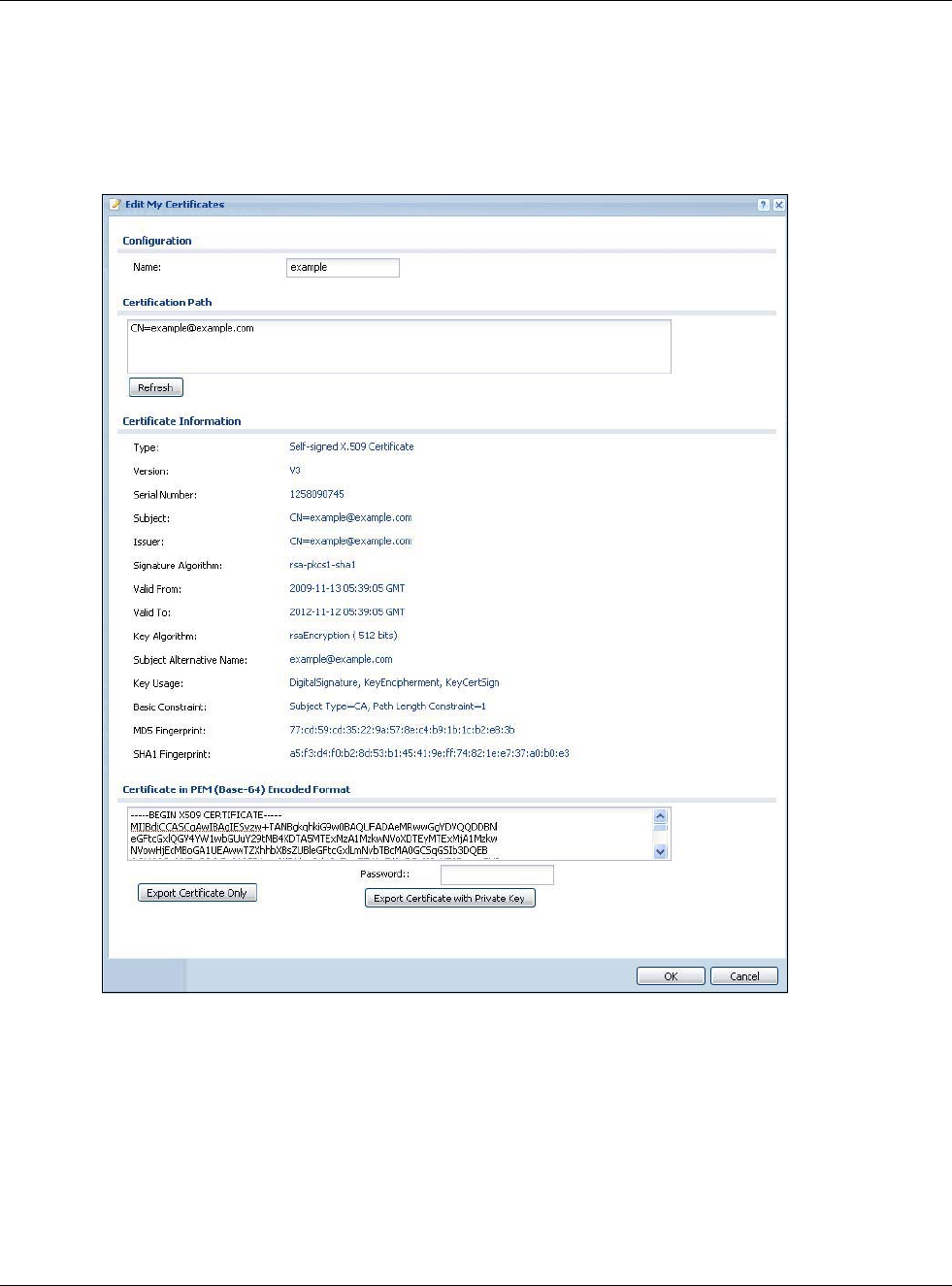
Chapter 29 Object
USG20(W)-VPN Series User’s Guide
520
29.10.3.2 The My Certificates Edit Screen
Click Configuration > Object > Certificate > My Certificates and then the Edit icon to open
the My Certificate Edit screen. You can use this screen to view in-depth certificate information
and change the certificate’s name.
Figure 355 Configuration > Object > Certificate > My Certificates > Edit

Chapter 29 Object
USG20(W)-VPN Series User’s Guide
521
The following table describes the labels in this screen.
Table 220 Configuration > Object > Certificate > My Certificates > Edit
LABEL DESCRIPTION
Name This field displays the identifying name of this certificate. You can use up to 31
alphanumeric and ;‘~!@#$%^&()_+[]{}’,.=- characters.
Certification Path This field displays for a certificate, not a certification request.
Click the Refresh button to have this read-only text box display the hierarchy of
certification authorities that validate the certificate (and the certificate itself).
If the issuing certification authority is one that you have imported as a trusted
certification authority, it may be the only certification authority in the list (along with
the certificate itself). If the certificate is a self-signed certificate, the certificate itself is
the only one in the list. The USG does not trust the certificate and displays “Not
trusted” in this field if any certificate on the path has expired or been revoked.
Refresh Click Refresh to display the certification path.
Certificate
Information
These read-only fields display detailed information about the certificate.
Type This field displays general information about the certificate. CA-signed means that a
Certification Authority signed the certificate. Self-signed means that the certificate’s
owner signed the certificate (not a certification authority). “X.509” means that this
certificate was created and signed according to the ITU-T X.509 recommendation that
defines the formats for public-key certificates.
Version This field displays the X.509 version number.
Serial Number This field displays the certificate’s identification number given by the certification
authority or generated by the USG.
Subject This field displays information that identifies the owner of the certificate, such as
Common Name (CN), Organizational Unit (OU), Organization (O), State (ST), and
Country (C).
Issuer This field displays identifying information about the certificate’s issuing certification
authority, such as Common Name, Organizational Unit, Organization and Country.
With self-signed certificates, this is the same as the Subject Name field.
“none” displays for a certification request.
Signature Algorithm This field displays the type of algorithm that was used to sign the certificate. The USG
uses rsa-pkcs1-sha1 (RSA public-private key encryption algorithm and the SHA1 hash
algorithm). Some certification authorities may use rsa-pkcs1-md5 (RSA public-private
key encryption algorithm and the MD5 hash algorithm).
Valid From This field displays the date that the certificate becomes applicable. “none” displays for a
certification request.
Valid To This field displays the date that the certificate expires. The text displays in red and
includes an Expired! message if the certificate has expired. “none” displays for a
certification request.
Key Algorithm This field displays the type of algorithm that was used to generate the certificate’s key
pair (the USG uses RSA encryption) and the length of the key set in bits (1024 bits for
example).
Subject Alternative
Name
This field displays the certificate owner‘s IP address (IP), domain name (DNS) or e-mail
address (EMAIL).
Key Usage This field displays for what functions the certificate’s key can be used. For example,
“DigitalSignature” means that the key can be used to sign certificates and
“KeyEncipherment” means that the key can be used to encrypt text.
Basic Constraint This field displays general information about the certificate. For example, Subject
Type=CA means that this is a certification authority’s certificate and “Path Length
Constraint=1” means that there can only be one certification authority in the
certificate’s path. This field does not display for a certification request.

Chapter 29 Object
USG20(W)-VPN Series User’s Guide
522
29.10.3.3 The My Certificates Import Screen
Click Configuration > Object > Certificate > My Certificates > Import to open the My
Certificate Import screen. Follow the instructions in this screen to save an existing certificate to
the USG.
Note: You can import a certificate that matches a corresponding certification request that
was generated by the USG. You can also import a certificate in PKCS#12 format,
including the certificate’s public and private keys.
The certificate you import replaces the corresponding request in the My Certificates screen.
You must remove any spaces from the certificate’s filename before you can import it.
MD5 Fingerprint This is the certificate’s message digest that the USG calculated using the MD5
algorithm.
SHA1 Fingerprint This is the certificate’s message digest that the USG calculated using the SHA1
algorithm.
Certificate in PEM
(Base-64) Encoded
Format
This read-only text box displays the certificate or certification request in Privacy
Enhanced Mail (PEM) format. PEM uses lowercase letters, uppercase letters and
numerals to convert a binary certificate into a printable form.
You can copy and paste a certification request into a certification authority’s web page,
an e-mail that you send to the certification authority or a text editor and save the file
on a management computer for later manual enrollment.
You can copy and paste a certificate into an e-mail to send to friends or colleagues or
you can copy and paste a certificate into a text editor and save the file on a
management computer for later distribution (via floppy disk for example).
Export Certificate
Only
Use this button to save a copy of the certificate without its private key. Click this button
and then Save in the File Download screen. The Save As screen opens, browse to
the location that you want to use and click Save.
Password If you want to export the certificate with its private key, create a password and type it
here. Make sure you keep this password in a safe place. You will need to use it if you
import the certificate to another device.
Export Certificate
with Private Key
Use this button to save a copy of the certificate with its private key. Type the
certificate’s password and click this button. Click Save in the File Download screen.
The Save As screen opens, browse to the location that you want to use and click Save.
OK Click OK to save your changes back to the USG. You can only change the name.
Cancel Click Cancel to quit and return to the My Certificates screen.
Table 220 Configuration > Object > Certificate > My Certificates > Edit (continued)
LABEL DESCRIPTION
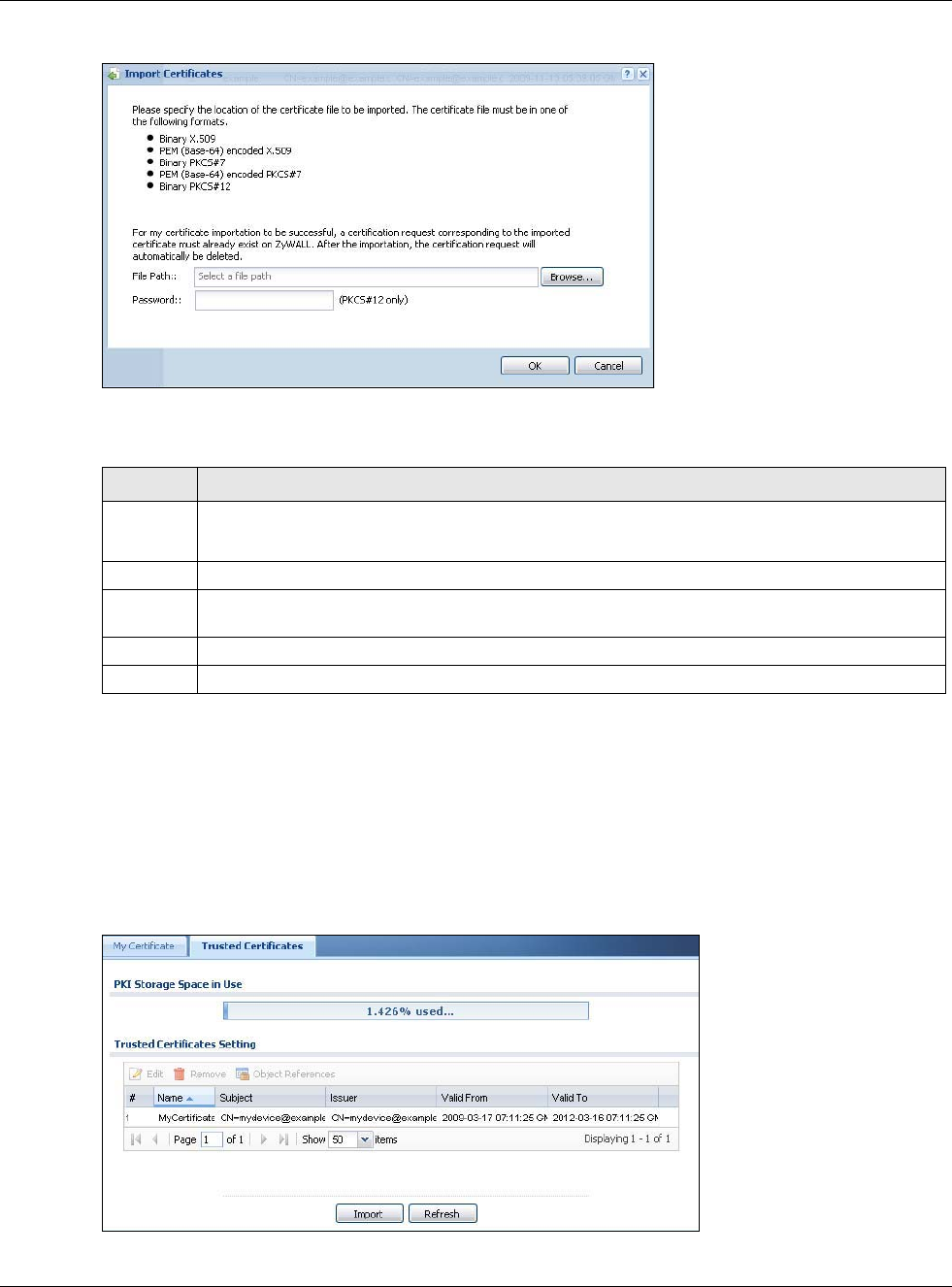
Chapter 29 Object
USG20(W)-VPN Series User’s Guide
523
Figure 356 Configuration > Object > Certificate > My Certificates > Import
The following table describes the labels in this screen.
29.10.4 The Trusted Certificates Screen
Click Configuration > Object > Certificate > Trusted Certificates to open the Trusted
Certificates screen. This screen displays a summary list of certificates that you have set the USG
to accept as trusted. The USG also accepts any valid certificate signed by a certificate on this list as
being trustworthy; thus you do not need to import any certificate that is signed by one of these
certificates.
Figure 357 Configuration > Object > Certificate > Trusted Certificates
Table 221 Configuration > Object > Certificate > My Certificates > Import
LABEL DESCRIPTION
File Path Type in the location of the file you want to upload in this field or click Browse to find it.
You cannot import a certificate with the same name as a certificate that is already in the USG.
Browse Click Browse to find the certificate file you want to upload.
Password This field only applies when you import a binary PKCS#12 format file. Type the file’s password
that was created when the PKCS #12 file was exported.
OK Click OK to save the certificate on the USG.
Cancel Click Cancel to quit and return to the My Certificates screen.

Chapter 29 Object
USG20(W)-VPN Series User’s Guide
524
The following table describes the labels in this screen.
29.10.4.1 The Trusted Certificates Edit Screen
Click Configuration > Object > Certificate > Trusted Certificates and then a certificate’s Edit
icon to open the Trusted Certificates Edit screen. Use this screen to view in-depth information
about the certificate, change the certificate’s name and set whether or not you want the USG to
check a certification authority’s list of revoked certificates before trusting a certificate issued by the
certification authority.
Table 222 Configuration > Object > Certificate > Trusted Certificates
LABEL DESCRIPTION
PKI Storage
Space in Use
This bar displays the percentage of the USG’s PKI storage space that is currently in use.
When the storage space is almost full, you should consider deleting expired or
unnecessary certificates before adding more certificates.
Edit Double-click an entry or select it and click Edit to open a screen with an in-depth list of
information about the certificate.
Remove The USG keeps all of your certificates unless you specifically delete them. Uploading a
new firmware or default configuration file does not delete your certificates. To remove an
entry, select it and click Remove. The USG confirms you want to remove it before doing
so. Subsequent certificates move up by one when you take this action.
Object
References
You cannot delete certificates that any of the USG’s features are configured to use. Select
an entry and click Object References to open a screen that shows which settings use
the entry.
# This field displays the certificate index number. The certificates are listed in alphabetical
order.
Name This field displays the name used to identify this certificate.
Subject This field displays identifying information about the certificate’s owner, such as CN
(Common Name), OU (Organizational Unit or department), O (Organization or company)
and C (Country). It is recommended that each certificate have unique subject
information.
Issuer This field displays identifying information about the certificate’s issuing certification
authority, such as a common name, organizational unit or department, organization or
company and country. With self-signed certificates, this is the same information as in the
Subject field.
Valid From This field displays the date that the certificate becomes applicable.
Valid To This field displays the date that the certificate expires. The text displays in red and
includes an Expired! message if the certificate has expired.
Import Click Import to open a screen where you can save the certificate of a certification
authority that you trust, from your computer to the USG.
Refresh Click this button to display the current validity status of the certificates.
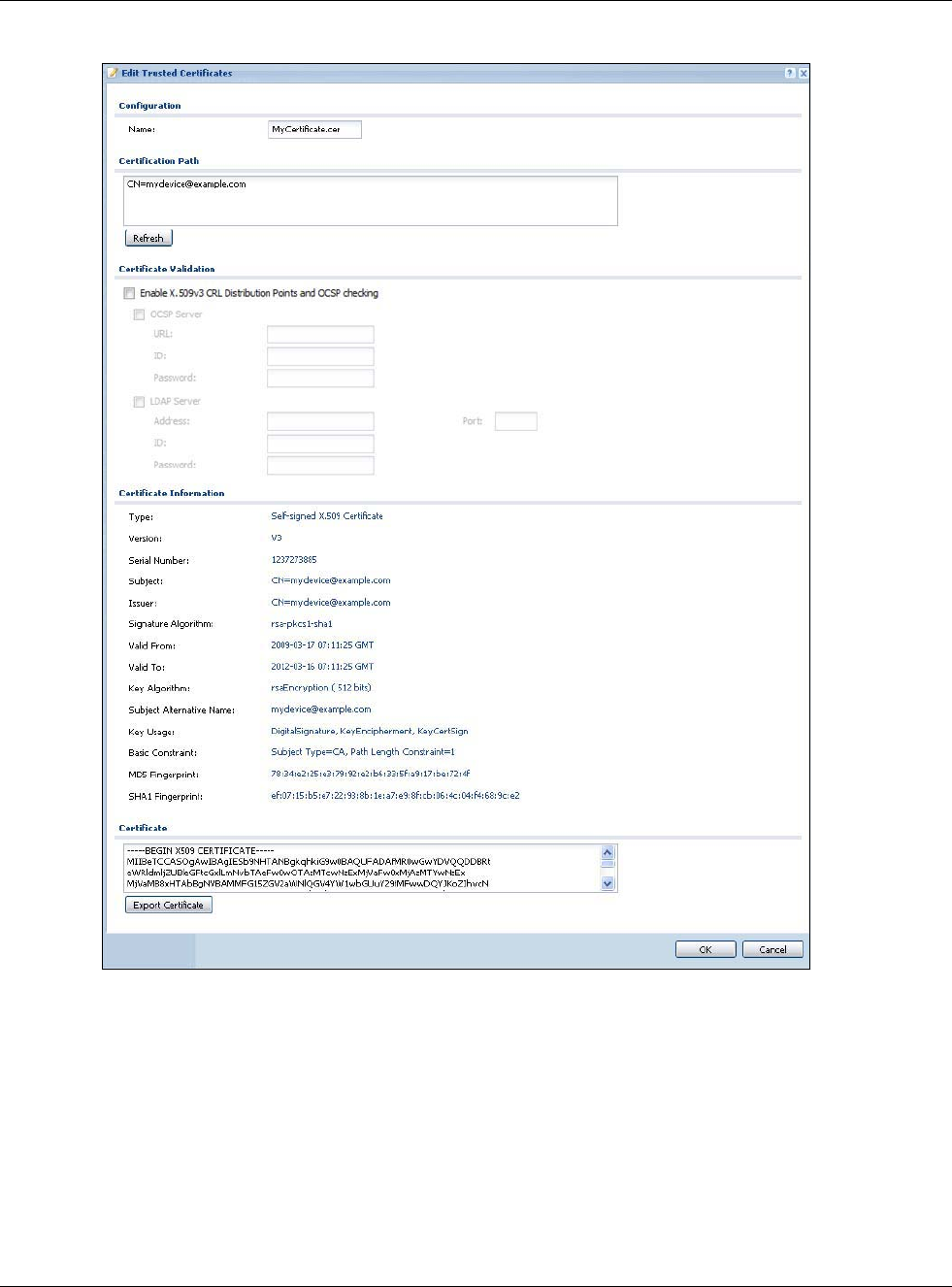
Chapter 29 Object
USG20(W)-VPN Series User’s Guide
525
Figure 358 Configuration > Object > Certificate > Trusted Certificates > Edit

Chapter 29 Object
USG20(W)-VPN Series User’s Guide
526
The following table describes the labels in this screen.
Table 223 Configuration > Object > Certificate > Trusted Certificates > Edit
LABEL DESCRIPTION
Name This field displays the identifying name of this certificate. You can change the name.
You can use up to 31 alphanumeric and ;‘~!@#$%^&()_+[]{}’,.=- characters.
Certification Path Click the Refresh button to have this read-only text box display the end entity’s
certificate and a list of certification authority certificates that shows the hierarchy of
certification authorities that validate the end entity’s certificate. If the issuing
certification authority is one that you have imported as a trusted certificate, it may be
the only certification authority in the list (along with the end entity’s own certificate).
The USG does not trust the end entity’s certificate and displays “Not trusted” in this
field if any certificate on the path has expired or been revoked.
Refresh Click Refresh to display the certification path.
Enable X.509v3 CRL
Distribution Points
and OCSP checking
Select this check box to turn on/off certificate revocation. When it is turned on, the
USG validates a certificate by getting Certificate Revocation List (CRL) through HTTP or
LDAP (can be configured after selecting the LDAP Server check box) and online
responder (can be configured after selecting the OCSP Server check box).
OCSP Server Select this check box if the directory server uses OCSP (Online Certificate Status
Protocol).
URL Type the protocol, IP address and path name of the OCSP server.
ID The USG may need to authenticate itself in order to assess the OCSP server. Type the
login name (up to 31 ASCII characters) from the entity maintaining the server (usually
a certification authority).
Password Type the password (up to 31 ASCII characters) from the entity maintaining the OCSP
server (usually a certification authority).
LDAP Server Select this check box if the directory server uses LDAP (Lightweight Directory Access
Protocol). LDAP is a protocol over TCP that specifies how clients access directories of
certificates and lists of revoked certificates.
Address Type the IP address (in dotted decimal notation) of the directory server.
Port Use this field to specify the LDAP server port number. You must use the same server
port number that the directory server uses. 389 is the default server port number for
LDAP.
ID The USG may need to authenticate itself in order to assess the CRL directory server.
Type the login name (up to 31 ASCII characters) from the entity maintaining the server
(usually a certification authority).
Password Type the password (up to 31 ASCII characters) from the entity maintaining the CRL
directory server (usually a certification authority).
Certificate
Information
These read-only fields display detailed information about the certificate.
Type This field displays general information about the certificate. CA-signed means that a
Certification Authority signed the certificate. Self-signed means that the certificate’s
owner signed the certificate (not a certification authority). X.509 means that this
certificate was created and signed according to the ITU-T X.509 recommendation that
defines the formats for public-key certificates.
Version This field displays the X.509 version number.
Serial Number This field displays the certificate’s identification number given by the certification
authority.
Subject This field displays information that identifies the owner of the certificate, such as
Common Name (CN), Organizational Unit (OU), Organization (O) and Country (C).
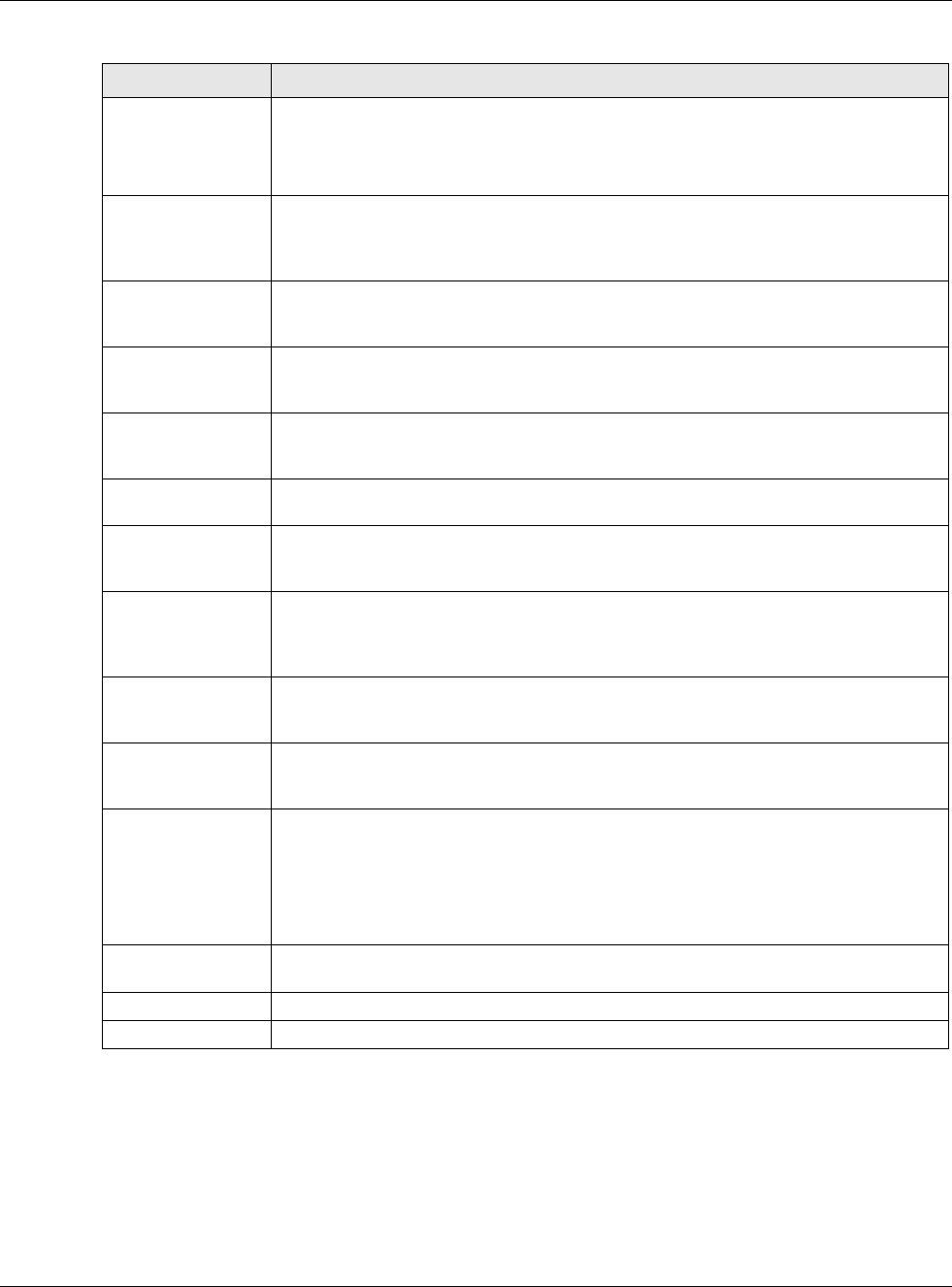
Chapter 29 Object
USG20(W)-VPN Series User’s Guide
527
29.10.4.2 The Trusted Certificates Import Screen
Click Configuration > Object > Certificate > Trusted Certificates > Import to open the
Trusted Certificates Import screen. Follow the instructions in this screen to save a trusted
certificate to the USG.
Note: You must remove any spaces from the certificate’s filename before you can import
the certificate.
Issuer This field displays identifying information about the certificate’s issuing certification
authority, such as Common Name, Organizational Unit, Organization and Country.
With self-signed certificates, this is the same information as in the Subject Name
field.
Signature Algorithm This field displays the type of algorithm that was used to sign the certificate. Some
certification authorities use rsa-pkcs1-sha1 (RSA public-private key encryption
algorithm and the SHA1 hash algorithm). Other certification authorities may use rsa-
pkcs1-md5 (RSA public-private key encryption algorithm and the MD5 hash algorithm).
Valid From This field displays the date that the certificate becomes applicable. The text displays in
red and includes a Not Yet Valid! message if the certificate has not yet become
applicable.
Valid To This field displays the date that the certificate expires. The text displays in red and
includes an Expiring! or Expired! message if the certificate is about to expire or has
already expired.
Key Algorithm This field displays the type of algorithm that was used to generate the certificate’s key
pair (the USG uses RSA encryption) and the length of the key set in bits (1024 bits for
example).
Subject Alternative
Name
This field displays the certificate’s owner‘s IP address (IP), domain name (DNS) or e-
mail address (EMAIL).
Key Usage This field displays for what functions the certificate’s key can be used. For example,
“DigitalSignature” means that the key can be used to sign certificates and
“KeyEncipherment” means that the key can be used to encrypt text.
Basic Constraint This field displays general information about the certificate. For example, Subject
Type=CA means that this is a certification authority’s certificate and “Path Length
Constraint=1” means that there can only be one certification authority in the
certificate’s path.
MD5 Fingerprint This is the certificate’s message digest that the USG calculated using the MD5
algorithm. You can use this value to verify with the certification authority (over the
phone for example) that this is actually their certificate.
SHA1 Fingerprint This is the certificate’s message digest that the USG calculated using the SHA1
algorithm. You can use this value to verify with the certification authority (over the
phone for example) that this is actually their certificate.
Certificate This read-only text box displays the certificate or certification request in Privacy
Enhanced Mail (PEM) format. PEM uses lowercase letters, uppercase letters and
numerals to convert a binary certificate into a printable form.
You can copy and paste the certificate into an e-mail to send to friends or colleagues or
you can copy and paste the certificate into a text editor and save the file on a
management computer for later distribution (via floppy disk for example).
Export Certificate Click this button and then Save in the File Download screen. The Save As screen
opens, browse to the location that you want to use and click Save.
OK Click OK to save your changes back to the USG. You can only change the name.
Cancel Click Cancel to quit and return to the Trusted Certificates screen.
Table 223 Configuration > Object > Certificate > Trusted Certificates > Edit (continued)
LABEL DESCRIPTION
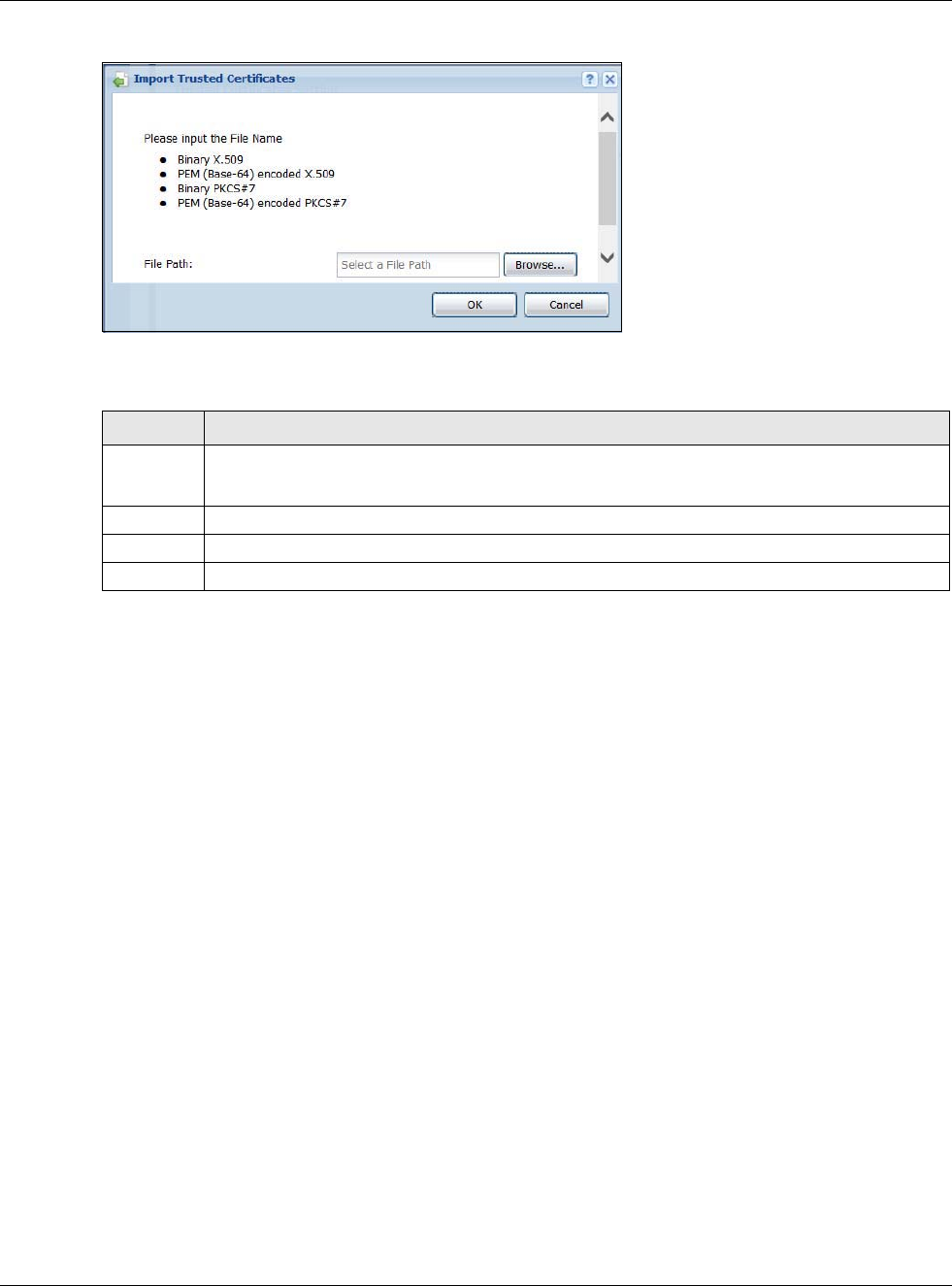
Chapter 29 Object
USG20(W)-VPN Series User’s Guide
528
Figure 359 Configuration > Object > Certificate > Trusted Certificates > Import
The following table describes the labels in this screen.
29.10.5 Certificates Technical Reference
OCSP
OCSP (Online Certificate Status Protocol) allows an application or device to check whether a
certificate is valid. With OCSP the USG checks the status of individual certificates instead of
downloading a Certificate Revocation List (CRL). OCSP has two main advantages over a CRL. The
first is real-time status information. The second is a reduction in network traffic since the USG only
gets information on the certificates that it needs to verify, not a huge list. When the USG requests
certificate status information, the OCSP server returns a “expired”, “current” or “unknown”
response.
29.11 ISP Account Overview
Use ISP accounts to manage Internet Service Provider (ISP) account information for PPPoE/PPTP
interfaces. An ISP account is a profile of settings for Internet access using PPPoE or PPTP.
Use the Object > ISP Account screens (Section 29.11.1 on page 528) to create and manage ISP
accounts in the USG.
29.11.1 ISP Account Summary
This screen provides a summary of ISP accounts in the USG. To access this screen, click
Configuration > Object > ISP Account.
Table 224 Configuration > Object > Certificate > Trusted Certificates > Import
LABEL DESCRIPTION
File Path Type in the location of the file you want to upload in this field or click Browse to find it.
You cannot import a certificate with the same name as a certificate that is already in the USG.
Browse Click Browse to find the certificate file you want to upload.
OK Click OK to save the certificate on the USG.
Cancel Click Cancel to quit and return to the previous screen.
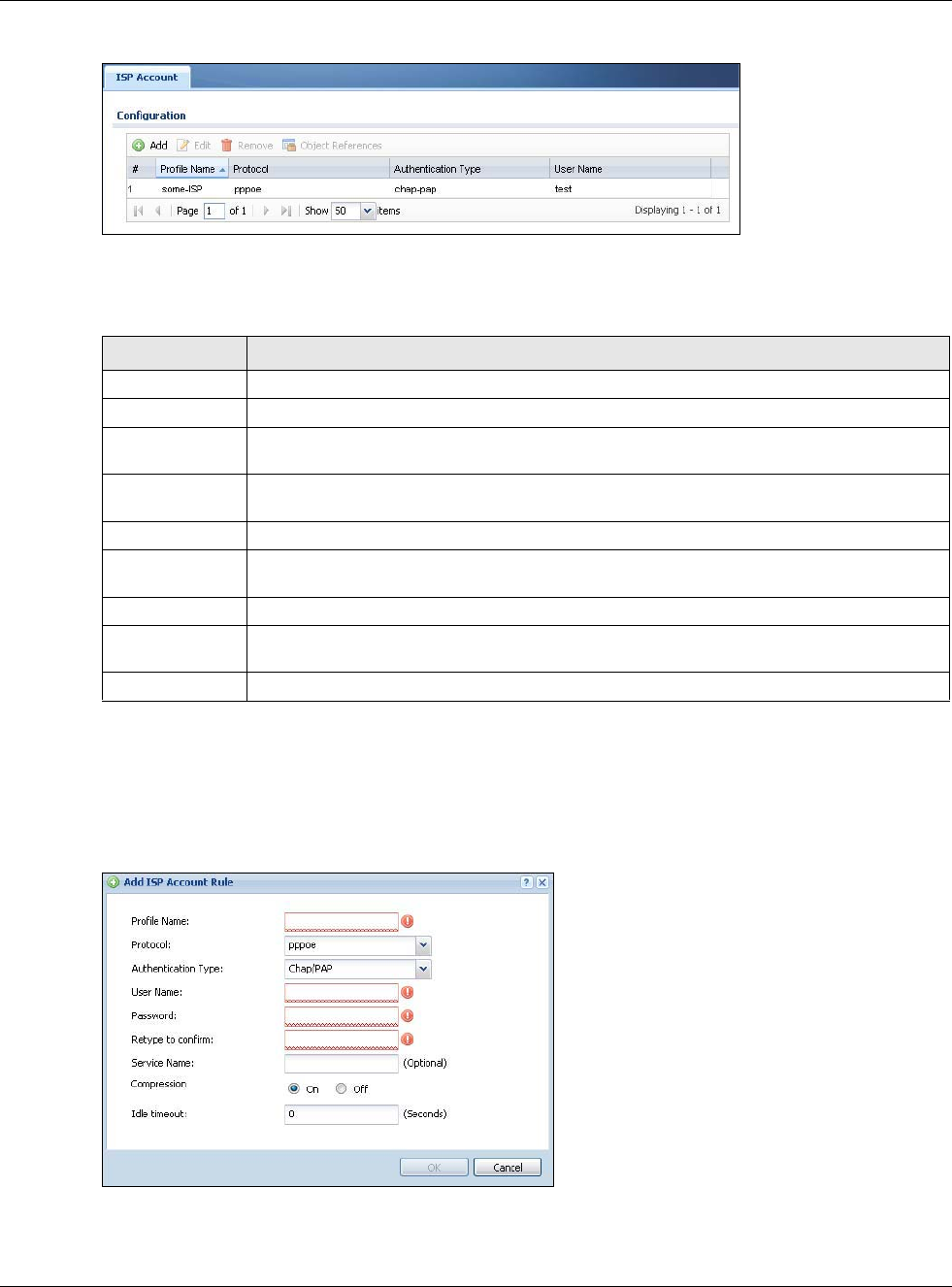
Chapter 29 Object
USG20(W)-VPN Series User’s Guide
529
Figure 360 Configuration > Object > ISP Account
The following table describes the labels in this screen. See the ISP Account Edit section below for
more information as well.
29.11.1.1 ISP Account Edit
The ISP Account Edit screen lets you add information about new accounts and edit information
about existing accounts. To open this window, open the ISP Account screen. (See Section 29.11.1
on page 528.) Then, click on an Add icon or Edit icon to open the ISP Account Edit screen below.
Figure 361 Configuration > Object > ISP Account > Edit
Table 225 Configuration > Object > ISP Account
LABEL DESCRIPTION
Add Click this to create a new entry.
Edit Double-click an entry or select it and click Edit to be able to modify the entry’s settings.
Remove To remove an entry, select it and click Remove. The USG confirms you want to remove it
before doing so.
Object
References
Select an entry and click Object References to open a screen that shows which settings
use the entry.
# This field is a sequential value, and it is not associated with a specific entry.
Profile Name This field displays the profile name of the ISP account. This name is used to identify the
ISP account.
Protocol This field displays the protocol used by the ISP account.
Authentication
Type
This field displays the authentication type used by the ISP account.
User Name This field displays the user name of the ISP account.

Chapter 29 Object
USG20(W)-VPN Series User’s Guide
530
The following table describes the labels in this screen.
Table 226 Configuration > Object > ISP Account > Edit
LABEL DESCRIPTION
Profile Name This field is read-only if you are editing an existing account. Type in the profile name of the
ISP account. The profile name is used to refer to the ISP account. You may use 1-31
alphanumeric characters, underscores(_), or dashes (-), but the first character cannot be
a number. This value is case-sensitive.
Protocol This field is read-only if you are editing an existing account. Select the protocol used by
the ISP account. Options are:
pppoe - This ISP account uses the PPPoE protocol.
pptp - This ISP account uses the PPTP protocol.
Authentication
Type
Use the drop-down list box to select an authentication protocol for outgoing calls. Options
are:
CHAP/PAP - Your USG accepts either CHAP or PAP when requested by this remote node.
Chap - Your USG accepts CHAP only.
PAP - Your USG accepts PAP only.
MSCHAP - Your USG accepts MSCHAP only.
MSCHAP-V2 - Your USG accepts MSCHAP-V2 only.
Encryption
Method
This field is available if this ISP account uses the PPTP protocol. Use the drop-down list
box to select the type of Microsoft Point-to-Point Encryption (MPPE). Options are:
nomppe - This ISP account does not use MPPE.
mppe-40 - This ISP account uses 40-bit MPPE.
mppe-128 - This ISP account uses 128-bit MMPE.
User Name Type the user name given to you by your ISP.
Password Type the password associated with the user name above. The password can only consist of
alphanumeric characters (A-Z, a-z, 0-9). This field can be blank.
Retype to
Confirm
Type your password again to make sure that you have entered is correctly.
Server IP If this ISP account uses the PPPoE protocol, this field is not displayed.
If this ISP account uses the PPTP protocol, type the IP address of the PPTP server.
Connection ID This field is available if this ISP account uses the PPTP protocol. Type your identification
name for the PPTP server. This field can be blank.
Service Name If this ISP account uses the PPPoE protocol, type the PPPoE service name to access. PPPoE
uses the specified service name to identify and reach the PPPoE server. This field can be
blank.
If this ISP account uses the PPTP protocol, this field is not displayed.
Compression Select On button to turn on stac compression, and select Off to turn off stac compression.
Stac compression is a data compression technique capable of compressing data by a factor
of about four.
Idle Timeout This value specifies the number of seconds that must elapse without outbound traffic
before the USG automatically disconnects from the PPPoE/PPTP server. This value must be
an integer between 0 and 360. If this value is zero, this timeout is disabled.
OK Click OK to save your changes back to the USG. If there are no errors, the program
returns to the ISP Account screen. If there are errors, a message box explains the error,
and the program stays in the ISP Account Edit screen.
Cancel Click Cancel to return to the ISP Account screen without creating the profile (if it is new)
or saving any changes to the profile (if it already exists).

Chapter 29 Object
USG20(W)-VPN Series User’s Guide
531
29.12 SSL Application Overview
You use SSL application objects in SSL VPN. Configure an SSL application object to specify the type
of application and the address of the local computer, server, or web site SSL users are to be able to
access. You can apply one or more SSL application objects in the VPN > SSL VPN screen for a user
account/user group.
•Use the SSL Application screen (Section 29.12.2 on page 533) to view the USG’s configured
SSL application objects.
•Use the SSL Application Edit screen to create or edit web-based application objects to allow
remote users to access an application via standard web browsers (Section 29.12.2.1 on page
533).
• You can also use the SSL Application Edit screen to specify the name of a folder on a Linux or
Windows file server which remote users can access using a standard web browser (Section
29.12.2.1 on page 533).
29.12.1 What You Need to Know
Application Types
You can configure the following SSL application on the USG.
• Web-based
A web-based application allows remote users to access an intranet site using standard web
browsers.
Remote User Screen Links
Available SSL application names are displayed as links in remote user screens. Depending on the
application type, remote users can simply click the links or follow the steps in the pop-up dialog box
to access.
Remote Desktop Connections
Use SSL VPN to allow remote users to manage LAN computers. Depending on the functions
supported by the remote desktop software, they can install or remove software, run programs,
change settings, and open, copy, create, and delete files. This is useful for troubleshooting,
support, administration, and remote access to files and programs.
The LAN computer to be managed must have VNC (Virtual Network Computing) or RDP (Remote
Desktop Protocol) server software installed. The remote user’s computer does not use VNC or RDP
client software. The USG works with the following remote desktop connection software:
RDP
• Windows Remote Desktop (supported in Internet Explorer)
VNC
•RealVNC
•TightVNC
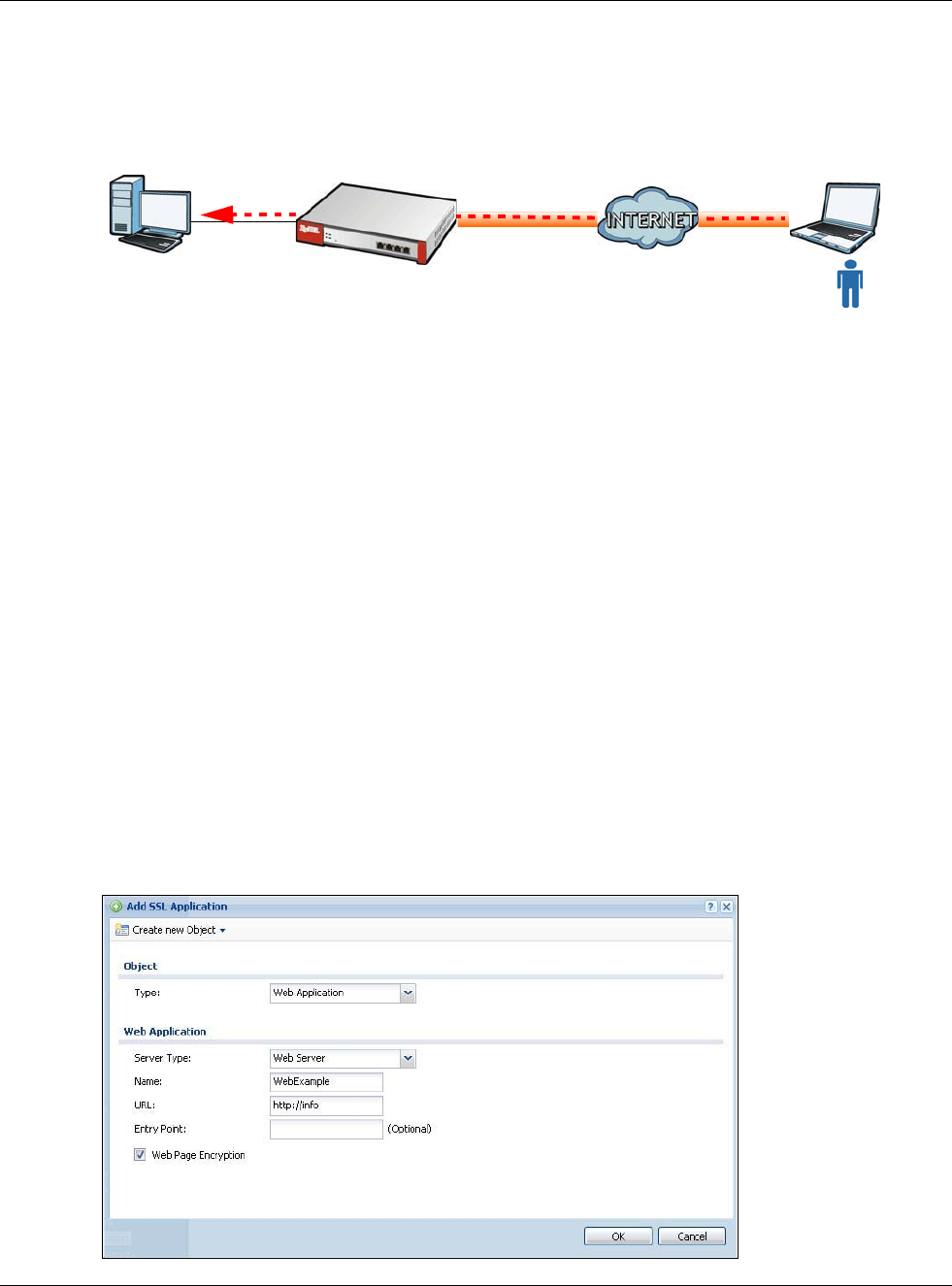
Chapter 29 Object
USG20(W)-VPN Series User’s Guide
532
•UltraVNC
For example, user A uses an SSL VPN connection to log into the USG. Then he manages LAN
computer B which has RealVNC server software installed.
Figure 362 SSL-protected Remote Management
Weblinks
You can configure weblink SSL applications to allow remote users to access web sites.
29.12.1.1 Example: Specifying a Web Site for Access
This example shows you how to create a web-based application for an internal web site. The
address of the web site is http://info with web page encryption.
1Click Configuration > Object > SSL Application in the navigation panel.
2Click the Add button and select Web Application in the Type field.
In the Server Type field, select Web Server.
Enter a descriptive name in the Display Name field. For example, “CompanyIntranet”.
In the URLAddress field, enter “http://my-info”.
Select Web Page Encryption to prevent users from saving the web content.
Click OK to save the settings.
The configuration screen should look similar to the following figure.
Figure 363 Example: SSL Application: Specifying a Web Site for Access
https://
A
SSL
B
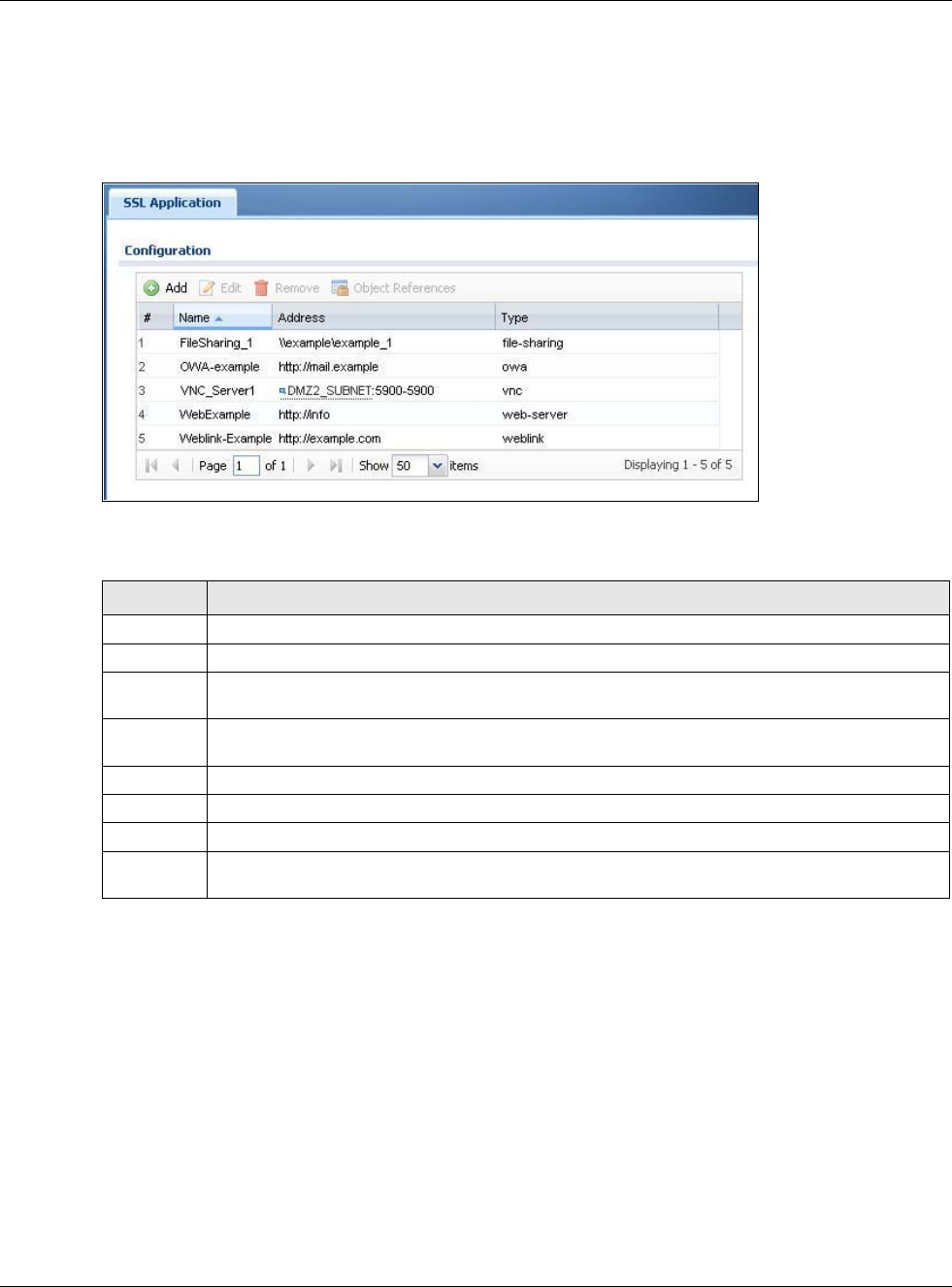
Chapter 29 Object
USG20(W)-VPN Series User’s Guide
533
29.12.2 The SSL Application Screen
The main SSL Application screen displays a list of the configured SSL application objects. Click
Configuration > Object > SSL Application in the navigation panel.
Figure 364 Configuration > Object > SSL Application
The following table describes the labels in this screen.
29.12.2.1 Creating/Editing an SSL Application Object
You can create a web-based application that allows remote users to access an application via
standard web browsers. You can also create a file sharing application that specify the name of a
folder on a file server (Linux or Windows) which remote users can access. Remote users can access
files using a standard web browser and files are displayed as links on the screen.
To configure an SSL application, click the Add or Edit button in the SSL Application screen and
select Web Application or File Sharing in the Type field. The screen differs depending on what
object type you choose.
Note: If you are creating a file sharing SSL application, you must also configure the
shared folder on the file server for remote access. Refer to the document that
comes with your file server.
Table 227 Configuration > Object > SSL Application
LABEL DESCRIPTION
Add Click this to create a new entry.
Edit Double-click an entry or select it and click Edit to be able to modify the entry’s settings.
Remove To remove an entry, select it and click Remove. The USG confirms you want to remove it before
doing so.
Object
References
Select an entry and click Object References to open a screen that shows which settings use
the entry.
# This field displays the index number.
Name This field displays the name of the object.
Address This field displays the IP address/URL of the application server or the location of a file share.
Type This field shows whether the object is a file-sharing, web-server, Outlook Web Access, Virtual
Network Computing, or Remote Desktop Protocol SSL application.
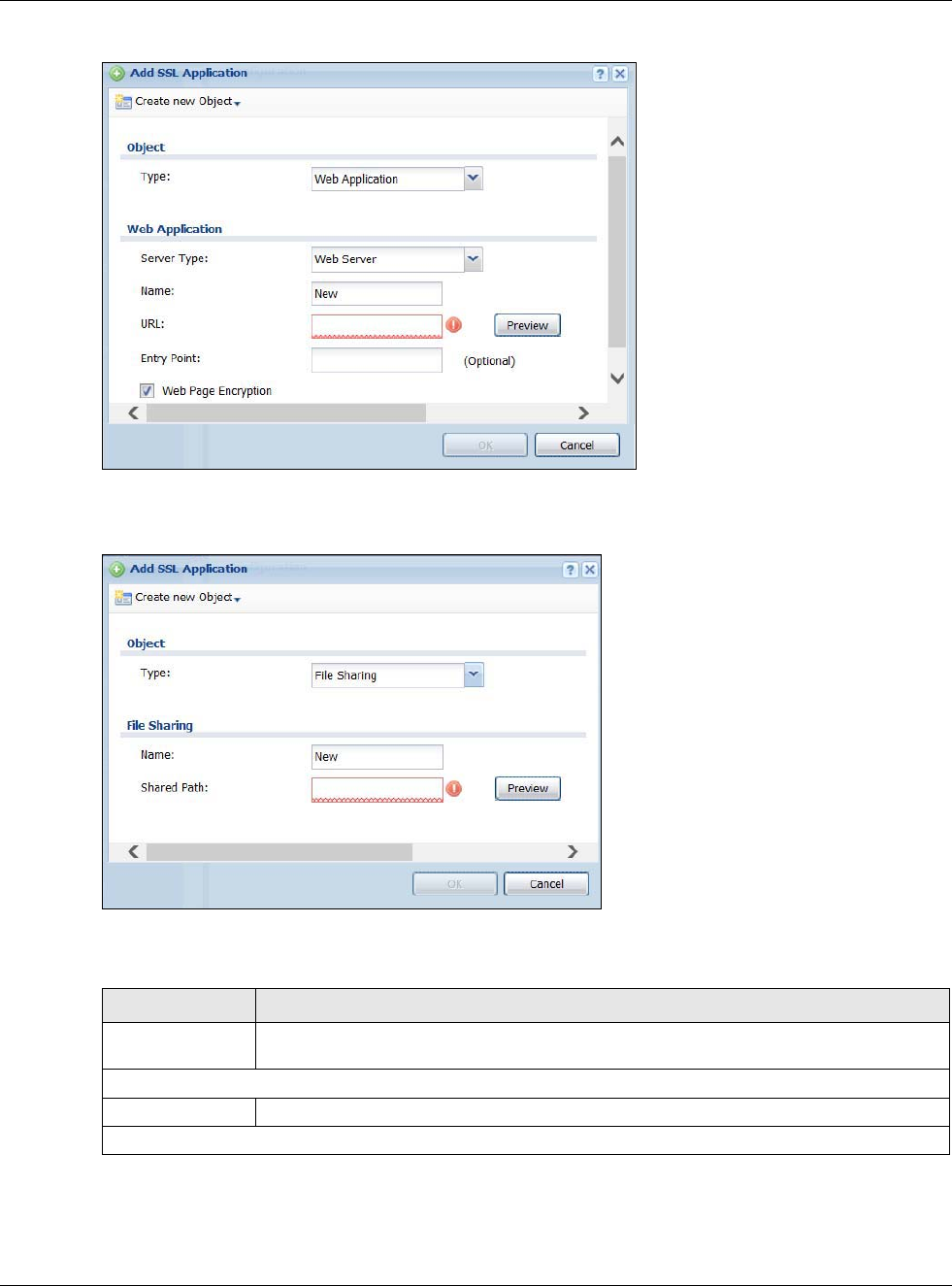
Chapter 29 Object
USG20(W)-VPN Series User’s Guide
534
Figure 365 Configuration > Object > SSL Application > Add/Edit: Web Application
Figure 366 Configuration > Object > SSL Application > Add/Edit: File Sharing
The following table describes the labels in this screen.
Table 228 Configuration > Object > SSL Application > Add/Edit: Web Application/File Sharing
LABEL DESCRIPTION
Create new
Object
Use this to configure any new settings objects that you need to use in this screen.
Object
Type Select Web Application or File Sharing from the drop-down list box.
Web Application

Chapter 29 Object
USG20(W)-VPN Series User’s Guide
535
Server Type This field only appears when you choose Web Application as the object type.
Specify the type of service for this SSL application.
Select Web Server to allow access to the specified web site hosted on the local network.
Select OWA (Outlook Web Access) to allow users to access e-mails, contacts, calenders
via Microsoft Outlook-like interface using supported web browsers. The USG supports one
OWA object.
Select VNC to allow users to manage LAN computers that have Virtual Network
Computing remote desktop server software installed.
Select RDP to allow users to manage LAN computers that have Remote Desktop Protocol
remote desktop server software installed.
Select Weblink to create a link to a web site that you expect the SSL VPN users to
commonly use.
Name Enter a descriptive name to identify this object. You can enter up to 31 characters (“0-9”,
“a-z”, “A-Z”, “-” and “_”). Spaces are not allowed.
URL This field only appears when you choose Web Application as the object type.
This field displays if the Server Type is set to Web Server, OWA, or Weblink.
Enter the Fully-Qualified Domain Name (FQDN) or IP address of the application server.
Note: You must enter the “http://” or “https://” prefix.
Remote users are restricted to access only files in this directory. For example, if you enter
“\remote\” in this field, remote users can only access files in the “remote” directory.
If a link contains a file that is not within this domain, then remote users cannot access it.
Preview This field only appears when you choose Web Application or File Sharing as the object
type.
This field displays if the Server Type is set to Web Server, OWA or Weblink.
Note: If your Internet Explorer or other browser screen doesn’t show a preview, it may
be due to your web browser security settings. You need to add the USG’s IP
address in the trusted sites of your web browser. For example, in Internet
Explorer, click Tools > Internet Options > Security > Trusted Sites > Sites
and type the USG’s IP address, then click Add. For other web browsers, please
check the browser help.
Click Preview to access the URL you specified in a new web browser screen.
Entry Point This field only appears when you choose Web Application as the object type.
This field displays if the Server Type is set to Web Server or OWA.
This field is optional. You only need to configure this field if you need to specify the name
of the directory or file on the local server as the home page or home directory on the user
screen.
Web Page
Encryption
This field only appears when you choose Web Application as the object type.
Select this option to prevent users from saving the web content.
Table 228 Configuration > Object > SSL Application > Add/Edit: Web Application/File Sharing
LABEL DESCRIPTION
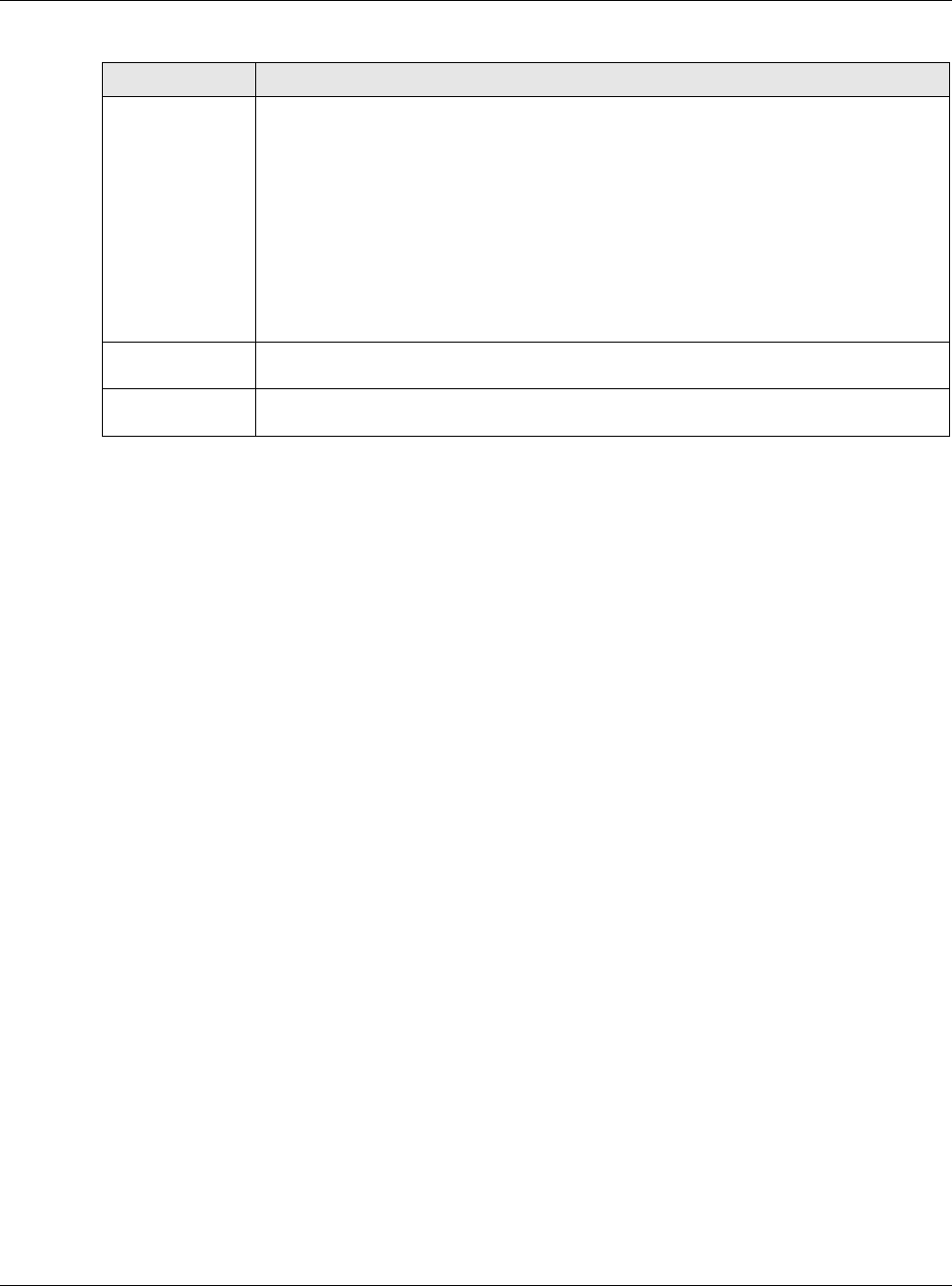
Chapter 29 Object
USG20(W)-VPN Series User’s Guide
536
Shared Path This field only appears when you choose File Sharing as the object type.
Specify the IP address, domain name or NetBIOS name (computer name) of the file
server and the name of the share to which you want to allow user access. Enter the path
in one of the following formats.
“\\<IP address>\<share name>”
“\\<domain name>\<share name>”
“\\<computer name>\<share name>”
For example, if you enter “\\my-server\Tmp”, this allows remote users to access all files
and/or folders in the “\Tmp” share on the “my-server” computer.
OK Click OK to save the changes and return to the main SSL Application Configuration
screen.
Cancel Click Cancel to discard the changes and return to the main SSL Application
Configuration screen.
Table 228 Configuration > Object > SSL Application > Add/Edit: Web Application/File Sharing
LABEL DESCRIPTION